DIII-D Papers
In reverse chronological order from the DIII-D weekly: (prep)
FY24-Q1:
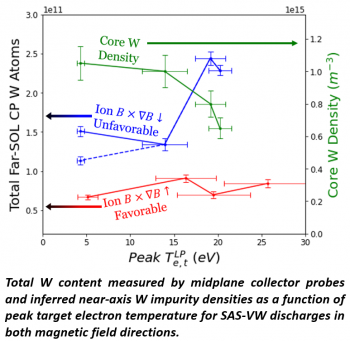 A paper titled “Collector Probe Analysis of Tungsten Transport to the Far-SOL from the DIII-D SAS-VW Divertor Experiment” was recently published in the journal Nuclear Materials and Energy (https://doi.org/10.1016/j.nme.2023.101566). In this article, experimental results from the SAS-VW campaign coupled with interpretive 3DLIM modelling show opposing trends for core impurity content when compared to impurity deposition on far-SOL Collector Probes (CPs) with increasing main ion density. An experiment was performed involving a series of upper-single-null L-mode discharges in each BT direction with progressively increasing main ion density approaching and slightly exceeding the divertor detachment threshold. The results indicate: a) increased radial W transport with decreasing peak divertor electron temperature; and b) negligible change in W content in the far-SOL at the outer mid-plane with the onset of divertor detachment. Using an interpretive modeling workflow for assessing the transport of W sputtered from the SAS-VW divertor, the analysis suggests that W migration to the main chamber surfaces during the campaign may also contribute to far-SOL deposition.
A paper titled “Collector Probe Analysis of Tungsten Transport to the Far-SOL from the DIII-D SAS-VW Divertor Experiment” was recently published in the journal Nuclear Materials and Energy (https://doi.org/10.1016/j.nme.2023.101566). In this article, experimental results from the SAS-VW campaign coupled with interpretive 3DLIM modelling show opposing trends for core impurity content when compared to impurity deposition on far-SOL Collector Probes (CPs) with increasing main ion density. An experiment was performed involving a series of upper-single-null L-mode discharges in each BT direction with progressively increasing main ion density approaching and slightly exceeding the divertor detachment threshold. The results indicate: a) increased radial W transport with decreasing peak divertor electron temperature; and b) negligible change in W content in the far-SOL at the outer mid-plane with the onset of divertor detachment. Using an interpretive modeling workflow for assessing the transport of W sputtered from the SAS-VW divertor, the analysis suggests that W migration to the main chamber surfaces during the campaign may also contribute to far-SOL deposition.
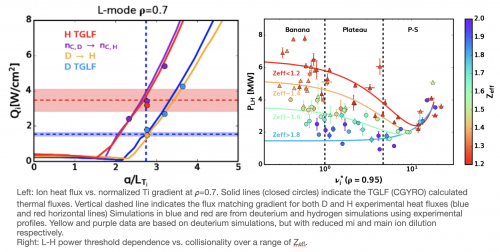 A paper titled “On the origin of the DIII-D L-H power threshold isotope effect” by K.J. Callahan, L. Schmitz, et al. was recently published in Nuclear Fusion (https://doi.org/10.1088/1741-4326/acf86c). This paper reports on the possible reason for the significantly increased low to high confinement mode (L to H-mode) power threshold P_LH in DIII-D low collisionality ITER similar hydrogen plasmas compared to deuterium. Gyro-fluid (TGLF) and gyro-kinetic (CGYRO) simulations of these experiments indicate the higher impurity (carbon) content in deuterium compared to hydrogen, due to mass-dependent sputtering of graphite, stabilizes ion temperature gradient (ITG) driven turbulence by increased main ion dilution. In the plasma edge, electron non-adiabaticity is also predicted to contribute to the isotope dependence of thermal transport, however its effect is subdominant compared to changes from impurity isotopic behavior. This L-H power threshold reduction with increasing carbon content at low collisionality is found to be in stark contrast to high collisionality results, where additional impurity content appears to increase the power necessary for H-mode access. This trend reversal with respect to impurity content is believed to be due to changing turbulence type, transitioning from an ITG/TEM dominated regime to a regime dominated by Resistive Ballooning Modes (RBM).
A paper titled “On the origin of the DIII-D L-H power threshold isotope effect” by K.J. Callahan, L. Schmitz, et al. was recently published in Nuclear Fusion (https://doi.org/10.1088/1741-4326/acf86c). This paper reports on the possible reason for the significantly increased low to high confinement mode (L to H-mode) power threshold P_LH in DIII-D low collisionality ITER similar hydrogen plasmas compared to deuterium. Gyro-fluid (TGLF) and gyro-kinetic (CGYRO) simulations of these experiments indicate the higher impurity (carbon) content in deuterium compared to hydrogen, due to mass-dependent sputtering of graphite, stabilizes ion temperature gradient (ITG) driven turbulence by increased main ion dilution. In the plasma edge, electron non-adiabaticity is also predicted to contribute to the isotope dependence of thermal transport, however its effect is subdominant compared to changes from impurity isotopic behavior. This L-H power threshold reduction with increasing carbon content at low collisionality is found to be in stark contrast to high collisionality results, where additional impurity content appears to increase the power necessary for H-mode access. This trend reversal with respect to impurity content is believed to be due to changing turbulence type, transitioning from an ITG/TEM dominated regime to a regime dominated by Resistive Ballooning Modes (RBM).
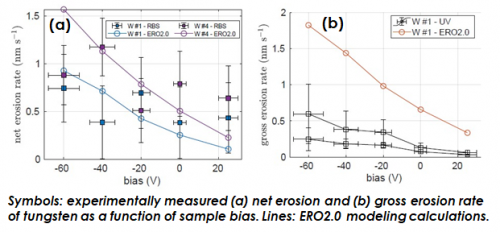 A paper titled “Model validation of tungsten erosion and redeposition properties using biased tungsten samples on DiMES” was recently published in the journal Nuclear Materials and Energy (https://doi.org/10.1016/j.nme.2023.101551). In this article, five identical samples were inserted into the lower divertor of DIII-D using the DiMES system. Each sample was exposed to a pair of L-mode attached plasma shots and was biased with a DC voltage ranging from -60 V to +25 V. Net erosion was measured with Rutherford Backscattering (RBS), while gross erosion was monitored in situ with the Auburn UV spectrometer (255.14 nm neutral W line). Numerical estimates of net erosion using the ERO2.0 PMI modeling code were in good agreement with measurements, lending confidence to our understanding of how modifying the Debye sheath changes W prompt redeposition. The modelled and measured trends in gross erosion were almost identical, but a scaling factor is required for quantitative agreement, suggesting that the S/XB coefficient for the W-I 255.14 nm line is underestimated.
A paper titled “Model validation of tungsten erosion and redeposition properties using biased tungsten samples on DiMES” was recently published in the journal Nuclear Materials and Energy (https://doi.org/10.1016/j.nme.2023.101551). In this article, five identical samples were inserted into the lower divertor of DIII-D using the DiMES system. Each sample was exposed to a pair of L-mode attached plasma shots and was biased with a DC voltage ranging from -60 V to +25 V. Net erosion was measured with Rutherford Backscattering (RBS), while gross erosion was monitored in situ with the Auburn UV spectrometer (255.14 nm neutral W line). Numerical estimates of net erosion using the ERO2.0 PMI modeling code were in good agreement with measurements, lending confidence to our understanding of how modifying the Debye sheath changes W prompt redeposition. The modelled and measured trends in gross erosion were almost identical, but a scaling factor is required for quantitative agreement, suggesting that the S/XB coefficient for the W-I 255.14 nm line is underestimated.
- A new paper has been published in Nuclear Fusion ( https://doi.org/10.1088/1741-4326/ad0606) coauthored by C. Holcomb: “Long plasma duration operation analysis with an international multi-machine (tokamaks and stellarators) database”. Organized by the International Energy Agency-International Atomic Energy Agency Coordination on International Challenges on Long duration Operation (CICLOP) group, this paper presents various 0D performance and pulse length metrics from a database of discharges from 10 tokamaks, including DIII-D, and 2 stellarators. The paper reports on physics and engineering progress and remaining challenges for achieving high fusion performance for long duration.
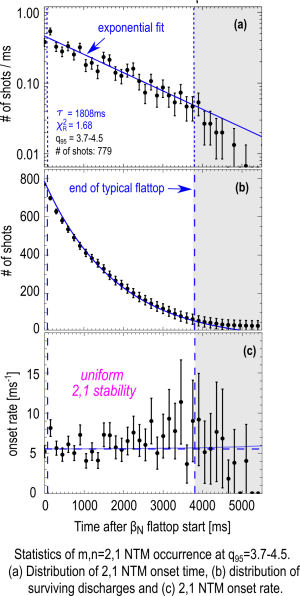 A paper titled “The onset distribution of rotating m,n = 2,1 tearing modes and its consequences on the stability of high-confinement-mode plasmas in DIII-D” by L. Bardoczi, N. J. Richner and N. C. Logan was recently published in Nuclear Fusion (https://doi.org/10.1088/1741-4326/ad0488). This paper reports the statistics of 2,1 NTM onsets of a multi-scenario database of over 13,000 DIII-D H-mode discharges. This analysis shows that the m,n=2,1 magnetic islands are dominantly pressure gradient driven, stochastically triggered non-linear instabilities at all edge safety factor (q95) values, in agreement with the modified Rutherford equation of Neoclassical Tearing Modes (NTMs). The instability onset time closely follows the exponential distribution in intermediate and high q95 scenarios and is characterized by near constant onset rate (λ), in accordance with Poisson-point processes. This implies that the plasmas are operated in marginally stable conditions, characterized by a small threshold for instability growth and variations in the trigger amplitude and/or the stabilizing mechanisms with temporally uniform random distribution in this database. While the majority of the tearing modes occur in the first current-profile relaxation time of the βN flattop, constant λ throughout the βN flattop shows that the tearing onset is insensitive to the evolution of the equilibrium current profile. In low q95 scenarios, where a large fraction of the plasmas are operated at low torque, λ increases over the course of the βN flattop, showing that these plasmas evolve toward more unstable conditions. Overall, the mode onset statistics support that the majority of 2,1 tearing modes are non-linear, neoclassically driven instabilities and classical stability does not play a dominant role in their onset through the current profile relaxation in DIII-D H-mode discharges.
A paper titled “The onset distribution of rotating m,n = 2,1 tearing modes and its consequences on the stability of high-confinement-mode plasmas in DIII-D” by L. Bardoczi, N. J. Richner and N. C. Logan was recently published in Nuclear Fusion (https://doi.org/10.1088/1741-4326/ad0488). This paper reports the statistics of 2,1 NTM onsets of a multi-scenario database of over 13,000 DIII-D H-mode discharges. This analysis shows that the m,n=2,1 magnetic islands are dominantly pressure gradient driven, stochastically triggered non-linear instabilities at all edge safety factor (q95) values, in agreement with the modified Rutherford equation of Neoclassical Tearing Modes (NTMs). The instability onset time closely follows the exponential distribution in intermediate and high q95 scenarios and is characterized by near constant onset rate (λ), in accordance with Poisson-point processes. This implies that the plasmas are operated in marginally stable conditions, characterized by a small threshold for instability growth and variations in the trigger amplitude and/or the stabilizing mechanisms with temporally uniform random distribution in this database. While the majority of the tearing modes occur in the first current-profile relaxation time of the βN flattop, constant λ throughout the βN flattop shows that the tearing onset is insensitive to the evolution of the equilibrium current profile. In low q95 scenarios, where a large fraction of the plasmas are operated at low torque, λ increases over the course of the βN flattop, showing that these plasmas evolve toward more unstable conditions. Overall, the mode onset statistics support that the majority of 2,1 tearing modes are non-linear, neoclassically driven instabilities and classical stability does not play a dominant role in their onset through the current profile relaxation in DIII-D H-mode discharges.
 A paper titled “SiC as a core-edge integrated wall solution in DIII-D” by S.A. Zamperini et al. was recently published in Nuclear Materials and Energy (https://doi.org/10.1016/j.nme.2023.101535). Silicon carbide (SiC) is a promising material for use in a fusion reactor due to its low hydrogenic diffusivity, high temperature strength and resilience under neutron irradiation. To assess SiC as a main wall material in DIII-D, simulations with TRIM.SP and DIVIMP are performed on a well-diagnosed L-mode discharge. The effective charge, Zeff, across the separatrix is used as a figure of merit in comparing SiC to the current graphite walls. It is found that SiC may reduce Zeff by as much as ∼50%. It is discussed how SiC may be expected to “self-condition” and create wall conditions similar to siliconization, further lowering Zeff due to efficient oxygen gettering (i.e., SiC walls may not require boronizations). This work directly motivates the installation of SiC toroidal limiters within DIII-D, which would be an intermediary step before considering a full-wall changeout.
A paper titled “SiC as a core-edge integrated wall solution in DIII-D” by S.A. Zamperini et al. was recently published in Nuclear Materials and Energy (https://doi.org/10.1016/j.nme.2023.101535). Silicon carbide (SiC) is a promising material for use in a fusion reactor due to its low hydrogenic diffusivity, high temperature strength and resilience under neutron irradiation. To assess SiC as a main wall material in DIII-D, simulations with TRIM.SP and DIVIMP are performed on a well-diagnosed L-mode discharge. The effective charge, Zeff, across the separatrix is used as a figure of merit in comparing SiC to the current graphite walls. It is found that SiC may reduce Zeff by as much as ∼50%. It is discussed how SiC may be expected to “self-condition” and create wall conditions similar to siliconization, further lowering Zeff due to efficient oxygen gettering (i.e., SiC walls may not require boronizations). This work directly motivates the installation of SiC toroidal limiters within DIII-D, which would be an intermediary step before considering a full-wall changeout.
(Figure: DIVIMP comparison of Zeff across the separatrix for graphite and SiC walls in a typical DIII-D L-mode)
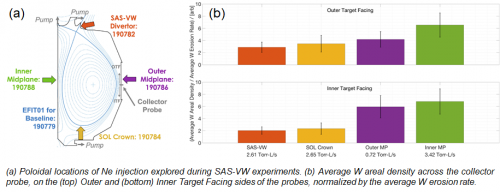 A paper titled “Tungsten erosion and divertor leakage from the DIII-D SAS-VW tungsten-coated divertor in experiments with neon gas seeding” by M.S. Parsons and many DIII-D contributors was just published in Nuclear Materials and Energy (https://doi.org/10.1016/j.nme.2023.101520). In this paper, graphite “collector probes” located in the far Scrape-off-Layer at the outer midplane were used to measure the amount of tungsten escaping the SAS-VW divertor under different conditions with neon seeding. The “divertor leakage” was calculated by taking the ratio between the concentration of tungsten measured on the probe and the spectroscopically measured tungsten gross erosion rate from the divertor. The results show that both the tungsten divertor leakage and tungsten SOL flow pattern are sensitive to the neon seeding conditions.
A paper titled “Tungsten erosion and divertor leakage from the DIII-D SAS-VW tungsten-coated divertor in experiments with neon gas seeding” by M.S. Parsons and many DIII-D contributors was just published in Nuclear Materials and Energy (https://doi.org/10.1016/j.nme.2023.101520). In this paper, graphite “collector probes” located in the far Scrape-off-Layer at the outer midplane were used to measure the amount of tungsten escaping the SAS-VW divertor under different conditions with neon seeding. The “divertor leakage” was calculated by taking the ratio between the concentration of tungsten measured on the probe and the spectroscopically measured tungsten gross erosion rate from the divertor. The results show that both the tungsten divertor leakage and tungsten SOL flow pattern are sensitive to the neon seeding conditions.
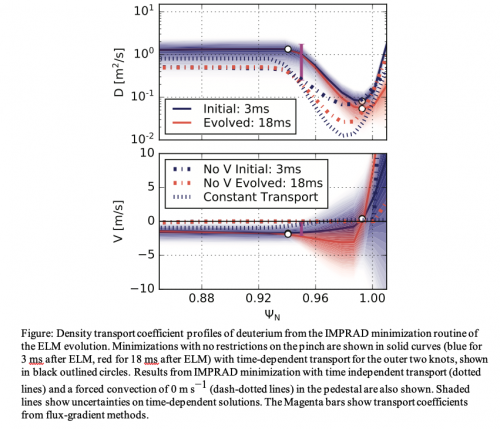 A paper by Aaron Rosenthal et al., titled “Inference of main ion particle transport coefficients with experimentally constrained neutral ionization during edge localized mode recovery on DIII-D”, was published in Nuclear Fusion (https://doi.org/10.1088/1741-4326/acb95a). This paper uses the plasma and neutral density dynamics after an edge localized mode to infer the plasma transport coefficients for the density pedestal. The Lyman-Alpha Measurement Apparatus (LLAMA) diagnostic provides sub-millisecond profile measurements of the ionization source and neutral density. Exploiting the absolute calibration of the LLAMA diagnostic allows quantitative comparison to the electron and main ion density profiles determined by charge-exchange recombination, Thomson scattering and interferometry. Separation of diffusion and convection contributions to the density pedestal transport are investigated through flux gradient methods and time-dependent forward modeling with Bayesian inference by adaptation of the Aurora transport code and IMPRAD framework to main ion particle transport (as shown in figure). Both methods suggest time-dependent transport coefficients and are consistent with an inward particle pinch on the order of 1 m s−1 and diffusion coefficient of 0.05 m2 s−1 in the steep density gradient region of the pedestal. While it is possible to recreate the experimentally observed phenomena with no pinch in the pedestal, low diffusion in the core and high outward convection in the near scrape-off layer are required without an inward pedestal pinch.
A paper by Aaron Rosenthal et al., titled “Inference of main ion particle transport coefficients with experimentally constrained neutral ionization during edge localized mode recovery on DIII-D”, was published in Nuclear Fusion (https://doi.org/10.1088/1741-4326/acb95a). This paper uses the plasma and neutral density dynamics after an edge localized mode to infer the plasma transport coefficients for the density pedestal. The Lyman-Alpha Measurement Apparatus (LLAMA) diagnostic provides sub-millisecond profile measurements of the ionization source and neutral density. Exploiting the absolute calibration of the LLAMA diagnostic allows quantitative comparison to the electron and main ion density profiles determined by charge-exchange recombination, Thomson scattering and interferometry. Separation of diffusion and convection contributions to the density pedestal transport are investigated through flux gradient methods and time-dependent forward modeling with Bayesian inference by adaptation of the Aurora transport code and IMPRAD framework to main ion particle transport (as shown in figure). Both methods suggest time-dependent transport coefficients and are consistent with an inward particle pinch on the order of 1 m s−1 and diffusion coefficient of 0.05 m2 s−1 in the steep density gradient region of the pedestal. While it is possible to recreate the experimentally observed phenomena with no pinch in the pedestal, low diffusion in the core and high outward convection in the near scrape-off layer are required without an inward pedestal pinch.
FY23-Q4:
 A paper titled “Self-consistent simulation of compressional Alfvén eigenmodes excitation and runaway electron diffusion in tokamak disruptions” by C. Liu, A. Lvovskiy, C. Paz-Soldan, S. C. Jardin and A. Bhattacharjee was published in Physical Review Letters (https://doi.org/10.1103/PhysRevLett.131.085102). In this paper the Alfvénic modes driven by high-energy runaway electrons (REs) beams observed in DIII-D disruption experiments were simulated using the kinetic-MHD mode M3D-C1, and both linear and nonlinear results were presented. The study reveals that the precession motion of trapped runaway electrons can exhibit resonance with the n=1 compressional Alfvén eigenmodes (CAEs), which typically have frequencies in the range of a few megahertz. This observation aligns with experimental measurements. The trapped runaway electrons are generated through collisions with high-Z impurities, primarily due to massive gas injection (MGI). In the nonlinear simulations, it is observed that multiple eigenmodes can be excited simultaneously by runaway electrons with different energy levels. The perturbed magnetic fields associated with these modes lead to rapid diffusion of runaway electrons, potentially preventing the formation of a post-disruption runaway electron plateau. These simulation findings validate earlier analyses based on experimental results from DIII-D, offering a novel potential approach to mitigating runaway electron beams during tokamak disruptions.
A paper titled “Self-consistent simulation of compressional Alfvén eigenmodes excitation and runaway electron diffusion in tokamak disruptions” by C. Liu, A. Lvovskiy, C. Paz-Soldan, S. C. Jardin and A. Bhattacharjee was published in Physical Review Letters (https://doi.org/10.1103/PhysRevLett.131.085102). In this paper the Alfvénic modes driven by high-energy runaway electrons (REs) beams observed in DIII-D disruption experiments were simulated using the kinetic-MHD mode M3D-C1, and both linear and nonlinear results were presented. The study reveals that the precession motion of trapped runaway electrons can exhibit resonance with the n=1 compressional Alfvén eigenmodes (CAEs), which typically have frequencies in the range of a few megahertz. This observation aligns with experimental measurements. The trapped runaway electrons are generated through collisions with high-Z impurities, primarily due to massive gas injection (MGI). In the nonlinear simulations, it is observed that multiple eigenmodes can be excited simultaneously by runaway electrons with different energy levels. The perturbed magnetic fields associated with these modes lead to rapid diffusion of runaway electrons, potentially preventing the formation of a post-disruption runaway electron plateau. These simulation findings validate earlier analyses based on experimental results from DIII-D, offering a novel potential approach to mitigating runaway electron beams during tokamak disruptions.
 A paper titled “Empirical probability and machine learning analysis of m,n=2,1 tearing mode onset parameter dependence in DIII-D H-mode scenarios” by L. Bardoczi, N. J. Richner, J. Zhu, C. Rea and N. C. Logan was published in Physics of Plasmas (https://doi.org/10.1063/5.0165859). This paper reports analyses of the 2,1 NTM onsets in a multi-scenario DIII-D database of over 14,000 H-mode discharges. These analyses find that the normalized plasma beta, the rotation profile and the magnetic equilibrium shape have the strongest impact on the 2,1 tearing mode stability, in qualitative agreement with neoclassical tearing modes, while absence of strong correlation with the current profile supports that classical effects are negligible. Interestingly, 2,1 tearing modes are most likely to destabilize when n>1 tearing modes are already present in the core plasma. The covariance matrix of tearing sensitive plasma parameters takes a nearly block-diagonal form, with the blocks incorporating thermodynamic, current & safety factor profile, separatrix shape and plasma flow parameters, respectively. This suggests a number of paths to improved stability at fixed pressure and edge safety factor primarily by preserving a minimum of 1 kHz differential rotation, increasing the minimum safety factor above unity, using upper single null magnetic configuration and reducing the core impurity radiation. In addition, lower triangularity, lower elongation and lower pedestal pressure may also help to improve the stability. The electron and ion temperature, collisionality, resistivity, internal inductance and the parallel current gradient appear to only weakly correlate with the 2,1 tearing mode onsets in this database. The formation of n>1 tearing modes and rotation profile flattening appear to be the best predictors of disruptive 2,1 NTM onsets.
A paper titled “Empirical probability and machine learning analysis of m,n=2,1 tearing mode onset parameter dependence in DIII-D H-mode scenarios” by L. Bardoczi, N. J. Richner, J. Zhu, C. Rea and N. C. Logan was published in Physics of Plasmas (https://doi.org/10.1063/5.0165859). This paper reports analyses of the 2,1 NTM onsets in a multi-scenario DIII-D database of over 14,000 H-mode discharges. These analyses find that the normalized plasma beta, the rotation profile and the magnetic equilibrium shape have the strongest impact on the 2,1 tearing mode stability, in qualitative agreement with neoclassical tearing modes, while absence of strong correlation with the current profile supports that classical effects are negligible. Interestingly, 2,1 tearing modes are most likely to destabilize when n>1 tearing modes are already present in the core plasma. The covariance matrix of tearing sensitive plasma parameters takes a nearly block-diagonal form, with the blocks incorporating thermodynamic, current & safety factor profile, separatrix shape and plasma flow parameters, respectively. This suggests a number of paths to improved stability at fixed pressure and edge safety factor primarily by preserving a minimum of 1 kHz differential rotation, increasing the minimum safety factor above unity, using upper single null magnetic configuration and reducing the core impurity radiation. In addition, lower triangularity, lower elongation and lower pedestal pressure may also help to improve the stability. The electron and ion temperature, collisionality, resistivity, internal inductance and the parallel current gradient appear to only weakly correlate with the 2,1 tearing mode onsets in this database. The formation of n>1 tearing modes and rotation profile flattening appear to be the best predictors of disruptive 2,1 NTM onsets.
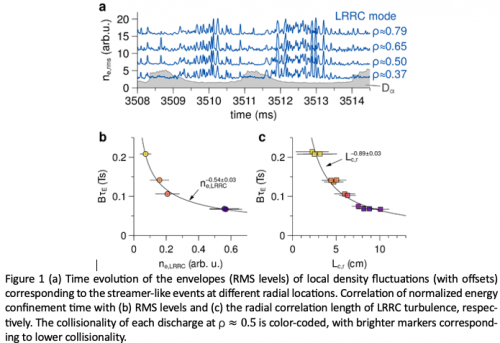 The paper titled “Observation of long-radial-range-correlation in turbulence in high-collisionality high-confinement plasmas on DIII-D” by R. Hong (UCLA) et al. has been published in Nuclear Fusion (https://doi.org/10.1088/1741-4326/acedc2). This research paper delves into the observation of spatially asymmetric turbulent structures in the core of high-collisionality H-mode plasmas on DIII-D tokamak. The key findings include: (1) Streamer-like transport events, with long-radial-range correlation (LRRC), develop in the core region at high collisionality and weak flow shear; (2) the amplitude and radial scale of streamers are regulated by the mean flow shearing rate and are inversely correlated with energy confinement time. These findings shed light on the degrading nature of core confinement at high collisionality on DIII-D tokamak.
The paper titled “Observation of long-radial-range-correlation in turbulence in high-collisionality high-confinement plasmas on DIII-D” by R. Hong (UCLA) et al. has been published in Nuclear Fusion (https://doi.org/10.1088/1741-4326/acedc2). This research paper delves into the observation of spatially asymmetric turbulent structures in the core of high-collisionality H-mode plasmas on DIII-D tokamak. The key findings include: (1) Streamer-like transport events, with long-radial-range correlation (LRRC), develop in the core region at high collisionality and weak flow shear; (2) the amplitude and radial scale of streamers are regulated by the mean flow shearing rate and are inversely correlated with energy confinement time. These findings shed light on the degrading nature of core confinement at high collisionality on DIII-D tokamak.
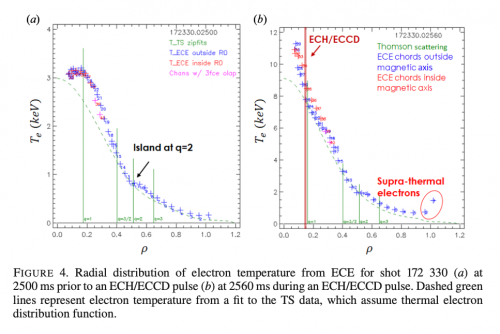 The paper titled “Energetic electron transport in magnetic fields with island chains and stochastic regions” by E.G. Kostadinova et al. was published in the Journal of Plasma Physics (https://doi.org/10.1017/S0022377823000879). The paper investigates energetic electron transport in magnetized plasmas with magnetic fields characterized by island chains and regions of stochastic field lines produced by coil perturbations. The paper reports on DIII-D Frontier Science experiments that utilized electron cyclotron heating and current drive pulses to ‘tag’ electron populations within different locations across the discharge. The cross-field transport of these populations was then inferred from electron cyclotron emission measurements and gamma emission signals from scintillator detectors. Two types of energetic particles were distinguished and discussed: non-relativistic suprathermal electrons and relativistic runaway electrons. The magnetic field topology in each discharge was reconstructed with field-line tracing codes, which were also used to determine the location and scale of magnetic islands and stochastic regions. A comparison of simulations and experiments suggested that suprathermal transport was suppressed when the tagging was performed at a smaller radial location than the location of the q = 1 island chain and enhanced otherwise. The paper further demonstrated that increasing the width of the stochastic region within the edge plasma yielded enhancement of the suprathermal electron transport.
The paper titled “Energetic electron transport in magnetic fields with island chains and stochastic regions” by E.G. Kostadinova et al. was published in the Journal of Plasma Physics (https://doi.org/10.1017/S0022377823000879). The paper investigates energetic electron transport in magnetized plasmas with magnetic fields characterized by island chains and regions of stochastic field lines produced by coil perturbations. The paper reports on DIII-D Frontier Science experiments that utilized electron cyclotron heating and current drive pulses to ‘tag’ electron populations within different locations across the discharge. The cross-field transport of these populations was then inferred from electron cyclotron emission measurements and gamma emission signals from scintillator detectors. Two types of energetic particles were distinguished and discussed: non-relativistic suprathermal electrons and relativistic runaway electrons. The magnetic field topology in each discharge was reconstructed with field-line tracing codes, which were also used to determine the location and scale of magnetic islands and stochastic regions. A comparison of simulations and experiments suggested that suprathermal transport was suppressed when the tagging was performed at a smaller radial location than the location of the q = 1 island chain and enhanced otherwise. The paper further demonstrated that increasing the width of the stochastic region within the edge plasma yielded enhancement of the suprathermal electron transport.
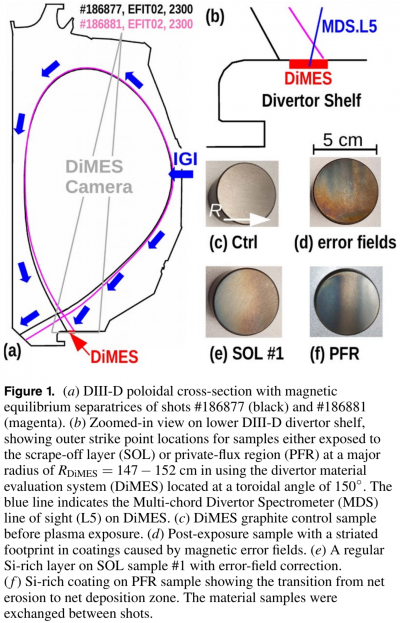 A paper by F. Effenberg et al., titled “In-situ coating of silicon-rich films on tokamak plasma-facing components with real-time Si material injection”, was published in Nuclear Fusion (https://iopscience.iop.org/article/10.1088/1741-4326/acee98). In this work, silicon-rich films were grown in situ on the lower divertor using real-time small Si pellet injection with the impurity granule injector (IGI) in DIII-D H-mode scenarios. Post-mortem analysis of samples exposed to the plasma through the divertor material evaluation system DiMES revealed Si-rich coatings with thicknesses of at least 0.4–1.2 nm. These layers grew at rates of 0.4–0.7 nm/s and efficiencies of 0.02–0.05 nm/mg on the outer DIII-D divertor. The coatings were found to be composed of silicon oxides, predominantly SiO2, and possibly including SiOC and SiOx, showing that the Si acted as an effective oxygen getter. Si erosion yields determined with the S/XB method showed good agreement with theoretical values for a-SiC and pure Si within error bars, taking surface dilution and preferential sputtering of non-silicon elements such as oxygen and carbon into account. Extrapolations based on the results in this study show that in an FPP, injecting a few hundred kg per year would be necessary to replenish and maintain millimeter-thick low-Z claddings, while less would be needed for occasional surface conditioning. Finer Si or SiC powder injection and heated divertor samples are proposed to optimize the method and promote SiC formation, a promising wall material candidate.
A paper by F. Effenberg et al., titled “In-situ coating of silicon-rich films on tokamak plasma-facing components with real-time Si material injection”, was published in Nuclear Fusion (https://iopscience.iop.org/article/10.1088/1741-4326/acee98). In this work, silicon-rich films were grown in situ on the lower divertor using real-time small Si pellet injection with the impurity granule injector (IGI) in DIII-D H-mode scenarios. Post-mortem analysis of samples exposed to the plasma through the divertor material evaluation system DiMES revealed Si-rich coatings with thicknesses of at least 0.4–1.2 nm. These layers grew at rates of 0.4–0.7 nm/s and efficiencies of 0.02–0.05 nm/mg on the outer DIII-D divertor. The coatings were found to be composed of silicon oxides, predominantly SiO2, and possibly including SiOC and SiOx, showing that the Si acted as an effective oxygen getter. Si erosion yields determined with the S/XB method showed good agreement with theoretical values for a-SiC and pure Si within error bars, taking surface dilution and preferential sputtering of non-silicon elements such as oxygen and carbon into account. Extrapolations based on the results in this study show that in an FPP, injecting a few hundred kg per year would be necessary to replenish and maintain millimeter-thick low-Z claddings, while less would be needed for occasional surface conditioning. Finer Si or SiC powder injection and heated divertor samples are proposed to optimize the method and promote SiC formation, a promising wall material candidate.
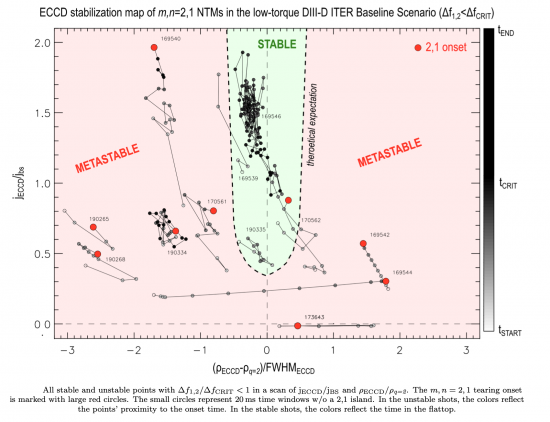 A paper titled “Direct Preemptive Stabilization of m,n=2,1 Neoclassical Tearing Modes by Electron Cyclotron Current Drive in the DIII-D Low-Torque ITER Baseline Scenario” by L. Bardoczi, R. J. La Haye, E. J. Strait, N. C. Logan, S. P. Smith, N. J. Richner and J. D. Callen was published in Nuclear Fusion (https://iopscience.iop.org/article/10.1088/1741-4326/acec5c). This paper reports the first preemptive direct stabilization of m,n=2,1 Neoclassical Tearing Modes (NTMs) in DIII-D low-torque ITER Baseline Scenario plasmas by electron cyclotron waves, strongly supporting that the observed stabilization is achieved by replacing the missing bootstrap current in the island by electron cyclotron current (ECCD). These plasmas (with and without ECCD) are stable to 2,1 NTMs when the differential rotation between the q=1 and q=2 surfaces is sustained above a critical value of about 1kHz, but those evolving to low differential rotation routinely develop a disruptive 2,1 island at the time and frequency of a sawtooth precursor. Preemptive, local and direct stabilization by ECCD was tested by scanning the current drive amplitude and location inside and outside of the q=2 rational surface shot by shot. Analysis of only low differential rotation time windows, i.e. when stabilization from the differential rotation is absent, shows focused ECCD at q=2 prevents the onset of 2,1 NTMs. These results give the first demonstration of disruptive NTM control by ECCD in the plasma scenario planned for ITER.
A paper titled “Direct Preemptive Stabilization of m,n=2,1 Neoclassical Tearing Modes by Electron Cyclotron Current Drive in the DIII-D Low-Torque ITER Baseline Scenario” by L. Bardoczi, R. J. La Haye, E. J. Strait, N. C. Logan, S. P. Smith, N. J. Richner and J. D. Callen was published in Nuclear Fusion (https://iopscience.iop.org/article/10.1088/1741-4326/acec5c). This paper reports the first preemptive direct stabilization of m,n=2,1 Neoclassical Tearing Modes (NTMs) in DIII-D low-torque ITER Baseline Scenario plasmas by electron cyclotron waves, strongly supporting that the observed stabilization is achieved by replacing the missing bootstrap current in the island by electron cyclotron current (ECCD). These plasmas (with and without ECCD) are stable to 2,1 NTMs when the differential rotation between the q=1 and q=2 surfaces is sustained above a critical value of about 1kHz, but those evolving to low differential rotation routinely develop a disruptive 2,1 island at the time and frequency of a sawtooth precursor. Preemptive, local and direct stabilization by ECCD was tested by scanning the current drive amplitude and location inside and outside of the q=2 rational surface shot by shot. Analysis of only low differential rotation time windows, i.e. when stabilization from the differential rotation is absent, shows focused ECCD at q=2 prevents the onset of 2,1 NTMs. These results give the first demonstration of disruptive NTM control by ECCD in the plasma scenario planned for ITER.
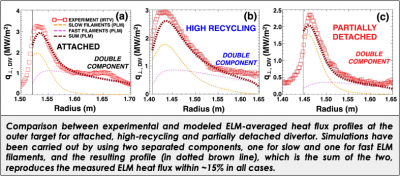 The paper titled “Measurements and modeling of type-I and type-II ELMs heat flux to the DIII-D divertor” by R. Perillo was published in Nuclear Fusion (https://doi.org/10.1088/1741-4326/acdf02). This paper shows that type-I and type-II edge-localized-modes (ELMs) heat flux profiles measured at the DIII-D divertor feature a peak in the vicinity of the strike-point and a plateau in the scrape-off-layer (SOL), which extends to the first wall. The plateau is present in attached and detached divertors and it is found to originate with plasma bursts upstream in the SOL. The integrated ELM heat flux is distributed at ∼65% in the peak and ∼35% in this plateau. The parallel loss model, currently used at ITER to predict power loads to the walls, is benchmarked using these results in the primary and secondary divertors with unprecedented constraints using experimental input data for ELM size, radial velocity, energy, electron temperature and density, heat flux footprints and number of filaments. The model can reproduce the experimental near-SOL peak within ∼20%, but cannot match the SOL plateau. Employing a two-component approach for the ELM radial velocity, as guided by intermittent data, the full radial heat flux profile can be well matched. The ELM-averaged radial velocity at the separatrix, which explains profile widening, increases from ∼0.2 km s−1 in attached to ∼0.8 km s−1 in detached scenarios, as the ELM filaments' path becomes electrically disconnected from the sheath at the target. The results presented here indicate filament fragmentation as a possible mechanism for ELM transport to the far-SOL and provide evidence on the beneficial role of detachment to mitigate ELM flux in the divertor far-SOL. However, these findings imply that wall regions far from the strike points in future machines should be designed to withstand significant heat flux, even for small-ELM regimes.
The paper titled “Measurements and modeling of type-I and type-II ELMs heat flux to the DIII-D divertor” by R. Perillo was published in Nuclear Fusion (https://doi.org/10.1088/1741-4326/acdf02). This paper shows that type-I and type-II edge-localized-modes (ELMs) heat flux profiles measured at the DIII-D divertor feature a peak in the vicinity of the strike-point and a plateau in the scrape-off-layer (SOL), which extends to the first wall. The plateau is present in attached and detached divertors and it is found to originate with plasma bursts upstream in the SOL. The integrated ELM heat flux is distributed at ∼65% in the peak and ∼35% in this plateau. The parallel loss model, currently used at ITER to predict power loads to the walls, is benchmarked using these results in the primary and secondary divertors with unprecedented constraints using experimental input data for ELM size, radial velocity, energy, electron temperature and density, heat flux footprints and number of filaments. The model can reproduce the experimental near-SOL peak within ∼20%, but cannot match the SOL plateau. Employing a two-component approach for the ELM radial velocity, as guided by intermittent data, the full radial heat flux profile can be well matched. The ELM-averaged radial velocity at the separatrix, which explains profile widening, increases from ∼0.2 km s−1 in attached to ∼0.8 km s−1 in detached scenarios, as the ELM filaments' path becomes electrically disconnected from the sheath at the target. The results presented here indicate filament fragmentation as a possible mechanism for ELM transport to the far-SOL and provide evidence on the beneficial role of detachment to mitigate ELM flux in the divertor far-SOL. However, these findings imply that wall regions far from the strike points in future machines should be designed to withstand significant heat flux, even for small-ELM regimes.
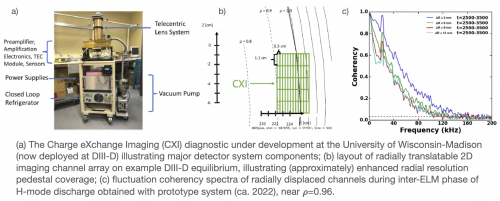 A new high radial resolution 2D multichannel Charge eXchange Imaging (CXI) diagnostic has been developed at the University of Wisconsin-Madison and deployed at DIII-D to measure low-to-intermediate radial wavenumber carbon density fluctuations, as described in M. Major et al., Rev. Sci. Instruments. 93, 113503 (2022), https://doi.org/10.1063/5.0101844. CXI observes the n = 8 − 7 (λ = 529 nm) CVI emission line resulting from charge exchange collisions between heating neutral beam atoms and the intrinsic carbon ion density. The new CXI diagnostic is providing measurements with ΔR ∼ 0.4 cm to access higher kr instabilities (kr < 8 cm^−1) predicted to arise in the steep-gradient region of H-mode pedestals. The CXI system will feature 60 fiber bundles in a 12 × 5 arrangement (current deployment 12 radial x 2 poloidal), with each channel consisting of four 1 mm fibers. A custom optical system was designed to filter and image incoming signals onto an 8 × 8 avalanche photodiode array for high speed, high signal-to-noise measurements. Additionally, a novel electronics suite has been designed and commissioned to amplify and digitize the relatively low-intensity carbon signal at a 2 MHz bandwidth. Initial measurements in DIII-D H-mode pedestals demonstrate broadband fluctuations up to several hundred kHz at sub-cm spatial resolution.
A new high radial resolution 2D multichannel Charge eXchange Imaging (CXI) diagnostic has been developed at the University of Wisconsin-Madison and deployed at DIII-D to measure low-to-intermediate radial wavenumber carbon density fluctuations, as described in M. Major et al., Rev. Sci. Instruments. 93, 113503 (2022), https://doi.org/10.1063/5.0101844. CXI observes the n = 8 − 7 (λ = 529 nm) CVI emission line resulting from charge exchange collisions between heating neutral beam atoms and the intrinsic carbon ion density. The new CXI diagnostic is providing measurements with ΔR ∼ 0.4 cm to access higher kr instabilities (kr < 8 cm^−1) predicted to arise in the steep-gradient region of H-mode pedestals. The CXI system will feature 60 fiber bundles in a 12 × 5 arrangement (current deployment 12 radial x 2 poloidal), with each channel consisting of four 1 mm fibers. A custom optical system was designed to filter and image incoming signals onto an 8 × 8 avalanche photodiode array for high speed, high signal-to-noise measurements. Additionally, a novel electronics suite has been designed and commissioned to amplify and digitize the relatively low-intensity carbon signal at a 2 MHz bandwidth. Initial measurements in DIII-D H-mode pedestals demonstrate broadband fluctuations up to several hundred kHz at sub-cm spatial resolution.
- A new article by W. Tang et al. titled “Implementation of AI/DEEP learning disruption predictor into a plasma control system” has been published in Contributions to Plasma Physics (DOI:10.1002/ctpp.202200095). The paper presents results of implementing the Fusion Recurrent Neural Network machine learning-based disruption prediction code into the DIII-D PCS in real-time. In addition to a warning level “Disruption Score”, the analysis includes sensitivity scores which identifies the model inputs that most contributed to the Disruption Score. The performance of the model with and without incorporating n=1 mode amplitude is presented, and the inclusion of this measurement is found to improve the model for earlier warning times.
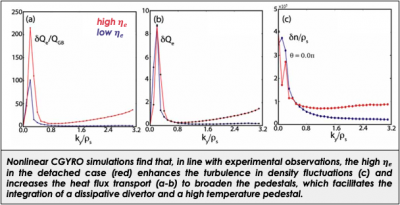 The integration of a high-performance core and a dissipative divertor, or the so-called “core–edge integration,” has been widely identified as a critical gap in the design of future fusion reactors. A recent paper addressing this issue by H. Wang was published in Nuclear Fusion titled “Direct measurement of the electron turbulence-broadening edge transport barrier to facilitate core–edge integration in tokamak fusion plasmas” (https://doi.org/10.1088/1741-4326/acdfe2). This letter reports, for the first time, direct experimental evidence of electron turbulence at the DIII-D H-mode pedestal that correlates with the broadening of the pedestal and thus facilitates core–edge integration. In agreement with gyrokinetic simulations, this electron turbulence is enhanced by high ηe (ηe = Ln/LTe, where Ln is the density scale length and LTe is the electron temperature scale length), which is due to a strong shift between the density and temperature pedestal profiles associated with a closed divertor. The modeled turbulence drives significant heat transport with a lower pressure gradient that may broaden the pedestal to a greater degree than the empirical and theoretically predicted pedestal width scalings. Such a wide pedestal, coupled with a closed divertor, enables us to achieve a good core–edge scenario that integrates a high-temperature low-collisionality pedestal (pedestal top temperature Te,ped > 0.8 keV and a pedestal top collisionality ν*ped < 1) under detached divertor conditions. This paves a new path toward solving the core–edge integration issue in future fusion reactors.
The integration of a high-performance core and a dissipative divertor, or the so-called “core–edge integration,” has been widely identified as a critical gap in the design of future fusion reactors. A recent paper addressing this issue by H. Wang was published in Nuclear Fusion titled “Direct measurement of the electron turbulence-broadening edge transport barrier to facilitate core–edge integration in tokamak fusion plasmas” (https://doi.org/10.1088/1741-4326/acdfe2). This letter reports, for the first time, direct experimental evidence of electron turbulence at the DIII-D H-mode pedestal that correlates with the broadening of the pedestal and thus facilitates core–edge integration. In agreement with gyrokinetic simulations, this electron turbulence is enhanced by high ηe (ηe = Ln/LTe, where Ln is the density scale length and LTe is the electron temperature scale length), which is due to a strong shift between the density and temperature pedestal profiles associated with a closed divertor. The modeled turbulence drives significant heat transport with a lower pressure gradient that may broaden the pedestal to a greater degree than the empirical and theoretically predicted pedestal width scalings. Such a wide pedestal, coupled with a closed divertor, enables us to achieve a good core–edge scenario that integrates a high-temperature low-collisionality pedestal (pedestal top temperature Te,ped > 0.8 keV and a pedestal top collisionality ν*ped < 1) under detached divertor conditions. This paves a new path toward solving the core–edge integration issue in future fusion reactors.
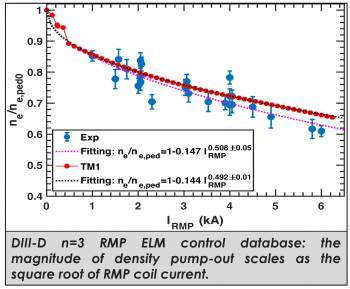 The paper “Validation of density pump-out by pedestal-foot magnetic island formation prior to ELM suppression in KSTAR and DIII-D tokamaks” (Q. Hu et al) was published in Nuclear Fusion (https://doi.org/10.1088/1741-4326/ace5c0). This work presents experimental validation on density pump-out caused by pedestal-foot magnetic island formation in both KSTAR and DIII-D tokamaks. Pedestal-foot magnetic island formation was proposed to be the responsible mechanism for RMP-caused density pump-out based on TM1 simulations. TM1 predicted several features to validate the mechanism: 1) bifurcated density pump-out by n=1 RMP, 2) sensitivity of density pump-out on q95, 3) the magnitude of density pump-out scale as the square root of RMP coil current. Dedicated experiments are carried out in KSTAR and DIII-D to validate these features and show that: 1) a staircase bifurcation in density pump-out is observed when slowly ramping up the n = 1 RMP current, and the density fluctuations are found to be slightly decreased in the pedestal region; 2) the magnitude of density pump-out becomes weaker when decreasing q95 from 5.5 to 4.9, and a partial recovery of density pump-out is observed when q95 is ramped down to lower than 4.9; 3) analysis of a DIII-D database of n = 3 RMP ELM control experiment finds that the magnitude of density pump-out is proportional to the square root of RMP coil current Δne/ne∝RMP^0.5 . These experimental observations are consistent with TM1 simulations.
The paper “Validation of density pump-out by pedestal-foot magnetic island formation prior to ELM suppression in KSTAR and DIII-D tokamaks” (Q. Hu et al) was published in Nuclear Fusion (https://doi.org/10.1088/1741-4326/ace5c0). This work presents experimental validation on density pump-out caused by pedestal-foot magnetic island formation in both KSTAR and DIII-D tokamaks. Pedestal-foot magnetic island formation was proposed to be the responsible mechanism for RMP-caused density pump-out based on TM1 simulations. TM1 predicted several features to validate the mechanism: 1) bifurcated density pump-out by n=1 RMP, 2) sensitivity of density pump-out on q95, 3) the magnitude of density pump-out scale as the square root of RMP coil current. Dedicated experiments are carried out in KSTAR and DIII-D to validate these features and show that: 1) a staircase bifurcation in density pump-out is observed when slowly ramping up the n = 1 RMP current, and the density fluctuations are found to be slightly decreased in the pedestal region; 2) the magnitude of density pump-out becomes weaker when decreasing q95 from 5.5 to 4.9, and a partial recovery of density pump-out is observed when q95 is ramped down to lower than 4.9; 3) analysis of a DIII-D database of n = 3 RMP ELM control experiment finds that the magnitude of density pump-out is proportional to the square root of RMP coil current Δne/ne∝RMP^0.5 . These experimental observations are consistent with TM1 simulations.
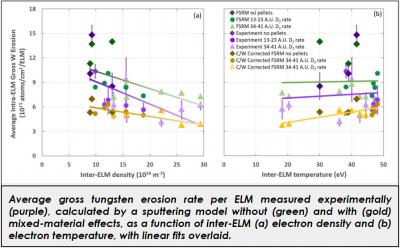 It is important to understand how ELM mitigation techniques will affect the erosion rate of the divertor in future devices. A recent paper by A. Cacheris et al., titled “The effectiveness of D2 pellet injection in reducing intra-ELM and inter-ELM tungsten divertor erosion rates in DIII-D during the Metal Rings Campaign” was published in Plasma Physics and Controlled Fusion (https://doi.org/10.1088/1361-6587/acd026). D2 pellets injected at the midplane of the DIII-D tokamak were used to mitigate W divertor erosion caused by type-I ELMs in H-mode plasmas during the Metal Rings Campaign. The overall trend, on average, is a reduction of W erosion per ELM with increasing inter-ELM density and increasing D2 pellet injection rate. Interpretive modeling using the free-streaming recycling model (FSRM) was conducted incorporating mixed-material effects. These results indicate that the interplay between an increasing divertor density and decreasing divertor temperature with increasing D2 injection may explain the similar intra-ELM W erosion at these D2 injection rates and inter-ELM densities.
It is important to understand how ELM mitigation techniques will affect the erosion rate of the divertor in future devices. A recent paper by A. Cacheris et al., titled “The effectiveness of D2 pellet injection in reducing intra-ELM and inter-ELM tungsten divertor erosion rates in DIII-D during the Metal Rings Campaign” was published in Plasma Physics and Controlled Fusion (https://doi.org/10.1088/1361-6587/acd026). D2 pellets injected at the midplane of the DIII-D tokamak were used to mitigate W divertor erosion caused by type-I ELMs in H-mode plasmas during the Metal Rings Campaign. The overall trend, on average, is a reduction of W erosion per ELM with increasing inter-ELM density and increasing D2 pellet injection rate. Interpretive modeling using the free-streaming recycling model (FSRM) was conducted incorporating mixed-material effects. These results indicate that the interplay between an increasing divertor density and decreasing divertor temperature with increasing D2 injection may explain the similar intra-ELM W erosion at these D2 injection rates and inter-ELM densities.
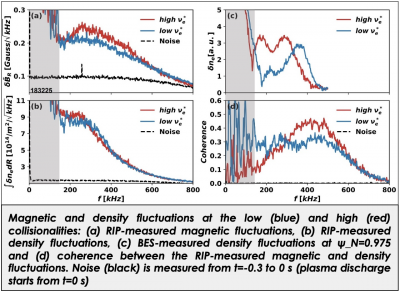 A paper by Jie Chen et al., titled “Micro-tearing mode dominated electron heat transport in DIII-D H-mode pedestal”, was published in Nuclear Fusion (https://doi.org/10.1088/1741-4326/accafb). This paper presents a comprehensive set of evidence which reveals that micro-tearing modes (MTMs) dominate pedestal electron heat transport in an H-mode experiment in the DIII-D tokamak. The experiment investigates the role of MTMs by scanning pedestal collisionality, a main drive of MTM instability, from 0.43 to 0.84 on the pedestal top. Broadband (150-800 kHz) magnetic and density fluctuations originating from the pedestal gradient region and highly consistent with MTMs are observed, with amplitude increasing during the scan. The higher magnetic fluctuation amplitude correlates with a lower pedestal electron temperature gradient, implying MTMs may regulate the pedestal electron heat transport. The collisionality scan results in profile and transport changes consistent with predicted transport capability of MTMs: 1) experimentally-determined electron heat diffusivity increases ~40% at the location where the broadband density fluctuations peak; 2) ion heat diffusivity has less increase (<20%); and 3) a locally flattened region in the electron temperature pedestal is observed at high collisionality. A local, linear gyrokinetic simulation finds MTMs as the most unstable mode in the pedestal gradient region. In addition, local, nonlinear simulations suggest MTMs can dominate and drive experimentally-relevant, megawatt-level electron heat flux. This result establishes MTMs as an effective transport mechanism in the H-mode pedestal, in particular at high collisionality.
A paper by Jie Chen et al., titled “Micro-tearing mode dominated electron heat transport in DIII-D H-mode pedestal”, was published in Nuclear Fusion (https://doi.org/10.1088/1741-4326/accafb). This paper presents a comprehensive set of evidence which reveals that micro-tearing modes (MTMs) dominate pedestal electron heat transport in an H-mode experiment in the DIII-D tokamak. The experiment investigates the role of MTMs by scanning pedestal collisionality, a main drive of MTM instability, from 0.43 to 0.84 on the pedestal top. Broadband (150-800 kHz) magnetic and density fluctuations originating from the pedestal gradient region and highly consistent with MTMs are observed, with amplitude increasing during the scan. The higher magnetic fluctuation amplitude correlates with a lower pedestal electron temperature gradient, implying MTMs may regulate the pedestal electron heat transport. The collisionality scan results in profile and transport changes consistent with predicted transport capability of MTMs: 1) experimentally-determined electron heat diffusivity increases ~40% at the location where the broadband density fluctuations peak; 2) ion heat diffusivity has less increase (<20%); and 3) a locally flattened region in the electron temperature pedestal is observed at high collisionality. A local, linear gyrokinetic simulation finds MTMs as the most unstable mode in the pedestal gradient region. In addition, local, nonlinear simulations suggest MTMs can dominate and drive experimentally-relevant, megawatt-level electron heat flux. This result establishes MTMs as an effective transport mechanism in the H-mode pedestal, in particular at high collisionality.
FY23-Q3:
- A topical review paper by Rich Groebner, titled “Elements of H-mode pedestal structure,” was published in Plasma Physics and Controlled Fusion (https://www.doi.org/10.1088/1361-6587/acd478). This paper reviews current understanding of key physics elements that control the H-mode pedestal structure, which exists at the boundary of magnetically confined plasmas. The structure of interest is the width, height and gradient of temperature, density and pressure profiles in the pedestal. Emphasis is placed on understanding obtained from combined experimental, theoretical and simulation work and on results observed on multiple machines. Pedestal profiles are determined by the self-consistent interaction of sources, transport and magnetohydrodynamic limits. The heat source is primarily from heat deposited in the core and flowing to the pedestal. This source is computed from modeling of experimental data and is generally well understood. Neutrals at the periphery of the plasma provide the dominant particle source in current machines. This source has a complex spatial structure, is very difficult to measure and is poorly understood. For typical H-mode operation, the achievable pedestal pressure is limited by repetitive, transient magnetohydrodynamic instabilities. First principles models of peeling–ballooning modes are generally able to explain the observed limits. In some regimes, instability occurs below the predicted limits and these remain unexplained. Several mechanisms have been identified as plausible sources of heat transport. These include neoclassical processes for ion heat transport and several turbulent processes, driven by the steep pedestal gradients, as sources of electron and ion heat transport. Reduced models have successfully predicted the pedestal or density at the pedestal top. Firming up understanding of heat and particle transport remains a primary challenge for developing more complete predictive pedestal models.
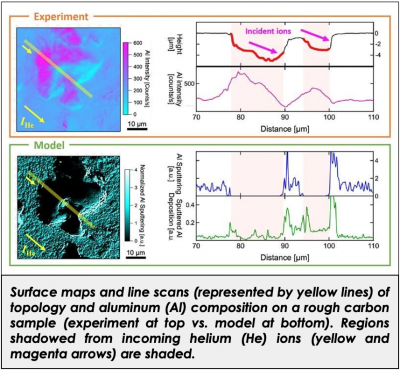 The rough surface, caused by sputtering and/or manufacturing process, at the divertor affects the incident ion angle and ion-shadowed area. The incident ion angle is a critical parameter for material erosion, and the ion-shadowed area can be a significant source of redeposited impurities. The paper “Computational investigation of incident ion angles and material erosion at rough graphite and silicon carbide divertor surfaces”, by S. Abe et al. was recently published in Nuclear Fusion (https://doi.org/10.1063/5.0095155) and featured as a DOE Office of Science highlight (https://www.energy.gov/science/fes/articles/stuck-rough-how-aging-reactor-walls-may-exhibit-lower-erosion). This work presents a computational investigation of the dependence of material erosion on the incident ion angle at rough divertor surfaces. Ion angle distributions (IADs) for D plasmas at DIII-D and NSTX-U divertors were calculated by an equation-of-motion model that traces the ion trajectories in the sheath. Then, the effective sputtering yields and ion shadowed area fractions were calculated by a Monte Carlo micro-patterning and roughness code that applied the calculated IADs to surface topographic data that were obtained from optical confocal microscopy of rough graphite and SiC divertor surfaces from DIII-D and NSTX-U experiments. The suppression of the effective sputtering yields for rough surfaces compared to the yield for a smooth surface was accounted for by the change of the mean local incident ion angle (LIIA). The mean surface inclination angle distribution (SIAD) was found to be a useful parameter to estimate the LIIA and ion-shadowed area from the calculated IADs rather than the root mean square roughness.
The rough surface, caused by sputtering and/or manufacturing process, at the divertor affects the incident ion angle and ion-shadowed area. The incident ion angle is a critical parameter for material erosion, and the ion-shadowed area can be a significant source of redeposited impurities. The paper “Computational investigation of incident ion angles and material erosion at rough graphite and silicon carbide divertor surfaces”, by S. Abe et al. was recently published in Nuclear Fusion (https://doi.org/10.1063/5.0095155) and featured as a DOE Office of Science highlight (https://www.energy.gov/science/fes/articles/stuck-rough-how-aging-reactor-walls-may-exhibit-lower-erosion). This work presents a computational investigation of the dependence of material erosion on the incident ion angle at rough divertor surfaces. Ion angle distributions (IADs) for D plasmas at DIII-D and NSTX-U divertors were calculated by an equation-of-motion model that traces the ion trajectories in the sheath. Then, the effective sputtering yields and ion shadowed area fractions were calculated by a Monte Carlo micro-patterning and roughness code that applied the calculated IADs to surface topographic data that were obtained from optical confocal microscopy of rough graphite and SiC divertor surfaces from DIII-D and NSTX-U experiments. The suppression of the effective sputtering yields for rough surfaces compared to the yield for a smooth surface was accounted for by the change of the mean local incident ion angle (LIIA). The mean surface inclination angle distribution (SIAD) was found to be a useful parameter to estimate the LIIA and ion-shadowed area from the calculated IADs rather than the root mean square roughness.
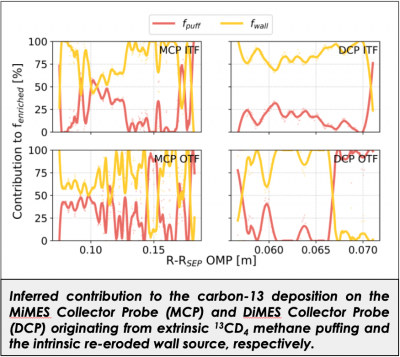 The paper “13C surface characterization of midplane and crown collector probes on DIII-D” by J. Duran et al. was recently published in Nuclear Materials and Energy (https://doi.org/10.1016/j.nme.2022.101339). Impurity transport outside of the confined plasma region is an important control feature for core impurity mitigation in fusion systems. This paper furthers the physics-based understanding of edge impurity transport through controlled injection of isotopically marked impurities followed by collection with physical probes. These ‘collector probes’ are positioned at multiple locations throughout the tokamak while the isotopic tracer impurities are in transit. The use of an enriched isotopic source of impurities and a multi-collector probe system has enabled the use of an isotopic mixing model that has identified a re-eroded wall source within DIII-D that has contributed to the collected impurities on the collector probe surfaces. These results lay the foundation for modelling efforts that includes accurate representation of the impurity sources which feed the collector probe measurements.
The paper “13C surface characterization of midplane and crown collector probes on DIII-D” by J. Duran et al. was recently published in Nuclear Materials and Energy (https://doi.org/10.1016/j.nme.2022.101339). Impurity transport outside of the confined plasma region is an important control feature for core impurity mitigation in fusion systems. This paper furthers the physics-based understanding of edge impurity transport through controlled injection of isotopically marked impurities followed by collection with physical probes. These ‘collector probes’ are positioned at multiple locations throughout the tokamak while the isotopic tracer impurities are in transit. The use of an enriched isotopic source of impurities and a multi-collector probe system has enabled the use of an isotopic mixing model that has identified a re-eroded wall source within DIII-D that has contributed to the collected impurities on the collector probe surfaces. These results lay the foundation for modelling efforts that includes accurate representation of the impurity sources which feed the collector probe measurements.
 The paper titled “Validation of EDGDE2D-EIRENE predicted 2D distributions of electron temperature and density against divertor Thomson scattering measurements in the low-field side divertor leg in DIII-D“ by M. Groth et al. was published in Nuclear Materials and Energy (https://doi.org/10.1016/j.nme.2023.101372). This work shows that the physics models implemented in the edge fluid code EDGE2D-EIRENE predict the measured 2D electron temperature, density and pressure distributions in DIII-D low-confinement mode discharges using Divertor Thomson Scattering (DTS) within their collective uncertainties if the electron temperature in the divertor is 10 eV or higher. The simulations do not predict, however, the peaked electron temperature and density profiles measured adjacent to the target plate when Te,sep, is below 10 eV, i.e., for the plasma downstream from the region of ionization of deuterium atoms. Inclusion of cross-field drifts and a five-fold reduction of radial transport cannot reconcile the discrepancy between the measurements and predictions. Isolating the discrepancy to a region downstream of the ionization front, and identifying the shortcomings in the model likely being a combination of plasma transport and atomic and molecular physics, was made possible through DIII-D's unique, highly reproducible DTS measurements.
The paper titled “Validation of EDGDE2D-EIRENE predicted 2D distributions of electron temperature and density against divertor Thomson scattering measurements in the low-field side divertor leg in DIII-D“ by M. Groth et al. was published in Nuclear Materials and Energy (https://doi.org/10.1016/j.nme.2023.101372). This work shows that the physics models implemented in the edge fluid code EDGE2D-EIRENE predict the measured 2D electron temperature, density and pressure distributions in DIII-D low-confinement mode discharges using Divertor Thomson Scattering (DTS) within their collective uncertainties if the electron temperature in the divertor is 10 eV or higher. The simulations do not predict, however, the peaked electron temperature and density profiles measured adjacent to the target plate when Te,sep, is below 10 eV, i.e., for the plasma downstream from the region of ionization of deuterium atoms. Inclusion of cross-field drifts and a five-fold reduction of radial transport cannot reconcile the discrepancy between the measurements and predictions. Isolating the discrepancy to a region downstream of the ionization front, and identifying the shortcomings in the model likely being a combination of plasma transport and atomic and molecular physics, was made possible through DIII-D's unique, highly reproducible DTS measurements.
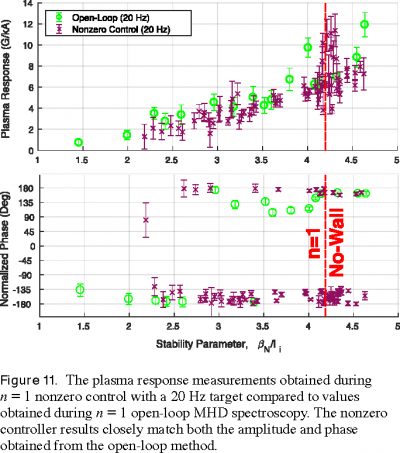 The paper “Simultaneous stabilization and control of the n=1 and n=2 resistive wall mode” was published in Nuclear Fusion (Battey et al 2023 Nucl. Fusion https://doi.org/10.1088/1741-4326/accd81) by postdoctoral researcher Alex Battey (Columbia Univ.). A novel controller and observer was demonstrated on DIII-D which was shown to be capable of stabilizing both the n=1 and n=2 resistive wall mode (RWM) up to values of beta_N approaching the n=2 ideal wall limit. This controller was also implemented with a flexible nonzero target which allows the mode to be controlled at a nonzero amplitude and frequency. This allows plasma response data to be obtained in close-loop during active feedback control for comparison with various stability models and to allow for more robust future controllers and observers.
The paper “Simultaneous stabilization and control of the n=1 and n=2 resistive wall mode” was published in Nuclear Fusion (Battey et al 2023 Nucl. Fusion https://doi.org/10.1088/1741-4326/accd81) by postdoctoral researcher Alex Battey (Columbia Univ.). A novel controller and observer was demonstrated on DIII-D which was shown to be capable of stabilizing both the n=1 and n=2 resistive wall mode (RWM) up to values of beta_N approaching the n=2 ideal wall limit. This controller was also implemented with a flexible nonzero target which allows the mode to be controlled at a nonzero amplitude and frequency. This allows plasma response data to be obtained in close-loop during active feedback control for comparison with various stability models and to allow for more robust future controllers and observers.
 An invited paper titled “First Demonstration of a Fiber Optic Bolometer on a Tokamak Plasma” by S. Lee et al. was published in Review of Scientific Instruments High Temperature Plasma Diagnostics Special Edition (https://doi.org/10.1063/5.0099546). A fiber optic bolometer (FOB) was demonstrated observing a fusion plasma for the first time at the DIII-D tokamak. A FOB uses a fiber optics-based interferometric technique that is designed to have a high sensitivity to temperature changes with a negligible susceptibility to electromagnetic interference (EMI) that can be problematic for resistive bolometers in a tokamak environment. A single-channel FOB was installed on DIII-D and showed a negligible increase in the noise level during typical plasma operations (0.39 mK) compared to the benchtop results (0.38 mK), confirming an insignificant EMI impact to the FOB. Comparisons to DIII-D resistive bolometers showed good agreement with the single-channel FOB, indicating that the FOB is comparable to a resistive bolometer when the impulse calibration is applied. The major potential effect of ionizing radiation on the FOB would be the radiation-induced attenuation, which can be efficiently compensated for by adjusting the probing light power.
An invited paper titled “First Demonstration of a Fiber Optic Bolometer on a Tokamak Plasma” by S. Lee et al. was published in Review of Scientific Instruments High Temperature Plasma Diagnostics Special Edition (https://doi.org/10.1063/5.0099546). A fiber optic bolometer (FOB) was demonstrated observing a fusion plasma for the first time at the DIII-D tokamak. A FOB uses a fiber optics-based interferometric technique that is designed to have a high sensitivity to temperature changes with a negligible susceptibility to electromagnetic interference (EMI) that can be problematic for resistive bolometers in a tokamak environment. A single-channel FOB was installed on DIII-D and showed a negligible increase in the noise level during typical plasma operations (0.39 mK) compared to the benchtop results (0.38 mK), confirming an insignificant EMI impact to the FOB. Comparisons to DIII-D resistive bolometers showed good agreement with the single-channel FOB, indicating that the FOB is comparable to a resistive bolometer when the impulse calibration is applied. The major potential effect of ionizing radiation on the FOB would be the radiation-induced attenuation, which can be efficiently compensated for by adjusting the probing light power.
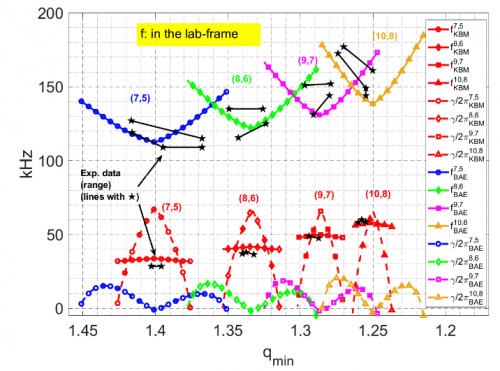 The paper, “Low-frequency shear Alfvén waves at DIII-D: theoretical interpretation of experimental observations” by R.R. Ma et al. was recently published in Physics of Plasmas (https://doi.org/10.48550/arXiv.2301.01464). Using a theoretical framework called the “generalized fishbone-like dispersion relation,” the paper calculates the frequencies and growth rates of two DIII-D instabilities, the beta-induced Alfven eigenmode (BAE) and a lower frequency mode called the low-frequency Alfvén mode (LFAM). The calculations successfully reproduce the observed frequencies and the tendency of these two modes to be more unstable at rational values of qmin (see figure).
The paper, “Low-frequency shear Alfvén waves at DIII-D: theoretical interpretation of experimental observations” by R.R. Ma et al. was recently published in Physics of Plasmas (https://doi.org/10.48550/arXiv.2301.01464). Using a theoretical framework called the “generalized fishbone-like dispersion relation,” the paper calculates the frequencies and growth rates of two DIII-D instabilities, the beta-induced Alfven eigenmode (BAE) and a lower frequency mode called the low-frequency Alfvén mode (LFAM). The calculations successfully reproduce the observed frequencies and the tendency of these two modes to be more unstable at rational values of qmin (see figure).
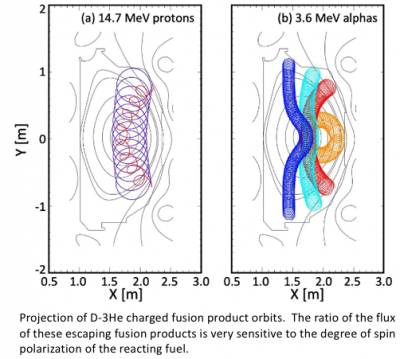 If the deuterium and tritium nuclei are spin polarized, the D-T fusion cross section is 50% larger. Theoretically, polarized nuclei will remain polarized in a hot plasma but this prediction has never been tested experimentally. Two recently published Nuclear Fusion papers, “Polarized fusion and potential in situ tests of fuel polarization survival in a tokamak plasma” by L. Baylor et al. [DOI 10.1088/1741-4326/acc3ae] and “Conceptual design of DIII-D experiments to diagnose the lifetime of spin polarized fuel” by A.V. Garcia et al. [DOI 10.1088/1741-4326/acaf0d] show that experimental measurements are now feasible in DIII-D. The experiments will use D-3He as a proxy for D-T. The polarized D and 3He fuel is delivered in LiD and 3He shell pellets, respectively. Measurements with an array of charged fusion product detectors that are sensitive to the differential fusion cross section detect the degree of polarization.
If the deuterium and tritium nuclei are spin polarized, the D-T fusion cross section is 50% larger. Theoretically, polarized nuclei will remain polarized in a hot plasma but this prediction has never been tested experimentally. Two recently published Nuclear Fusion papers, “Polarized fusion and potential in situ tests of fuel polarization survival in a tokamak plasma” by L. Baylor et al. [DOI 10.1088/1741-4326/acc3ae] and “Conceptual design of DIII-D experiments to diagnose the lifetime of spin polarized fuel” by A.V. Garcia et al. [DOI 10.1088/1741-4326/acaf0d] show that experimental measurements are now feasible in DIII-D. The experiments will use D-3He as a proxy for D-T. The polarized D and 3He fuel is delivered in LiD and 3He shell pellets, respectively. Measurements with an array of charged fusion product detectors that are sensitive to the differential fusion cross section detect the degree of polarization.
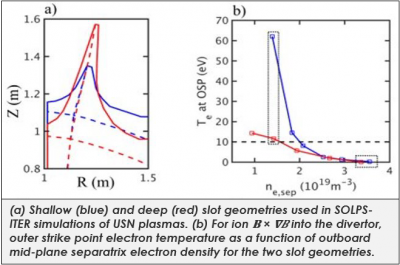 The paper titled “Modeling deep slot divertor concepts at DIII-D using SOLPS-ITER with drifts” by R. Maurizio et al. was published in Nuclear Materials and Engineering (https://doi.org/10.1016/j.nme.2022.101356). A staged divertor program is planned to advance DIII-D research on core-edge integration, and the 2nd stage dissipative divertor will address optimization of power and particle exhaust. This paper utilizes SOLPS-ITER simulations with full particle drifts enabled and focuses on the role of slot depth to achieve highly dissipative (detached) divertor conditions, in both Bt directions. With ion B×∇B into the divertor and PSOL = 4 MW, simulations reveal that increasing the depth of a divertor slot from 18 to 50 cm reduces the upstream separatrix electron density needed to detach by 15% primarily due to increased divertor radiation. The deep slot has lower target temperature compared to the shallow slot as a result of lower neutral leakage. Reversing the Bt direction cools and densifies the plasma in the slot, such that both slot options are detached at all simulated densities. Increasing the depth of a slot divertor is beneficial to achieve highly dissipative divertor conditions for both field directions. Additional modeling will build on these results to further inform the design of the Stage 2 divertor.
The paper titled “Modeling deep slot divertor concepts at DIII-D using SOLPS-ITER with drifts” by R. Maurizio et al. was published in Nuclear Materials and Engineering (https://doi.org/10.1016/j.nme.2022.101356). A staged divertor program is planned to advance DIII-D research on core-edge integration, and the 2nd stage dissipative divertor will address optimization of power and particle exhaust. This paper utilizes SOLPS-ITER simulations with full particle drifts enabled and focuses on the role of slot depth to achieve highly dissipative (detached) divertor conditions, in both Bt directions. With ion B×∇B into the divertor and PSOL = 4 MW, simulations reveal that increasing the depth of a divertor slot from 18 to 50 cm reduces the upstream separatrix electron density needed to detach by 15% primarily due to increased divertor radiation. The deep slot has lower target temperature compared to the shallow slot as a result of lower neutral leakage. Reversing the Bt direction cools and densifies the plasma in the slot, such that both slot options are detached at all simulated densities. Increasing the depth of a slot divertor is beneficial to achieve highly dissipative divertor conditions for both field directions. Additional modeling will build on these results to further inform the design of the Stage 2 divertor.
 The paper “Design Study of an Edge Current Density Diagnostic Using New High-Performance Single-Channel Beam Emission Spectrometers at DIII-D” was published in Reviews of Scientific Instruments (https://doi.org/10.1063/5.0101781) by graduate student Ryan Albosta (U. Wisconsin). A new spectral Motional-Stark-Effect manifold diagnostic is being installed at DIII-D to resolve the edge-current density with up to 10 kHz time resolution. The system will simultaneously analyze the Doppler-shifted and Stark split MSE manifold and sigma/pi line ratios of the Balmer-Alpha and Balmer-Beta radiation resulting from collisional fluorescence of the heating deuterium neutral beams. This provides localized information on the magnetic field vector and, using multiple channels, allows inferring current density profiles. Each channel consists of a high-throughput 2-leg Czerny-Turner spectrometer using custom-made aspherical lenses and state-of-the-art EMCCD cameras that are fiber-coupled to the Beam Emission Spectroscopy collection optics viewing the 150-neutral beam line. FIDASIM modeling (see figure) has shown expected B_pol uncertainties of less than 1 mT, yielding a current density accuracy of 80 kA/m^2 at 1 cm radial resolution and spacing of adjacent channels.
The paper “Design Study of an Edge Current Density Diagnostic Using New High-Performance Single-Channel Beam Emission Spectrometers at DIII-D” was published in Reviews of Scientific Instruments (https://doi.org/10.1063/5.0101781) by graduate student Ryan Albosta (U. Wisconsin). A new spectral Motional-Stark-Effect manifold diagnostic is being installed at DIII-D to resolve the edge-current density with up to 10 kHz time resolution. The system will simultaneously analyze the Doppler-shifted and Stark split MSE manifold and sigma/pi line ratios of the Balmer-Alpha and Balmer-Beta radiation resulting from collisional fluorescence of the heating deuterium neutral beams. This provides localized information on the magnetic field vector and, using multiple channels, allows inferring current density profiles. Each channel consists of a high-throughput 2-leg Czerny-Turner spectrometer using custom-made aspherical lenses and state-of-the-art EMCCD cameras that are fiber-coupled to the Beam Emission Spectroscopy collection optics viewing the 150-neutral beam line. FIDASIM modeling (see figure) has shown expected B_pol uncertainties of less than 1 mT, yielding a current density accuracy of 80 kA/m^2 at 1 cm radial resolution and spacing of adjacent channels.
FY23-Q2:
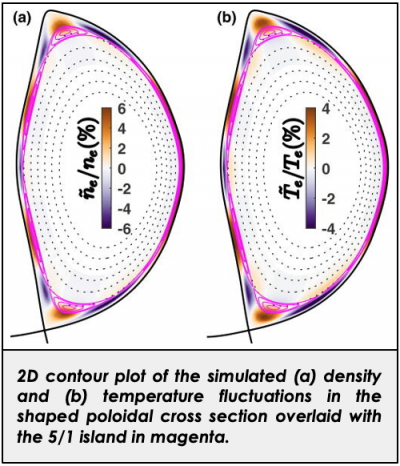 The paper “Role of edge-localized neoclassical tearing modes in quiescent H-mode plasmas in the DIII-D tokamak” (Q. Hu et al) has been published in Physics of Plasmas (https://doi.org/10.1063/5.0137123). This work presents an alternative mechanism for the onset of edge-harmonic oscillations (EHO) in quiescent H-mode (QH) plasmas in DIII-D based on nonlinear two-fluid MHD simulations. Using kinetic equilibria constrained by edge profile measurements, the MHD simulations show that the n=1 NTM and its harmonics can be destabilized at the pedestal top of QH-mode plasma by the edge bootstrap current. The simulations further show that the unstable NTMs can saturate either at small or large island width depending on the magnitude of the edge bootstrap current. The onset of the EHO also results in a prompt decrease in the pedestal width and height, consistent with simulation results for the onset of the NTM at the top of the QH-mode pedestal. This suggests that the avoidance of edge-localized modes (ELMs) in QH-mode can be attributed to the enhanced local transport induced by the NTM that is sufficient to prevent the expansion of the pedestal to an unstable width, analogous to the mechanism explored for ELM suppression by resonant magnetic perturbations. Nonlinear MHD simulations scanning the E×B frequency and the ratio of parallel and perpendicular thermal diffusivity at the pedestal top show that edge-localized NTMs are destabilized for conditions of high E×B frequency, high pedestal temperature, and low pedestal density, qualitatively consistent with experimental conditions required for observing the EHO.
The paper “Role of edge-localized neoclassical tearing modes in quiescent H-mode plasmas in the DIII-D tokamak” (Q. Hu et al) has been published in Physics of Plasmas (https://doi.org/10.1063/5.0137123). This work presents an alternative mechanism for the onset of edge-harmonic oscillations (EHO) in quiescent H-mode (QH) plasmas in DIII-D based on nonlinear two-fluid MHD simulations. Using kinetic equilibria constrained by edge profile measurements, the MHD simulations show that the n=1 NTM and its harmonics can be destabilized at the pedestal top of QH-mode plasma by the edge bootstrap current. The simulations further show that the unstable NTMs can saturate either at small or large island width depending on the magnitude of the edge bootstrap current. The onset of the EHO also results in a prompt decrease in the pedestal width and height, consistent with simulation results for the onset of the NTM at the top of the QH-mode pedestal. This suggests that the avoidance of edge-localized modes (ELMs) in QH-mode can be attributed to the enhanced local transport induced by the NTM that is sufficient to prevent the expansion of the pedestal to an unstable width, analogous to the mechanism explored for ELM suppression by resonant magnetic perturbations. Nonlinear MHD simulations scanning the E×B frequency and the ratio of parallel and perpendicular thermal diffusivity at the pedestal top show that edge-localized NTMs are destabilized for conditions of high E×B frequency, high pedestal temperature, and low pedestal density, qualitatively consistent with experimental conditions required for observing the EHO.
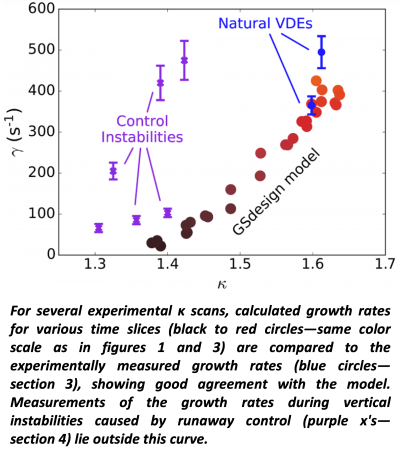 The paper “Vertical control of DIII-D discharges with strong negative triangularity” by A.O. Nelson et. al. was published in Plasma Physics and Controlled Fusion (https://doi.org/10.1088/1361-6587/acbe65). This work validates vertical stability calculations included in the TokSys model on Ohmic negative triangularity (NT) configurations on DIII-D, demonstrating pathways towards vertical control on DIII-D that were employed during the NT Armor Campaign. Notably, the paper also identifies a strong stabilizing contribution of a non-conformal wall in NT, suggesting that future NT machines can expand their potential operating space by carefully considering the shape of their stabilizing elements. This finding and the presented low-beta cases will be used to validate flexible MHD codes capable of optimizing the vertical stability problem for next-generation NT reactor designs.
The paper “Vertical control of DIII-D discharges with strong negative triangularity” by A.O. Nelson et. al. was published in Plasma Physics and Controlled Fusion (https://doi.org/10.1088/1361-6587/acbe65). This work validates vertical stability calculations included in the TokSys model on Ohmic negative triangularity (NT) configurations on DIII-D, demonstrating pathways towards vertical control on DIII-D that were employed during the NT Armor Campaign. Notably, the paper also identifies a strong stabilizing contribution of a non-conformal wall in NT, suggesting that future NT machines can expand their potential operating space by carefully considering the shape of their stabilizing elements. This finding and the presented low-beta cases will be used to validate flexible MHD codes capable of optimizing the vertical stability problem for next-generation NT reactor designs.
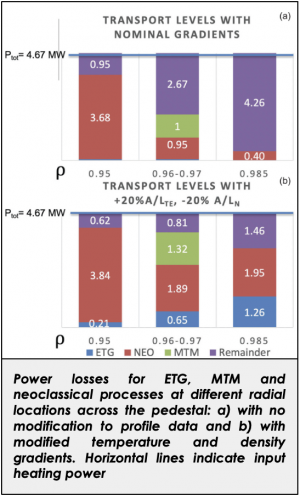 A paper titled “Gyrokinetic analysis of inter-edge localized mode transport mechanisms in a DIII-D pedestal” by M.R. Halfmoon et al. was published in Physics of Plasmas (https://doi.org/10.1063/5.0102152). This paper reports results of gyrokinetic simulations with the GENE code to study pedestal fluctuations for DIII-D discharge 174082. Nonlinear local simulations indicate that electron heat flux has contributions from electron temperature gradient-driven transport (ETG) but at levels insufficient to satisfy power balance. It is shown that microtearing modes (MTM) and neoclassical transport are likely to account for the remaining observed energy losses in the electron and ion channels, respectively. The MTM instabilities found in the simulations are consistent with the high-frequency fluctuations identified in the magnetic fluctuation data from Mirnov coils. The fluctuation data in this discharge also exhibit a low-frequency band of fluctuations. By modifying the equilibrium profiles and plasma β, simulations produce MHD modes, which may be responsible for these observed low-frequency fluctuations. Several metrics are computed for ratios of fluctuation amplitudes and transport quantities for both MTMs and MHD modes. This analysis suggests that the available data are consistent with the simultaneous activity of both MHD modes and MTMs provided that the former is limited largely to the particle transport channel. This article was featured on the cover of POP's November 2022 issue.
A paper titled “Gyrokinetic analysis of inter-edge localized mode transport mechanisms in a DIII-D pedestal” by M.R. Halfmoon et al. was published in Physics of Plasmas (https://doi.org/10.1063/5.0102152). This paper reports results of gyrokinetic simulations with the GENE code to study pedestal fluctuations for DIII-D discharge 174082. Nonlinear local simulations indicate that electron heat flux has contributions from electron temperature gradient-driven transport (ETG) but at levels insufficient to satisfy power balance. It is shown that microtearing modes (MTM) and neoclassical transport are likely to account for the remaining observed energy losses in the electron and ion channels, respectively. The MTM instabilities found in the simulations are consistent with the high-frequency fluctuations identified in the magnetic fluctuation data from Mirnov coils. The fluctuation data in this discharge also exhibit a low-frequency band of fluctuations. By modifying the equilibrium profiles and plasma β, simulations produce MHD modes, which may be responsible for these observed low-frequency fluctuations. Several metrics are computed for ratios of fluctuation amplitudes and transport quantities for both MTMs and MHD modes. This analysis suggests that the available data are consistent with the simultaneous activity of both MHD modes and MTMs provided that the former is limited largely to the particle transport channel. This article was featured on the cover of POP's November 2022 issue.
- The paper “Parametric study of Alfvénic instabilities driven by runaway electrons during the current quench in DIII-D” by A. Lvovskiy et al. was published in Nuclear Fusion (https://doi.org/10.1088/1741-4326/acb725). Alfvénic instabilities, often observed in the MHz range driven by runaway electrons (REs) during the current quench in DIII-D, correlate with increased RE loss from the plasma which makes them a potential means for mitigation of RE generation in future tokamaks. This work documents observation of these instabilities depending on the pre-disruption plasma and injection parameters. It was found, that decreasing toroidal magnetic field increases the power of instabilities and decreases their frequency and spacing which may explain the experimental threshold on magnetic field for sustained RE beams in tokamaks. Increasing pre-disruption plasma core temperature leads to increased thermal to RE current conversion, decreased energy of RE population and very weak or missing Alfvénic instabilities. Magnetic spectrograms and polarization measurements suggest the drive of compressional Alfvén eigenmodes, however global Alfvén eigenmodes are also possible at lower frequencies. Analysis of disruptions caused by injection of neon or deuterium, known to produce no sustained RE beams in DIII-D under any conditions, shows that the role of Alfvénic instabilities is minor or negligible in these cases.
- The paper “The physics basis to integrate an MHD stable, high-power hybrid scenario to a cool divertor for steady-state reactor operation” (F. Turco et al) has been published in Nuclear Fusion (https://iopscience.iop.org/article/10.1088/1741-4326/acb370). This work presents the physics basis for trade-offs between density, current drive and stability to tearing modes at high beta. EC power is crucial to tailor the plasma profiles into a passively stable state, and to eject impurities from the core. Off-axis EC depositions decrease the heating efficiency, but calculated electron heat transport coefficients show that this effect is partially mitigated by improved confinement inside the EC deposition. Additionally, the reduction in pressure is recovered by increasing the density. This favorable scaling of confinement with density was observed in high power plasmas for years, and this work provides a comprehensive explanation. ELITE predictions indicate that a path in peeling-ballooning stability opens up for certain conditions of density, power, q95 and shaping, allowing the edge pressure to continue increasing without encountering a limit. In the core, calculated anomalous fast-ion diffusion coefficients are consistent with density fluctuation measurements in the TAE range, showing that smaller fast-ion losses contribute to the enhanced confinement at high density. The edge integration study shows that divertor heat loads can be reduced with Ne and Ar injection, but this eventually triggers a cascade of n=1,2,3 core tearing modes. We can now show that impurity radiation in the core is small and it is not the cause for the drop in confinement at high Ar and Ne injection rates. The overlap between the core tearing modes is consistent with the loss of pressure as estimated by the Belt model for the coupled rational surfaces. Optimization of these trade-offs has achieved plasmas with sustained H98y2=1.7, fGW=0.7 and ~85% mantle radiation. The scenario and its variations at higher density and on- vs off-axis EC heating has been studied as a candidate for an integrated solution for several reactor designs, such as ITER, ARC, and the ARIES-ACT1 case, showing promising results in terms of fusion power and gain.
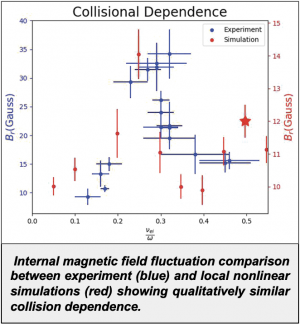 A manuscript titled “Gyrokinetic Simulations Compared with Magnetic Fluctuations Diagnosed with a Faraday-Effect Radial Interferometer-Polarimeter in the DIII-D pedestal” by M. Curie et al. was published in Nuclear Fusion (https://doi.org/10.1088/1741-4326/ac9b76). The work presents the first-time-ever direct comparison between nonlinear gyro kinetic simulations and internal magnetic fluctuation measurements. The shared characteristics of fluctuations such as non-monotonic collision dependence, frequency matching, (dB/B)/(dn_e/n_e) matching, show the microtearing modes (MTM) are present in the DIII-D pedestal. Transport from the simulations shows MTMs contributes a significant amount of electron heat flux.
A manuscript titled “Gyrokinetic Simulations Compared with Magnetic Fluctuations Diagnosed with a Faraday-Effect Radial Interferometer-Polarimeter in the DIII-D pedestal” by M. Curie et al. was published in Nuclear Fusion (https://doi.org/10.1088/1741-4326/ac9b76). The work presents the first-time-ever direct comparison between nonlinear gyro kinetic simulations and internal magnetic fluctuation measurements. The shared characteristics of fluctuations such as non-monotonic collision dependence, frequency matching, (dB/B)/(dn_e/n_e) matching, show the microtearing modes (MTM) are present in the DIII-D pedestal. Transport from the simulations shows MTMs contributes a significant amount of electron heat flux.
- The paper “Trends in runaway electron plateau partial recombination by massive H2 or D2 injection in DIII-D and JET and first extrapolations to ITER and SPARC” by E. Hollmann et al was published in Nuclear Fusion (https://doi.org/10.1088/1741-4326/acb4aa). The paper is motivated by the observation that sufficiently large D2 injection into runaway electron (RE) plateaus leads to a partially recombined plasma state which causes reduced wall damage upon wall impact. The details of how the partially recombined state leads to lower wall damage is not the focus of this paper; instead, the focus is only on predicting if it will be possible to achieve a partially recombined RE plateau at all in future devices. A 1D diffusion model is used to compare to DIII-D and JET data and the single free parameter (the enhancement factor on neutral diffusion due to convective cells) is tuned to best match DIII-D and JET data. The model is then used to study ITER and SPARC plasmas. It is predicted that achieving a partially recombined RE plateau will be achievable in ITER except at highest possible RE current (10 MA). It is predicted that achieving a partially recombined RE plateau will not be achievable in SPARC, due to the very high current density.
- The paper “ELM sputter erosion modeling of a tungsten coated Small Angle Slot divertor in DIII-D” by J. Brooks et al. was published in Nuclear Fusion (https://doi.org/10.1088/1741-4326/acaf3a). This work modeled plasma Edge Localized Mode (ELM) sputter erosion for the DIII-D Small Angle Slot divertor with a tungsten coated region (SAS-VW), with typical ELM'ing plasma parameters, and proposed for use in future advanced tokamaks. The simulations use a free-streaming, 1000 eV, C+6 and D+1 ELM impingement model, with SOLPS-ITER, ITMC-DYN, and REDEP/WBC code packages for background plasma, material response, and erosion/redeposition respectively. The results show ELM’ing plasma gross and net tungsten erosion fluxes of the mixed-material C/W divertor surface peaking at the slot entrance region, and an order of magnitude higher than for non-ELMs. The computed per-pulse erosion, however, remains low, of order 0.5 nm, due to typical moderate ELM frequencies and duration in DIII-D. The ELMs result in a 25 X higher peak sputtered W current leaving the divertor slot region, towards the core plasma, compared to the ELM free plasma case. However, the simulations show major attenuation of the slot-escaping W current in the broader divertor region, with high redeposition to the first wall and divertor, and much less W reaching the scrapeoff layer/plasma core boundary. The time-integrated sputtered W entering the SOL/core boundary may not significantly affect core plasma high-Z contamination concerns, for a 1% ELM duty factor, but may be an issue for higher frequency ELMs (~ 5% or higher df's). In general, the modeling results appear favorable for effective testing of the SAS-VW divertor in DIII-D, and extrapolation to innovative divertor designs in future ITER-like and DEMO fusion devices. Future modeling plans include comparisons with experiments, high frequency ELM effects analysis, full-coupled divertor/core-plasma sputtered tungsten transport analysis, and code/data validation.
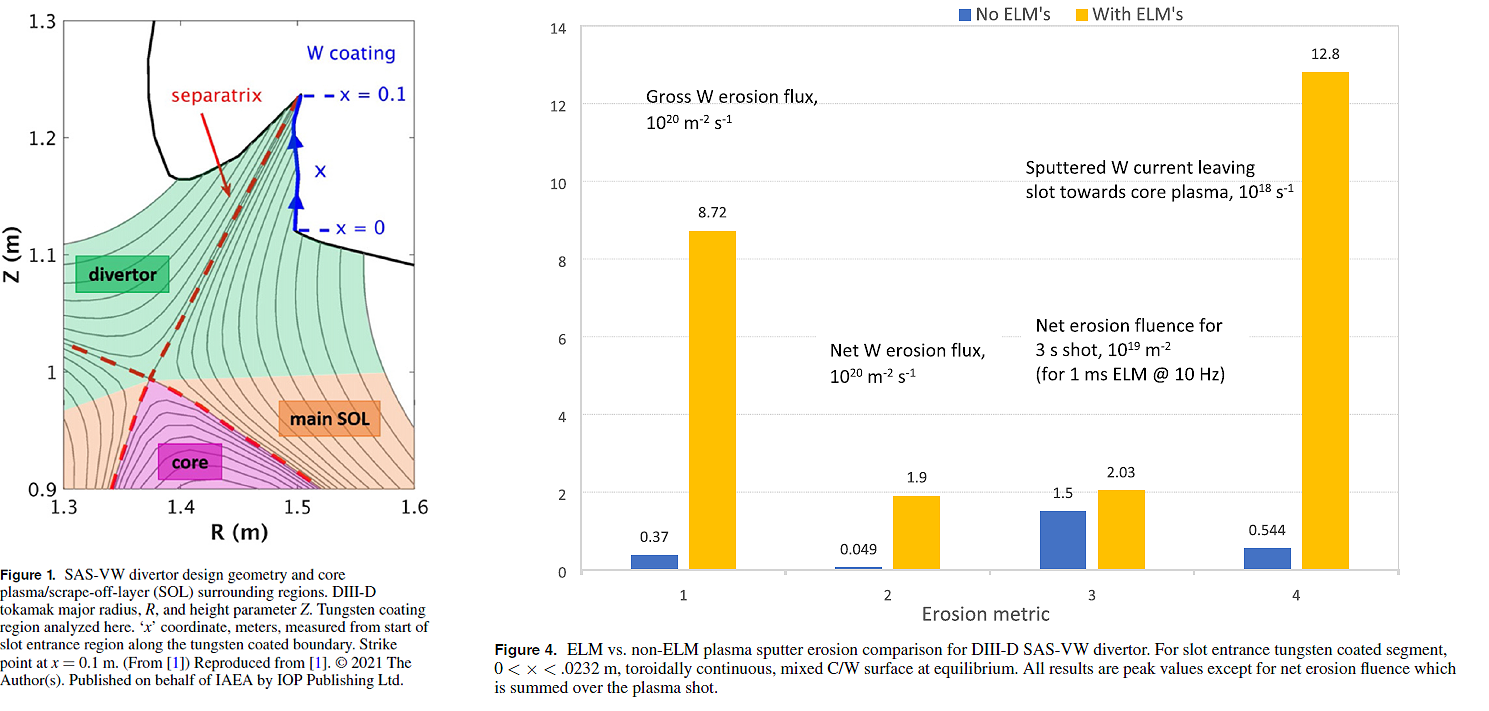
- The paper “Progress in the development and understanding of a high poloidal-beta tokamak operating scenario for an attractive fusion pilot plant” by Siye Ding and Andrea Garofalo, was published in Reviews of Modern Plasma Physics (https://doi.org/10.1007/s41614-022-00106-z). This paper summarizes the highlights of the research results on DIII-D high poloidal beta scenario development by the joint team of DIII-D and EAST scientists in the past decade. Topic includes transport properties, core-edge integration, scenario development towards higher normalized performance, etc. Experimental evidence and modeling analysis show the high poloidal beta scenario has great advantages in addressing key needs for an attractive FPP design, such as high-energy confinement quality at low rotation, excellent core-edge integration, high line-averaged density above the Greenwald limit, low disruption risk, and high bootstrap current fraction for steady-state operation. This provides a relatively safe and economical option to base an FPP design on that will lead to commercial fusion energy.
- The paper “Measurement and simulation of small cryogenic neon pellet Ne-I 640 nm photon efficiency during ablation in DIII-D plasma” (E. Hollmann, et al) has been published in Physics of Plasmas (https://aip.scitation.org/doi/pdf/10.1063/5.0106724 ). This work was motivated by the adoption of Ne/D2 shattered pellets as the main disruption mitigation method in ITER, as well as the extensive research at DIII-D in this area. Estimating neon pellet ablation rates from visible camera images requires a conversion factor S/XB to convert Ne-I brightness to Ne ionization rate. This conversion factor was estimated here as S/XB ~ 85 by using small (~1 mm) neon pellets of known size, combined with absolutely calibrated Ne-I imaging. Simulations combining the LP fluid/MHD pellet code with the PrismSPECT collisional-radiative code arrive at S/XB ~ 109 for the same experimental conditions. The simulations find that non-equilibrium bound electron kinetics are extremely important in determining S/XB here; i.e. collisional-radiative modeling based on equilibrium rate coefficients will not be valid in these experiments.
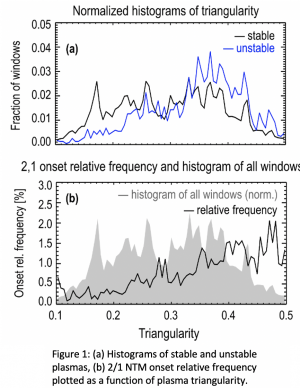 A paper entitled “Drift kinetic theory of the NTM magnetic islands in a finite beta general geometry tokamak plasma” by A.V. Dudkovskaia et al has been published in Nuclear Fusion (https://iopscience.iop.org/article/10.1088/1741-4326/aca48d). The work extends the drift magnetic island theory of [A V Dudkovskaia et al. Plasma Phys. Control. Fusion 63 (2021) 054001] to a realistic tokamak geometry characterized by finite beta values and D-shaped plasmas. The plasma triangularity effects on the neoclassical tearing mode (NTM) threshold are investigated for the first time within the self-consistent kinetic NTM theory of small magnetic islands. In particular, it is found that a higher triangularity plasma is more prone to NTMs, which is in agreement with the recent tearing mode onset relative frequency measurements in DIII-D. Second, the NTM threshold dependence on the tokamak inverse aspect ratio is extended to a finite aspect ratio limit. Third, the NTM threshold dependence on poloidal beta is obtained and successfully benchmarked against the EAST threshold island width measurements.
A paper entitled “Drift kinetic theory of the NTM magnetic islands in a finite beta general geometry tokamak plasma” by A.V. Dudkovskaia et al has been published in Nuclear Fusion (https://iopscience.iop.org/article/10.1088/1741-4326/aca48d). The work extends the drift magnetic island theory of [A V Dudkovskaia et al. Plasma Phys. Control. Fusion 63 (2021) 054001] to a realistic tokamak geometry characterized by finite beta values and D-shaped plasmas. The plasma triangularity effects on the neoclassical tearing mode (NTM) threshold are investigated for the first time within the self-consistent kinetic NTM theory of small magnetic islands. In particular, it is found that a higher triangularity plasma is more prone to NTMs, which is in agreement with the recent tearing mode onset relative frequency measurements in DIII-D. Second, the NTM threshold dependence on the tokamak inverse aspect ratio is extended to a finite aspect ratio limit. Third, the NTM threshold dependence on poloidal beta is obtained and successfully benchmarked against the EAST threshold island width measurements.
 The paper “Misalignment of magnetic field in DIII-D assessed by post-mortem analysis of divertor targets” by R. Masline et al. was published in Nuclear Fusion (https://doi.org/10.1088/1741-4326/ac9cf1). Measurements of carbon deposition on tungsten-coated lower divertor tile inserts revealed a shift in the toroidal magnetic field of ~5 mm towards the 310 degree toroidal direction. These findings are consistent with previous simulations of the 3D magnetic field distribution performed using the MAFOT field line integration code and Langmuir probe measurements in the small angle slot divertor. Since diagnostics are located at discrete toroidal and poloidal positions, misalignment in the toroidal field may complicate the mapping of these measurements to the same equilibrium. Comparisons with previous measurements of the toroidal field misalignment show that the error fields are gradually changing over time and therefore need to be periodically diagnosed.
The paper “Misalignment of magnetic field in DIII-D assessed by post-mortem analysis of divertor targets” by R. Masline et al. was published in Nuclear Fusion (https://doi.org/10.1088/1741-4326/ac9cf1). Measurements of carbon deposition on tungsten-coated lower divertor tile inserts revealed a shift in the toroidal magnetic field of ~5 mm towards the 310 degree toroidal direction. These findings are consistent with previous simulations of the 3D magnetic field distribution performed using the MAFOT field line integration code and Langmuir probe measurements in the small angle slot divertor. Since diagnostics are located at discrete toroidal and poloidal positions, misalignment in the toroidal field may complicate the mapping of these measurements to the same equilibrium. Comparisons with previous measurements of the toroidal field misalignment show that the error fields are gradually changing over time and therefore need to be periodically diagnosed.
FY23-Q1:
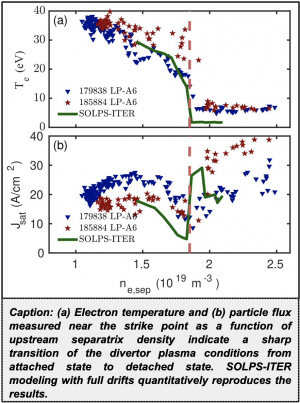 A manuscript titled “E×B flow driven electron temperature bifurcation in a closed slot divertor with ion B×∇B away from X-point in the DIII-D tokamak” by X. Ma et al. was published in Nuclear Fusion (https://iopscience.iop.org/article/10.1088/1741-4326/ac9743). This work demonstrates a strong interplay between drifts and divertor geometry on divertor dissipation. With the strike point on the inner slanted surface of the SAS divertor, bifurcative transitions were observed near detachment onset resulting in a sharp decrease of Te both experimentally and computationally. SOLPS-ITER modeling with full drifts shows that the reversal of both the poloidal and radial E´B flows near the strike point leads to rapid density accumulation, leading to a step-like transition of divertor conditions resulting in cold plasma across the entire divertor target plate. These results indicate that the interplay between geometry and drifts should be fully taken into account in future fusion reactor divertor designs.
A manuscript titled “E×B flow driven electron temperature bifurcation in a closed slot divertor with ion B×∇B away from X-point in the DIII-D tokamak” by X. Ma et al. was published in Nuclear Fusion (https://iopscience.iop.org/article/10.1088/1741-4326/ac9743). This work demonstrates a strong interplay between drifts and divertor geometry on divertor dissipation. With the strike point on the inner slanted surface of the SAS divertor, bifurcative transitions were observed near detachment onset resulting in a sharp decrease of Te both experimentally and computationally. SOLPS-ITER modeling with full drifts shows that the reversal of both the poloidal and radial E´B flows near the strike point leads to rapid density accumulation, leading to a step-like transition of divertor conditions resulting in cold plasma across the entire divertor target plate. These results indicate that the interplay between geometry and drifts should be fully taken into account in future fusion reactor divertor designs.
- A new article: Database-wide hazard modelling of the onset of DIII-D tearing modes with field features, by Olofsson et al., was published in Journal of Plasma Physics, Vol 88, Issue 5, October 2022 (https://doi.org/10.1017/S0022377822001003) The paper reports statistical analysis of TM onset rates, including both rotating and locked mode onsets, and their association with energy density field features obtained from post-processing of equilibrium reconstructions.
 A manuscript titled “Improved Particle Confinement with Resonant Magnetic Perturbations in DIII-D Tokamak H-Mode Plasmas” by N. Logan et al. was published in Physical Review Letters (https://link.aps.org/doi/10.1103/PhysRevLett.129.205001). The work details a newly discovered regime in which the application of nonaxisymmetric (3D) field perturbations improves confinement and leads to a corresponding increase in the plasma density. This happens only in a range of low, counter-current plasma rotation and is opposite the otherwise ubiquitously observed density “pump-out” with the application of 3D fields. The new pump-in phenomenon reduces the frequency of edge localized modes (ELMs) if they are present and is may improve ELMless scenarios like low torque QH-modes that use 3D fields for error field correction and rotation control.
A manuscript titled “Improved Particle Confinement with Resonant Magnetic Perturbations in DIII-D Tokamak H-Mode Plasmas” by N. Logan et al. was published in Physical Review Letters (https://link.aps.org/doi/10.1103/PhysRevLett.129.205001). The work details a newly discovered regime in which the application of nonaxisymmetric (3D) field perturbations improves confinement and leads to a corresponding increase in the plasma density. This happens only in a range of low, counter-current plasma rotation and is opposite the otherwise ubiquitously observed density “pump-out” with the application of 3D fields. The new pump-in phenomenon reduces the frequency of edge localized modes (ELMs) if they are present and is may improve ELMless scenarios like low torque QH-modes that use 3D fields for error field correction and rotation control.
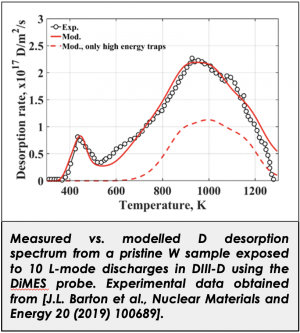 The paper “Dynamics of deuterium retention and desorption from plasma-facing materials in fusion reactor-relevant conditions” by T. Sizyuk and T. Abrams, recently published in the Journal of Nuclear Materials, presents a new modeling approach for the simulation of hydrogen isotope transport and retention in tungsten (https://doi.org/10.1016/j.jnucmat.2022.154095). This model was implemented in the ITMC-DYN simulation package and explains several interesting post-mortem observations from tungsten samples previously irradiated in DIII-D. The variation of temperatures during multi-discharge operation affects the spatial distribution of trapped D atoms. The effect of low material temperature during the cooldown phase, together with high D concentrations, enhances defect formation and growth in the subsurface layers of the D/W material system. Measured thermal desorption spectra of both pristine and pre-damaged tungsten were well-explained by the newly developed model.
The paper “Dynamics of deuterium retention and desorption from plasma-facing materials in fusion reactor-relevant conditions” by T. Sizyuk and T. Abrams, recently published in the Journal of Nuclear Materials, presents a new modeling approach for the simulation of hydrogen isotope transport and retention in tungsten (https://doi.org/10.1016/j.jnucmat.2022.154095). This model was implemented in the ITMC-DYN simulation package and explains several interesting post-mortem observations from tungsten samples previously irradiated in DIII-D. The variation of temperatures during multi-discharge operation affects the spatial distribution of trapped D atoms. The effect of low material temperature during the cooldown phase, together with high D concentrations, enhances defect formation and growth in the subsurface layers of the D/W material system. Measured thermal desorption spectra of both pristine and pre-damaged tungsten were well-explained by the newly developed model.
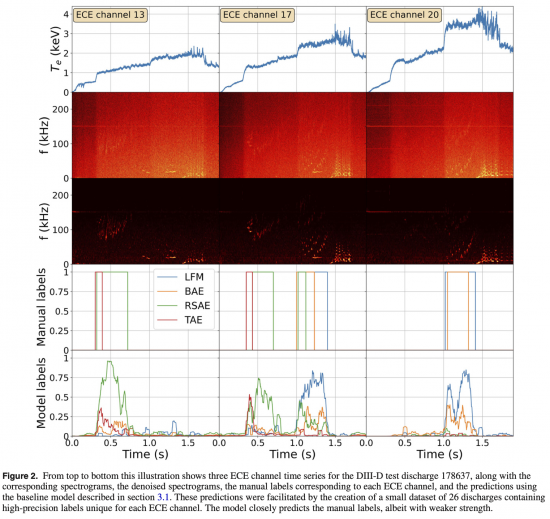 The paper “Exploring data-driven models for spatiotemporally local classification of Alfvén eigenmodes” by A. A. Kaptanoglu et al., published in Nuclear Fusion (https://doi.org/10.1088/1741-4326/ac8a03), uses a manually labeled database of 26 discharges from the DIII-D tokamak in order to train simple neural-network-based models for classifying Alfvén eigenmodes (AEs). The models provide spatiotemporally local identification of four types of AEs by using an array of 40 electron cyclotron emission (ECE) signals as inputs. Despite the minimal dataset, this strategy performs well at spatiotemporally localized classification of AEs, indicating future opportunities for more sophisticated models and incorporation into real-time control strategies. The trained model is then used to generate spatiotemporally-resolved labels for each of the 40 ECE measurements on a much larger database of 1112 DIII-D discharges. This large set of precision labels can be used in future studies for advanced deep predictors and new physical insights.
The paper “Exploring data-driven models for spatiotemporally local classification of Alfvén eigenmodes” by A. A. Kaptanoglu et al., published in Nuclear Fusion (https://doi.org/10.1088/1741-4326/ac8a03), uses a manually labeled database of 26 discharges from the DIII-D tokamak in order to train simple neural-network-based models for classifying Alfvén eigenmodes (AEs). The models provide spatiotemporally local identification of four types of AEs by using an array of 40 electron cyclotron emission (ECE) signals as inputs. Despite the minimal dataset, this strategy performs well at spatiotemporally localized classification of AEs, indicating future opportunities for more sophisticated models and incorporation into real-time control strategies. The trained model is then used to generate spatiotemporally-resolved labels for each of the 40 ECE measurements on a much larger database of 1112 DIII-D discharges. This large set of precision labels can be used in future studies for advanced deep predictors and new physical insights.
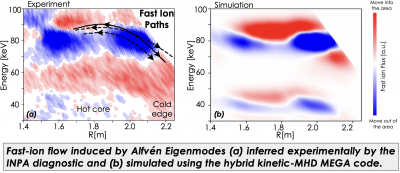 The paper “Modelling the Alfvén eigenmode induced fast-ion flow measured by an imaging neutral particle analyzer” by J. Gonzalez-Martin et al., was published in Nuclear Fusion (https://doi.org/10.1088/1741-4326/ac7406). It discusses the application of different models to reproduce the fast-ion flow induced by Alfvén Eigenmodes that is measured by an imaging neutral particle analyzer (INPA). Ad hoc energetic particle diffusivity modeling by TRANSP significantly deviates from the observations. Comparably, reduced modeling, i.e. a combination of NOVA-K and ASCOT5 codes, reproduce some key features of the observed flow, but largely fail to interpret the observed fast ion depletion near the plasma axis. At last, hybrid simulations predict an RSAE consistent with the experiment that redistributes the injected ions. The resulting synthetic INPA images are in good agreement with the measurement near the injection energy. Nonperturbative effects are required to reproduce that depletion of fast ions near the magnetic axis at the injection energy.
The paper “Modelling the Alfvén eigenmode induced fast-ion flow measured by an imaging neutral particle analyzer” by J. Gonzalez-Martin et al., was published in Nuclear Fusion (https://doi.org/10.1088/1741-4326/ac7406). It discusses the application of different models to reproduce the fast-ion flow induced by Alfvén Eigenmodes that is measured by an imaging neutral particle analyzer (INPA). Ad hoc energetic particle diffusivity modeling by TRANSP significantly deviates from the observations. Comparably, reduced modeling, i.e. a combination of NOVA-K and ASCOT5 codes, reproduce some key features of the observed flow, but largely fail to interpret the observed fast ion depletion near the plasma axis. At last, hybrid simulations predict an RSAE consistent with the experiment that redistributes the injected ions. The resulting synthetic INPA images are in good agreement with the measurement near the injection energy. Nonperturbative effects are required to reproduce that depletion of fast ions near the magnetic axis at the injection energy.
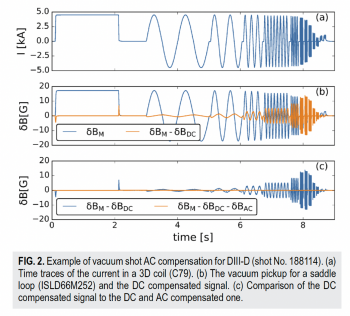 The paper “AC compensation of 3D magnetic diagnostic signals in DIII-D and National Spherical Torus Experiment-Upgrade (NSTX-U) for real-time application” by S. Munaretto et al., was recently published in Review of Scientific Instruments (https://doi.org/10.1063/5.0101630). It discusses a time domain algorithm that can be used in real time to remove the vacuum pickup generated by both coil current (DC) and induced vessel current (AC) from the 3D magnetic diagnostic signals. In this algorithm, the signal generated by the coil-induced eddy current is computed as the sum of low-pass filtered time derivatives of the coil current in each coil. While the gain for each low pass filtered signal is fitted, the choice of the low pass filters’ time constant is found to be more complex, since it impacts the uncertainty of the results, i.e. the applicability of the compensation to plasma shots. The code is available both in NSTX-U and DIII-D PCS.
The paper “AC compensation of 3D magnetic diagnostic signals in DIII-D and National Spherical Torus Experiment-Upgrade (NSTX-U) for real-time application” by S. Munaretto et al., was recently published in Review of Scientific Instruments (https://doi.org/10.1063/5.0101630). It discusses a time domain algorithm that can be used in real time to remove the vacuum pickup generated by both coil current (DC) and induced vessel current (AC) from the 3D magnetic diagnostic signals. In this algorithm, the signal generated by the coil-induced eddy current is computed as the sum of low-pass filtered time derivatives of the coil current in each coil. While the gain for each low pass filtered signal is fitted, the choice of the low pass filters’ time constant is found to be more complex, since it impacts the uncertainty of the results, i.e. the applicability of the compensation to plasma shots. The code is available both in NSTX-U and DIII-D PCS.
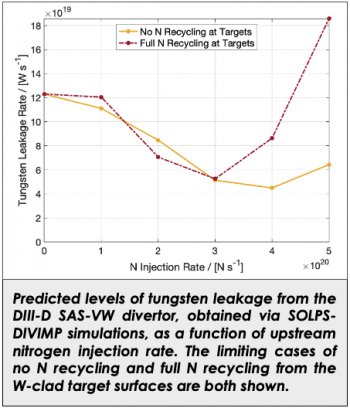 The paper “Modeling the effect of nitrogen recycling on the erosion and leakage of tungsten impurities from the SAS-VW divertor in DIII-D during nitrogen gas injection” by M.S. Parsons et al. has been published in Nuclear Materials and Energy (https://doi.org/10.1016/j.nme.2022.101254). A modeling workflow with the SOLPS-ITER and DIVIMP codes was used to study tungsten behavior in the plasma boundary with a variety of nitrogen injection rates with different assumptions about the nitrogen recycling at the tungsten divertor target. This paper demonstrated that an optimal injection rate may exist in some scenarios which reduces the amount of tungsten leaking out of the divertor and reaching the core (see figure below). However, when the nitrogen recycling rate at the divertor targets is high, the nitrogen redistributes within the SAS-VW slot leading to increased tungsten sputtering, and the range of nitrogen injection rates resulting in tungsten mitigation becomes narrower.
The paper “Modeling the effect of nitrogen recycling on the erosion and leakage of tungsten impurities from the SAS-VW divertor in DIII-D during nitrogen gas injection” by M.S. Parsons et al. has been published in Nuclear Materials and Energy (https://doi.org/10.1016/j.nme.2022.101254). A modeling workflow with the SOLPS-ITER and DIVIMP codes was used to study tungsten behavior in the plasma boundary with a variety of nitrogen injection rates with different assumptions about the nitrogen recycling at the tungsten divertor target. This paper demonstrated that an optimal injection rate may exist in some scenarios which reduces the amount of tungsten leaking out of the divertor and reaching the core (see figure below). However, when the nitrogen recycling rate at the divertor targets is high, the nitrogen redistributes within the SAS-VW slot leading to increased tungsten sputtering, and the range of nitrogen injection rates resulting in tungsten mitigation becomes narrower.
 The paper “Computational assessment on impurity sourcing and transport using high-temperature graphite and silicon carbide plasma-facing walls in a tokamak environment” by G. Sinclair et al., published in Fusion Science and Technology (https://doi.org/10.1080/15361055.2022.2099506), utilizes predictive impurity transport simulations to assess the impact of wall temperature on erosion and core contamination in a DIII-D-sized device. DIVIMP impurity tracking simulations conducted on a plasma background generated using SOLPS-ITER showed that the total gross erosion of C from graphite walls could be reduced by a factor of 2 by operating at a wall temperature of 1200 K instead of 400 K and could be further reduced by a factor of 8 by using SiC instead of graphite. The C density at the outer midplane separatrix, which is used as a proxy for core contamination, is 7.5 times lower with a SiC wall than with a graphite wall at a temperature of 800 K. Modeling results motivate near-term upgrades to graphite-clad machines to demonstrate more reactor-relevant wall solutions.
The paper “Computational assessment on impurity sourcing and transport using high-temperature graphite and silicon carbide plasma-facing walls in a tokamak environment” by G. Sinclair et al., published in Fusion Science and Technology (https://doi.org/10.1080/15361055.2022.2099506), utilizes predictive impurity transport simulations to assess the impact of wall temperature on erosion and core contamination in a DIII-D-sized device. DIVIMP impurity tracking simulations conducted on a plasma background generated using SOLPS-ITER showed that the total gross erosion of C from graphite walls could be reduced by a factor of 2 by operating at a wall temperature of 1200 K instead of 400 K and could be further reduced by a factor of 8 by using SiC instead of graphite. The C density at the outer midplane separatrix, which is used as a proxy for core contamination, is 7.5 times lower with a SiC wall than with a graphite wall at a temperature of 800 K. Modeling results motivate near-term upgrades to graphite-clad machines to demonstrate more reactor-relevant wall solutions.
 The paper “A method to identify the heat flux from photons and neutrals at the divertor target” by J. Ren et al., was recently published in IEEE Transactions on Plasma Science (https://ieeexplore.ieee.org/document/9831056). For the first time in a tokamak, the fraction of heat flux striking the target surface made up of neutrals and photons relative to that from ions and electrons has been measured. The Surface Eroding Thermocouple (SETC) is an innovative diagnostic designed for fast (~1 ms response time) surface heat flux measurement and has been successfully applied in DIII-D to investigate divertor detachment. Employing the DiMES manipulator, a novel method has been developed of using a combination of surface-facing and recessed SETCs to distinguish between the heat flux from charged particles, and that from neutrals and radiative heating. This technique suggests that at least 20% of the total incident heat flux is attributable to the latter sources that are not trapped in the magnetic field in a fully detached open divertor condition. This not only indicates the non-charged particle heating significantly contributes to the total surface heat flux in detached divertor conditions, but also demonstrates the feasibility of using two operational modes of SETCs to distinguish between the two surface heating mechanisms. Following application in the lower divertor, a combination of both flush and recessed SETCs were installed in the SAS-VW divertor with results expected following the FY22 campaign.
The paper “A method to identify the heat flux from photons and neutrals at the divertor target” by J. Ren et al., was recently published in IEEE Transactions on Plasma Science (https://ieeexplore.ieee.org/document/9831056). For the first time in a tokamak, the fraction of heat flux striking the target surface made up of neutrals and photons relative to that from ions and electrons has been measured. The Surface Eroding Thermocouple (SETC) is an innovative diagnostic designed for fast (~1 ms response time) surface heat flux measurement and has been successfully applied in DIII-D to investigate divertor detachment. Employing the DiMES manipulator, a novel method has been developed of using a combination of surface-facing and recessed SETCs to distinguish between the heat flux from charged particles, and that from neutrals and radiative heating. This technique suggests that at least 20% of the total incident heat flux is attributable to the latter sources that are not trapped in the magnetic field in a fully detached open divertor condition. This not only indicates the non-charged particle heating significantly contributes to the total surface heat flux in detached divertor conditions, but also demonstrates the feasibility of using two operational modes of SETCs to distinguish between the two surface heating mechanisms. Following application in the lower divertor, a combination of both flush and recessed SETCs were installed in the SAS-VW divertor with results expected following the FY22 campaign.
FY22-Q4:
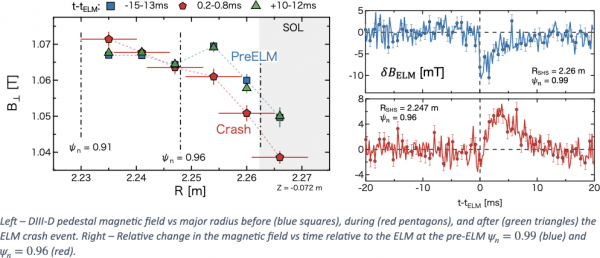 The paper “Local measurements of the pedestal magnetic field profile throughout the ELM cycle on DIII-D” was published in Physics of Plasmas by M. Galen Burke et al. describing the first measurements of the H-mode pedestal magnetic field evolution through the ELM cycle and L-H transition in a high temperature tokamak. The measurement utilizes the separation of the Stark-split neutral beam emission to extract the local magnetic field perpendicular to the beam neutral velocity, B. A new ultra-high optical throughput spectroscopy technique was validated by first measurements that demonstrated excellent agreement with the relative changes in the local magnetic field induced by core current profile changes. Measurements of peeling-limited ELMs show spatially complex and extremely fast (<50 μs) changes in the pedestal magnetic field. These changes imply a fast rearrangement of the edge current peak at the ELM crash, as expected. In some discharges changes in B are observed throughout the ELM cycle. In others, at the edge current peak, B recovers and is relatively stable until 1-2 ms leading up to the next crash. These measurements are made possible by a novel spatial heterodyne spectrometer that was developed under a measurement innovation grant through the University of Wisconsin-Madison.
The paper “Local measurements of the pedestal magnetic field profile throughout the ELM cycle on DIII-D” was published in Physics of Plasmas by M. Galen Burke et al. describing the first measurements of the H-mode pedestal magnetic field evolution through the ELM cycle and L-H transition in a high temperature tokamak. The measurement utilizes the separation of the Stark-split neutral beam emission to extract the local magnetic field perpendicular to the beam neutral velocity, B. A new ultra-high optical throughput spectroscopy technique was validated by first measurements that demonstrated excellent agreement with the relative changes in the local magnetic field induced by core current profile changes. Measurements of peeling-limited ELMs show spatially complex and extremely fast (<50 μs) changes in the pedestal magnetic field. These changes imply a fast rearrangement of the edge current peak at the ELM crash, as expected. In some discharges changes in B are observed throughout the ELM cycle. In others, at the edge current peak, B recovers and is relatively stable until 1-2 ms leading up to the next crash. These measurements are made possible by a novel spatial heterodyne spectrometer that was developed under a measurement innovation grant through the University of Wisconsin-Madison.
- A new paper based entirely on results during a recent DIII-D startup campaign has been published in Nuclear Fusion (C. Paz-Soldan et al 2022 Nucl. Fusion, https://doi.org/10.1088/1741-4326/ac9005). “Non-disruptive error field identification based on magnetic island healing” describes the demonstration of a new experimental technique to identify intrinsic error fields (EFs) in tokamaks with minimized risk of disruption. The method extends the conventional driven magnetic island ‘compass scan’ approach by applying asynchronous control waveforms to enable prompt healing of the island instability. Healing of the island is achieved by reducing the imposed non-axisymmetric coil current and raising the density (here via gas fueling). Non-linear modeling with the TM1 code reproduces the experimental results and approximately recovers the critical density required for island healing. Island healing is explained in TM1 by an increase in the viscous coupling between the static island and the nearby flowing plasma, thus healing the island as it accelerates into the plasma frame. Due to both simplicity and risk minimization, this technique is suitable for plasma-based EF identification in the early commissioning stages of future disruption-averse tokamaks such as ITER and SPARC.
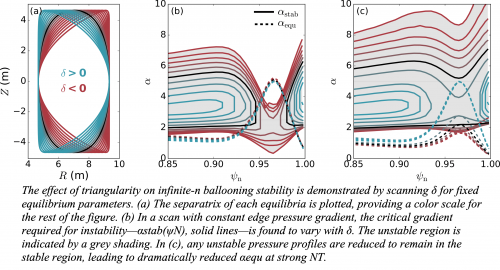 The paper “Prospects for H-mode inhibition in negative triangularity tokamak reactor plasmas” was published in Nuclear Fusion by Oak Nelson describing access conditions (and the lack thereof) to H-mode in negative triangularity reactor configurations. Using the OMFIT framework, over 9000 equilibria with varying shapes and kinetic profiles were generated and assessed in terms of their stability to infinite-n ballooning modes. Stability calculations indicate that infinite-n ballooning modes are strongly destabilized by changes in the local magnetic shear at strongly negative triangularity, closing access to the second stability region and preventing the growth of an H-mode pedestal. These results indicate that negative triangularity reactors should be able to robustly maintain L-mode operation.
The paper “Prospects for H-mode inhibition in negative triangularity tokamak reactor plasmas” was published in Nuclear Fusion by Oak Nelson describing access conditions (and the lack thereof) to H-mode in negative triangularity reactor configurations. Using the OMFIT framework, over 9000 equilibria with varying shapes and kinetic profiles were generated and assessed in terms of their stability to infinite-n ballooning modes. Stability calculations indicate that infinite-n ballooning modes are strongly destabilized by changes in the local magnetic shear at strongly negative triangularity, closing access to the second stability region and preventing the growth of an H-mode pedestal. These results indicate that negative triangularity reactors should be able to robustly maintain L-mode operation.
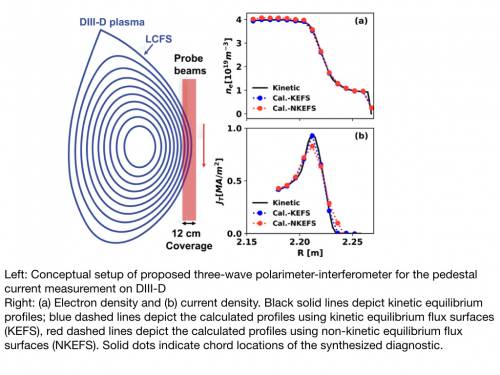 The paper “Faraday-effect polarimetry for current profile measurement in the tokamak plasma edge” by J. Chen et. al. has been published in Review of Scientific Instruments (https://aip.scitation.org/doi/10.1063/5.0101550). The paper shows that a Faraday-effect polarimeter can measure current density profile in DIII-D H-mode pedestal. A low-field-side, vertical-view polarimeter design, covering R=2.15 to 2.27 m on DIII-D with sub-cm chord spacing, is assessed. A synthetic diagnostic simulation, in which current profile is derived from the Faraday rotation angle using Abel inversion, is performed to evaluate impact of various factors, such as diagnostic performance and flux surface quality from kinetic and routine EFIT calculations. It is found that the pedestal current profile can be realistically determined with no greater than 0.12 MA/m^2 uncertainty, or about 10% of the peak pedestal current density, in an investigated DIII-D H-mode plasma.
The paper “Faraday-effect polarimetry for current profile measurement in the tokamak plasma edge” by J. Chen et. al. has been published in Review of Scientific Instruments (https://aip.scitation.org/doi/10.1063/5.0101550). The paper shows that a Faraday-effect polarimeter can measure current density profile in DIII-D H-mode pedestal. A low-field-side, vertical-view polarimeter design, covering R=2.15 to 2.27 m on DIII-D with sub-cm chord spacing, is assessed. A synthetic diagnostic simulation, in which current profile is derived from the Faraday rotation angle using Abel inversion, is performed to evaluate impact of various factors, such as diagnostic performance and flux surface quality from kinetic and routine EFIT calculations. It is found that the pedestal current profile can be realistically determined with no greater than 0.12 MA/m^2 uncertainty, or about 10% of the peak pedestal current density, in an investigated DIII-D H-mode plasma.
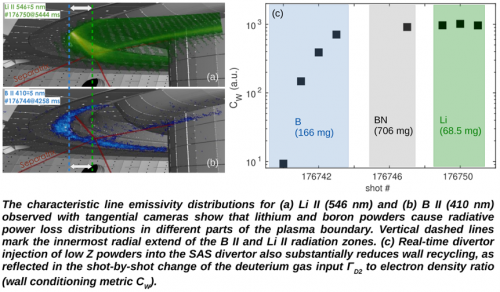 The paper “Mitigation of plasma-wall interactions with low-Z powders in DIII-D high confinement plasmas” by F. Effenberg et al was recently published in Nuclear Fusion (https://doi.org/10.1088/1741-4326/ac899d). Experiments with low-Z powder injection in DIII-D high confinement discharges demonstrated increased divertor dissipation and detachment while maintaining good core energy confinement. Lithium (Li), boron (B), and boron nitride (BN) powders were injected in H‑mode plasmas into the upper small-angle slot (SAS) divertor. Multi-species BN powders showed the most substantial increase in divertor neutral compression by more than an order of magnitude and lasting detachment. The application of powders also showed a substantial improvement of wall conditions manifesting in reduced wall fueling source and intrinsic carbon and oxygen content in response to the cumulative injection of non-recycling materials. The results suggest that low-Z powder injection, including mixed element compounds, is a promising new core-edge compatible technique that simultaneously enables divertor detachment and improves wall conditions during high confinement operation.
The paper “Mitigation of plasma-wall interactions with low-Z powders in DIII-D high confinement plasmas” by F. Effenberg et al was recently published in Nuclear Fusion (https://doi.org/10.1088/1741-4326/ac899d). Experiments with low-Z powder injection in DIII-D high confinement discharges demonstrated increased divertor dissipation and detachment while maintaining good core energy confinement. Lithium (Li), boron (B), and boron nitride (BN) powders were injected in H‑mode plasmas into the upper small-angle slot (SAS) divertor. Multi-species BN powders showed the most substantial increase in divertor neutral compression by more than an order of magnitude and lasting detachment. The application of powders also showed a substantial improvement of wall conditions manifesting in reduced wall fueling source and intrinsic carbon and oxygen content in response to the cumulative injection of non-recycling materials. The results suggest that low-Z powder injection, including mixed element compounds, is a promising new core-edge compatible technique that simultaneously enables divertor detachment and improves wall conditions during high confinement operation.
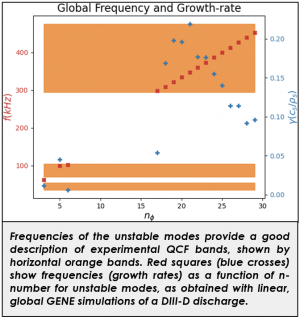 The paper “Identifying the microtearing modes in the pedestal of DIII-D H-modes using gyrokinetic simulations” by Ehab Hassan et al. has been published in Nuclear Fusion (https://doi.org/10.1088/1741-4326/ac3be5). This paper reports a study of the instabilities in the pedestal region carried out using gyrokinetic simulations with the GENE code to model an ELMy H-mode DIII-D discharge. The simulations produce MTMs, identified by predominantly by electromagnetic heat flux, small particle flux, and a substantial degree of tearing parity. The magnetic spectrogram from Mirnov coils exhibits three distinct frequency bands—two narrow bands at lower frequency (∼35–55 kHz and ∼70–105 kHz) and a broader band at higher frequency (∼300–500 kHz). Global linear GENE simulations produce MTMs that are centered at the peak of the ω∗ profile and correspond closely with the bands in the spectrogram. The three distinctive frequency bands can be understood from the basic physical mechanisms underlying the instabilities. For example (i) instability of certain toroidal mode numbers (n) is controlled by the alignment of their rational surfaces with the peak in the ω∗ profile, and (ii) MTM instabilities in the lower n bands are the conventional collisional slab MTM, whereas the higher n band depends on curvature drive. While many features of the modes can be captured with the local approximation, a global treatment, as used here, is necessary to quantitatively reproduce the detailed band gaps of the low-n fluctuations.
The paper “Identifying the microtearing modes in the pedestal of DIII-D H-modes using gyrokinetic simulations” by Ehab Hassan et al. has been published in Nuclear Fusion (https://doi.org/10.1088/1741-4326/ac3be5). This paper reports a study of the instabilities in the pedestal region carried out using gyrokinetic simulations with the GENE code to model an ELMy H-mode DIII-D discharge. The simulations produce MTMs, identified by predominantly by electromagnetic heat flux, small particle flux, and a substantial degree of tearing parity. The magnetic spectrogram from Mirnov coils exhibits three distinct frequency bands—two narrow bands at lower frequency (∼35–55 kHz and ∼70–105 kHz) and a broader band at higher frequency (∼300–500 kHz). Global linear GENE simulations produce MTMs that are centered at the peak of the ω∗ profile and correspond closely with the bands in the spectrogram. The three distinctive frequency bands can be understood from the basic physical mechanisms underlying the instabilities. For example (i) instability of certain toroidal mode numbers (n) is controlled by the alignment of their rational surfaces with the peak in the ω∗ profile, and (ii) MTM instabilities in the lower n bands are the conventional collisional slab MTM, whereas the higher n band depends on curvature drive. While many features of the modes can be captured with the local approximation, a global treatment, as used here, is necessary to quantitatively reproduce the detailed band gaps of the low-n fluctuations.
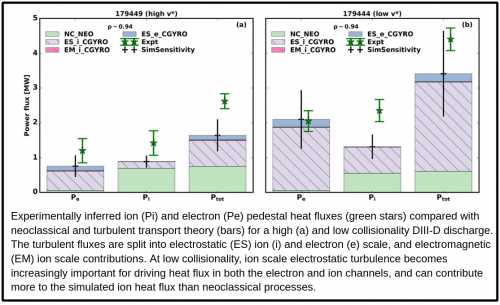 The paper “Ion thermal transport in the H-mode edge transport barrier on DIII-D” by S. R. Haskey et al. has been published in Physics of Plasmas (https://doi.org/10.1063/5.0072155). The paper describes how the power balance ion heat flux in the pedestal region on DIII-D increases and becomes increasingly anomalous (above conventional neoclassical) in experiments with higher temperature and lower density pedestals where the ion collisionality ( νi*) is lowered toward values expected on ITER. Direct measurements of the main-ion temperature are shown to be essential on DIII-D when calculating the ion heat flux due to differences between the temperature of D+ and the more commonly measured C6+ impurity ions approaching the separatrix. Neoclassical transport calculations from NEO and non-linear gyrokinetic calculations using CGYRO are consistent with these observations and show that while neoclassical transport plays an important role, the turbulent ion heat flux due to ion scale electrostatic turbulence is significant and can contribute similar or larger ion heat fluxes at lower collisionality. Beam emission spectroscopy and Doppler backscattering measurements in the steep gradient region of the H-mode pedestal reveal increased broadband, long-wavelength ion scale fluctuations for the low νi* discharges at the radius where the non-linear CGYRO simulations were run. Taken together, the increased fluctuations, power balance calculations, and gyrokinetic simulations show that the ion heat fluxes are in excess of the neoclassical levels, particularly at lower νi*, with the additional fluxes likely caused by weakly suppressed ion scale electrostatic turbulence.
The paper “Ion thermal transport in the H-mode edge transport barrier on DIII-D” by S. R. Haskey et al. has been published in Physics of Plasmas (https://doi.org/10.1063/5.0072155). The paper describes how the power balance ion heat flux in the pedestal region on DIII-D increases and becomes increasingly anomalous (above conventional neoclassical) in experiments with higher temperature and lower density pedestals where the ion collisionality ( νi*) is lowered toward values expected on ITER. Direct measurements of the main-ion temperature are shown to be essential on DIII-D when calculating the ion heat flux due to differences between the temperature of D+ and the more commonly measured C6+ impurity ions approaching the separatrix. Neoclassical transport calculations from NEO and non-linear gyrokinetic calculations using CGYRO are consistent with these observations and show that while neoclassical transport plays an important role, the turbulent ion heat flux due to ion scale electrostatic turbulence is significant and can contribute similar or larger ion heat fluxes at lower collisionality. Beam emission spectroscopy and Doppler backscattering measurements in the steep gradient region of the H-mode pedestal reveal increased broadband, long-wavelength ion scale fluctuations for the low νi* discharges at the radius where the non-linear CGYRO simulations were run. Taken together, the increased fluctuations, power balance calculations, and gyrokinetic simulations show that the ion heat fluxes are in excess of the neoclassical levels, particularly at lower νi*, with the additional fluxes likely caused by weakly suppressed ion scale electrostatic turbulence.
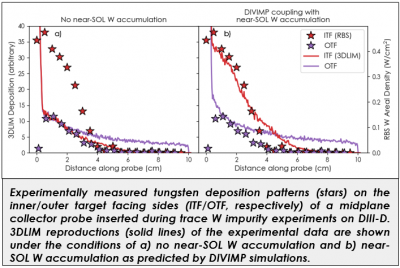 A novel multi-code workflow to interpret collector probe deposition patterns in DIII-D was recently published in a Fusion Science and Technology article entitled “Separatrix-to-Wall Simulations of Impurity Transport with a Fully Three-Dimensional Wall in DIII-D” (https://doi.org/10.1080/15361055.2022.2082791) by S. Zamperini et al. The components of the workflow consist of a detailed computer-aided-design file of the DIII-D vessel wall coupled to the scrape-off-layer (SOL) codes MAFOT, OSM, DIVIMP, and 3DLIM. A special-purpose toolkit enables passing the output of these codes among each other to provide a full-SOL picture of impurity transport. A demonstration of the workflow is described to support evidence of near-SOL tungsten parallel accumulation during trace W impurity experiments on DIII-D. Iteration between simulated deposition patterns in 3DLIM and DIVIMP predicts a region of elevated W density near the separatrix about halfway between the outboard midplane and the top of the plasma. This workflow will be used to better interpret collector probe experiments on DIII-D during the ongoing SAS-VW campaign.
A novel multi-code workflow to interpret collector probe deposition patterns in DIII-D was recently published in a Fusion Science and Technology article entitled “Separatrix-to-Wall Simulations of Impurity Transport with a Fully Three-Dimensional Wall in DIII-D” (https://doi.org/10.1080/15361055.2022.2082791) by S. Zamperini et al. The components of the workflow consist of a detailed computer-aided-design file of the DIII-D vessel wall coupled to the scrape-off-layer (SOL) codes MAFOT, OSM, DIVIMP, and 3DLIM. A special-purpose toolkit enables passing the output of these codes among each other to provide a full-SOL picture of impurity transport. A demonstration of the workflow is described to support evidence of near-SOL tungsten parallel accumulation during trace W impurity experiments on DIII-D. Iteration between simulated deposition patterns in 3DLIM and DIVIMP predicts a region of elevated W density near the separatrix about halfway between the outboard midplane and the top of the plasma. This workflow will be used to better interpret collector probe experiments on DIII-D during the ongoing SAS-VW campaign.
- A short Note was recently published by Erik Olofsson on “Fast calculation of the tokamak vertical instability” in Plasma Physics and Controlled Fusion. (https://iopscience.iop.org/article/10.1088/1361-6587/ac6ffd). There has been recent interest in fast calculations of the tokamak axisymmetric vertical instability for real time feedback control purposes. It is shown that the maximum eigenvalue for the basic rigid version of this stability problem can be obtained by finding the positive root to a simple scalar function. This function can be generalized to include plasma mass and has complexity linear in the number of conductive elements. The formulation is based on standard matrix decompositions of the fixed-geometry part of the eigenproblem. The calculation bottleneck is the summary of mutual inductances from the reconstructed equilibrium current density. The with-mass spectrum can be made fully real-valued by the addition of a critical amount of damping with negligible effect on the vertical growth rate. The calculation has been implemented in the plasma control system at the DIII-D tokamak and used in experiments.
- A paper has been published by M.L. Walker on “A method for automated modeling of plasma shape control response in tokamaks” in Fusion Engineering and Design. (https://doi.org/10.1016/j.fusengdes.2022.113215). A simple method commonly used in modeling of tokamak conductor and plasma response for plasma control has been extended to allow more general modeling of tokamak PF conductor circuits. This extension combines a previously existing method for integrating plasma response and tokamak circuits with a more capable circuit modeling technique derived from the theory that underlies present-day automatic circuit simulation codes. This combined method can incorporate any combination of inductors (e.g., coils), resistors, capacitors, voltage sources, and current sources, while retaining the same model structure and ease of interpretation as the simple method. For many tokamaks, use of this extended method would not be the preferred approach, but for certain devices or for specialized models of a device, it is useful and occasionally essential. For example, the method has enabled fast and automated modeling of the complicated and daily-changing circuit topology used in the DIII-D tokamak. This automated modeling is essential to the support of controller design for the frequently changing requirements for DIII-D plasmas. It is likely to also find application in the workflows for new device designs.
- The paper “DIII-D research advancing the physics basis for optimizing the tokamak approach to fusion energy” by M. E. Fenstermacher and the DIII-D Team was recently published in Nuclear Fusion (https://doi.org/10.1088/1741-4326/ac2ff2). DIII-D physics research addresses critical challenges for the operation of ITER and the next generation of fusion energy devices. This is done through a focus on innovations to provide solutions for high performance long pulse operation, coupled with fundamental plasma physics understanding and model validation, to drive scenario development by integrating high performance core and boundary plasmas. This is an overview paper highlighting many of these important recent developments and results from the DIII-D research program.
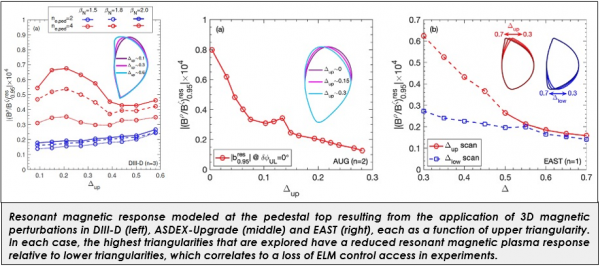 The paper “Influence of triangularity on the plasma response to resonant magnetic perturbations” by S. Gu et al. was recently published in Nuclear Fusion (https://doi.org/10.1088/1741-4326/ac5f7b). Measurements and modeling from recent RMP-ELM control experiments in DIII-D and other devices find a peak in the resonant plasma response as a function of upper triangularity which corresponds to the most experimentally accessible ELM-suppressed state. As shown in the figure, the plasma response is strongly suppressed at high triangularity compared to that at lower triangularity, while keeping other equilibrium quantities largely unchanged. This result is demonstrated in DIII-D (left), ASDEX Upgrade (middle), and EAST (right) tokamaks, and helps understand the inaccessibility of ELM suppression at high triangularity. Both experiments and modeling find a reduced magnetic plasma response on the high-field side at high triangularity across devices. The amplitude of the dominant mode reveals similar trends with the edge resonance and radial displacement near X-point, which suggests that the multi-mode plasma response provides another way to understand the ELM control physics. These findings indicate that the plasma shape should be taken into consideration when designing an RMP-ELM control strategy in experiment, and that predictive plasma response calculations can be used to maximize access to RMP-ELM control in future devices by maximizing the coupling between coils and the plasma.
The paper “Influence of triangularity on the plasma response to resonant magnetic perturbations” by S. Gu et al. was recently published in Nuclear Fusion (https://doi.org/10.1088/1741-4326/ac5f7b). Measurements and modeling from recent RMP-ELM control experiments in DIII-D and other devices find a peak in the resonant plasma response as a function of upper triangularity which corresponds to the most experimentally accessible ELM-suppressed state. As shown in the figure, the plasma response is strongly suppressed at high triangularity compared to that at lower triangularity, while keeping other equilibrium quantities largely unchanged. This result is demonstrated in DIII-D (left), ASDEX Upgrade (middle), and EAST (right) tokamaks, and helps understand the inaccessibility of ELM suppression at high triangularity. Both experiments and modeling find a reduced magnetic plasma response on the high-field side at high triangularity across devices. The amplitude of the dominant mode reveals similar trends with the edge resonance and radial displacement near X-point, which suggests that the multi-mode plasma response provides another way to understand the ELM control physics. These findings indicate that the plasma shape should be taken into consideration when designing an RMP-ELM control strategy in experiment, and that predictive plasma response calculations can be used to maximize access to RMP-ELM control in future devices by maximizing the coupling between coils and the plasma.
- “Enhancement of detachment control with simplified real-time modelling on the KSTAR tokamak” by David Eldon, et al, was published in Plasma Physics and Controlled Fusion (https://doi.org/10.1088/1361-6587/ac6ff9). The paper describes design improvements in the detachment control concept based on calculating attachment fraction from Langmuir probe signals, which was pioneered on JET and reproduced on EAST and DIII-D and used to great effect in core-edge integration efforts. Experience and data from DIII-D detachment tests were used to redesign the attachment fraction calculation. The new design overcomes some limitations of prior implementations. Most importantly, it can adapt to scenario changes including changes in input power after detaching. The new control design is demonstrated on KSTAR, where PID tuning heuristics developed using DIII-D results were applied to achieve good KSTAR control tuning on the first try with no manual tuning adjustments.
- The ability to calculate the saturated amplitude of Alfven eigenmodes is needed to predict alpha transport in future devices. “Regulation of Alfven eigenmodes by microturbulence in fusion plasmas” by Pengfei Liu et al. (https://doi.org/10.1103/PhysRevLett.128.185001) describes the first global gyrokinetic simulations that successfully reproduce the measured amplitude of DIII-D reversed shear Alfven eigenmodes (RSAE). With ITG turbulence included, the RSAE amplitude and mode structure are in excellent agreement with ECE measurements and the simulated low-k density fluctuation amplitude of the ITG turbulence is within a factor of two of the value measured by BES. In contrast, in simulations with ITG microturbulence artificially suppressed, the calculated RSAE amplitude and resultant fast-ion transport are far smaller than experimental values. The work demonstrates the key role of coupling between microscopic and mesoscopic scales in Alfven eigenmode dynamics.
FY22-Q3:
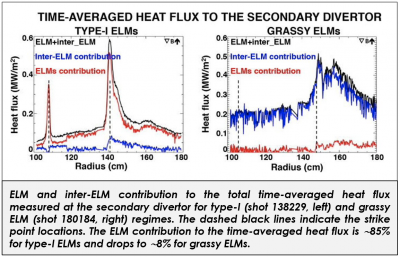 The paper “Quantifying heat and particle flux to primary and secondary divertors for various types of edge-localized-modes” by R. Perillo et al. was recently published in Physics of Plasmas and was chosen as Editor’s Pick (https://doi.org/10.1063/5.0092924). This article shows that between 15% and 30% of edge-localized-mode (ELM) heat flux can be deposited to regions outside the main divertor including the far scrape-off-layer (SOL), private flux region (PFR), and secondary divertor inner target. Significantly, the peak heat flux values at the secondary inner divertor can surpass those at the secondary outer target, despite the secondary inner divertor being magnetically isolated from the outer divertor. This behavior is consistently observed for pedestal collisionalities from nu_star,e ∼ 1.5 to ∼ 3.9. Heat flux profiles of the examined ELM types feature rippled structures due to bursts in the outer far-SOL region but not on the secondary inner target, causing long decay lengths in the time-averaged ELM profiles. The contribution of each ELM type to the total time-averaged power deposited to the secondary divertor has been evaluated, showing that grassy ELMs contribute ∼8%, small ELMs ∼67%, and type-I ELMs ∼85%. These findings imply that small ELMs may yet pose a concern for future machines if some regions of the main wall are not designed to withstand significant heat and particle fluxes. Due to the low intra-ELM heat flux contribution, however, the grassy ELM regime is an attractive option for an ELMing scenario in future machines.
The paper “Quantifying heat and particle flux to primary and secondary divertors for various types of edge-localized-modes” by R. Perillo et al. was recently published in Physics of Plasmas and was chosen as Editor’s Pick (https://doi.org/10.1063/5.0092924). This article shows that between 15% and 30% of edge-localized-mode (ELM) heat flux can be deposited to regions outside the main divertor including the far scrape-off-layer (SOL), private flux region (PFR), and secondary divertor inner target. Significantly, the peak heat flux values at the secondary inner divertor can surpass those at the secondary outer target, despite the secondary inner divertor being magnetically isolated from the outer divertor. This behavior is consistently observed for pedestal collisionalities from nu_star,e ∼ 1.5 to ∼ 3.9. Heat flux profiles of the examined ELM types feature rippled structures due to bursts in the outer far-SOL region but not on the secondary inner target, causing long decay lengths in the time-averaged ELM profiles. The contribution of each ELM type to the total time-averaged power deposited to the secondary divertor has been evaluated, showing that grassy ELMs contribute ∼8%, small ELMs ∼67%, and type-I ELMs ∼85%. These findings imply that small ELMs may yet pose a concern for future machines if some regions of the main wall are not designed to withstand significant heat and particle fluxes. Due to the low intra-ELM heat flux contribution, however, the grassy ELM regime is an attractive option for an ELMing scenario in future machines.
 The paper “A survey of pedestal magnetic fluctuations using gyrokinetics and a global reduced model for microtearing stability” has recently been published by Max Curie et al in Physics of Plasmas (https://doi.org/10.1063/5.0084842). This article presents a global reduced model for slab-like microtearing modes (MTMs) in the H-mode pedestal, which reproduces distinctive features of experimentally observed magnetic fluctuations, such as discrete frequency bands at noncontiguous mode numbers. The key insight underlying this model is that MTM instability is enabled by the alignment of a rational surface with the peak in the profile of the electron diamagnetic frequency. Conversely, MTMs are strongly stabilized for toroidal mode numbers for which these quantities are misaligned. This property explains the discrete bands in magnetic fluctuation spectra in several DIII-D and JET discharges, which are predicted by the reduced model as well as by global gyrokinetic simulations. As an example, the left figure shows a frequency spectrogram of magnetic fluctuations from a DIII-D discharge with two frequency bands that are candidates for MTMs. The right figure shows output of the SLiM model, which predicts that MTM turbulence at n=3 causes the lower frequency band and turbulence at n=5 and 6 is responsible for the higher frequency band. This fast yet accurate reduced model for MTMs enables rapid interpretation of magnetic fluctuation data from a wide range of experimental conditions to help assess the role of MTM in the pedestal.
The paper “A survey of pedestal magnetic fluctuations using gyrokinetics and a global reduced model for microtearing stability” has recently been published by Max Curie et al in Physics of Plasmas (https://doi.org/10.1063/5.0084842). This article presents a global reduced model for slab-like microtearing modes (MTMs) in the H-mode pedestal, which reproduces distinctive features of experimentally observed magnetic fluctuations, such as discrete frequency bands at noncontiguous mode numbers. The key insight underlying this model is that MTM instability is enabled by the alignment of a rational surface with the peak in the profile of the electron diamagnetic frequency. Conversely, MTMs are strongly stabilized for toroidal mode numbers for which these quantities are misaligned. This property explains the discrete bands in magnetic fluctuation spectra in several DIII-D and JET discharges, which are predicted by the reduced model as well as by global gyrokinetic simulations. As an example, the left figure shows a frequency spectrogram of magnetic fluctuations from a DIII-D discharge with two frequency bands that are candidates for MTMs. The right figure shows output of the SLiM model, which predicts that MTM turbulence at n=3 causes the lower frequency band and turbulence at n=5 and 6 is responsible for the higher frequency band. This fast yet accurate reduced model for MTMs enables rapid interpretation of magnetic fluctuation data from a wide range of experimental conditions to help assess the role of MTM in the pedestal.
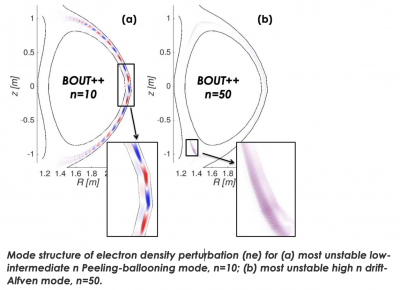 The paper “Numerical modeling of pedestal stability and broadband turbulence of wide-pedestal QH-mode plasmas on DIII-D” by Z. Li was published in Nuclear Fusion (https://doi.org/10.1088/1741-4326/ac4acf). This paper reports the recent progress on linear and nonlinear simulations using BOUT++ reduced two fluid MHD model to investigate the broadband turbulence often observed in the edge of wide-pedestal QH-mode plasmas. Two kinds of MHD-scale instabilities in different spatial locations within the pedestal were found in the simulations: one mild peeling-ballooning (PB) mode located near the minimum of Er well propagating in ion diamagnetic drift direction; and one drift-Alfvén wave (DAW) locates in the upper-pedestal propagating in the electron diamagnetic drift direction and unstable only when the parallel electron dynamics is included in the simulation. The coupling between drift wave and shear Alfvén wave provides a possible cause of the experimentally observed local profile flattening in the upper-pedestal. The rotation direction, mode location, as well as the wavenumber of these two modes from BOUT++ simulations agree reasonably well with the experimental measurements, while the lack of quantitatively agreement is likely due to the lack of trapped electron physics in applied fluid model. This work presents improved physics understanding of the pedestal stability and turbulence dynamics for wide-pedestal QH-mode.
The paper “Numerical modeling of pedestal stability and broadband turbulence of wide-pedestal QH-mode plasmas on DIII-D” by Z. Li was published in Nuclear Fusion (https://doi.org/10.1088/1741-4326/ac4acf). This paper reports the recent progress on linear and nonlinear simulations using BOUT++ reduced two fluid MHD model to investigate the broadband turbulence often observed in the edge of wide-pedestal QH-mode plasmas. Two kinds of MHD-scale instabilities in different spatial locations within the pedestal were found in the simulations: one mild peeling-ballooning (PB) mode located near the minimum of Er well propagating in ion diamagnetic drift direction; and one drift-Alfvén wave (DAW) locates in the upper-pedestal propagating in the electron diamagnetic drift direction and unstable only when the parallel electron dynamics is included in the simulation. The coupling between drift wave and shear Alfvén wave provides a possible cause of the experimentally observed local profile flattening in the upper-pedestal. The rotation direction, mode location, as well as the wavenumber of these two modes from BOUT++ simulations agree reasonably well with the experimental measurements, while the lack of quantitatively agreement is likely due to the lack of trapped electron physics in applied fluid model. This work presents improved physics understanding of the pedestal stability and turbulence dynamics for wide-pedestal QH-mode.
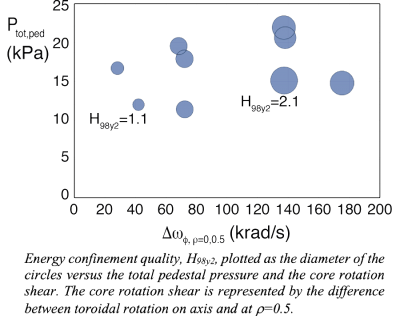 The paper “Deconvolving the Roles of E×B Shear and Pedestal Structure in the Energy Confinement Quality of Super H-Mode Experiments” by A.M. Garofalo et al. was published in Nuclear Fusion (https://doi.org/10.1088/1741-4326/ac4d63). This paper presents results from recent DIII-D experiments investigating the energy confinement quality of super H-mode plasmas and shows that the contribution from high rotation in the E×B shear, not the high pedestal pressure, is responsible for confinement quality in excess of H98y2 ~1.2. The experimental results confirmed quantitatively the predict-first transport modeling results published in a previous paper [S. Ding, et al., Nucl. Fusion 60 (2020) 034001]. By reducing the NBI torque and fixed power, the energy confinement quality during the stationary phase of super H-mode experiments was reduced from H98y2 ~1.6 to H98y2 ~1.2, as predicted. In addition, the experiments showed that the same exceptionally high confinement quality (H98y2 >2) can be achieved at high NBI torque (and nearly identical rotation profiles) with either high or low plasma triangularity, and a 30% difference in the pedestal pressure. The paper also provides new insight into results of previous predictions [W.M. Solomon, et al., Phys. Plasmas 23 (2016) 056105] of ITER Baseline Scenario performance assuming a super H-mode pedestal. Consistent with the experimental results in this paper, no increase of the ITER energy confinement quality is predicted with increasing pedestal pressure, although an improvement in the fusion gain is predicted with the higher core density associated with higher pedestal density.
The paper “Deconvolving the Roles of E×B Shear and Pedestal Structure in the Energy Confinement Quality of Super H-Mode Experiments” by A.M. Garofalo et al. was published in Nuclear Fusion (https://doi.org/10.1088/1741-4326/ac4d63). This paper presents results from recent DIII-D experiments investigating the energy confinement quality of super H-mode plasmas and shows that the contribution from high rotation in the E×B shear, not the high pedestal pressure, is responsible for confinement quality in excess of H98y2 ~1.2. The experimental results confirmed quantitatively the predict-first transport modeling results published in a previous paper [S. Ding, et al., Nucl. Fusion 60 (2020) 034001]. By reducing the NBI torque and fixed power, the energy confinement quality during the stationary phase of super H-mode experiments was reduced from H98y2 ~1.6 to H98y2 ~1.2, as predicted. In addition, the experiments showed that the same exceptionally high confinement quality (H98y2 >2) can be achieved at high NBI torque (and nearly identical rotation profiles) with either high or low plasma triangularity, and a 30% difference in the pedestal pressure. The paper also provides new insight into results of previous predictions [W.M. Solomon, et al., Phys. Plasmas 23 (2016) 056105] of ITER Baseline Scenario performance assuming a super H-mode pedestal. Consistent with the experimental results in this paper, no increase of the ITER energy confinement quality is predicted with increasing pedestal pressure, although an improvement in the fusion gain is predicted with the higher core density associated with higher pedestal density.
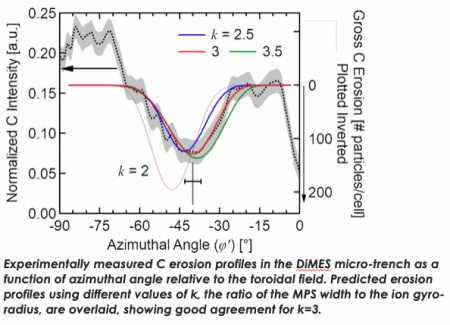 The magnetic pre-sheath (MPS) width is a critical parameter to define the sheath potential, which controls the ion trajectory of low-Z species (D, T, He, and C), as well as the prompt re-deposition of high-Z species. In the paper “Determination of the characteristic magnetic pre-sheath length at divertor surfaces using micro-engineered targets on DiMES at DIII-D” recently published by S. Abe et al., the MPS width was determined by measuring the azimuthal and polar D ion incident angle using micro-trench samples on DiMES (https://doi.org/10.1088/1741-4326/ac3cdb). Micro-trenches (30×30×4 µm) fabricated via focused ion beam (FIB) milling on a silicon surface were exposed to steady L-mode plasmas in DIII-D. The D ion incident angles were determined via the areal distribution of C impurity depositions measured by energy-dispersive X-ray spectroscopy (EDS). C deposition profiles showed that the erosion was maximized for the azimuthal direction of φ = -40° (referenced to the toroidal magnetic field direction) as well as the polar angle of θ = 80° (referenced to the surface normal direction) due to the ion shadowing effect. Those ion incident angles were reproduced by a Monte Carlo equation-of-motion model tracking the ion trajectories through the sheath.
The magnetic pre-sheath (MPS) width is a critical parameter to define the sheath potential, which controls the ion trajectory of low-Z species (D, T, He, and C), as well as the prompt re-deposition of high-Z species. In the paper “Determination of the characteristic magnetic pre-sheath length at divertor surfaces using micro-engineered targets on DiMES at DIII-D” recently published by S. Abe et al., the MPS width was determined by measuring the azimuthal and polar D ion incident angle using micro-trench samples on DiMES (https://doi.org/10.1088/1741-4326/ac3cdb). Micro-trenches (30×30×4 µm) fabricated via focused ion beam (FIB) milling on a silicon surface were exposed to steady L-mode plasmas in DIII-D. The D ion incident angles were determined via the areal distribution of C impurity depositions measured by energy-dispersive X-ray spectroscopy (EDS). C deposition profiles showed that the erosion was maximized for the azimuthal direction of φ = -40° (referenced to the toroidal magnetic field direction) as well as the polar angle of θ = 80° (referenced to the surface normal direction) due to the ion shadowing effect. Those ion incident angles were reproduced by a Monte Carlo equation-of-motion model tracking the ion trajectories through the sheath.
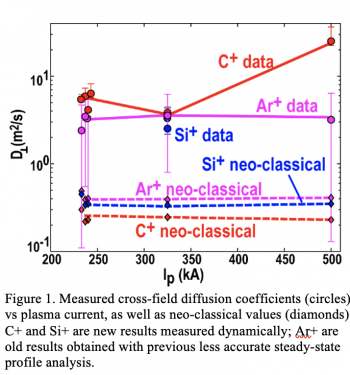 In a recently (Feb 2022) published paper in Physics of Plasmas by E. Hollmann et al (doi https://aip.scitation.org/doi/full/10.1063/5.0080385), the first dynamic (time-dependent) measurements of impurity ion radial (cross-field) diffusion coefficients for post-disruption runaway electron plateaus are described. Small (~ 1 mm diameter) carbon or silicon pellets were fired into the edge of steady-state runaway electron (RE) plateaus created by argon pellet injection. The resulting radial transport of singly-charged impurity ions (C^+or Si^+) was monitored using passive spectroscopy with the DIII-D CER spectrometer system. Radial (cross-field) diffusion coefficients D_⊥≈2-5 m^2/s were obtained, about 10× larger than expected from neo-classical theory. It is speculated at present that these large diffusion coefficients may be due to turbulent transport. Even with these anomalous transport rates, the implications of this work are that impurity ion transport is too slow to mix into a vertically unstable RE plateau in ITER on the vertical drift timescale of ~100 ms, suggesting that RE plateau current dissipation by complete high-Z ion mixing into the RE plateau will be challenging to achieve.
In a recently (Feb 2022) published paper in Physics of Plasmas by E. Hollmann et al (doi https://aip.scitation.org/doi/full/10.1063/5.0080385), the first dynamic (time-dependent) measurements of impurity ion radial (cross-field) diffusion coefficients for post-disruption runaway electron plateaus are described. Small (~ 1 mm diameter) carbon or silicon pellets were fired into the edge of steady-state runaway electron (RE) plateaus created by argon pellet injection. The resulting radial transport of singly-charged impurity ions (C^+or Si^+) was monitored using passive spectroscopy with the DIII-D CER spectrometer system. Radial (cross-field) diffusion coefficients D_⊥≈2-5 m^2/s were obtained, about 10× larger than expected from neo-classical theory. It is speculated at present that these large diffusion coefficients may be due to turbulent transport. Even with these anomalous transport rates, the implications of this work are that impurity ion transport is too slow to mix into a vertically unstable RE plateau in ITER on the vertical drift timescale of ~100 ms, suggesting that RE plateau current dissipation by complete high-Z ion mixing into the RE plateau will be challenging to achieve.
- The paper “Explaining the lack of power degradation of energy confinement in wide pedestal quiescent H-modes via transport modeling” was published by S. Houshmandyar et. al. in Nuclear Fusion (https://doi.org/10.1088/1741-4326/ac583b). Unlike conventional H-modes, where the energy confinement time reduces with increasing heating power, the wide pedestal quiescent H mode plasmas do not show power degradation of the energy confinement. As the injected neutral beam power was increased, reduced core (ρ<0.45) transport calculated by TRANSP, as well as increased core temperatures, pressure gradient and diamagnetic E×B shear rate were observed. The reduction in the heat transport and rapid decrease in the ion temperature gradient scale length suggest the formation of an ion internal transport barrier (ITB) that was accompanied by increased stored energy in the core. Quasilinear turbulent transport modeling using the trapped gyro Landau fluid (TGLF) code was used to predict the ITB and its turbulence stability properties. By using profiles and equilibria produced by matching the TRANSP transport fluxes with the TGLF transport model within the TGYRO transport solver, the energy confinement time captures the experimentally observed insensitivity to the increased neutral beam power. Linear stability analysis reveals that drift-wave instabilities in the core are stabilized by E×B shear, Ti/Te ratio and Shafranov shift; the latter was found to have the strongest effect on the turbulence suppression at the highest heating level.
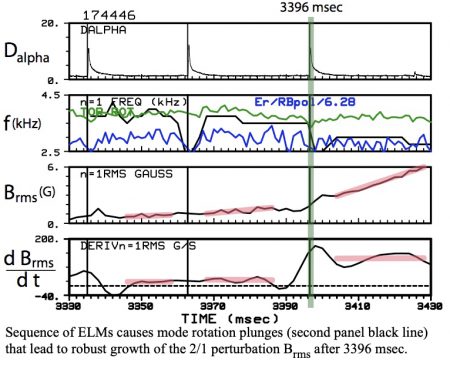 The paper “Disruptive Neoclassical Tearing Mode Seeding in DIII-D with Implications for ITER” was published by R.J. La Haye et. al. in the May 2022 issue of Nuclear Fusion (https://doi.org/10.1088/1741-4326/ac351f). New studies identify critical parameters and physics governing onset of a disruptive neoclassical tearing mode (NTM). A m/n=2/1 mode in DIII-D that grows robustly after a seeding event (edge localized mode ELM or sawtooth crash) is caused by the mode rotation dropping close to the plasma’s Er=0 rest frame; this opens the stabilizing ion-polarization current “gate” and destabilizes an otherwise marginally stable NTM. Our new experimental and theoretical insights and novel toroidal theory-based modelling are benchmarked and scalable to ITER and other future experiments. Mode rotation at q=2 is stabilizing (“gate closed”) except for MHD-induced transients that can “open the gate.” Extrapolating from DIII-D ITER baseline scenario (IBS) discharges, MHD transients are much more likely to destabilize problematic robustly growing 2/1 NTMs in ITER and other burning plasmas.
The paper “Disruptive Neoclassical Tearing Mode Seeding in DIII-D with Implications for ITER” was published by R.J. La Haye et. al. in the May 2022 issue of Nuclear Fusion (https://doi.org/10.1088/1741-4326/ac351f). New studies identify critical parameters and physics governing onset of a disruptive neoclassical tearing mode (NTM). A m/n=2/1 mode in DIII-D that grows robustly after a seeding event (edge localized mode ELM or sawtooth crash) is caused by the mode rotation dropping close to the plasma’s Er=0 rest frame; this opens the stabilizing ion-polarization current “gate” and destabilizes an otherwise marginally stable NTM. Our new experimental and theoretical insights and novel toroidal theory-based modelling are benchmarked and scalable to ITER and other future experiments. Mode rotation at q=2 is stabilizing (“gate closed”) except for MHD-induced transients that can “open the gate.” Extrapolating from DIII-D ITER baseline scenario (IBS) discharges, MHD transients are much more likely to destabilize problematic robustly growing 2/1 NTMs in ITER and other burning plasmas.
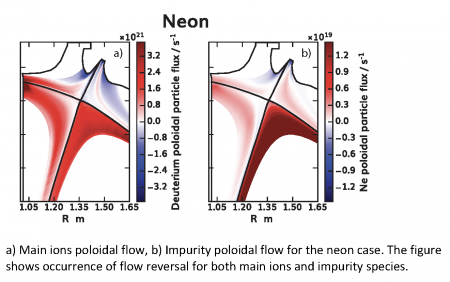 The paper “Impurity leakage and radiative cooling in the first nitrogen and neon seeding study in the closed DIII-D SAS configuration” by L. Casali et al. was published in Nuclear Fusion (https://doi.org/10.1088/1741-4326/ac3e84). Impurity seeding experiments performed in the SAS graphite divertor at DIII-D using nitrogen and neon as seeded species show that N remains compressed in the divertor, thereby providing high radiative losses without affecting the pedestal profiles and displacing carbon as dominant radiator. Neon, instead, radiates more upstream than N thus reducing the power flux through the separatrix leading to a reduced ELM frequency and compression in the divertor. The different behavior between the two impurities is confirmed by SOLPS-ITER modeling which includes multiple impurity species and a treatment of full drifts, currents and neutral–neutral collisions. This work demonstrates the mechanism governing impurity leakage by studying the impurity transport in terms of the parallel momentum balance. Lower divertor enrichment is found for Ne compared to N consistent with its higher ionization potential and longer mean free path. Since carbon is an intrinsic radiator at DIII-D, the different role of carbon in the N vs Ne seeded cases both in the experiments and in the numerical modeling is also demonstrated. In the cases presented here, plasma drifts, flow reversal caused by high level of closure together with the effect of the thermal force contribute significantly to the shift of the impurity stagnation point leading to impurity leakage. Finally, this work highlights the importance of accompanying experimental studies with numerical modeling with particular attention to plasma flows, drifts and ionization profile to determine the details of the SOL impurity transport as the latter may vary with changes in divertor regime and geometry.
The paper “Impurity leakage and radiative cooling in the first nitrogen and neon seeding study in the closed DIII-D SAS configuration” by L. Casali et al. was published in Nuclear Fusion (https://doi.org/10.1088/1741-4326/ac3e84). Impurity seeding experiments performed in the SAS graphite divertor at DIII-D using nitrogen and neon as seeded species show that N remains compressed in the divertor, thereby providing high radiative losses without affecting the pedestal profiles and displacing carbon as dominant radiator. Neon, instead, radiates more upstream than N thus reducing the power flux through the separatrix leading to a reduced ELM frequency and compression in the divertor. The different behavior between the two impurities is confirmed by SOLPS-ITER modeling which includes multiple impurity species and a treatment of full drifts, currents and neutral–neutral collisions. This work demonstrates the mechanism governing impurity leakage by studying the impurity transport in terms of the parallel momentum balance. Lower divertor enrichment is found for Ne compared to N consistent with its higher ionization potential and longer mean free path. Since carbon is an intrinsic radiator at DIII-D, the different role of carbon in the N vs Ne seeded cases both in the experiments and in the numerical modeling is also demonstrated. In the cases presented here, plasma drifts, flow reversal caused by high level of closure together with the effect of the thermal force contribute significantly to the shift of the impurity stagnation point leading to impurity leakage. Finally, this work highlights the importance of accompanying experimental studies with numerical modeling with particular attention to plasma flows, drifts and ionization profile to determine the details of the SOL impurity transport as the latter may vary with changes in divertor regime and geometry.
- A paper on “the radial phase variation of reversed-shear and toroidicity-induced Alfven eigenmodes in DIII-D” by W. Heidbrink et al. has been published in Nuclear Fusion at https://doi.org/10.1088/1741-4326/ac5109. For all plasma waves, there is a relationship between dissipation, the eigenfunction, and the energy carried by the group velocity. This study, which began as a senior thesis project for UCI student Erik Hansen, used ECE measurements of the radial phase to probe this relationship for RSAEs and TAEs. A typical RSAE has little phase variation, while the phase of a typical TAE increases at large major radius, indicating energy flow from the core of the plasma towards the edge. However, both RSAEs and TAEs exhibit great variability in their radial phase profile, which precludes use of the radial phase profile as a routine diagnostic of energy flow.
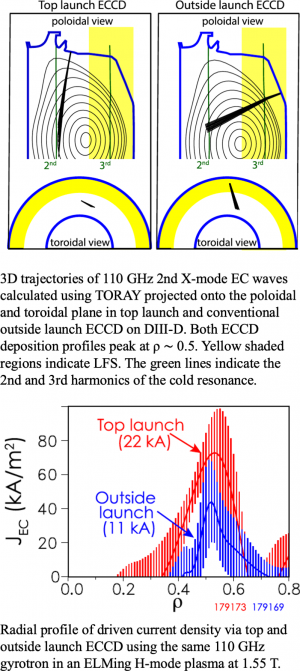 The Nuclear Fusion Letter “Doubling off-axis electron cyclotron current drive efficiency via velocity space engineering,” by Xi Chen, et al. has been recently published (https://doi.org/10.1088/1741-4326/ac544a). For the first time, experiments on the DIII-D tokamak have demonstrated electron cyclotron current drive with more than double the conventional efficiency by tailoring the wave–particle interactions in velocity space using a novel ‘top launch’ geometry. Steering the EC waves to propagate nearly parallel to the resonance drives current more efficiently by (1) selective damping on electrons with higher parallel velocity v||, and (2) longer absorption path to compensate for inherently weaker absorption at higher v||. Experiments using a fixed-injection top launch system find an optimal velocity space interaction for maximum current drive efficiency at ρ ∼ 0.5 where the ease of drawing out a high v|| electron tail is balanced by sufficient absorption.
The Nuclear Fusion Letter “Doubling off-axis electron cyclotron current drive efficiency via velocity space engineering,” by Xi Chen, et al. has been recently published (https://doi.org/10.1088/1741-4326/ac544a). For the first time, experiments on the DIII-D tokamak have demonstrated electron cyclotron current drive with more than double the conventional efficiency by tailoring the wave–particle interactions in velocity space using a novel ‘top launch’ geometry. Steering the EC waves to propagate nearly parallel to the resonance drives current more efficiently by (1) selective damping on electrons with higher parallel velocity v||, and (2) longer absorption path to compensate for inherently weaker absorption at higher v||. Experiments using a fixed-injection top launch system find an optimal velocity space interaction for maximum current drive efficiency at ρ ∼ 0.5 where the ease of drawing out a high v|| electron tail is balanced by sufficient absorption.
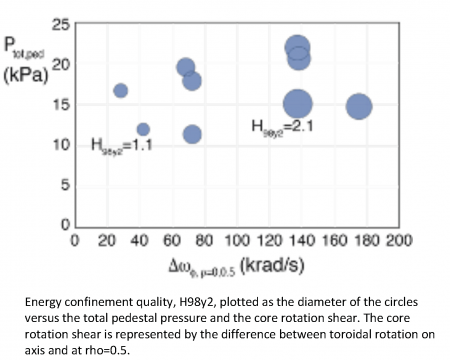 The paper “Deconvolving the Roles of E×B Shear and Pedestal Structure in the Energy Confinement Quality of Super H-Mode Experiments” by A.M. Garofalo et al. was recently published in Nuclear Fusion (https://doi.org/10.1088/1741-4326/ac4d63). This paper presents results from recent DIII-D experiments investigating the energy confinement quality of super H-mode plasmas and shows that the contribution from high rotation in the E×B shear, not the high pedestal pressure, is responsible for confinement quality in excess of H98y2 ~1.2. The experimental results confirmed quantitatively the predict-first transport modeling results published in a previous paper [S. Ding, et al., Nucl. Fusion 60 (2020) 034001]. By reducing the NBI torque and fixed power, the energy confinement quality during the stationary phase of super H-mode experiments was reduced from H98y2 ~1.6 to H98y2 ~1.2, as predicted. In addition, the experiments showed that the same exceptionally high confinement quality (H98y2 >2) can be achieved at high NBI torque (and nearly identical rotation profiles) with either high or low plasma triangularity, and a 30% difference in the pedestal pressure. The paper also provides new insight into results of previous predictions [W.M. Solomon, et al., Phys. Plasmas 23 (2016) 056105] of ITER Baseline Scenario performance assuming a super H-mode pedestal. Consistent with the experimental results in this paper, no increase of the ITER energy confinement quality is predicted with increasing pedestal pressure, although an improvement in the fusion gain is predicted with the higher core density associated with higher pedestal density.
The paper “Deconvolving the Roles of E×B Shear and Pedestal Structure in the Energy Confinement Quality of Super H-Mode Experiments” by A.M. Garofalo et al. was recently published in Nuclear Fusion (https://doi.org/10.1088/1741-4326/ac4d63). This paper presents results from recent DIII-D experiments investigating the energy confinement quality of super H-mode plasmas and shows that the contribution from high rotation in the E×B shear, not the high pedestal pressure, is responsible for confinement quality in excess of H98y2 ~1.2. The experimental results confirmed quantitatively the predict-first transport modeling results published in a previous paper [S. Ding, et al., Nucl. Fusion 60 (2020) 034001]. By reducing the NBI torque and fixed power, the energy confinement quality during the stationary phase of super H-mode experiments was reduced from H98y2 ~1.6 to H98y2 ~1.2, as predicted. In addition, the experiments showed that the same exceptionally high confinement quality (H98y2 >2) can be achieved at high NBI torque (and nearly identical rotation profiles) with either high or low plasma triangularity, and a 30% difference in the pedestal pressure. The paper also provides new insight into results of previous predictions [W.M. Solomon, et al., Phys. Plasmas 23 (2016) 056105] of ITER Baseline Scenario performance assuming a super H-mode pedestal. Consistent with the experimental results in this paper, no increase of the ITER energy confinement quality is predicted with increasing pedestal pressure, although an improvement in the fusion gain is predicted with the higher core density associated with higher pedestal density.
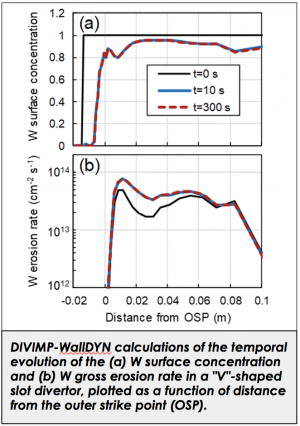 The paper “Design and Physics Basis for the Upcoming DIII-D SAS-VW Campaign to Quantify Tungsten Leakage and Transport in a New Slot Divertor Geometry” by T. Abrams et al. was recently published in Physica Scripta (https://doi.org/10.1088/1402-4896/ac3c5f). This paper describes the physics basis for an upcoming set of DIII-D experiments to exploit the high SOL collisionality enabled by a tightly baffled slot divertor geometry, which is hypothesized to suppress tungsten leakage in DIII-D. A toroidal row of graphite tiles in the Small Angle Slot (SAS) divertor has been coated with 10-15 µm of tungsten. New spectroscopic viewing chords with in-vacuo optics have been developed to measure the W gross erosion source from the divertor surface with high spatial and temporal resolution. SOLPS-DIVIMP simulations conducted with drifts using the planned “V” shape predict a substantial reduction in W sourcing and SOL accumulation in either B×∇B direction relative to either the old SAS divertor shape or the open, lower divertor. DIVIMP-WallDYN modeling indicates that the mixed-material C/W surface layer reaches equilibrium within 10 s of plasma exposure; the surface composition remains >80% W in the common SOL region but is quickly covered by carbon in the private flux region. These physics models will be “stress-tested” in the upcoming FY22 DIII-D campaign to build confidence in advanced tungsten divertor geometries for next-step devices.
The paper “Design and Physics Basis for the Upcoming DIII-D SAS-VW Campaign to Quantify Tungsten Leakage and Transport in a New Slot Divertor Geometry” by T. Abrams et al. was recently published in Physica Scripta (https://doi.org/10.1088/1402-4896/ac3c5f). This paper describes the physics basis for an upcoming set of DIII-D experiments to exploit the high SOL collisionality enabled by a tightly baffled slot divertor geometry, which is hypothesized to suppress tungsten leakage in DIII-D. A toroidal row of graphite tiles in the Small Angle Slot (SAS) divertor has been coated with 10-15 µm of tungsten. New spectroscopic viewing chords with in-vacuo optics have been developed to measure the W gross erosion source from the divertor surface with high spatial and temporal resolution. SOLPS-DIVIMP simulations conducted with drifts using the planned “V” shape predict a substantial reduction in W sourcing and SOL accumulation in either B×∇B direction relative to either the old SAS divertor shape or the open, lower divertor. DIVIMP-WallDYN modeling indicates that the mixed-material C/W surface layer reaches equilibrium within 10 s of plasma exposure; the surface composition remains >80% W in the common SOL region but is quickly covered by carbon in the private flux region. These physics models will be “stress-tested” in the upcoming FY22 DIII-D campaign to build confidence in advanced tungsten divertor geometries for next-step devices.
FY22-Q2:
 The paper “Pellet triggering of edge localized modes in low collisionality pedestals at DIII-D” by R.S. Wilcox et al. was published in Nuclear Fusion (https://doi.org/10.1088/1741-4326/ac3b8b). Edge localized modes (ELMs) are triggered using deuterium pellets injected into plasmas with ITER-relevant low collisionality pedestals, and the resulting peak ELM energy fluence is reduced by approximately 25%–50% relative to natural ELMs destabilized at similar pedestal pressures. For sufficiently large pellets, both instantaneous and time-integrated ELM energy deposition measured by infrared cameras is reduced with respect to naturally occurring ELMs at the inner strike point, which is the position where it is largest for natural ELMs. Energy fluence at the outer strike point is less effected. ELM triggering success correlates strongly with pellet mass, consistent with the theory that a large pressure perturbation is required to trigger an ELM in low collisionality discharges that are far from the ballooning stability boundary. Toroidally asymmetric striations in heat and particle flux are observed in the outboard far scrape-off layer resulting from ELMs that are triggered by pellets, which may be problematic in future devices if heat flux is incident on unintended surfaces.
The paper “Pellet triggering of edge localized modes in low collisionality pedestals at DIII-D” by R.S. Wilcox et al. was published in Nuclear Fusion (https://doi.org/10.1088/1741-4326/ac3b8b). Edge localized modes (ELMs) are triggered using deuterium pellets injected into plasmas with ITER-relevant low collisionality pedestals, and the resulting peak ELM energy fluence is reduced by approximately 25%–50% relative to natural ELMs destabilized at similar pedestal pressures. For sufficiently large pellets, both instantaneous and time-integrated ELM energy deposition measured by infrared cameras is reduced with respect to naturally occurring ELMs at the inner strike point, which is the position where it is largest for natural ELMs. Energy fluence at the outer strike point is less effected. ELM triggering success correlates strongly with pellet mass, consistent with the theory that a large pressure perturbation is required to trigger an ELM in low collisionality discharges that are far from the ballooning stability boundary. Toroidally asymmetric striations in heat and particle flux are observed in the outboard far scrape-off layer resulting from ELMs that are triggered by pellets, which may be problematic in future devices if heat flux is incident on unintended surfaces.
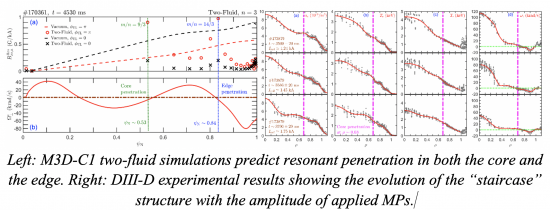 The paper “Linear Simulation of Magnetohydrodynamic Plasma Response to Three-Dimensional Magnetic Perturbations in High-β_P Plasmas” by Ran Chen et al. was published in Nuclear Fusion (https://iopscience.iop.org/article/10.1088/1741-4326/ac39f4). In this paper, linear MHD plasma response to 3D magnetic perturbations (MPs) in a joint DIII-D/EAST collaboration on high-β_P plasmas was analyzed numerically using the extended-MHD code M3D-C1. Compared to the vacuum response, single-fluid M3D-C1 simulations predicted a significant decrease of the resonant plasma response to applied n=3 MPs at the maximum-penetration radius as q_95 increases. While single-fluid results showed resonant penetration occurring only near the pedestal top where the E×B toroidal rotation frequency was zero, two-fluid simulations showed comparable resonant penetration at both the top of the pedestal and the foot of the internal transport barrier (ITB), where the perpendicular electron rotation frequency is zero. Such resonant field penetration near the ITB foot might be responsible for the experimentally observed formation of a two-step “staircase” structure in both electron density and temperature profiles, which leads to a considerable deterioration of global plasma performance when MPs were applied in high-β_P plasmas.
The paper “Linear Simulation of Magnetohydrodynamic Plasma Response to Three-Dimensional Magnetic Perturbations in High-β_P Plasmas” by Ran Chen et al. was published in Nuclear Fusion (https://iopscience.iop.org/article/10.1088/1741-4326/ac39f4). In this paper, linear MHD plasma response to 3D magnetic perturbations (MPs) in a joint DIII-D/EAST collaboration on high-β_P plasmas was analyzed numerically using the extended-MHD code M3D-C1. Compared to the vacuum response, single-fluid M3D-C1 simulations predicted a significant decrease of the resonant plasma response to applied n=3 MPs at the maximum-penetration radius as q_95 increases. While single-fluid results showed resonant penetration occurring only near the pedestal top where the E×B toroidal rotation frequency was zero, two-fluid simulations showed comparable resonant penetration at both the top of the pedestal and the foot of the internal transport barrier (ITB), where the perpendicular electron rotation frequency is zero. Such resonant field penetration near the ITB foot might be responsible for the experimentally observed formation of a two-step “staircase” structure in both electron density and temperature profiles, which leads to a considerable deterioration of global plasma performance when MPs were applied in high-β_P plasmas.
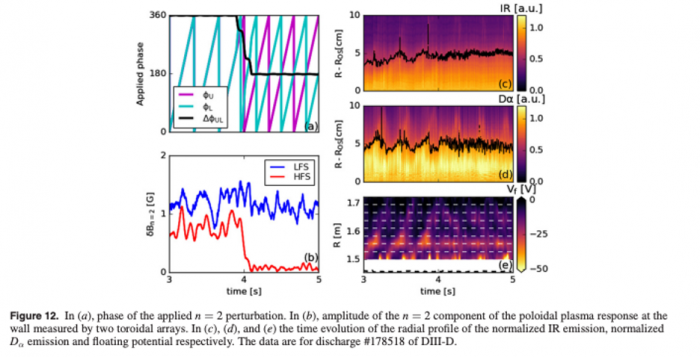 The paper “Controlling the size of non-axisymmetric magnetic footprints using resonant magnetic perturbations” by S. Munaretto, recently published in Nuclear Fusion (https://doi.org/10.1088/1741-4326/ac3b89), analyzes the impact of the poloidal spectrum of the applied RMP on the footprint at the divertor plates that alters the heat and particle flux distributions. Experimentally it is observed that a 3D structure in the IR, Dalpha and langmuir probes data corresponds to a large measured resonant plasma response (m=nq, dominant in the high field side) to applied n=2 RMP, and it is not visible when it is small, while the size of the 3D structure is found to be independent of the amplitude of the non-resonant component of the plasma response (m>nq, dominant in the low field side). Simulations done with M3D-C1 show that an RMP poloidal spectrum that maximizes the resonant plasma response will also maximize the size of the magnetic footprints, and the poloidal spectrum that minimizes the resonant plasma response will also minimize the footprints’ size. One of the consequences of these findings is that it will be challenging to decouple the footprint size from the RMP–ELM control problem, for which the resonant coupling is a requisite.
The paper “Controlling the size of non-axisymmetric magnetic footprints using resonant magnetic perturbations” by S. Munaretto, recently published in Nuclear Fusion (https://doi.org/10.1088/1741-4326/ac3b89), analyzes the impact of the poloidal spectrum of the applied RMP on the footprint at the divertor plates that alters the heat and particle flux distributions. Experimentally it is observed that a 3D structure in the IR, Dalpha and langmuir probes data corresponds to a large measured resonant plasma response (m=nq, dominant in the high field side) to applied n=2 RMP, and it is not visible when it is small, while the size of the 3D structure is found to be independent of the amplitude of the non-resonant component of the plasma response (m>nq, dominant in the low field side). Simulations done with M3D-C1 show that an RMP poloidal spectrum that maximizes the resonant plasma response will also maximize the size of the magnetic footprints, and the poloidal spectrum that minimizes the resonant plasma response will also minimize the footprints’ size. One of the consequences of these findings is that it will be challenging to decouple the footprint size from the RMP–ELM control problem, for which the resonant coupling is a requisite.
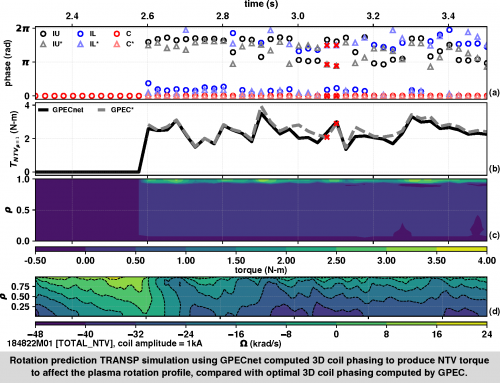 The paper “Neoclassical toroidal viscosity torque prediction via deep learning” by M. Clement, et al. was published in Nuclear Fusion (https://doi.org/10.1088/1741-4326/ac3e83). This paper covers the development of GPECnet, which is a densely connected neural network that has been trained on General Perturbed Equilibrium Code (GPEC) data, to predict the plasma stability, neoclassical toroidal viscosity (NTV) torque, and optimized 3D coil current distributions for desired NTV torque profiles. Using NTV torque, driven by non-axisymmetric field perturbations in a tokamak, can be vital in optimizing pedestal performance by controlling the rotation profile in both the core, to ensure tearing stability, and the edge, to avoid edge localized modes (ELMs).
The paper “Neoclassical toroidal viscosity torque prediction via deep learning” by M. Clement, et al. was published in Nuclear Fusion (https://doi.org/10.1088/1741-4326/ac3e83). This paper covers the development of GPECnet, which is a densely connected neural network that has been trained on General Perturbed Equilibrium Code (GPEC) data, to predict the plasma stability, neoclassical toroidal viscosity (NTV) torque, and optimized 3D coil current distributions for desired NTV torque profiles. Using NTV torque, driven by non-axisymmetric field perturbations in a tokamak, can be vital in optimizing pedestal performance by controlling the rotation profile in both the core, to ensure tearing stability, and the edge, to avoid edge localized modes (ELMs).
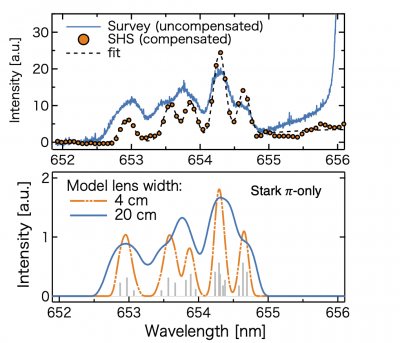 The paper “Doppler-Shift Compensated Spatial Heterodyne Spectroscopy (SHS) for Rapidly Moving Sources” by G. Burke, R. Fonck et al., has been published in Applied Optics (https://doi.org/10.1364/AO.426159) describing a novel technique to dramatically improve spectral resolution for the SHS diagnostic while maintaining very high optical throughput required for high-sensitivity studies. SHS measures the n=3-2 Balmer-alpha transition of the full-energy neutral beam emission manifold at high spectral, spatial (dR~1 cm) and temporal (dt~0.1 ms) resolution, allowing for measurements of the local magnetic field (proportional to the spectral separation of the Stark-split pi-components) in the H-Mode pedestal for application to current profile measurements across L-H transitions, ELMs and other fast phenomena. High resolution-luminosity product measurements of neutral beam emission in magnetized plasmas are typically severely limited by the varying Doppler broadening across large diameter collection optics. A broadening compensation method is developed for the spatial heterodyne spectroscopy interferometric technique. The compensation technique greatly reduces this window broadening, thereby enabling high resolution measurements at a significantly higher photon flux than previously available. Compensated and uncompensated measurements of emission generated by impact excitation of 61 keV deuterium neutrals in a tokamak plasma at the DIII-D National Fusion Facility are presented. The spectral width of the compensated measurement is ∼0.13 nm, which is comparable to the instrument resolution. This width is ∼4× smaller than the uncompensated width, which for the 20 cm diameter collection lens system utilized in this study is ∼0.5 nm. Pedestal measurements of the magnetic field evolution across ELMs provided the the basis for G. Burke’s APS-DPP 2021 Invited Talk. Top: Comparison of compensated (SHS) and uncompensated (survey) beam emission spectrum. Note that the SHS integration time is 0.002 s compared to 2 seconds for the survey spectrometer. Bottom: beam emission spectrum model showing SHS eliminates geometric doppler broadening.
The paper “Doppler-Shift Compensated Spatial Heterodyne Spectroscopy (SHS) for Rapidly Moving Sources” by G. Burke, R. Fonck et al., has been published in Applied Optics (https://doi.org/10.1364/AO.426159) describing a novel technique to dramatically improve spectral resolution for the SHS diagnostic while maintaining very high optical throughput required for high-sensitivity studies. SHS measures the n=3-2 Balmer-alpha transition of the full-energy neutral beam emission manifold at high spectral, spatial (dR~1 cm) and temporal (dt~0.1 ms) resolution, allowing for measurements of the local magnetic field (proportional to the spectral separation of the Stark-split pi-components) in the H-Mode pedestal for application to current profile measurements across L-H transitions, ELMs and other fast phenomena. High resolution-luminosity product measurements of neutral beam emission in magnetized plasmas are typically severely limited by the varying Doppler broadening across large diameter collection optics. A broadening compensation method is developed for the spatial heterodyne spectroscopy interferometric technique. The compensation technique greatly reduces this window broadening, thereby enabling high resolution measurements at a significantly higher photon flux than previously available. Compensated and uncompensated measurements of emission generated by impact excitation of 61 keV deuterium neutrals in a tokamak plasma at the DIII-D National Fusion Facility are presented. The spectral width of the compensated measurement is ∼0.13 nm, which is comparable to the instrument resolution. This width is ∼4× smaller than the uncompensated width, which for the 20 cm diameter collection lens system utilized in this study is ∼0.5 nm. Pedestal measurements of the magnetic field evolution across ELMs provided the the basis for G. Burke’s APS-DPP 2021 Invited Talk. Top: Comparison of compensated (SHS) and uncompensated (survey) beam emission spectrum. Note that the SHS integration time is 0.002 s compared to 2 seconds for the survey spectrometer. Bottom: beam emission spectrum model showing SHS eliminates geometric doppler broadening.
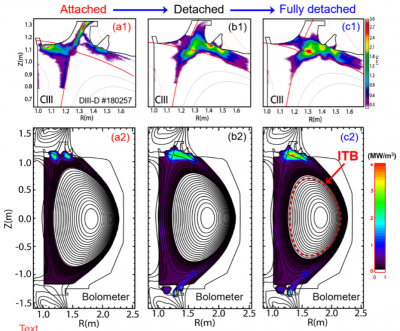 A paper “Achievements of Actively Controlled Divertor Detachment Compatible with Sustained High Confinement Core in DIII-D and EAST” by Liang Wang was published in Nuclear Fusion (http://doi.org/10.1088/1741-4326/ac4774). It reports the recent progress made on improving the integration of divertor detachment and core plasma performance jointly in DIII-D and EAST, including the successful development on detachment feedback control techniques for core-edge integration. DIII-D achieved actively controlled full detachment with low plasma temperature (Tet ≤ 5 eV across the entire divertor target plate) and low particle flux simultaneously with excellent core performance (βN ~3, βP >2 and H98~1.5) in the high βP scenario. The high βP scenario facilitates divertor detachment due to its relatively lower ETB, while a very high core energy confinement is enabled by a large-radius ITB. The synergy between ITB and ETB benefits the detachment access without degradation of core performance. The detachment leads to the reduction of ETB, which promotes the development of an even stronger ITB at large radius, and thus improves the plasma confinement eventually. In addition, it is demonstrated nitrogen seeding is more efficient to access full detachment, while neon seeding is more compatible with core plasma and ELM mitigation/suppression. Together with long pulse detachment achievement in EAST, these joint advances show a great potential for achieving a high-performance core plasma suitable for fusion reactors with controllable PWIs.
A paper “Achievements of Actively Controlled Divertor Detachment Compatible with Sustained High Confinement Core in DIII-D and EAST” by Liang Wang was published in Nuclear Fusion (http://doi.org/10.1088/1741-4326/ac4774). It reports the recent progress made on improving the integration of divertor detachment and core plasma performance jointly in DIII-D and EAST, including the successful development on detachment feedback control techniques for core-edge integration. DIII-D achieved actively controlled full detachment with low plasma temperature (Tet ≤ 5 eV across the entire divertor target plate) and low particle flux simultaneously with excellent core performance (βN ~3, βP >2 and H98~1.5) in the high βP scenario. The high βP scenario facilitates divertor detachment due to its relatively lower ETB, while a very high core energy confinement is enabled by a large-radius ITB. The synergy between ITB and ETB benefits the detachment access without degradation of core performance. The detachment leads to the reduction of ETB, which promotes the development of an even stronger ITB at large radius, and thus improves the plasma confinement eventually. In addition, it is demonstrated nitrogen seeding is more efficient to access full detachment, while neon seeding is more compatible with core plasma and ELM mitigation/suppression. Together with long pulse detachment achievement in EAST, these joint advances show a great potential for achieving a high-performance core plasma suitable for fusion reactors with controllable PWIs.
- The paper “The role of toroidal rotation in the very high energy confinement quality observed in super H-mode experiments on DIII-D”, by S. Ding, et al., has been recently published in Phys. Plasmas 28, 112504 (2021); doi: 10.1063/5.0061786. In this paper, the key role that toroidal rotation and the related ExB shear physics played in the very high energy confinement quality (H98y2>1.5) of super H-mode experiments on DIII-D is reported. Experiments show that the energy confinement quality decreases when toroidal rotation decreases due to the decreased externally controlled torque per particle. Meanwhile, the total pedestal pressure in the experiments remains very high during the rotation and confinement quality change. TGYRO transport modeling suggests the contribution from rotation in the ExB shear is responsible for the confinement quality in excess of standard H-mode (H98y2~1). CGYRO gyrokinetic simulations reveal the governing physics in the core plasma of super H-modes: significant up-shift of nonlinear the ITG critical gradient is observed when applying ExB shear physics in the modeling based on experimental data. The effects of other physical parameters and contribution from pedestal height, which may play minor roles in this study, are also discussed.
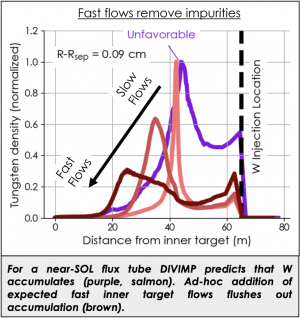 The paper “The role of BT-dependent flows on W accumulation at the edge of the confined plasma” by S. Zamperini et al. was published in Nuclear Fusion (https://doi.org/10.1088/1741-4326/ac3fe7). Edge codes have long predicted an accumulation of impurities near the separatrix, yet experimental evidence has been lacking. Experiments performed during the 2016 DIII-D Metal Rings Campaign have provided the first experimental evidence of near-SOL accumulation, though only when operating with the ion Bx∇B drift away from the divertor. During the campaign, two toroidally symmetric W rings were installed along the outer divertor to provide a trace source of W impurities into the SOL. Collector probes were inserted into the far-SOL, upon which W impurities were deposited on both sides. Modelling of W transport in the SOL was performed with DIVIMP and the recently upgraded far-SOL impurity transport code 3DLIM. It was found that in order to reproduce the experimentally measured deposition profiles in 3DLIM, the impurities must enter the far-SOL from above the outboard midplane. DIVIMP simulations demonstrate that this only occurs when W accumulates in the near-SOL. Furthermore, it is shown in DIVIMP that often observed fast inner-target parallel flows in the favorable BT direction can “flush out” W that would otherwise accumulate. Ad-hoc addition of these flows was necessary to reproduce the deposition profiles for the probe inserted for the favorable BT direction.
The paper “The role of BT-dependent flows on W accumulation at the edge of the confined plasma” by S. Zamperini et al. was published in Nuclear Fusion (https://doi.org/10.1088/1741-4326/ac3fe7). Edge codes have long predicted an accumulation of impurities near the separatrix, yet experimental evidence has been lacking. Experiments performed during the 2016 DIII-D Metal Rings Campaign have provided the first experimental evidence of near-SOL accumulation, though only when operating with the ion Bx∇B drift away from the divertor. During the campaign, two toroidally symmetric W rings were installed along the outer divertor to provide a trace source of W impurities into the SOL. Collector probes were inserted into the far-SOL, upon which W impurities were deposited on both sides. Modelling of W transport in the SOL was performed with DIVIMP and the recently upgraded far-SOL impurity transport code 3DLIM. It was found that in order to reproduce the experimentally measured deposition profiles in 3DLIM, the impurities must enter the far-SOL from above the outboard midplane. DIVIMP simulations demonstrate that this only occurs when W accumulates in the near-SOL. Furthermore, it is shown in DIVIMP that often observed fast inner-target parallel flows in the favorable BT direction can “flush out” W that would otherwise accumulate. Ad-hoc addition of these flows was necessary to reproduce the deposition profiles for the probe inserted for the favorable BT direction.
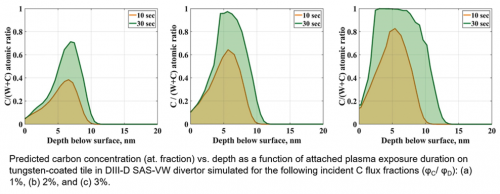 The paper “Tungsten–carbon surface evolution and erosion modeling for a small angle slot divertor in DIII-D” by J. Brooks et al., published in Nuclear Fusion (https://doi.org/10.1088/1741-4326/ac36f4), presents predictive modeling of the erosion properties and surface evolution of the tungsten coating in the upcoming DIII-D SAS-VW divertor. Erosion and redeposition simulations conducted using the fully-kinetic, 3D Monte Carlo code REDEP/WBC, based on a SOLPS-ITER plasma background, estimate a peak net tungsten erosion rate of 0.1 nm/s and a redeposition fraction of ~80% in attached plasma conditions (Te,max = 40 eV), with an 8% leakage flux out of the divertor towards the core. The ITMC-DYN material mixing/response model predicts that within 30 s of cumulative attached plasma exposure (2% carbon flux fraction), migration of eroded carbon to the SAS-VW tungsten-coated surface will yield an equilibrium W surface concentration of ~90%. The simulations presented in the manuscript demonstrate that the SAS-VW divertor can be effectively used to study high-Z impurity sourcing and local transport in a closed slot geometry.
The paper “Tungsten–carbon surface evolution and erosion modeling for a small angle slot divertor in DIII-D” by J. Brooks et al., published in Nuclear Fusion (https://doi.org/10.1088/1741-4326/ac36f4), presents predictive modeling of the erosion properties and surface evolution of the tungsten coating in the upcoming DIII-D SAS-VW divertor. Erosion and redeposition simulations conducted using the fully-kinetic, 3D Monte Carlo code REDEP/WBC, based on a SOLPS-ITER plasma background, estimate a peak net tungsten erosion rate of 0.1 nm/s and a redeposition fraction of ~80% in attached plasma conditions (Te,max = 40 eV), with an 8% leakage flux out of the divertor towards the core. The ITMC-DYN material mixing/response model predicts that within 30 s of cumulative attached plasma exposure (2% carbon flux fraction), migration of eroded carbon to the SAS-VW tungsten-coated surface will yield an equilibrium W surface concentration of ~90%. The simulations presented in the manuscript demonstrate that the SAS-VW divertor can be effectively used to study high-Z impurity sourcing and local transport in a closed slot geometry.
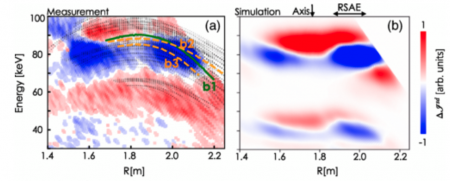 The paper “Visualization of Fast Ion Phase-Space Flow Driven by Alfvén Instabilities” by X.D. Du et al., has been recently published in Phys. Rev. Lett. (https://doi.org/10.1103/PhysRevLett.127.235002). For the first time, fast ion phase-space flow, driven by Alfvén eigenmodes (AEs), is measured by an imaging neutral particle analyzer in the DIII-D experiment. The flow firstly appears near the minimum safety factor at the injection energy of neutral beams, and then moves radially inward and outward by gaining and losing energy, respectively. The flow trajectories in phase space align well with the intersection lines of the constant magnetic moment surfaces and constant E−(ω/n)Pζ surfaces, where E, Pζ are the energy and canonical toroidal momentum of ions; ω and n are angular frequencies and toroidal mode numbers of AEs. It is found that the flow is so destructive that the thermalization of fast ions is no longer observed in regions of strong interaction. The measured phase-space flow is consistent with nonlinear hybrid kinetic-magnetohydrodynamics simulation. Calculations of the relatively narrow phase-space islands reveal that fast ions must transition between different flow trajectories to experience large-scale phase-space transport.
The paper “Visualization of Fast Ion Phase-Space Flow Driven by Alfvén Instabilities” by X.D. Du et al., has been recently published in Phys. Rev. Lett. (https://doi.org/10.1103/PhysRevLett.127.235002). For the first time, fast ion phase-space flow, driven by Alfvén eigenmodes (AEs), is measured by an imaging neutral particle analyzer in the DIII-D experiment. The flow firstly appears near the minimum safety factor at the injection energy of neutral beams, and then moves radially inward and outward by gaining and losing energy, respectively. The flow trajectories in phase space align well with the intersection lines of the constant magnetic moment surfaces and constant E−(ω/n)Pζ surfaces, where E, Pζ are the energy and canonical toroidal momentum of ions; ω and n are angular frequencies and toroidal mode numbers of AEs. It is found that the flow is so destructive that the thermalization of fast ions is no longer observed in regions of strong interaction. The measured phase-space flow is consistent with nonlinear hybrid kinetic-magnetohydrodynamics simulation. Calculations of the relatively narrow phase-space islands reveal that fast ions must transition between different flow trajectories to experience large-scale phase-space transport.
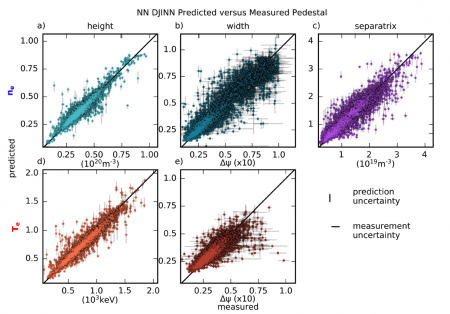 The paper “Prediction of DIII-D Pedestal Structure From Externally Controllable Parameters” by E. U. Zeger, et al. was recently published in IEEE Transactions on Plasma Science (https://doi.org/10.1109/TPS.2021.3114608). An experimental data-driven machine learning approach predicts the pedestal heights and widths of electron density and temperature from externally controllable parameters such as the plasma shape, heating method and power, and gas puff rate and integrated gas puff. The most important parameters for setting the pedestal structure were plasma current, toroidal magnetic field, neutral beam heating power and shaping quantities. The deep jointly informed neural network (DJINN) algorithm was applied to identify suitable neural network (NN) architectures. The NN outperformed simple linear regression (LR) analysis, indicating nonlinear dependencies in the pedestal structure. [E. U. Zeger (Stanford University) performed her research during the remote 2020 Science Undergraduate Laboratory Internship (SULI) program under the supervision of F. M. Laggner and A. Bortolon and her work received an APS-DPP Outstanding Undergraduate Poster Award.]
The paper “Prediction of DIII-D Pedestal Structure From Externally Controllable Parameters” by E. U. Zeger, et al. was recently published in IEEE Transactions on Plasma Science (https://doi.org/10.1109/TPS.2021.3114608). An experimental data-driven machine learning approach predicts the pedestal heights and widths of electron density and temperature from externally controllable parameters such as the plasma shape, heating method and power, and gas puff rate and integrated gas puff. The most important parameters for setting the pedestal structure were plasma current, toroidal magnetic field, neutral beam heating power and shaping quantities. The deep jointly informed neural network (DJINN) algorithm was applied to identify suitable neural network (NN) architectures. The NN outperformed simple linear regression (LR) analysis, indicating nonlinear dependencies in the pedestal structure. [E. U. Zeger (Stanford University) performed her research during the remote 2020 Science Undergraduate Laboratory Internship (SULI) program under the supervision of F. M. Laggner and A. Bortolon and her work received an APS-DPP Outstanding Undergraduate Poster Award.]
- The review paper “A brief history of negative triangularity tokamak plasmas” by A. Marinoni, O. Sauter and S. Coda has been published in Reviews of Modern Plasma Physics. (https://doi.org/10.1007/s41614-021-00054-0). It describes the history of plasmas with a cross sectional shape at negative triangularity by reviewing both theoretical and experiental investigations since the 1960s to the most recent published results from the TCV and DIII-D tokamaks. The paper mostly focuses on MHD stability and core transport, with a few latest works on pedestal and SOL physics.
FY22-Q1:
 The paper “Numerical assessment of the new V-shape small-angle slot divertor on DIII-D” by Roberto Maurizio was published in Nuclear Fusion (https://doi.org/10.1088/1741-4326/ac27c8). This paper reports on the numerical investigations on the effect of V-shaped divertor target in comparison to the small angle slot (SAS) divertor design on DIII-D. Simulations show that the electron temperature near the strike point is reduced in SAS-V compared to SAS, for both magnetic field directions, such that SAS-V achieves divertor detachment at a lower value of the outboard mid-plane separatrix electron density. The detachment threshold is lower because the V-shape focuses recycling neutrals on the V-end, densifying and cooling the plasma in the slot. At sufficiently high density, the V-shape also reduces the radial gradient of the temperature profile at the target, which in turns reduces the radial electric field and the E × B drift velocities, further densifying and cooling the plasma in the slot and leading to detachment.
The paper “Numerical assessment of the new V-shape small-angle slot divertor on DIII-D” by Roberto Maurizio was published in Nuclear Fusion (https://doi.org/10.1088/1741-4326/ac27c8). This paper reports on the numerical investigations on the effect of V-shaped divertor target in comparison to the small angle slot (SAS) divertor design on DIII-D. Simulations show that the electron temperature near the strike point is reduced in SAS-V compared to SAS, for both magnetic field directions, such that SAS-V achieves divertor detachment at a lower value of the outboard mid-plane separatrix electron density. The detachment threshold is lower because the V-shape focuses recycling neutrals on the V-end, densifying and cooling the plasma in the slot. At sufficiently high density, the V-shape also reduces the radial gradient of the temperature profile at the target, which in turns reduces the radial electric field and the E × B drift velocities, further densifying and cooling the plasma in the slot and leading to detachment.
 DIII-D has undergone a major upgrade and successfully injected high power off-axis neutral beams in both co-current and counter-current directions. This capability of high power co/counter steerable off-axis neutral beams on a major tokamak opens a unique parameter space of broad pressure and current profiles for high beta steady-state advanced tokamak (AT) scenarios, while retaining the ability to balance the injected torque for low rotation studies. A recent Nuclear Fusion paper by B.A. Grierson et. al. (https://doi.org/10.1088/1741-4326/ac2872) reports on the critical evaluation of the transmitted power and energetic ion population produced by this unique heating and current drive system, which is assessed through visible imaging, neutron measurements and rotation profile measurements at balanced torque. Minimal losses of neutral beam power have been achieved by optimizing the strongly focused ion sources required to pass through the aperture, and updated calibration coefficients have been implemented to accurately account for the injected power. Good ability to balance the neutral beam torque has been demonstrated by injecting the new off-axis counter injecting beam against the existing off-axis co-injected beam.
DIII-D has undergone a major upgrade and successfully injected high power off-axis neutral beams in both co-current and counter-current directions. This capability of high power co/counter steerable off-axis neutral beams on a major tokamak opens a unique parameter space of broad pressure and current profiles for high beta steady-state advanced tokamak (AT) scenarios, while retaining the ability to balance the injected torque for low rotation studies. A recent Nuclear Fusion paper by B.A. Grierson et. al. (https://doi.org/10.1088/1741-4326/ac2872) reports on the critical evaluation of the transmitted power and energetic ion population produced by this unique heating and current drive system, which is assessed through visible imaging, neutron measurements and rotation profile measurements at balanced torque. Minimal losses of neutral beam power have been achieved by optimizing the strongly focused ion sources required to pass through the aperture, and updated calibration coefficients have been implemented to accurately account for the injected power. Good ability to balance the neutral beam torque has been demonstrated by injecting the new off-axis counter injecting beam against the existing off-axis co-injected beam.
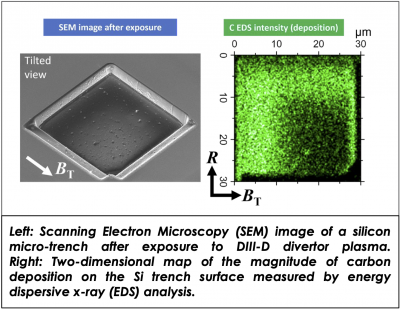 The paper “Micro-trench Measurements of the Net Deposition of Carbon Impurity Ions in the DIII-D Divertor and the Resulting Suppression of Surface Erosion” by S. Abe et al has been published in Physica Scripta (https://doi.org/10.1088/1402-4896/ac2af4). This paper reports carbon impurity ion incident angles and deposition rates, along with silicon erosion rates, from measurements of micro-engineered trenches on a silicon surface exposed to L-mode deuterium plasmas at the DIII-D divertor. Post-exposure ex-situ analysis revealed carbon deposition profiles on the trench floor, which showed carbon ion shadowing that was consistent with ERO calculations of average carbon ion angle distributions (IADs) for both polar and azimuthal angles. Measured silicon net erosion rates negatively correlated with the deposited carbon concentration at different locations. Differential erosion of surfaces on two different ion-downstream trench slope structures suggested that carbon deposition rate is affected by the carbon ion incident angle and significantly suppressed the surface erosion. The results suggest the C impurity ion incident angles, determined by the IADs and surface morphology, strongly affect erosion rates as well as the main ion (D, T, He) incident angles.
The paper “Micro-trench Measurements of the Net Deposition of Carbon Impurity Ions in the DIII-D Divertor and the Resulting Suppression of Surface Erosion” by S. Abe et al has been published in Physica Scripta (https://doi.org/10.1088/1402-4896/ac2af4). This paper reports carbon impurity ion incident angles and deposition rates, along with silicon erosion rates, from measurements of micro-engineered trenches on a silicon surface exposed to L-mode deuterium plasmas at the DIII-D divertor. Post-exposure ex-situ analysis revealed carbon deposition profiles on the trench floor, which showed carbon ion shadowing that was consistent with ERO calculations of average carbon ion angle distributions (IADs) for both polar and azimuthal angles. Measured silicon net erosion rates negatively correlated with the deposited carbon concentration at different locations. Differential erosion of surfaces on two different ion-downstream trench slope structures suggested that carbon deposition rate is affected by the carbon ion incident angle and significantly suppressed the surface erosion. The results suggest the C impurity ion incident angles, determined by the IADs and surface morphology, strongly affect erosion rates as well as the main ion (D, T, He) incident angles.
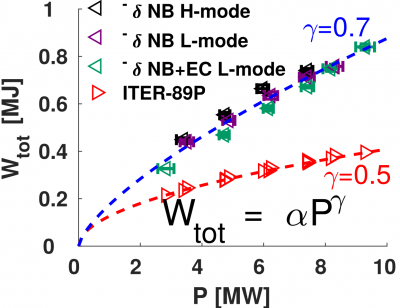 The paper “Diverted negative triangularity plasmas on DIII-D: the benefit of high confinement without the liability of an edge pedestal” by A. Marinoni et al., published in Nuclear Fusion (https://iopscience.iop.org/article/10.1088/1741-4326/ac1f60), describes recent experiments in high confinement L-mode edge plasmas with a negative triangularity shape. The work extends previous results obtained in inner wall limited discharges to a novel LSN configuration and challenges the conventional notion that pedestals are required for operation at high confinement. By reversing triangularity, plasmas do not transition to H-mode despite the auxiliary power far exceeds the L-H power threshold expected from conventional scaling laws. The resulting L-mode edge regime features a power degradation of confinement substantially weaker than the ITER-89P scaling, and sustains normalized confinement and pressure levels typical of standard H-mode scenarios (H_{98,y2}≈1, beta_N≈1). Additional benefits of this regime characterized by relaxed edge pressure profiles are low impurity retention, as displayed by tau_P/tau_E≈1, and a SOL power fall off length exceeding that typically measured in H-mode plasmas.
The paper “Diverted negative triangularity plasmas on DIII-D: the benefit of high confinement without the liability of an edge pedestal” by A. Marinoni et al., published in Nuclear Fusion (https://iopscience.iop.org/article/10.1088/1741-4326/ac1f60), describes recent experiments in high confinement L-mode edge plasmas with a negative triangularity shape. The work extends previous results obtained in inner wall limited discharges to a novel LSN configuration and challenges the conventional notion that pedestals are required for operation at high confinement. By reversing triangularity, plasmas do not transition to H-mode despite the auxiliary power far exceeds the L-H power threshold expected from conventional scaling laws. The resulting L-mode edge regime features a power degradation of confinement substantially weaker than the ITER-89P scaling, and sustains normalized confinement and pressure levels typical of standard H-mode scenarios (H_{98,y2}≈1, beta_N≈1). Additional benefits of this regime characterized by relaxed edge pressure profiles are low impurity retention, as displayed by tau_P/tau_E≈1, and a SOL power fall off length exceeding that typically measured in H-mode plasmas.
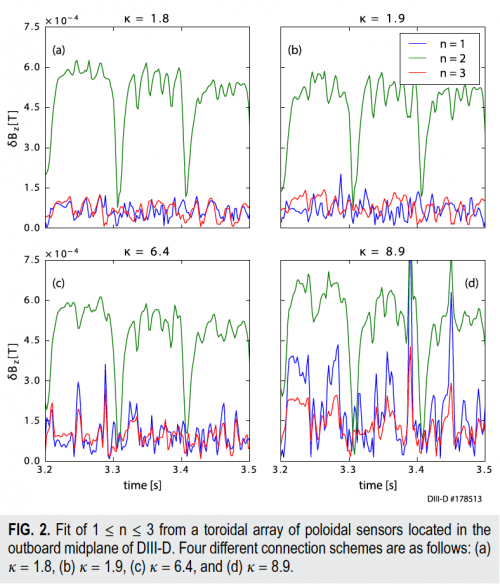 The paper “Optimizing the differential connection schemes for detecting 3D magnetic perturbations in DIII-D” by S.Munaretto et al., recently published in Review of Scientific Instruments (https://doi.org/10.1063/5.0045453), discusses the methods used at DIII-D to efficiently optimize the number, the location and the connections of a toroidal array of magnetic probes in order to provide the most accurate measurement of stationary or slowly rotating 3D magnetic structures. Acquiring the difference between two sensors highlights these 3D structures, but the desire of simultaneously detecting multiple toroidal harmonics (n) results in a large number of possible connections. Different approaches to optimize the connections by minimizing the condition number (K) of the design matrix -a matrix containing a combination of desired n and sensor locations and connections- are presented, as well as an overview of the updated 3D magnetic diagnostic system of DIII-D.
The paper “Optimizing the differential connection schemes for detecting 3D magnetic perturbations in DIII-D” by S.Munaretto et al., recently published in Review of Scientific Instruments (https://doi.org/10.1063/5.0045453), discusses the methods used at DIII-D to efficiently optimize the number, the location and the connections of a toroidal array of magnetic probes in order to provide the most accurate measurement of stationary or slowly rotating 3D magnetic structures. Acquiring the difference between two sensors highlights these 3D structures, but the desire of simultaneously detecting multiple toroidal harmonics (n) results in a large number of possible connections. Different approaches to optimize the connections by minimizing the condition number (K) of the design matrix -a matrix containing a combination of desired n and sensor locations and connections- are presented, as well as an overview of the updated 3D magnetic diagnostic system of DIII-D.
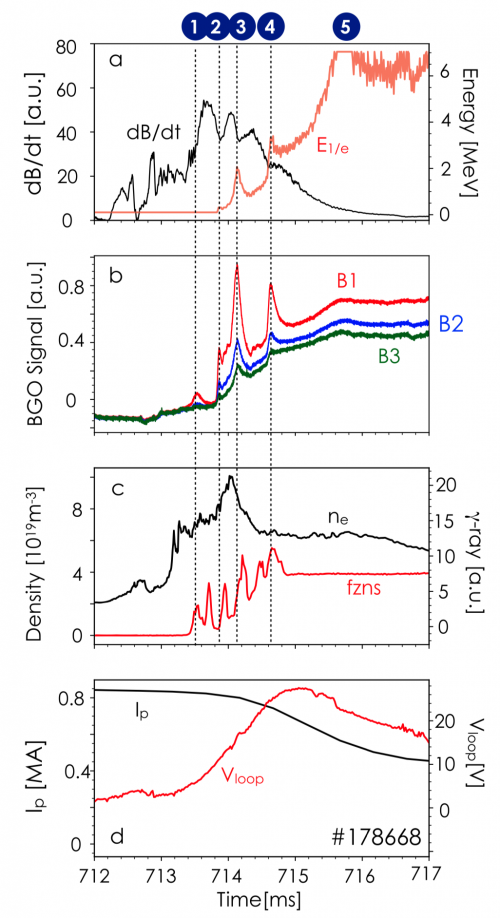 The paper “Experimental evidence of runaway electron tail generation via localized helical structure in pellet-triggered tokamak disruptions” by X.D. Du et al., has been published in Nucl. Fusion (https://doi.org/10.1088/1741-4326/ac1e5e). The paper describes the development of novel detector, using stacked BGO crystals, for runaway electron studies in the DIII-D tokamak. It is able to resolve fast dynamics of high-energy tail formation of REs with an ultra-high time resolution of ∼ 1 μs. As a cost, the detector estimates the ‘effective’ energy of a given shape of γ-ray spectra and sacrifices the energy resolution. In aid of the new measurement capability, a rapid, inhomogeneous growth of RE tail is observed in detail during a major disruption triggered by an argon pellet. It is found that both the population and energy of a well-confined RE tail significantly oscillate at the early period of the growth. The oscillation phase is locked to a slow rotating magnetohydrodynamic instability, which is briefly destabilized for only ∼ 1 ms at the early period of the current quench. The oscillation ceases promptly, when the mode disappears. The data suggests that the high-energy RE tail is well-confined and accelerated via a localized helical structure in the plasma core.
The paper “Experimental evidence of runaway electron tail generation via localized helical structure in pellet-triggered tokamak disruptions” by X.D. Du et al., has been published in Nucl. Fusion (https://doi.org/10.1088/1741-4326/ac1e5e). The paper describes the development of novel detector, using stacked BGO crystals, for runaway electron studies in the DIII-D tokamak. It is able to resolve fast dynamics of high-energy tail formation of REs with an ultra-high time resolution of ∼ 1 μs. As a cost, the detector estimates the ‘effective’ energy of a given shape of γ-ray spectra and sacrifices the energy resolution. In aid of the new measurement capability, a rapid, inhomogeneous growth of RE tail is observed in detail during a major disruption triggered by an argon pellet. It is found that both the population and energy of a well-confined RE tail significantly oscillate at the early period of the growth. The oscillation phase is locked to a slow rotating magnetohydrodynamic instability, which is briefly destabilized for only ∼ 1 ms at the early period of the current quench. The oscillation ceases promptly, when the mode disappears. The data suggests that the high-energy RE tail is well-confined and accelerated via a localized helical structure in the plasma core.
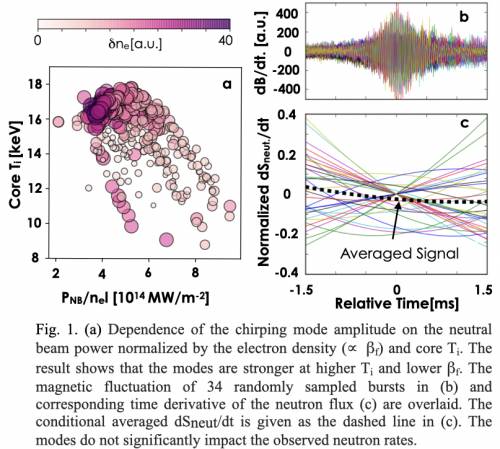 The paper “Multiscale Chirping Modes Driven by Thermal Ions in a Plasma with Reactor-Relevant Ion Temperature” by X.D. Du et al., has been published in Physical Review Letters (https://doi.org/10.1103/PhysRevLett.127.025001). The paper describes the observation of a thermal ion driven bursting instability with rapid frequency chirping in a plasma with reactor-relevant ion temperature in DIII-D tokamak. The modes are excited over a wide spatial range from macroscopic device size to microturbulence size, and the perturbation energy propagates across multiple spatial scales. The radial mode structure is able to expand from local to global in ∼ 0.1 ms, and it causes magnetic reconnection in the plasma edge, which can lead to a minor disruption event. The ηi (=∂lnT_i/∂lnn_i) exceeds the theoretically-predicted threshold for the destabilization of Alfvénic continuum modes due to compressibility of core ions. The most unstable modes belong to the strongly coupled kinetic ballooning mode and β-induced Alfvénic eigenmode branch. The key features of the observation are successfully reproduced by linear analysis solving the electromagnetic gyrokinetic equations via CGYRO. Since the mode, assessed to be an Alfvénic ion temperature gradient mode, is typically observed at high ion temperature (>10 keV) and high-β plasma regimes, the manifestation of the mode in future reactors should be studied with the corresponding development of mitigation strategies, if needed.
The paper “Multiscale Chirping Modes Driven by Thermal Ions in a Plasma with Reactor-Relevant Ion Temperature” by X.D. Du et al., has been published in Physical Review Letters (https://doi.org/10.1103/PhysRevLett.127.025001). The paper describes the observation of a thermal ion driven bursting instability with rapid frequency chirping in a plasma with reactor-relevant ion temperature in DIII-D tokamak. The modes are excited over a wide spatial range from macroscopic device size to microturbulence size, and the perturbation energy propagates across multiple spatial scales. The radial mode structure is able to expand from local to global in ∼ 0.1 ms, and it causes magnetic reconnection in the plasma edge, which can lead to a minor disruption event. The ηi (=∂lnT_i/∂lnn_i) exceeds the theoretically-predicted threshold for the destabilization of Alfvénic continuum modes due to compressibility of core ions. The most unstable modes belong to the strongly coupled kinetic ballooning mode and β-induced Alfvénic eigenmode branch. The key features of the observation are successfully reproduced by linear analysis solving the electromagnetic gyrokinetic equations via CGYRO. Since the mode, assessed to be an Alfvénic ion temperature gradient mode, is typically observed at high ion temperature (>10 keV) and high-β plasma regimes, the manifestation of the mode in future reactors should be studied with the corresponding development of mitigation strategies, if needed.
- The paper “The high-power helicon program at DIII-D: gearing up for first experiments,” by B. Van Compernolle et al was published in Nuclear Fusion (https://iopscience.iop.org/article/10.1088/1741-4326/ac25c0). The paper describes the helicon system at DIII-D, including the antenna, the transmission line network, the 1.2 MW 476 MHz klystron, and dedicated diagnostics. The comb-line traveling wave antenna concept and its implementation in DIII-D are laid out. As designed, the system exhibits low reflected power in a band near 476 MHz and has the appropriate phasing at 476 MHz to launch a unidirectional wave with normalized parallel wave number equal to 3. The transmission line network allows power to be applied to either end of the array, permitting selection of either co- or counter-current drive. Tests at low to moderate power show the onset of ‘multipactor’ breakdown in the system which was shown to be largely mitigated by the application of a toroidal field. The system will enable experiments to determine the non-inductive current profile in high-beta discharges, will shed light on the efficiency of a helicon system to drive current off-axis in steady-state tokamaks beyond ITER, and will provide tools to extend DIII- D’s steady state research to higher pressure and density.
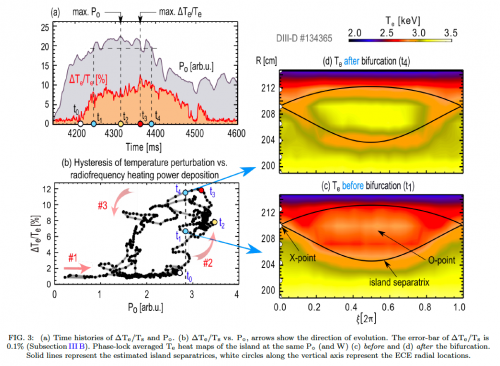 The Letter “Experimental Signatures of Electron Cyclotron Wave Energy Condensation in Magnetic Islands” by L. Bardoczi and N. C. Logan recently published in Nuclear Fusion (https://doi.org/10.1088/1741-4326/ac2413) reports bifurcation of ECCD driven electron temperature perturbation (dTe) in magnetic islands for the first time. In this DIII-D experiment dTe spontaneously increases by 50% in a growing 2,1 island which in turn rapidly shrinks, consistent with improved stabilization by the ECCD due to the temperature bifurcation. This non-linearity of dTe maps out a hysteresis in the island evolution cycle, in qualitative agreement with the theoretically predicted radio frequency current condensation effect by A. H. Reiman and N. J. Fisch [Phys. Rev. Lett. 121 225001 (2018)]. This theory predicts the non-linear amplification of the stabilizing component of the ECCD at the island O-point, following from the facts that (i) the confining magnetic flux surface topology of the island leads to a temperature peak at the O-point when it is subject to a heat source and (ii) the electron cyclotron waves deposit their energy at the electron distribution tail. Therefore, this observed temperature bifurcation can be critical for the active stabilization of tearing modes in tokamaks.
The Letter “Experimental Signatures of Electron Cyclotron Wave Energy Condensation in Magnetic Islands” by L. Bardoczi and N. C. Logan recently published in Nuclear Fusion (https://doi.org/10.1088/1741-4326/ac2413) reports bifurcation of ECCD driven electron temperature perturbation (dTe) in magnetic islands for the first time. In this DIII-D experiment dTe spontaneously increases by 50% in a growing 2,1 island which in turn rapidly shrinks, consistent with improved stabilization by the ECCD due to the temperature bifurcation. This non-linearity of dTe maps out a hysteresis in the island evolution cycle, in qualitative agreement with the theoretically predicted radio frequency current condensation effect by A. H. Reiman and N. J. Fisch [Phys. Rev. Lett. 121 225001 (2018)]. This theory predicts the non-linear amplification of the stabilizing component of the ECCD at the island O-point, following from the facts that (i) the confining magnetic flux surface topology of the island leads to a temperature peak at the O-point when it is subject to a heat source and (ii) the electron cyclotron waves deposit their energy at the electron distribution tail. Therefore, this observed temperature bifurcation can be critical for the active stabilization of tearing modes in tokamaks.
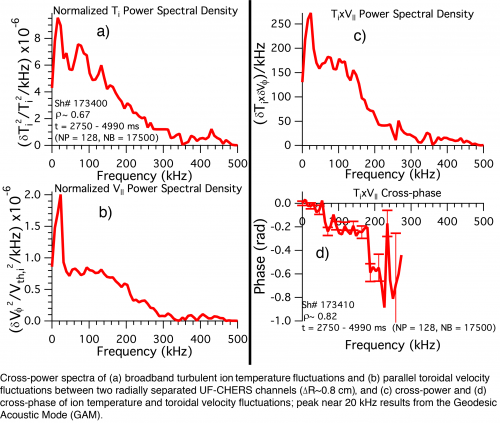 Ion temperature and toroidal rotation velocity fluctuation measurements have been obtained on DIII-D with the Ultra-Fast Charge Exchange Recombination Spectroscopy (UF-CHERS) diagnostic, as described in a recent Review of Scientific Instruments paper, https://doi.org/10.1063/5.0043095 by D. D. Truong et al., which complements an Invited Talk at the 2020 High-Temperature Plasma Diagnostics Conference. The paper describes multiple upgrades to the UF-CHERS diagnostic and optimization of the data analysis procedures that have enabled ion temperature and parallel velocity fluctuation measurements arising from turbulence in DIII-D. Time-averaged UF-CHERS measurements show good agreement with CER. Ensemble averaging during steady plasma conditions (~1-2 sec) provides sufficient signal-to-noise ratio and reveals ion temperature and parallel velocity spectra with broadband fluctuations from 0 to ~300 kHz and the Geodesic Acoustic Mode near 20 kHz. The cross-phase between ion temperature and parallel velocity fluctuations was also measured and provides an important constraint for validating gyrokinetic simulations.
Ion temperature and toroidal rotation velocity fluctuation measurements have been obtained on DIII-D with the Ultra-Fast Charge Exchange Recombination Spectroscopy (UF-CHERS) diagnostic, as described in a recent Review of Scientific Instruments paper, https://doi.org/10.1063/5.0043095 by D. D. Truong et al., which complements an Invited Talk at the 2020 High-Temperature Plasma Diagnostics Conference. The paper describes multiple upgrades to the UF-CHERS diagnostic and optimization of the data analysis procedures that have enabled ion temperature and parallel velocity fluctuation measurements arising from turbulence in DIII-D. Time-averaged UF-CHERS measurements show good agreement with CER. Ensemble averaging during steady plasma conditions (~1-2 sec) provides sufficient signal-to-noise ratio and reveals ion temperature and parallel velocity spectra with broadband fluctuations from 0 to ~300 kHz and the Geodesic Acoustic Mode near 20 kHz. The cross-phase between ion temperature and parallel velocity fluctuations was also measured and provides an important constraint for validating gyrokinetic simulations.
 The paper “Physics basis for design of 3D coils in tokamaks” by N.C. Logan et al. recently published in Nuclear Fusion (https://doi.org/10.1088/1741-4326/abff05) has shown that the use of stellarator tools in designing non-axisymmetric tokamak coils can greatly enhance the efficiency of these coils for rotation and stability control. The paper details how advancements in the physics understanding of exactly what non-axisymmetric or “3D” fields have the largest impact on tokamak plasmas (assisted by DIII-D experimental discovery and validation) has enabled targeting these fields directly with appropriately shaped coil sets. This type of problem is what the stellarator community has been solving for decades, and the tokamak community can now greatly benefit from the advanced optimization schemes originally developed for stellarator coil designs. The result of this new physics basis and cross-cutting optimization work is that these 3D coils can be built further away from the plasma, relaxing the cost and complexity of such systems in reactors. Closer to home, this physics basis is being used to assess future coil upgrades on DIII-D itself.
The paper “Physics basis for design of 3D coils in tokamaks” by N.C. Logan et al. recently published in Nuclear Fusion (https://doi.org/10.1088/1741-4326/abff05) has shown that the use of stellarator tools in designing non-axisymmetric tokamak coils can greatly enhance the efficiency of these coils for rotation and stability control. The paper details how advancements in the physics understanding of exactly what non-axisymmetric or “3D” fields have the largest impact on tokamak plasmas (assisted by DIII-D experimental discovery and validation) has enabled targeting these fields directly with appropriately shaped coil sets. This type of problem is what the stellarator community has been solving for decades, and the tokamak community can now greatly benefit from the advanced optimization schemes originally developed for stellarator coil designs. The result of this new physics basis and cross-cutting optimization work is that these 3D coils can be built further away from the plasma, relaxing the cost and complexity of such systems in reactors. Closer to home, this physics basis is being used to assess future coil upgrades on DIII-D itself.
FY21-Q4:
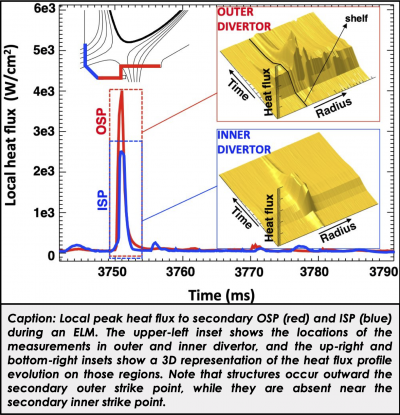 The paper “ELM and inter-ELM heat and particle flux to a secondary divertor in the DIII-D tokamak” by R. Perillo et. al., has been published in Nuclear Fusion (https://doi.org/10.1088/1741-4326/ac0f38). It is shown that the ELM heat flux to the secondary divertor can be up to 1/3 of the total ELM heat flux (primary + secondary divertors), which would result in several tens of MW/m^2 on the upper tiles of the ITER vessel. It is experimentally demonstrated for the first time that, when the distance between the primary and secondary separatrices at the outboard midplane (dRsep) is less than 10mm, significant ELM heat flux is deposited to the secondary inner target, with peak heat flux values that are comparable to those at the secondary outer strike point. This poses a concern for any future tokamak where the secondary inner target is not yet designed to withstand significant heat loads. The ELM heat flux profiles measured at the secondary outer region feature rippled sub-structures and extend into the far-SOL, while at the inner target they are discrete and well defined. It is found that values of dRsep above 25-30mm are needed to reduce the ELM heat flux to the secondary divertor below 10% of the total ELM heat flux deposited to a single-null configuration, implying that the up-down magnetic balance will have to be accurately controlled in order to preserve the plasma facing components at the secondary X-point region in future machines.
The paper “ELM and inter-ELM heat and particle flux to a secondary divertor in the DIII-D tokamak” by R. Perillo et. al., has been published in Nuclear Fusion (https://doi.org/10.1088/1741-4326/ac0f38). It is shown that the ELM heat flux to the secondary divertor can be up to 1/3 of the total ELM heat flux (primary + secondary divertors), which would result in several tens of MW/m^2 on the upper tiles of the ITER vessel. It is experimentally demonstrated for the first time that, when the distance between the primary and secondary separatrices at the outboard midplane (dRsep) is less than 10mm, significant ELM heat flux is deposited to the secondary inner target, with peak heat flux values that are comparable to those at the secondary outer strike point. This poses a concern for any future tokamak where the secondary inner target is not yet designed to withstand significant heat loads. The ELM heat flux profiles measured at the secondary outer region feature rippled sub-structures and extend into the far-SOL, while at the inner target they are discrete and well defined. It is found that values of dRsep above 25-30mm are needed to reduce the ELM heat flux to the secondary divertor below 10% of the total ELM heat flux deposited to a single-null configuration, implying that the up-down magnetic balance will have to be accurately controlled in order to preserve the plasma facing components at the secondary X-point region in future machines.
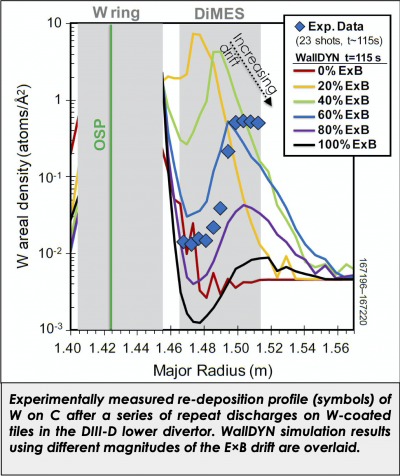 Since most reactor plasma facing component (PFC) designs call for mixed-material environments, including ITER's W/Be environment, developing an understanding of how reconstituted surfaces evolve under plasma bombardment is essential. The paper “Modeling of ExB effects on tungsten re-deposition and transport in the DIII-D divertor” by J. Nichols et al. was recently published in Nuclear Fusion (https://doi.org/10.1088/1741-4326/ac14e6). This work identifies controlling physics that affects material migration patterns in the diverter during an experiment from the DIII-D Metal Rings Campaign in which repeat L-mode discharges were conducted on the W-coated divertor tiles. These simulations indicate that radial and poloidal ExB transport dominates over parallel force balance for high-Z impurities such as W in the divertor region of DIII-D. Time-dependent simulations with scaled ExB impurity drifts and W re-erosion quantitatively reproduced experimentally measured features, including depth-resolved W/C ratios, within a factor of 2 over ~115 seconds of accumulated plasma exposure. The location of co-deposition regions was also shown to be well-represented by an analytic leakage model, driven largely by poloidal ExB drifts.
Since most reactor plasma facing component (PFC) designs call for mixed-material environments, including ITER's W/Be environment, developing an understanding of how reconstituted surfaces evolve under plasma bombardment is essential. The paper “Modeling of ExB effects on tungsten re-deposition and transport in the DIII-D divertor” by J. Nichols et al. was recently published in Nuclear Fusion (https://doi.org/10.1088/1741-4326/ac14e6). This work identifies controlling physics that affects material migration patterns in the diverter during an experiment from the DIII-D Metal Rings Campaign in which repeat L-mode discharges were conducted on the W-coated divertor tiles. These simulations indicate that radial and poloidal ExB transport dominates over parallel force balance for high-Z impurities such as W in the divertor region of DIII-D. Time-dependent simulations with scaled ExB impurity drifts and W re-erosion quantitatively reproduced experimentally measured features, including depth-resolved W/C ratios, within a factor of 2 over ~115 seconds of accumulated plasma exposure. The location of co-deposition regions was also shown to be well-represented by an analytic leakage model, driven largely by poloidal ExB drifts.
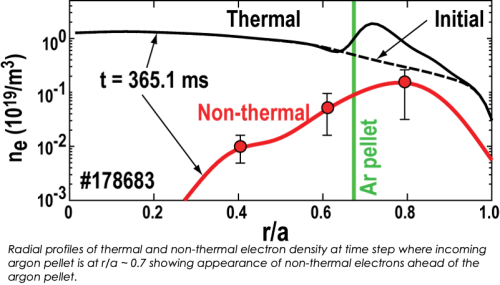 The paper “Estimate of pre-thermal quench non-thermal electron density profile during Ar pellet shutdowns of low-density target plasmas in DIII-D” by E. Hollmann et al. has been published in Physics of Plasmas (https://doi.org/10.1063/5.0050903). The paper describes first efforts to reconstruct the radial profile of early-time non-thermal electron seeds during disruptions in DIII-D. During disruptions, the thermal temperature collapses due to a combination of radial transport to the wall and impurity radiation. In regions where impurity radiation dominates, non-thermal electron populations can form due to the hot-tail mechanism, where electrons are abandoned at the tail of the distribution function as the bulk of the distribution function cools. These multi-keV non-thermal seeds can subsequently be accelerated to MeV energies during the subsequent toroidal current decay. Observing these early non-thermal seeds is extremely challenging, but has been accomplished in some low-density target plasmas shut down with Ar pellet injection. By combining SXR profiles with ECE profiles, estimates of the non-thermal electron profiles could be made. Interestingly, the non-thermal electrons are observed to appear ahead of the Ar pellet radially; it is not clear yet if this is due to extremely rapid cross-field heat transport or extremely fast cross-field argon ion transport.
The paper “Estimate of pre-thermal quench non-thermal electron density profile during Ar pellet shutdowns of low-density target plasmas in DIII-D” by E. Hollmann et al. has been published in Physics of Plasmas (https://doi.org/10.1063/5.0050903). The paper describes first efforts to reconstruct the radial profile of early-time non-thermal electron seeds during disruptions in DIII-D. During disruptions, the thermal temperature collapses due to a combination of radial transport to the wall and impurity radiation. In regions where impurity radiation dominates, non-thermal electron populations can form due to the hot-tail mechanism, where electrons are abandoned at the tail of the distribution function as the bulk of the distribution function cools. These multi-keV non-thermal seeds can subsequently be accelerated to MeV energies during the subsequent toroidal current decay. Observing these early non-thermal seeds is extremely challenging, but has been accomplished in some low-density target plasmas shut down with Ar pellet injection. By combining SXR profiles with ECE profiles, estimates of the non-thermal electron profiles could be made. Interestingly, the non-thermal electrons are observed to appear ahead of the Ar pellet radially; it is not clear yet if this is due to extremely rapid cross-field heat transport or extremely fast cross-field argon ion transport.
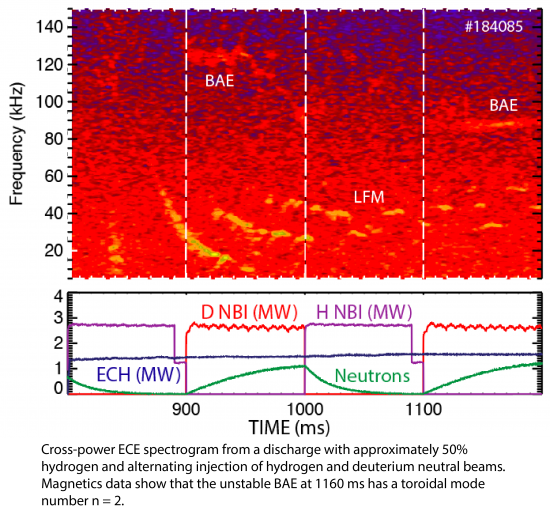 A study on the isotope dependence of beta-induced Alfven eigenmode (BAE) and low frequency mode (LFM) stability in DIII-D was published in Nuclear Fusion, https://doi.org/10.1088/1741-4326/ac189d. With deuterium neutral beam injection (NBI), BAEs are at least as unstable in mixed-species plasmas as in deuterium plasmas; however, with hydrogen NBI, the BAEs are stable. In contrast, the LFMs are unaffected by changes in beam species, consistent with the previous observation that LFMs are not driven by high-energy beam ions. As predicted by theory and simulation, the LFMs are more unstable in mixed species plasmas than in pure deuterium plasmas.
A study on the isotope dependence of beta-induced Alfven eigenmode (BAE) and low frequency mode (LFM) stability in DIII-D was published in Nuclear Fusion, https://doi.org/10.1088/1741-4326/ac189d. With deuterium neutral beam injection (NBI), BAEs are at least as unstable in mixed-species plasmas as in deuterium plasmas; however, with hydrogen NBI, the BAEs are stable. In contrast, the LFMs are unaffected by changes in beam species, consistent with the previous observation that LFMs are not driven by high-energy beam ions. As predicted by theory and simulation, the LFMs are more unstable in mixed species plasmas than in pure deuterium plasmas.
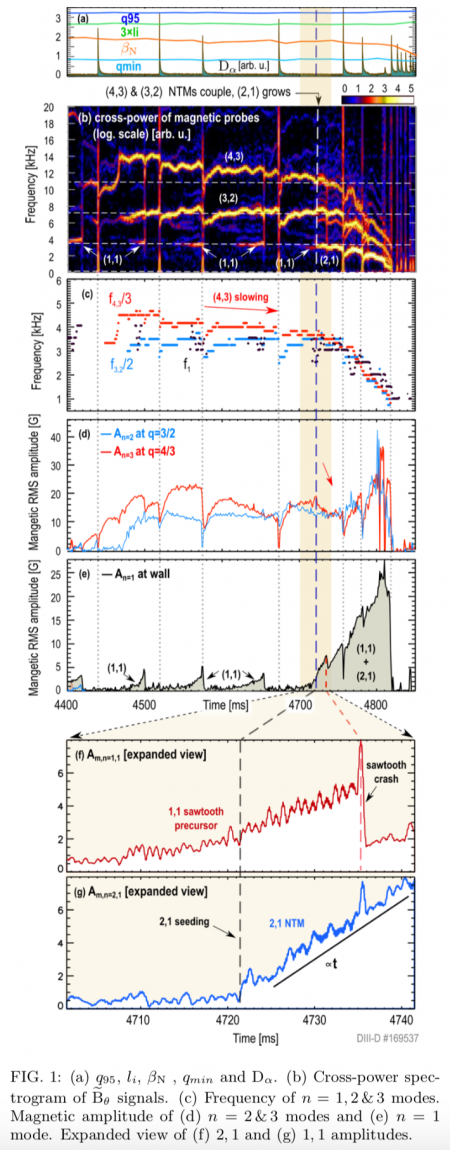 The Letter “Neoclassical Tearing Mode Seeding by Nonlinear Three-Wave Interactions in Tokamaks” by Laszlo Bardoczi at al has been published in Physical Review Letters (https://doi.org/10.1103/PhysRevLett.127.055002). The Letter reports the first experimental observation of seed magnetic island formation by nonlinear three-wave coupling of magnetic island triplets. In these DIII-D ITER baseline scenario plasmas, disruptive 2,1 islands are seeded by coupling of 4,3 and 3,2 islands to a central 1,1 sawtooth precursor. These plasmas reach the beta and current flattop, and are robustly stable to classical tearing modes. A number of ELMs and sawtooth crashes undergo without seeding the 2,1 island in the absence of non-linear three-wave coupling. Seeding occurs when high m,n islands couple, at various times in the stationary plasma. Therefore, these observations clarify that magnetic reconnection at q=2 is not caused by a classical current driven instability, but the 2,1 NTM seed island is formed by frequency matching and nonlinearly interacting islands that satisfy the mode number resonance condition. Three-wave interactions are conclusively identified with bi-spectral analysis, indicating fixed phase relationships at the time of 2,1 seeding. These results are general and relevant for future reactors, as 70% of the considered unstable DIII-D ITER baseline scenario discharges of the past decade without ECCD are characterized by frequency matching of resonant tearing modes at the time of 2,1 island seeding. This mechanism is also a candidate to account for TM cascades which has remained unexplained since it's first observation in 1989 by E. J. Strait et al [62(11) 1282 PRL]. As the non-linear three-wave interaction produces seed 2,1 islands in classically stable plasmas, tearing free operation may not be possible by locking in a classically stable current profile. This predicts new challenges for future reactors that must operate in stable plasma equilibria free of disruptive 2,1 islands, calling for high differential rotation at q=2, active control, suppression and avoidance of high m,n modes as much as possible.
The Letter “Neoclassical Tearing Mode Seeding by Nonlinear Three-Wave Interactions in Tokamaks” by Laszlo Bardoczi at al has been published in Physical Review Letters (https://doi.org/10.1103/PhysRevLett.127.055002). The Letter reports the first experimental observation of seed magnetic island formation by nonlinear three-wave coupling of magnetic island triplets. In these DIII-D ITER baseline scenario plasmas, disruptive 2,1 islands are seeded by coupling of 4,3 and 3,2 islands to a central 1,1 sawtooth precursor. These plasmas reach the beta and current flattop, and are robustly stable to classical tearing modes. A number of ELMs and sawtooth crashes undergo without seeding the 2,1 island in the absence of non-linear three-wave coupling. Seeding occurs when high m,n islands couple, at various times in the stationary plasma. Therefore, these observations clarify that magnetic reconnection at q=2 is not caused by a classical current driven instability, but the 2,1 NTM seed island is formed by frequency matching and nonlinearly interacting islands that satisfy the mode number resonance condition. Three-wave interactions are conclusively identified with bi-spectral analysis, indicating fixed phase relationships at the time of 2,1 seeding. These results are general and relevant for future reactors, as 70% of the considered unstable DIII-D ITER baseline scenario discharges of the past decade without ECCD are characterized by frequency matching of resonant tearing modes at the time of 2,1 island seeding. This mechanism is also a candidate to account for TM cascades which has remained unexplained since it's first observation in 1989 by E. J. Strait et al [62(11) 1282 PRL]. As the non-linear three-wave interaction produces seed 2,1 islands in classically stable plasmas, tearing free operation may not be possible by locking in a classically stable current profile. This predicts new challenges for future reactors that must operate in stable plasma equilibria free of disruptive 2,1 islands, calling for high differential rotation at q=2, active control, suppression and avoidance of high m,n modes as much as possible.
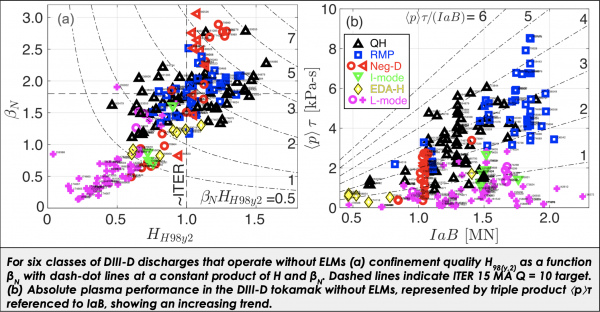 A grand challenge for the tokamak approach to fusion energy production is the achievement of a high-performance fusion core integrated with a boundary solution compatible with available first-wall materials. A key issue at this interface is the edge-localized mode (ELM), an instability arising from edge gradients which if uncontrolled delivers an impulsive heat and particle load to the first-wall. A recently published topical review paper “Plasma performance and operational space without ELMs in DIII-D” by C. Paz-Soldan (https://doi.org/10.1088/1361-6587/ac048b) compares the operating space and plasma performance of the stationary no-ELM regimes found in conventional tokamaks through a database study. Normalized performance in DIII-D favores regimes tolerant to power, and peak absolute performance is found to rise with the product of field, current, and radius. The highest absolute performance is found for RMP-ELM suppressed plasmas, but only at high torque and with low pedestal pressure fraction. The highest pedestal pressure fraction is found for QH-mode and EDA-H-mode regimes, though with higher carbon fraction. The normalized performance of negative triangularity (Neg-D) plasmas is comparable to RMP and QH-mode plasmas, though the absolute performance still lags. Considering integration with electron heating, the high pedestal pressure fraction regimes (QH and EDA-H) preserve the highest performance. Considering divertor integration, only the EDA-H, Neg-D, and L-mode scenarios have approached divertor-friendly high separatrix density conditions, with Neg-D preserving the highest performance owing to its compatibility with both high power and density in DIII-D.
A grand challenge for the tokamak approach to fusion energy production is the achievement of a high-performance fusion core integrated with a boundary solution compatible with available first-wall materials. A key issue at this interface is the edge-localized mode (ELM), an instability arising from edge gradients which if uncontrolled delivers an impulsive heat and particle load to the first-wall. A recently published topical review paper “Plasma performance and operational space without ELMs in DIII-D” by C. Paz-Soldan (https://doi.org/10.1088/1361-6587/ac048b) compares the operating space and plasma performance of the stationary no-ELM regimes found in conventional tokamaks through a database study. Normalized performance in DIII-D favores regimes tolerant to power, and peak absolute performance is found to rise with the product of field, current, and radius. The highest absolute performance is found for RMP-ELM suppressed plasmas, but only at high torque and with low pedestal pressure fraction. The highest pedestal pressure fraction is found for QH-mode and EDA-H-mode regimes, though with higher carbon fraction. The normalized performance of negative triangularity (Neg-D) plasmas is comparable to RMP and QH-mode plasmas, though the absolute performance still lags. Considering integration with electron heating, the high pedestal pressure fraction regimes (QH and EDA-H) preserve the highest performance. Considering divertor integration, only the EDA-H, Neg-D, and L-mode scenarios have approached divertor-friendly high separatrix density conditions, with Neg-D preserving the highest performance owing to its compatibility with both high power and density in DIII-D.
- A paper titled “Spectrally resolved polarization angle across the motional Stark effect spectrum,” by B. S. Victor et al. has been published in Review of Scientific Instruments (https://aip.scitation.org/doi/full/10.1063/5.0040543). This paper presents novel wavelength-dependent polarization angle measurements of the MSE spectrum after it passes through different collection optics systems. This helps identify if the optics preserve the polarization state, or distort it, leading to systematic errors in the inferred magnetic pitch angle. The measurements show nearly ideal “polarization response” in systems that do not use mirrors. Measurements on a system with the best custom polarization-preserving mirror available show it still introduces a polarization dependent phase shift to the incoming light, resulting in an anomalous ~8 degree variation with wavelength across the MSE spectrum on individual view chords, and significant systematic error.
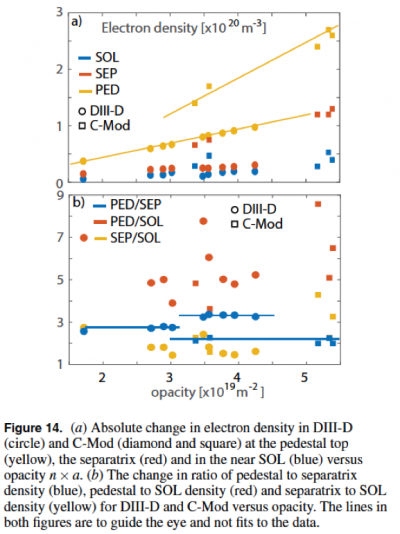 The paper “Overview of density pedestal structure: role of fueling versus transport” by S. Mordijck was published in Nuclear Fusion (https://doi.org/10.1088/1741-4326/ab8d04). This paper presents a review of physics affecting the pedestal density structure. Evidence from existing machines shows that both fuelling and transport changes can modify the density pedestal. However, due to lack of measurements of the particle source, particle transport is not sufficiently understood to determine if an inward pinch exists. Thus, it is not possible to predict the density pedestal structure in future machines, such as ITER, due to high plasma densities which will screen the pedestal from neutral fuelling. The paper also discusses experiments on DIII-D and C-Mod which were performed to increase pedestal neutral opaqueness na, (product of density and minor radius) toward values expected on ITER. The data sets from the two machines spanned an opaqueness range from 10× to 2× smaller than ITER with DIII-D operating at the smaller values of na and C-Mod at the values closer to ITER. For both devices, the pedestal density increased over the full range of opaqueness whereas the ratio of pedestal to separatrix densities remained constant. These results are consistent with profile measurements showing no significant change of density gradient with opaqueness.
The paper “Overview of density pedestal structure: role of fueling versus transport” by S. Mordijck was published in Nuclear Fusion (https://doi.org/10.1088/1741-4326/ab8d04). This paper presents a review of physics affecting the pedestal density structure. Evidence from existing machines shows that both fuelling and transport changes can modify the density pedestal. However, due to lack of measurements of the particle source, particle transport is not sufficiently understood to determine if an inward pinch exists. Thus, it is not possible to predict the density pedestal structure in future machines, such as ITER, due to high plasma densities which will screen the pedestal from neutral fuelling. The paper also discusses experiments on DIII-D and C-Mod which were performed to increase pedestal neutral opaqueness na, (product of density and minor radius) toward values expected on ITER. The data sets from the two machines spanned an opaqueness range from 10× to 2× smaller than ITER with DIII-D operating at the smaller values of na and C-Mod at the values closer to ITER. For both devices, the pedestal density increased over the full range of opaqueness whereas the ratio of pedestal to separatrix densities remained constant. These results are consistent with profile measurements showing no significant change of density gradient with opaqueness.
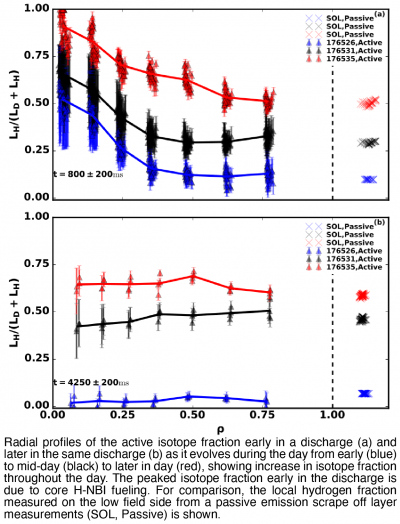 The paper “Radially resolved active charge exchange measurements of the hydrogenic isotope fraction on DIII-D” by S. R. Haskey et al. has been published in the Review of Scientific Instruments (https://doi.org/10.1063/5.0043836). The paper describes how radially resolved hydrogenic isotope fraction measurement capabilities using the main-ion CER (MICER) spectroscopy system were developed for the recent mixed H/D experiments in the DIII-D isotope thrust. The technique is based on the active (neutral beam on) charge exchange Hα and Dα brightness, which provides a profile of the isotope fraction of the ions from the core to the region approaching the separatrix. Extensive atomic physics calculations were performed using FIDASIM to better understand the relationship between the brightness and the underlying ion densities. These results demonstrate that for the same plasma parameters, the Dα emission is 20%–30% brighter than Hα due to differences in rate coefficients associated with the different ion thermal velocities for the same temperature. These details must be taken into consideration when calculating absolute densities.
The paper “Radially resolved active charge exchange measurements of the hydrogenic isotope fraction on DIII-D” by S. R. Haskey et al. has been published in the Review of Scientific Instruments (https://doi.org/10.1063/5.0043836). The paper describes how radially resolved hydrogenic isotope fraction measurement capabilities using the main-ion CER (MICER) spectroscopy system were developed for the recent mixed H/D experiments in the DIII-D isotope thrust. The technique is based on the active (neutral beam on) charge exchange Hα and Dα brightness, which provides a profile of the isotope fraction of the ions from the core to the region approaching the separatrix. Extensive atomic physics calculations were performed using FIDASIM to better understand the relationship between the brightness and the underlying ion densities. These results demonstrate that for the same plasma parameters, the Dα emission is 20%–30% brighter than Hα due to differences in rate coefficients associated with the different ion thermal velocities for the same temperature. These details must be taken into consideration when calculating absolute densities.
- The paper “Real-time estimation and control of divertor surface heat flux on the DIII-D tokamak” by H. Anand et al. has been published in Fusion Engineering and Design (https://doi.org/10.1016/j.fusengdes.2021.112560). A new system has been developed at DIII-D that estimates and controls in real-time the peak heat flux density on the divertor plasma-facing components. The system utilizes the estimation of the peak power flux density from a model-based approach and the recently developed divertor flux expansion controller. The publication reports the implementation and first experimental results of the application during the 2019-2020 DIII-D plasma campaign. Discussion on the validation of the model-based approach with the off-line infra-red measurements and closed-loop simulation with GSevolve code for the determination of the control parameters of the flux expansion controller are also presented. The newly developed system offers the possibility of surface heat flux control on a faster timescale in comparison to impurity seeding that primarily relies on the slow response of the gas valves for detachment control in future tokamak reactors.
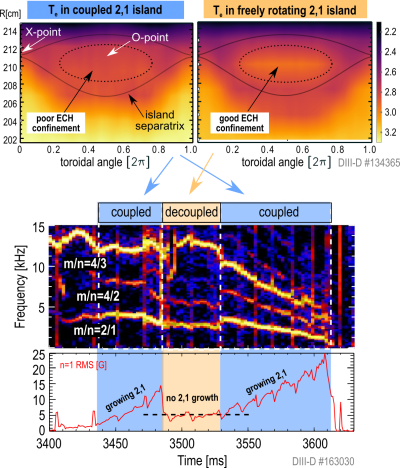 The Letter “Experimental inference of flux tunneling between magnetic island chains in tokamaks” by Laszlo Bardoczi and Todd E. Evans has been published in Nuclear Fusion (https://doi.org/10.1088/1741-4326/ac0411). The Letter reports confinement bifurcations due to flux tunneling in 2,1 islands, triggered by coupling of non-overlapping adjacent 5,2 islands. While subject to ECCD, the temperature at the 2,1 O-point is flat in the coupled phase but a temperature peak forms at the 2,1 island O-point after decoupling. This change in the EC wave energy confinement within the 2,1 island O-point region is shown to be due to a bifurcation from stochastic to nested 2,1 magnetic island topology, caused by flux tunneling through intersecting manifolds of overlapping heteroclinic tangles. The effect of the ECCD on the 2,1 island is shown to correlate with coupling events to a 4,3 island in an ITER baseline scenario plasma: (i) ECCD can not stabilize coupled islands but (ii) it suppresses freely rotating islands to a small size. This shows the critical impact of flux tunneling on disruption avoidance in tokamaks.
The Letter “Experimental inference of flux tunneling between magnetic island chains in tokamaks” by Laszlo Bardoczi and Todd E. Evans has been published in Nuclear Fusion (https://doi.org/10.1088/1741-4326/ac0411). The Letter reports confinement bifurcations due to flux tunneling in 2,1 islands, triggered by coupling of non-overlapping adjacent 5,2 islands. While subject to ECCD, the temperature at the 2,1 O-point is flat in the coupled phase but a temperature peak forms at the 2,1 island O-point after decoupling. This change in the EC wave energy confinement within the 2,1 island O-point region is shown to be due to a bifurcation from stochastic to nested 2,1 magnetic island topology, caused by flux tunneling through intersecting manifolds of overlapping heteroclinic tangles. The effect of the ECCD on the 2,1 island is shown to correlate with coupling events to a 4,3 island in an ITER baseline scenario plasma: (i) ECCD can not stabilize coupled islands but (ii) it suppresses freely rotating islands to a small size. This shows the critical impact of flux tunneling on disruption avoidance in tokamaks.
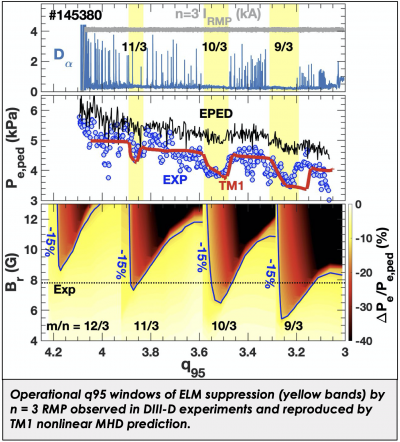 A quantitative understanding of RMP ELM suppression is essential for predicting robust ELM suppression in ITER. The recent paper “Predicting operational windows of ELMs suppression by Resonant Magnetic Perturbations in the DIII-D and KSTAR tokamaks” by Q. Hu, et. al. published in Physics of Plasmas as a featured article (https://doi.org/10.1063/5.0043018) reports a newly developed plasma response model quantitatively predicted the narrow isolated q95 windows of ELM suppression by n = 1, 2 and 3 resonant magnetic perturbations (RMPs) in both DIII-D and KSTAR tokamaks across a wide range of plasma parameters. The paper reveals the key physics of close alignment of essential resonant q-surfaces and the location of the top of the pedestal prior to an ELM permits an applied RMP to produce field penetration due to the lower E×B rotation at the pedestal top rather than being screened and leads to very narrow q95 windows of ELM suppression. The model indicates that wide q95 windows of ELM suppression can be achieved at substantially higher pedestal pressure with less confinement degradation in DIII-D by operating at higher toroidal mode number (n = 4) RMPs. This can have significant implications for the operation of the ITER ELM control coils for maintaining high confinement together with ELM suppression.
A quantitative understanding of RMP ELM suppression is essential for predicting robust ELM suppression in ITER. The recent paper “Predicting operational windows of ELMs suppression by Resonant Magnetic Perturbations in the DIII-D and KSTAR tokamaks” by Q. Hu, et. al. published in Physics of Plasmas as a featured article (https://doi.org/10.1063/5.0043018) reports a newly developed plasma response model quantitatively predicted the narrow isolated q95 windows of ELM suppression by n = 1, 2 and 3 resonant magnetic perturbations (RMPs) in both DIII-D and KSTAR tokamaks across a wide range of plasma parameters. The paper reveals the key physics of close alignment of essential resonant q-surfaces and the location of the top of the pedestal prior to an ELM permits an applied RMP to produce field penetration due to the lower E×B rotation at the pedestal top rather than being screened and leads to very narrow q95 windows of ELM suppression. The model indicates that wide q95 windows of ELM suppression can be achieved at substantially higher pedestal pressure with less confinement degradation in DIII-D by operating at higher toroidal mode number (n = 4) RMPs. This can have significant implications for the operation of the ITER ELM control coils for maintaining high confinement together with ELM suppression.
- The paper “Stability of beta-induced Alfvén eigenmodes (BAE) in DIII-D” by W. Heidbrink et al. was published in Nuclear Fusion (https://doi.org/10.1088/1741-4326/abf953). BAEs are unstable when the minimum of the safety factor qmin is close to a rational number. The observed frequencies are close to analytic estimates. Unstable BAEs occur in bursts that chirp rapidly in frequency. The modes are driven by high energy beam ions. As expected from the resonance condition, the stability of BAEs depends sensitively on the beam power and injection geometry. A database of over 1000 beam-heated discharges shows that BAEs are more likely to be unstable when the poloidal beta exceeds 0.5.
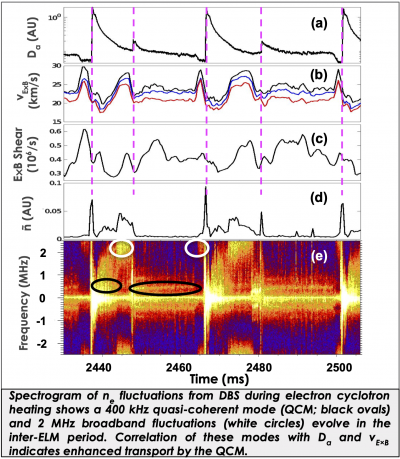 The paper “Evolution of ELMs, pedestal profiles and fluctuations in the inter-ELM period in NBI- and ECH-dominated discharges in DIII-D” by S. Banerjee et. al. has been published in Nuclear Fusion (https://doi.org/10.1088/1741-4326/abe8b1). In this paper, characterization of how the H-mode pedestal and fluctuations evolve between repeated edge oscillations called edge-localized modes (ELMs) provides insight into the nature of pedestal transport and path towards the ELM trigger in ITER similar shape plasmas. As the fraction of heat transported through the electron is increased relative to the ions, fluctuation measurements reveal distinct modes that appear, which correlate with the evolution of the electron temperature gradient. Transport coefficients obtained from TRANSP show that MTM and/or TEM are plausible candidates for the observed fluctuations. Linear gyrofluid simulations with TGLF corroborate this characterization. When the electron temperature gradient is increased and the modes are present, the frequency of ELMs decreases by 40% with inter-ELM spacing becoming more regular. This reduction in ELM frequency is attributed to the increased fluctuations during electron heating, causing an increase in fluctuation-driven transport in the pedestal and slowing the pedestal recovery between ELMs.
The paper “Evolution of ELMs, pedestal profiles and fluctuations in the inter-ELM period in NBI- and ECH-dominated discharges in DIII-D” by S. Banerjee et. al. has been published in Nuclear Fusion (https://doi.org/10.1088/1741-4326/abe8b1). In this paper, characterization of how the H-mode pedestal and fluctuations evolve between repeated edge oscillations called edge-localized modes (ELMs) provides insight into the nature of pedestal transport and path towards the ELM trigger in ITER similar shape plasmas. As the fraction of heat transported through the electron is increased relative to the ions, fluctuation measurements reveal distinct modes that appear, which correlate with the evolution of the electron temperature gradient. Transport coefficients obtained from TRANSP show that MTM and/or TEM are plausible candidates for the observed fluctuations. Linear gyrofluid simulations with TGLF corroborate this characterization. When the electron temperature gradient is increased and the modes are present, the frequency of ELMs decreases by 40% with inter-ELM spacing becoming more regular. This reduction in ELM frequency is attributed to the increased fluctuations during electron heating, causing an increase in fluctuation-driven transport in the pedestal and slowing the pedestal recovery between ELMs.
FY21-Q3:
- The paper “Resistive contributions to the stability of DIII-D ITER baseline demonstration discharges” by J. Hanson et al. has been published in Physics of Plasmas (https://doi.org/10.1063/5.0039272). Measurements of the plasma response to applied n=1 perturbations from DIII-D ITER baseline scenario (IBS) demonstration discharges exhibit increasing amplitude prior to disruption inducing mode locking events. Simulations reveal that changes in ideal and resistive stability impact the response in the DIII-D IBS regime, well below the pressure limit of the external kink mode. The dependencies of the response measurements on the plasma normalized internal inductance and beta are qualitatively consistent with ideal MHD, although in most cases the amplitude of the measurements exceeds predictions, indicating that the experimental discharges are less stable than expected. Resistive MHD simulations of the response show improved compatibility with the measurements, and the closest agreement is obtained by including the experimental plasma rotation in the simulations. Although the input neutral beam torque is near zero, the simulations show that the corresponding level of rotation can lead to nearly complete screening of the pitch-resonant field component at the q=2 surface. However, the simulation results exhibit a significant weakening of this screening effect at the lowest rotation levels in the dataset, concurrent with predictions of elevated response amplitudes that are consistent with measurements. These comparisons with DIII-D data provide a qualitative validation of a linear, resistive MHD response model.
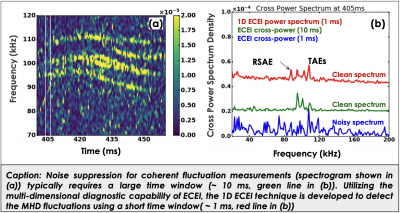 The paper “Noise suppression for MHD characterization with Electron Cyclotron Emission Imaging 1D technique” by G. Yu et al. has been published in Plasma Physics and Controlled Fusion (https://doi.org/10.1088/1361-6587/abe9f2). The paper introduces a data processing technique on ECE-imaging that significantly improves the spectrum quality and avoids biased fitting of the radial structure for coherent MHDs, such as Alfven Eigenmode and Tearing Mode. The technique is particularly useful for transient (~1 ms) coherent modes, as the noise could not be suppressed by a long data length (>10 ms). ECE Radiation modeling shows that the radial resolution of the technique is limited by the finite radiation volume effect and the non-uniform gain of the RF receiver. A narrower bandwidth (<~100 MHz) RF receiver can improve the ECEI capability resolving islands of half-width < 1.5 cm.
The paper “Noise suppression for MHD characterization with Electron Cyclotron Emission Imaging 1D technique” by G. Yu et al. has been published in Plasma Physics and Controlled Fusion (https://doi.org/10.1088/1361-6587/abe9f2). The paper introduces a data processing technique on ECE-imaging that significantly improves the spectrum quality and avoids biased fitting of the radial structure for coherent MHDs, such as Alfven Eigenmode and Tearing Mode. The technique is particularly useful for transient (~1 ms) coherent modes, as the noise could not be suppressed by a long data length (>10 ms). ECE Radiation modeling shows that the radial resolution of the technique is limited by the finite radiation volume effect and the non-uniform gain of the RF receiver. A narrower bandwidth (<~100 MHz) RF receiver can improve the ECEI capability resolving islands of half-width < 1.5 cm.
- The paper “An analysis of controlled detachment by seeding various impurity species in high performance scenarios on DIII-D and EAST” by D. Eldon, et al. was published in Nuclear Materials and Energy (https://doi.org/10.1016/j.nme.2021.100963). The detachment control systems can follow targets set for Jsat/Jroll (DIII-D) or reach a range of divertor Te values by moderating gas seeding rates in realtime, where Jsat/Jroll is ion saturation current density normalized to its peak value at “Jsat rollover”, which the PCS identifies. Using feedback control to achieve detachment avoids excess gas puffing or impurity seeding; the controller should only add what is needed to reach the target Jsat/Jroll or Te. These controls are deployed in the high betap scenario on both DIII-D and EAST, where an internal transport barrier can compensate for degradation of the pedestal by impurity seeding. The result is detached plasmas with healthy core performance: H98 and betap in detachment are comparable to the attached phase of the shot, reaching H98≈1.5, betap≈2.3 (DIII-D) or H98≈1.1, betap≈1.5 (EAST).
- Absolutely calibrated, spatially resolved hydrogen Lyman-α brightness measurements enable quantitative determination of the neutral density and ionization profile for comparison to modeling in studies of divertor neutral leakage, main chamber fueling, and radial particle transport. Design, implementation and calibration of the LLAMA diagnostic, through collaboration between MIT PSFC and PPPL, was recently published in two Review of Scientific Instruments articles. The paper ‘A 1D Lyman-alpha profile camera for plasma edge neutral studies on the DIII-D tokamak’ by Ph.D. student A. M. Rosenthal, et al. (https://doi.org/10.1063/5.0024115) describes the LLAMA diagnostic setup and initial results. LLAMA consists of two pinhole cameras. Each camera is equipped with a narrow band Bragg mirror, a bandpass interference filter, and an absolute extreme ultraviolet photodiode detector array to measure the hydrogen Lyman-α brightness in the toroidal direction on the inboard and outboard side of DIII-D. The advantages of Lyman-α filter spectroscopy are the utilization of a bright, isolated line with low parasitic surface reflections. The paper ‘Absolute calibration of the Lyman-α measurement apparatus at DIII-D’ by F. M. Laggner , et al. (https://doi.org/10.1063/5.0038134) introduces a calibration setup and procedure that uses an ex situ vacuum enclosure, which is equipped with an absolutely calibrated Lyman-α source. Nominal and measured calibration factors agree before installation of the device on DIII-D and the calibration procedure will be regularly repeated to re-calibrate the LLAMA during DIII-D vents to monitor possible degradation of optical components and detectors. LLAMA is regularly operating in the ongoing DIII-D campaign and as a passive diagnostic provides non-perturbative measurements on many discharges.
- The paper “Testing predictions of electron scale turbulent pedestal transport in two DIII-D ELMy H-modes” by Walter Guttenfelder et al. has been published in Nuclear Fusion (https://doi.org/10.1088/1741-4326/abecc7). Linear and nonlinear gyrokinetic (CGYRO) simulations in the pedestal region of two discharges that employ open and closed divertor configurations find electron temperature profiles to be just above the electron temperature gradient (ETG) instability thresholds. Nonlinear simulations predict electron heat fluxes from ETG turbulence accounts for 30-60% of the total experimental heat flux, while neoclassical (NEO) electron particle flux is found to contribute non-negligibly to the experimental fluxes inferred from SOLPS-ITER analysis. Based on the nonlinear simulations, a pedestal-specific ETG transport model is developed for use within predictive transport modeling. Profile predictions indicate that ETG (and neoclassical) transport alone are incapable of reproducing the electron density and temperature profiles, and an additional transport mechanism with relatively small ratio of particle to thermal diffusivity is likely required.
- The paper “Response of thermal and fast-ion transport to beam ion population, rotation and Te/Ti in the DIII-D Steady State Hybrid Scenario” by K. E. Thome et al. has been published in Nuclear Fusion (https://doi.org/10.1088/1741-4326/abd862). The thermal and fast-ion transport properties of DIII-D steady-state hybrid discharges are studied at lower injected torque and an increased electron to ion temperature ratio. Changing the injected torque/rotation appears to be a stronger driver of turbulence than increasing Te/Ti; and despite increases in both low and high-k turbulence at increased Te/Ti there was no change in performance observed experimentally. Decreasing the fast-ion transport resulted in higher ion heating and consequently higher core ion temperatures. Thermal and fast-ion transport changes in the DIII-D hybrid scenario as torque/rotation and Te/Ti are varied indicate possible methods for transferring this scenario to a reactor.
- The paper “Prospects for Disruption Handling in a Tokamak-Based Fusion Reactor” by N.W. Eidietis has been published in Fusion Science and Technology (https://doi.org/10.1080/15361055.2021.1889919). A commercial tokamak-based reactor places demands upon its disruption handling system far beyond those of the ITER tokamak. The mission of a commercial reactor, which requires high duty factor and reliability over several decades in order to recoup capital investment and gain acceptance as a baseline electrical producer, places an overwhelming focus upon disruption prevention, in particular regulated passive stability to avoid instabilities and actives stabilization of instabilities that do occur, as any unscheduled shutdown threatens that mission. However, the extreme environment within a commercial reactor environment poses numerous challenges to disruption free operation, including a lack of reliable diagnostics and diagnostic access, limited actuators, a highly self-organized plasma, and a requirement for hardware reliability order of magnitude more stringent than contemporary tokamaks or even ITER. Avenues to address these challenges are discussed. In addition, the long lifetime requirement of a commercial tokamak reactor renders it sensitive to low-probability, high impact disruption events, motivating investment in passively resilient design.
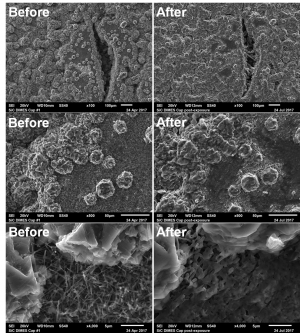 The article “Evaluation of silicon carbide as a divertor armor material in DIII-D H-mode discharges” by T. Abrams et al. has been published in Nuclear Fusion (https://doi.org/10.1088/1741-4326/abecee). This paper describes an analytic mixed-material SiC erosion model that uses calculated physical and chemical sputtering yields from SiC, Si, and C. The model was tested using DIII-D DiMES experiments involving graphite-coated SiC samples exposed at the strike-point to repeated H-mode plasma discharges. The qualitative trends from analytic modeling were reproduced by the experimental measurements, obtained via spectroscopic inference using the S/XB method. Post-mortem compositional analysis of the SiC-DiMES samples reveals Si enrichment of about 10%, in line with expectations from the erosion model. Encouragingly, minimal changes to the macroscopic or microscopic surface morphology of the SiC coatings were observed.
The article “Evaluation of silicon carbide as a divertor armor material in DIII-D H-mode discharges” by T. Abrams et al. has been published in Nuclear Fusion (https://doi.org/10.1088/1741-4326/abecee). This paper describes an analytic mixed-material SiC erosion model that uses calculated physical and chemical sputtering yields from SiC, Si, and C. The model was tested using DIII-D DiMES experiments involving graphite-coated SiC samples exposed at the strike-point to repeated H-mode plasma discharges. The qualitative trends from analytic modeling were reproduced by the experimental measurements, obtained via spectroscopic inference using the S/XB method. Post-mortem compositional analysis of the SiC-DiMES samples reveals Si enrichment of about 10%, in line with expectations from the erosion model. Encouragingly, minimal changes to the macroscopic or microscopic surface morphology of the SiC coatings were observed.
Figure caption: Scanning Electron Microscope (SEM) images of the silicon carbide sample in the DIII-D tokamak before and after intense plasma exposure, at progressively higher magnification levels
- One of the key challenges facing the economical operation of fusion reactors is to sustain a high-temperature high-pressure plasma with sufficient confinement time while preventing damage to the plasma facing components. The recent paper “Integration of full divertor detachment with improved core confinement for tokamak fusion plasmas” by L. Wang et. al. has been published in Nature Communications (https://doi.org/10.1038/s41467-021-21645-y) showing promising progress towards resolving this issue. Excellent compatibility between full divertor detachment and high-performance core (βN ~ 3, βp > 2, H98 ~ 1.5) associated with a sustained core internal transport barrier (ITB) and an H-mode edge transport barrier (ETB) has been demonstrated in DIII-D. The high-poloidal beta high-confinement scenario facilitates divertor detachment which, in turn, promotes the development of an even stronger ITB at large radius with a weaker ETB. This self-organized synergy between ITB and ETB leads to a net gain in energy confinement, in contrast to the net confinement loss typically caused by divertor detachment in standard H-modes.
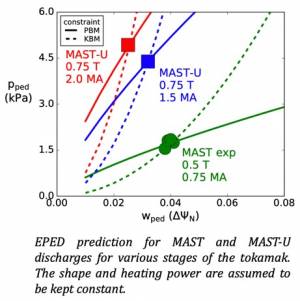 In preparation for the upcoming MAST-U campaign, pedestal stability of spherical tokamaks has been revisited by a team of DIII-D and MAST-U researchers by investigating standard H-mode discharges on MAST. The results summarized in the paper “Pedestal stability analysis on MAST in preparation for MAST-U” by M. Knolker et. al. have been published in Nuclear Fusion (https://iopscience.iop.org/article/10.1088/1741-4326/abe804). As a step beyond previous studies, both ion and electron profiles are used for obtaining equilibria and a diverse set of pedestals is evaluated. Stability analysis with the ELITE and CGYRO codes shows that MAST pedestals are constrained by kinetic ballooning modes and medium toroidal mode number peeling-ballooning modes, with most unstable modes ranging from n=25 to n=45. In discharges with a steep q profile at the edge a larger number of poloidal harmonics is excited for each toroidal mode. A comparison with discharges on DIII-D with matched shape and similar non-dimensional parameters indicates that the increased shear at lower aspect ratio stabilizes low n peeling modes.
In preparation for the upcoming MAST-U campaign, pedestal stability of spherical tokamaks has been revisited by a team of DIII-D and MAST-U researchers by investigating standard H-mode discharges on MAST. The results summarized in the paper “Pedestal stability analysis on MAST in preparation for MAST-U” by M. Knolker et. al. have been published in Nuclear Fusion (https://iopscience.iop.org/article/10.1088/1741-4326/abe804). As a step beyond previous studies, both ion and electron profiles are used for obtaining equilibria and a diverse set of pedestals is evaluated. Stability analysis with the ELITE and CGYRO codes shows that MAST pedestals are constrained by kinetic ballooning modes and medium toroidal mode number peeling-ballooning modes, with most unstable modes ranging from n=25 to n=45. In discharges with a steep q profile at the edge a larger number of poloidal harmonics is excited for each toroidal mode. A comparison with discharges on DIII-D with matched shape and similar non-dimensional parameters indicates that the increased shear at lower aspect ratio stabilizes low n peeling modes.
- Experiments on the DIII-D tokamak have expanded the operational limits of wide pedestal quiescent H-mode plasmas towards increased ITER relevance by simultaneously demonstrating well-matched plasma shape and net zero injected torque. The recently published Nuclear Fusion paper “Impact of shape on pedestal characteristics in the wide pedestal quiescent H-mode in the DIII-D tokamak” (https://doi.org/10.1088/1741-4326/abd641) by Theresa Wilks, et. al. reports the key results. Compared to the double null (DN) shape, the lower single null (LSN) ITER-like shape is observed to have a lower density, narrower pedestal width, larger density fluctuations over a broad range of wavenumber, and operates closer to the peeling-ballooning (PB) instability boundary calculated from a simple pedestal scaling (pressure height ~ ¾ power of pressure width), and is still observed to be wider than the EPED prediction. The lower triangularity in the LSN configuration makes the pedestal more susceptible to PB constraints, and therefore edge harmonic oscillation (EHO) or ELM onset, as compared to the balanced DN. The narrower pedestal is associated with smaller dRsep values and larger E × B shearing rates. Confinement extrapolations suggest that this regime is compatible with the shaping, low rotation, and available power for access in ITER.
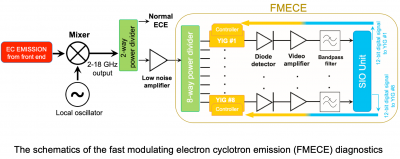 The paper “Fast modulating electron cyclotron emission (FMECE) diagnostic for tokamaks” by Saeid Houshmandyar et al. (The University of Texas at Austin) has been published in Review of Scientific Instruments (https://doi.org/10.1063/5.0043761). This paper presents the design and development of FMECE, a stand-alone IF section with eight channels, which is a novel application of YIG filters for real-time electron temperature gradient and gradient scale lengths measurements. Implementation and testing of FMECE at DIII-D tokamak, demonstrates its capability in real-time gradient measurements. The data presented in the paper shows that FMECE can identify flattening in the Te-profile; the latter can be used as a sensor for real-time monitoring and control of plasma instabilities. Implementation and application are planned for the EAST tokamak.
The paper “Fast modulating electron cyclotron emission (FMECE) diagnostic for tokamaks” by Saeid Houshmandyar et al. (The University of Texas at Austin) has been published in Review of Scientific Instruments (https://doi.org/10.1063/5.0043761). This paper presents the design and development of FMECE, a stand-alone IF section with eight channels, which is a novel application of YIG filters for real-time electron temperature gradient and gradient scale lengths measurements. Implementation and testing of FMECE at DIII-D tokamak, demonstrates its capability in real-time gradient measurements. The data presented in the paper shows that FMECE can identify flattening in the Te-profile; the latter can be used as a sensor for real-time monitoring and control of plasma instabilities. Implementation and application are planned for the EAST tokamak.
ECE diagnostics provide high spatial and temporal resolution for Te measurements in tokamaks via fixed-frequency channels. Fast modulating electron cyclotron emission (FMECE) is an innovative approach in which variable frequency channels would provide real-time gradient measurements, as well as channels relocation during a discharge. The fast response feature of FMECE is suitable for real-time monitoring and control of plasma instabilities.
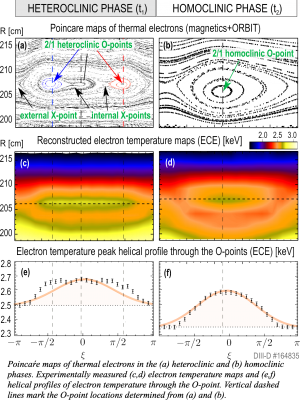 The paper “Experimental Observation of Magnetic Island Heteroclinic Bifurcation in Tokamaks” by L. Bardoczi and T. E. Evans was published in Physical Review Letters (https://doi.org/10.1103/PhysRevLett.126.085003). In this new class of magnetic island bifurcations, the second harmonic perturbation grows to a large amplitude causing the number of O-points and X-points of the primary island to double. For example, a 2,1 island's O-points and X-points can double due to a large apparent 4,2 mode. The new O-line is disconnected from the original one, hence called heteroclinic. This bifurcation is observed for the first time in interacting coupled 2,1 tearing modes in DIII-D (see figure). Poincaré maps constrained by measured magnetic amplitudes and phasing show bifurcation from heteroclinic to homoclinic topology in the 2,1 island as the 4,2 relative amplitude decreases. In agreement with external magnetic data, the local electron temperature peak in the 2,1 island splits initially, consistent with two O-points. As the 4,2 relative amplitude decreases a single Te peak forms in the 2,1 island, consistent with one O-point. Heteroclinic island stabilization by ECCD is expected to be significantly harder and strong 4,2 components are common in DIII-D ITER baseline scenario discharges with unstable 2,1 islands. These observations call for developing tearing stability theory and control solutions for heteroclinic islands in tokamaks.
The paper “Experimental Observation of Magnetic Island Heteroclinic Bifurcation in Tokamaks” by L. Bardoczi and T. E. Evans was published in Physical Review Letters (https://doi.org/10.1103/PhysRevLett.126.085003). In this new class of magnetic island bifurcations, the second harmonic perturbation grows to a large amplitude causing the number of O-points and X-points of the primary island to double. For example, a 2,1 island's O-points and X-points can double due to a large apparent 4,2 mode. The new O-line is disconnected from the original one, hence called heteroclinic. This bifurcation is observed for the first time in interacting coupled 2,1 tearing modes in DIII-D (see figure). Poincaré maps constrained by measured magnetic amplitudes and phasing show bifurcation from heteroclinic to homoclinic topology in the 2,1 island as the 4,2 relative amplitude decreases. In agreement with external magnetic data, the local electron temperature peak in the 2,1 island splits initially, consistent with two O-points. As the 4,2 relative amplitude decreases a single Te peak forms in the 2,1 island, consistent with one O-point. Heteroclinic island stabilization by ECCD is expected to be significantly harder and strong 4,2 components are common in DIII-D ITER baseline scenario discharges with unstable 2,1 islands. These observations call for developing tearing stability theory and control solutions for heteroclinic islands in tokamaks.
FY21-Q2:
- The paper “Pedestal magnetic turbulence measurements in ELMy H-mode DIII-D plasmas by Faraday-effect polarimetry” by J. Chen et. al. has been published in Physics of Plasmas (https://doi.org/10.1063/5.0039154). The paper shows how internal magnetic fluctuation measurements are utilized to identify turbulence associated with micro-tearing modes (MTM) in the DIII-D ELMy H-mode pedestal using a Faraday-effect polarimeter. Magnetic turbulence is directly observed and multiple fluctuation characteristics all serve to identify the mode as the MTM. The magnetic turbulence amplitude has a non-monotonic character with collision frequency, peaks off mid-plane, and correlates with electron temperature gradient evolution between ELMs, consistent with MTM features identified from theory and gyro-kinetic simulation. The magnetic turbulence growth correlates with confinement degradation in ELMy H-mode plasmas during a slow density ramp. These internal measurements provide unique constraints toward developing physics understanding and validating models of the H-mode pedestal for future devices.
- The paper “Model-based real-time surface heat flux and temperature estimation for the DIII-D tokamak” by H. Anand et al. has been published in Nuclear Fusion (https://dx.doi.org/10.1088/1741-4326/abd21c). A real-time control-oriented model for monitoring of wall power flux densities on the DIII-D tokamak has been successfully implemented and validated experimentally. The approach will play a critical role in future fusion reactors for monitoring and protection of the plasma-facing components. The paper reports on the experimental benchmarking against the infrared camera and Langmuir probe data of the model-based algorithm and the field line tracing environment, SMITER, developed at ITER organization on the inner wall limiter (IWL) of the DIII-D tokamak. It is planned to be used for regulating the power flux density on the DIII-D IWL with the help of impurity injection and also for protecting the high power Helicon antenna and HFS LHCD launcher.
- The paper “3D modeling of boron transport in DIII-D L-mode wall conditioning experiments” by F. Effenberg et al. was published in Nuclear Materials and Energy (https://doi.org/10.1016/j.nme.2021.100900). It reports on first-time full-torus modeling of boron transport with EMC3-EIRENE. The results show that local B injection causes a non-axisymmetric B distribution in the scrape-off layer (SOL) and the divertor. An impurity transport analysis reveals that the frictional flows are mostly responsible for coating the divertor plasma-facing components in the far SOL region. The discussion covers how the plasma density, radiative dissipation, and erosion affect the boron flux distribution.
- The article ”'BAAE' instabilities observed without any fast-ion drive” by W. Heidbrink et al. was published in Nuclear Fusion (https://doi.org/10.1088/1741-4326/abc4c3). The paper reports the surprising result that an instability that was previously identified as a fast-ion driven beta-induced Alfven-acoustic eigenmode (BAAE) is actually driven by the thermal plasma. The experimental low frequency mode (LFM) is unstable in plasmas with relatively high electron temperature, low beta, and qmin near rational values. Theoretical analysis suggests that the LFMs are a low frequency reactive instability of predominately Alfvénic polarization.
- The paper “On the stability and stationarity of the Super H-mode combined with an ion transport barrier in the core” by M. Knolker et. al has been accepted for publication in Plasma Physics and Controlled Fusion (https://doi.org/10.1088/1361-6587/abce18). The paper investigates contributions of rotation and pedestal to confinement in Super H-mode discharges with ion transport barriers. The analysis shows that both the improved pedestal height and rotational shear contribute to the high stored energy. At very low levels of rotation, the confinement factor for SH modes is still expected to exceed standard H-mode by 20-30 %. In addition, MHD stability of Super H-mode discharges is analyzed with a special focus on global MHD events. With their overall stationarity and high-performance levels, Super H-mode discharges are concluded to provide an attractive regime for ITER and may enable a more compact design of future fusion power plants.[26 Nov 2020]
- The paper “The Advanced Tokamak Path to a Compact Net Electric Fusion Pilot Plant,” by R. J Buttery et al. has been published in Nuclear Fusion (https://iopscience.iop.org/article/10.1088/1741-4326/abe4af). The article applies the principles of the advanced tokamak approach to develop a concept for a pilot plant that reduces required current, neutron and heat loads. This enables the device to be realized at reduced scale and cost relative to previous approaches, operating in steady state, with reduced risks from disruptions. This Compact AT (CAT) concept is based on a first of kind approach for reactor design, with core plasma optimization based on integrating state of the art physics modes for transport, pedestal, stability and current drive to yield fully self-consistent solutions. The inclusion of physics models in the projection yields key insights on the benefits of higher field, density, pressure and shape that lead to the high levels of confinement and stability that are essential for a compact power plant. They also lead to a concept that is self-sustaining, with very high in bootstrap current, reducing recirculating power, device stresses, and required fusion performance to make net electricity. The prospect of a lower risk steady state operation device is attractive but poses key challenges to develop the technologies and proof the plasma techniques required to make this exciting path to fusion energy viable.
- The paper “Observation of non-thermal electron formation during the thermal quench of shattered pellet injection shutdowns in DIII-D” by Hollmann et al. has been published in Nuclear Fusion (https://doi.org/10.1088/1741-4326/abc409). This paper shows that significant (several percent by electron density) super-thermal (energy of order 10 keV) electrons can form during the thermal quench of neon shattered pellet injection (SPI) shutdowns in DIII-D. These super-thermals appear to be formed by the hot tail mechanism as the thermal electron distribution collapses due to radiative cooling. The super-thermals can have the effect of increasing neon shard ablation rate and thus reducing the penetration of SPI neon shards onto the plasma core. Surprisingly, these super-thermals disappear during the current quench and do not form a significant runaway electron current; it is hypothesized that this may be due to strong radial electron loss to the wall during SPI shutdowns.
- The paper “Current profile and normalized beta control via feedback linearization and Lyapunov techniques” by A. Pajares et al, has been published in Nuclear Fusion (https://iopscience.iop.org/article/10.1088/1741-4326/abd09d). Simultaneous control of the current profile and normalized beta is an essential control problem in the development of advanced tokamak scenarios, but it is specially challenging due to the nonlinear dynamics of the current, heat, and particle transport dynamics, as well as the difficulty to understand and model such processes. By means of feedback linearization, the nonlinear current dynamics can be exactly linearized, retaining the physics content of the control model. This technique also allows for assessing the controllability of the current profile for different actuator configurations, determining how many spatial locations of the current profile can be independently controlled in practice. In this work, the DIII-D configuration using on-axis and off-axis NBIs together with ECH&CD have been analyzed. On the other hand, the use of Lyapunov techniques makes the control design robust against partially unknown dynamics in the electron temperature and density arising, for example, from unexpected MHD activity. Simulations using COTSIM (Control Oriented Transport SIMulator, a code developed by Lehigh University) are presented for a DIII-D high qmin scenario, and show the robustness of the controller against uncertainties in the plasma dynamics.
- The paper “Magnetic shear effect on plasma transport at Te/Ti~1 through electron cyclotron heating in DIII-D plasmas”, by M. Yoshida, G. McKee, C. Petty, B. Grierson, M. Nakata, C. Rost, T. Rhodes, D. Ernst, A. Garofalo (https://iopscience.iop.org/article/10.1088/1741-4326/abbfe7) has been published by Nuclear Fusion. Plasma confinement typically degrades as the electron to ion temperature ratio is increased towards unity, relevant for burning plasmas, from Te/Ti<1. Likewise, thermal, particle and momentum transport all increase. This confinement degradation with increasing Te/Ti was found to be significantly mitigated at weak and negative central magnetic shear on DIII-D in experiments using ECH to increase Te/Ti and early neutral beam heating to tailor the q-profile. Little change in global energy confinement is observed with increasing Te/Ti in weak and negative magnetic shear plasmas, and transport is observed to undergo little or no increase, consistent with local kinetic profile gradients and linear gyrokinetic analysis. These results suggest a benefit for burning plasma performance with advanced scenarios that utilize significant off-axis current drive that produce negative or weak central magnetic shear. These experiments were conducted as a collaboration between QST-Naka, Japan and the DIII-D program.
- The paper “An improved theory of the response of DIII-D H-mode discharges to static resonant magnetic perturbations and its implications for the suppression of edge localized modes” by R. Fitzpatrick and A. Nelson has been published in Physics of Plasmas (https://doi.org/10.1063/5.0011738). The plasma response of a typical DIII-D H-mode plasma to a resonant magnetic perturbation is modeled using a toroidal generalization of a previous cylindrical asymptotic matching model. Neutral penetration inside the last closed magnetic flux surface is found to have a significant influence on locked magnetic island chain formation at the bottom of the pedestal. Lock island formation at the top of the pedestal is found to be only possible when q_95 lies in certain narrow windows. [1 Jul, not DIII-D funded]
- The paper “Plasma flux expansion control on the DIII-D tokamak” by H. Anand et al. has been published in Plasma Physics and Controlled Fusion (https://dx.doi.org/10.1088/1361-6587/abc457). A new controller has been developed with help of the flexible divertor poloidal-field coil set of the DIII-D tokamak, to aid in the precise control of the poloidal flux expansion in the scrape-off layer. A non-linear free-boundary simulation code (GSevolve) is used for simulating the closed-loop response and for verifying the implementation of the control algorithm on the DIII-D plasma control system. First results of the experimental commissioning of the new controller during 2020 DIII-D campaign are presented. The controller design offers the possibility of supplementing gas as an actuator for detachment control and improving the response time in future tokamak reactors. The simplistic and robust controller design is being considered for providing reliable and independent control of flux expansion while having minimal effect on the other magnetic controlled variables in the MAST-U divertor geometry.
- The article “Reproduction of collector probe deposition profiles using the far-SOL impurity transport code 3DLIM” by S.A. Zamperini et al. was recently published in Nuclear Materials and Energy (https://doi.org/10.1016/j.nme.2020.100811). Tungsten deposition profiles measured on a Collector Probe (CP) located in the far-SOL near the outer midplane during W tracer experiments in DIII-D are well reproduced by the new Monte Carlo far-SOL impurity transport code 3DLIM. Radial deposition profiles are replicated showing the effect that a decrease in connection length from the CP to the nearest wall contact point has on impurity transport to the probe. For purely diffusive radial transport, a diffusion coefficient of 10 m2/s best reproduces deposition patterns on both sides of the CP, but for purely convective radial transport a speed of 125 m/s is shown to have better agreement with the inner-target-facing side of the W deposition profile. This provides important insight into SOL high-Z impurity transport physics that hitherto has been difficult to confirm experimentally. Because the high-Z impurity density in the edge is the boundary condition for impurity levels in the confined plasma, identifying the transport mechanisms for impurities in the SOL is crucial to optimize performance in ITER and other future devices.
- The paper “Estimation and exploratory regulation of confinement-time based plasma performance in the DIII-D tokamak experiment” by Olofsson et al. was published in the IEEE Control Technology and Applications Proceedings [https://doi.org/10.1109/CCTA41146.2020.9206299]. It details the design and implementation of a flexible nonlinear Kalman filter for the estimation of the confinement time in real time. Filter parameters are tuned using maximum likelihood. Control session experiments at DIII-D using the plasma current as actuator to regulate a fusion gain performance metric are reported.
FY21-Q1:
- The article “Modeling, analysis, and code/data validation of DIII-D tokamak divertor experiments on ELM and non-ELM plasma tungsten sputtering erosion” by J. Brooks et al. was published in Nuclear Fusion (https://dx.doi.org/10.1088/1741-4326/abb39c). This paper describes simulations of tungsten erosion/re-deposition conducted in high-density, unfavorable BT L-mode plasmas and direct benchmarking against DiMES experiments. Simulations of intra-ELM tungsten erosion/re-deposition on DIII-D were also performed and indicate near-unity re-deposition fractions. [14 Oct 2020]
- The paper “Optimizing the Super H-mode pedestal to improve performance and facilitate divertor integration” by M. Knolker et. al has been published in Physics of Plasmas (https://doi.org/10.1063/5.0011008). This paper demonstrates access to Super H-mode for moderately shaped plasmas, including in a reduced triangularity DIII-D shape that is accessible to the JET tokamak. Importantly, injection of nitrogen sufficient for the establishment of a radiative divertor is shown to be possible during Super H-mode without pedestal degradation. [8 Oct 2020]
- The paper “Advancing Fusion with Machine Learning Research Needs Workshop” by D. Humphreys et al. has been published in Journal of Fusion Energy ( https://doi.org/10.1007/s10894-020-00258-1). Machine learning and artificial intelligence (ML/AI) methods have been used successfully in recent years to solve problems in many areas, including image recognition, unsupervised and supervised classification, game-playing, system identification and prediction, and autonomous vehicle control. Data-driven machine learning methods have also been applied to fusion energy research for over two decades, including significant advances in the areas of disruption prediction, surrogate model generation, and experimental planning. The advent of powerful and dedicated computers specialized for large-scale parallel computation, as well as advances in statistical inference algorithms, have greatly enhanced the capabilities of these computational approaches to extract scientific knowledge and bridge gaps between theoretical models and practical implementations. Large-scale commercial success of various ML/AI applications in recent years, including robotics, industrial processes, online image recognition, financial system prediction, and autonomous vehicles, have further demonstrated the potential for data-driven methods to produce dramatic transformations in many fields. These advances, along with the urgency of need to bridge key gaps in knowledge for design and operation of reactors such as ITER, have driven planned expansion of efforts in ML/AI within the US government and around the world.
- The paper “The inter-ELM tungsten erosion profile in DIII-D H-mode discharges and benchmarking with ERO+OEDGE modeling” by T. Abrams et al. was one of 10 papers selected to the short list for the 2020 Nuclear Fusion Award (https://iopscience.iop.org/journal/0029-5515/page/2020-nuclear-fusion-award). Nominations for this award are based on citation record and recommendation by the Board of Editors. This paper describes the first spectroscopic investigations of tungsten erosion in DIII-D, as well as interpretive PMI modeling efforts to validate ion impact and high-Z sputtering models in the DIII-D divertor.
- The article “Observations of wall conditioning by means of boron powder injection in DIII D H-mode plasmas” by A. Bortolon has been accepted for publication in Nuclear Fusion (https://doi.org/10.1088/1741-4326/abaf31). The experimental results reported show that injection of modest quantities of boron powder in tokamak plasmas produces beneficial effects in terms of reduced wall fueling and impurities concentration. The effective growth of a boron-rich film on the divertor wall was confirmed through analysis of material samples exposed to plasmas with injection of isotopically enriched boron. This new wall conditioning technique can effectively complement the hazardous glow discharge boronization to extend the lifetime of the boron-rich films, without requiring interruption of machine operation. [28 Sep]
- The paper “Validation of the imaging neutral particle analyzer in nearly MHD quiescent plasmas using injected beam ions on DIII-D” by D. Lin et al has been published in Nuclear Fusion (https://doi.org/10.1088/1741-4326/ab8e10). The new imaging neutral particle analyzer (INPA) diagnostic is validated using beam ion distributions in nearly MHD-quiescent plasmas. Simulated signals from calculated TRANSP distributions agree with measured experimental images. Additionally, strong passive signals from edge fast ions, injected by the on-axis counter beam, are observed
- The paper “Resolving the fast ion distribution from imaging neutral particle analyzer measurements” by X. Du et al. has been published in Nuclear Fusion ( https://doi.org/10.1088/1741-4326/ab788f ). A recently developed imaging neutral particle analyzer (INPA) on the DIII-D tokamak enables fast ion velocity-space tomography of high fidelity at the interrogated phase space. Benefiting from heavy, localized velocity-space weights and excellent signal to noise, computed tomography using the Ridge regression method is able to successfully reconstruct fine-scale velocity-space structures produced by multiple neutral beams separated by as small as ~3 keV. Applying the inversion method to a sawtooth crash event reveals a significant profile flattening of confined passing particles across q = 1 flux surface, as well as a redistribution of fast ions into the trapped orbits at the plasma edge close to the last closed flux surface. [25 Aug]
- The paper “Dependence of the impurity transport on the dominant turbulent regime in ELM H-mode discharges on the DIII-D tokamak” by T. Odstrcil et al. has been published in Physics of Plasmas ( https://doi.org/10.1063/5.0010725 ). This paper presents a detailed study of aluminum and tungsten transport in NBI and ECH heated core of DIII-D plasma. Additional electron heating reversed turbulent convection from outward to inward and increased impurity diffusion outside of the ECH location by more than an order of magnitude when compared to NBI only heated case. The experimental results were contrasted with comprehensive non-linear and quasilinear gyrokinetic modeling. While transport in ECH heated plasma was reproduced by modeling, both magnitude and sign of impurity flux were mismatched in NBI heated plasma. [4 Aug]
- The paper “Cause and impact of low–frequency chirping modes in DIII–D hybrid discharges” by D. Liu et al. has been published in Nuclear Fusion(https://dx.doi.org/10.1088/1741-4326/ab868c). This paper compiled a database of hybrid discharges and examined why Alfvén eigenmodes are usually suppressed and replaced by low-frequency bursting modes when ECCD or ECH is applied. The database suggests that the change of the fast-ion pressure especially the perpendicular pressure is the main factor responsible for the instability transition although the transition in some discharges can also be explained by a slight drop of the safety factor, qmin. The paper also shows the low-frequency bursting modes are fishbones, and more often are chirping (neoclassical) tearing modes (i.e. the mode frequency firstly jumps up from the steady (N)TM frequency, then chirps down, and finally returns to the steady (N)TM frequency.) The resonance condition calculation and 'Kick' model simulations suggest that (N)TMs and fishbones can interact through modification of the fast ion distribution in phase space, which influences the drive. [26 Aug]
- The paper “Impact of rotation and ion diamagnetic drift on MHD stability at edge pedestal in quiescent H-mode plasmas” by N. Aiba et al. has been published in Nuclear Fusion (https://doi.org/10.1088/1741-4326/ab8c66). It was found the coupled rotation and ion diamagnetic drift effects can stabilize a kink/peeling mode in a quiescent H-mode (QH-mode) DIII-D plasma rotating in the direction counter to the plasma current, though the rotation alone destabilizes the mode. The stabilizing mechanism was identified as reduction of dynamic pressure destabilizing the mode due to the coupling between rotation and ion diamagnetic drift. The coupling can be harnessed to both stabilize and destabilize the kink/peeling mode by switching the rotation direction. This trend could be the reason that QH-mode plasmas in DIII-D favor toroidal rotation counter to the plasma current direction. [31 Jul]
- The paper “Towards validated MHD modeling of edge harmonic oscillation in DIII-D QH-mode discharges” by A. Pankin et al. has been published in Nuclear Fusion ( https://doi.org/10.1088/1741-4326/ab9afe). The extended-MHD NIMROD code is used to simulate the dynamics of an edge harmonic oscillation (EHO) in quiescent H-mode (QH-mode) DIII-D discharge 163 518. EHOs observed in non-linear MHD simulations have n = 1 and n = 2 as dominant modes akin the DIII-D experiment. The experimental equilibrium is modified to include two levels of instability drive by increasing the experimental pressure gradient. In order to do a more direct comparison of the simulation results with the experiment, a synthetic BES diagnostic is used to compute cross-correlation and cross-power spectral densities associated with the simulated density perturbations. It is shown that the amplitude of the experimental density perturbations is between the computed density perturbation amplitude for the two levels of instability drive. The synthetic cross-power spectral density shows a transition from a double to a single peak in frequency when the BES analysis shifts from near the LCFS towards the steep gradient region of the pedestal similar to the experiment.
- The paper “Creation and sustainment of wide pedestal quiescent H-mode with zero net neutral beam torque” by K. Burrell et al. has been published in Nuclear Fusion (https://doi.org/10.1088/1741-4326/ab940d). Recent experiments on DIII-D have shown it is possible to create and sustain wide pedestal quiescent H-mode (QH-mode) plasmas with zero net torque from neutral beam injection (NBI) for the full discharge duration. Wide pedestal QH-mode has many of the features of the previously investigated QH-mode while having the advantage of increased edge pedestal pressure and excellent energy confinement time. Both QH-mode variants operate without edge localized modes. Accordingly, these discharges demonstrate that significant input torque is not essential to the exploitation of wide pedestal QH-mode in future devices that are expected to have small or non-existent NBI torque. Developing operating conditions that allowed net zero torque access to wide pedestal QH-mode required implementing several techniques to avoid locked modes including minimizing intrinsic error fields, avoiding large sawteeth, and driving toroidal rotation via neoclassical toroidal viscosity.
FY20-Q4:
- The paper “Experimental evidence of electron-cyclotron current drive-based neoclassical tearing mode suppression threshold reduction during mode locking on DIII-D” by A. Nelson et al. has been published in Plasma Physics and Controlled Fusion (https://doi.org/10.1088/1361-6587/ab9b3b). Since locking of neoclassical tearing modes (NTMs) is a known pathway towards disruptions in tokamaks, NTM control focuses heavily on the suppression of rotating modes before locking occurs. However, in plasmas near the LH threshold, mode locking can lead to a back-transition to L-mode that is accompanied by shifts in the plasma state that are beneficial to NTM suppression: reduced βp and reduced bootstrap current. By analyzing the repetitive locking-unlocking process of a large m/n = 2/1 NTM in DIII-D, it is shown that a back-transition to L-mode is responsible for an improved ability to suppress large NTMs. In cases with limited heating power, the enhanced ability to suppress locked modes in L-mode can widen the disruption avoidance window by providing more time to stabilize the mode.
- The review paper “Role of sheared E × B flow in self-organized, improved confinement states in magnetized plasmas” by K. Burrell has been published in Physics of Plasmas (https://doi.org/10.1063/1.5142734). This paper is an extensive review of the theoretical development and experimental testing of the process of turbulence decorrelation and stabilization by sheared E×B flow which shows that E×B shear effects are ubiquitous in magnetized plasmas. The confinement improvement due to sheared E×B flow is of considerable physical interest; it is not often that a system self-organizes to reduce transport when an additional source of free energy is applied to it. The transport decrease associated with E×B velocity shear is also of great practical benefit to fusion research, since it contributed to substantially increased fusion yield in all DT magnetic fusion experiments conducted to date. The same basic transport reduction process can be operational in various portions of the plasma because there are a number of ways to change the radial electric field Er. An important secondary theme in this area is the synergistic effect of E×B velocity shear and magnetic shear. Our present understanding in this area is the result of a multi-decade, intertwined effort in theory, modeling and diagnostic development combined with continuing experimental investigations. These experiments have clearly demonstrated that increased E×B shear causes reductions in turbulence and transport. The experimental results are generally consistent with the basic theoretical models although considerable work remains to be done before we have a fully predictive theory of transport in magnetized plasmas including E×B shear effects.
- A paper titled, “Impurity transport in the pedestal of H-mode plasmas with resonant magnetic perturbations,” by B. S. Victor et al. has been published in Plasma Physics and Controlled Fusion (https://dx.doi.org/10.1088/1361-6587/aba4bd). This paper presents experimental results from DIII-D showing that resonant magnetic perturbations (RMPs) reduce the impurity confinement time in the H-mode pedestal below that of naturally ELMy plasmas. STRAHL modeling of discharges with aluminum laser blow off injection show increased diffusion in the pedestal of H-mode discharges with RMPs. These results indicate that RMPs are beneficial for controlling the buildup of impurities in the pedestal region of the plasma.
- The letter “The motional Stark effect diagnostic reliably measures significant deviations in safety factor profile during DIII-D sawteeth” by W. Heidbrink and B. Victor has been published in Physics of Plasmas (https://doi.org/10.1063/5.0011135). The letter reexamines data from a discharge with large fast-ion stabilized sawteeth in light of recent controversies about the reliability of MSE data and theoretical assertions that appreciable changes in safety factor during the sawtooth cycle are unlikely. The analysis shows that the safety factor at the sawtooth crash changes by 0.15, much more than any likely random or systematic errors.
- The paper “Expanding the parameter space of the wide-pedestal QH-mode towards ITER conditions” by X. Chen et al. has been published in Nuclear Fusion (https://doi.org/10.1088/1741-4326/ab9fa5). Significant parameter space expansion of the wide-pedestal quiescent H-mode (QH-mode) towards more ITER and reactor relevant conditions has been achieved in the DIII-D tokamak. Recent experiments reveal this naturally ELM-free regime can operate over a range of neutral beam injected (NBI) torque spanning from the co- to counter-Ip direction, completely covering the scaled ITER-equivalent applied torque range, and extended to lower single null shaping matching ITER average triangularity. These recent advances make wide-pedestal QH-mode a stronger candidate for an ELM-free, high performance regime for ITER and future reactors.
- The paper “High precision strike point control to support experiments in the DIII-D small angle slot divertor” by D. Eldon has been published in Fusion Engineering and Design (https://doi.org/10.1016/j.fusengdes.2020.111797). It describes the upgrade of the DIII-D shape control to meet the needs of the SAS program and quantifies the strike point control performance.
- The paper “Nonlinear modeling of the scaling law for the m/n = 3/2 error field penetration threshold” by Q.M. Hu et al. has been published in Nuclear Fusion (https://doi.org/10.1088/1741-4326/ab8b79). The scaling of EF penetration threshold is modeled by using the nonlinear MHD code TM1 for both single-fluid and two-fluid simulations. The scaling from single-fluid simulations is similar to the analytical EF scaling, while the scaling law from two-fluid simulations shows significant difference depending on plasma parameters. This work highlights the importance of both electron temperature and two-fluid effects in EF scaling. The predicted EF threshold is lower than DIII-D, indicating the lower EF tolerance in ITER.
- A paper titled, “Real-time pedestal optimization and ELM control with 3D fields and gas flows on DIII-D,” by F. M. Laggner et al. has been published in Nucl. Fusion (https://doi.org/10.1088/1741-4326/ab88e1). Three new control schemes allowing pedestal optimization and ELM control by magnetic perturbations were implemented into the DIII-D plasma control system (PCS) and successfully deployed in experiments. Pedestal control using magnetic perturbations and gas puffs allows the exploration of core-edge integrated plasma scenarios in present-day tokamaks by decoupling of the pedestal top and the separatrix density. With respect to ITER, the need for an advanced control system is highlighted. To enable high fusion energy gain, while simultaneously suppressing ELMs, the magnetic perturbation amplitude has to remain close to the ELM suppression threshold at all times.
- The paper “Modeling ExB drift transport in conceptual slot divertor configurations” by E. Meier et al. was published in Contributions to Plasma Physics (https://doi.org/10.1002/ctpp.201900151). The paper examines SOLPS-ITER simulations of conceptual SAS 2 slot configurations. The focus of the analysis is on 𝐄 × 𝐁 drift effects on upstream density at detachment (UDD), defined as electron temperature 𝑇𝑒 ≤ 3 eV at the outer strike point (OSP). With toroidal field such that radial 𝐄 × 𝐁 drift carries particles from the OSP toward the private flux region (PFR), placing the OSP near the inner slot wall gives ≈ 20 % lower UDD than having the OSP near the outer wall. The inner wall effectively traps the radial 𝐄 × 𝐁 drift flux, resulting in low 𝑇𝑒 and associated radial electric field in the PFR, and thus small losses from the slot to the inner target via poloidal 𝐄 × 𝐁 drift flux. With toroidal field reversed such that radial 𝐄 × 𝐁 drift is reversed, OSP placement near the inner wall gives ≈ 10% lower UDD than OSP placement near the outer wall. Although radial 𝐄 × 𝐁 flux is from the OSP toward the outer wall, this flux largely escapes the slot, raising the UDD. A change in the slot shaping is suggested with the goal of eliminating such 𝐄 × 𝐁-driven particle losses from the slot.
- The paper “The role of edge resonant magnetic perturbations in edge–localized–mode suppression and density pump–out in low–collisionality DIII–D plasmas” by Q.M. Hu et al. has been published in Nuclear Fusion (https://doi.org/10.1088/1741-4326/ab8545). This work presented the understanding of ELM suppression and density pump-out caused by 3D fields observed in DIII-D tokamak based on nonlinear two-fluid MHD simulations using TM1 code. The TM1 simulations quantitatively explain the required plasma density, rotation and RMP amplitude for the ELMs suppression by n = 2 RMPs due to the formation of magnetic islands at the top of the pedestal. The observed density pump-out is reproduced from the MHD simulations for the penetration of resonant fields in the resistive foot of the pedestal.
- The paper “Tomography of the positive-pitch fast-ion velocity distribution in DIII-D plasmas with Alfvén eigenmodes and neoclassical tearing modes” by B. Madsen et al. has been published in Nuclear Fusion (https://doi.org/10.1088/1741-4326/ab82b5). The paper presents new tomographic inversion methods based on Tikhonov regularization used to reconstruct the fast-ion velocity distribution from FIDA measurements in DIII D plasmas. These are employed to study the effect of mode activity on the fast-ion velocity distribution at two radial positions. Reconstructed distributions are compared to kick model simulations with good qualitative agreement. Simulations reveal that predominantly low-frequency modes are responsible for the increased fast-ion transport in the central-most measurement volume, whereas TAEs and EAEs become important farther out.
- The paper “Collisionality driven turbulent particle transport changes in DIII-D H-mode plasmas” by S. Mordijck at al. has been published in Nuclear Fusion (https://doi.org/10.1088/1741-4326/ab81aa). This paper investigates the underlying physics causes in what determines the increase in density peaking with decreasing collisionality. We find that the increase in density peaking is linked to changes in turbulence and transport, not an increase in core fueling using neutral beams. We show the ratio of the inward particle pinch with respect to the outward diffusion coefficient increases at low collisionality, thus increasing the local density gradient. Quasi-linear gyro-kinetic simulations observes similar trends both in the changes in particle flux as well as turbulence characteristics.
- The paper “Effect of magnetic perturbations on turbulence-flow dynamics at the L-H transition on DIII-D” by D. M. Kriete et al. has been published in Physics of Plasmas (https://doi.org/10.1063/1.5145207) and was selected as an Editor's Pick this month. The paper shows how applied resonant and non-resonant magnetic perturbations alter turbulence and flows leading up to and across the L-H transition, offering an explanation for how RMPs raise the L-H power threshold. In the stationary L-mode state preceding the L-H transition, RMPs simultaneously reduce flow shear rates and raise turbulence decorrelation rates, disrupting the turbulence shear suppression mechanism. This implies more transient turbulence suppression is needed to trigger the L-H transition, which makes it more difficult to access H-mode and is consistent with the power threshold increase. On the ~100 microsecond timescale of the L-H transition, transient nonlinear energy transfer out of turbulence and into flows is reduced by an order of magnitude when RMPs are applied. This turbulence suppression mechanism, which does appear to trigger the L-H transition in plasmas without applied RMPs, is therefore turned off by RMPs, which may also contribute the power threshold increase.
FY20-Q3:
- The paper “Improved core-edge compatibility using impurity seeding in the small angle slot (SAS) divertor at DIII-D” by Livia Casali et al. has been published as a Featured Article in Physics of Plasmas (https://doi.org/10.1063/1.5144693). The paper presents the first impurity seeding studies in the small angle slot (SAS) divertor at DIII-D which revealed a strong relationship between the detachment onset and pedestal characteristics with both target geometry and impurity species. Nitrogen seeding in the slot has led to the first simultaneous observation of detachment on the entire suite of boundary diagnostics viewing the SAS without degradation of core confinement. SOLPS-ITER simulations with D+C+N, full cross field drifts, and n–n collisions activated are performed for the first time in DIII-D to interpret the behavior. Discharges with either nitrogen or neon injection show that while nitrogen does not significantly affect the pedestal, neon leads to increased pedestal pressure gradients and improved pedestal stability. This works demonstrates that divertor geometry combined with impurity seeding enables mitigated divertor heat flux balancing core contamination, thus leading to enhanced divertor dissipation and improved core-edge compatibility, which are essential for ITER and for future fusion reactors.
- The paper “Neutral leakage, power dissipation and pedestal fueling in open vs closed divertors” by L. Casali et al. has been published in Nuclear Fusion (https://iopscience.iop.org/article/10.1088/1741-4326/ab8d06). In this work, a metric for divertor closure in terms of the percentage of neutrals escaping the divertor is presented. Detachment at lower upstream density for the closed divertor is demonstrated quantitatively with the reduction of the convective term directly resulting in 40% decrease and the increased of the power loss contributing with a factor 2. It is demonstrated that divertor recycling is the primary fueling mechanism in DIII-D. In the region between the X-point and the outer midplane, the fueling is at least 4 times lower in the closed divertor due to the baffling structure which reduces upstream leakage. Due to the openness of the inner leg to the common flux and HFS regions, both open and closed divertor experience almost identical fueling at the HFS highlighting the need to also consider the inboard divertor for shape optimization.
- The paper “Runaway electron seed formation at reactor-relevant temperature” by C. Paz Soldan et al was recently published in Nuclear Fusion (https://doi.org/10.1088/1741-4326/ab7fe1). In this paper, systematic variation of the pre-disruption core electron temperature (Te) from 1 to 12 keV using an internal transport barrier scenario reveals a dramatic increase in the production of ‘seed’ runaway electrons (REs), ultimately accessing near-complete conversion of the pre-disruption current into sub-MeV RE current. Surprisingly, the thermal quench duration is observed to shorten as Te rises, and thus illustrates the limitations of treating the RE seed formation problem without considering the inter-related dependencies of the pellet ablation, radiative energy loss, and resultant variation of the thermal quench duration.
- The paper “SOLPS analysis of changes in the main SOL of DIII-D associated with divertor detachment vs attachment and closure vs openness” by C. Sang et al., has been published in Nuclear Fusion (https://doi.org/10.1088/1741-4326/ab7c29). Recent edge plasma code SOLPS modeling finds that the divertor shape and plasma state have significant influence on the SOL and pedestal plasma. (i) The inner divertor has a more significant effect on the high-field side (HFS) SOL than the outer divertor does on the low-field side (LFS) SOL, forming a high-density front in the high density discharge case. (ii) Divertor closure has a significant effect on the main SOL and pedestal plasma. The open divertor has higher core fueling than the closed divertor, while the closed divertor has better fuel and impurity neutral screening than the open divertor. (iii) The in/out asymmetry is also influenced by the divertor closure, increase of the closure of the outer divertor can substantially reduce the asymmetry. These results highlight the strong dependence of neutral/impurity screening and main SOL properties on divertor geometry and plasma regimes, which needs to be taken into account in advanced divertor design for fusion reactors.
- The paper “Runaway electron beam dynamics at low plasma density in DIII-D: energy distribution, current profile, and internal instability” by A. Lvovskiy et al., has been published in Nuclear Fusion (https://doi.org/10.1088/1741-4326/ab78c7). The paper presents experimental investigations of post-disruption runaway electron beam (RE) equilibrium and stability. In this study, the spatially-resolved RE energy distribution function is measured for the first time during the RE plateau regime using hard X-ray bremsstrahlung radiation. It is found to be non-monotonic with a bump at 5-6 MeV – which presents a source of free energy and suggests a possibility of kinetic instabilities driven via wave-particle resonance. Another important result is the reconstruction of the RE beam current profile. It is found to be more peaked than the pre-disruption plasma current, supporting existing models, but MHD stable at the baseline current of 180 kA, likely due to its elevated safety factor profile. This RE beam is deliberately destabilized by ramping up the current. It leads to an internal instability accompanied by a sawtooth-like relaxation of the RE current profile, but drives no observable RE loss. A proposed internal kink mode is supported by results of MARS-F modeling
- The paper “Setting the H-mode pedestal structure: variations of particle source location using gas puff and pellet fueling” by A. Nelson et al., has been published in Nuclear Fusion (https://doi.org/10.1088/1741-4326/ab5e65). The paper describes collaborative work with ORNL and PPPL in which a set of experiments was conducted to study the role that the neutral source location has on setting the structure of the H-mode pedestal. It was determined that pellets, which deposit neutrals near the pedestal top, are more efficient at fueling the plasma and can sustain higher and steeper pedestal pressures than gas puffing, which deposits neutrals primarily in the SOL. Further, due to increased penetration of cold neutrals into the hot core plasma, increased pellet fueling is linked to a decrease in the edge temperature gradient. MHD stability was unchanged between the two fueling sources, with ELM frequencies saturating near 300 kHz for both fueling sources.
- The paper “First evidence of local ExB drift in the divertor influencing the structure and stability of confined plasma near the edge of fusion devices” by H. Wang et al. was published in Physical Review Letters (https://doi.org/10.1103/PhysRevLett.124.195002). For the case of ion B x grad-B drift direction out of the divertor, the corresponding ExB drifts in the divertor result in a reversal of total poloidal flow above the divertor target plate, leading to a doubly peaked target density profile. The drifts couple this divertor profile upstream, resulting in a flattened upstream density profile or density ‘shelf in the scrape-off layer near the separatrix for low collisionality conditions. This flattening has beneficial aspects for MHD stability, resulting in small ELMs, and scales favorably with power.
- The Letter “Enhanced helium exhaust during edge-localized mode suppression by resonant magnetic perturbations at DIII-D” by E. Hinson, et al. has been published in Nuclear Fusion (https://doi.org/10.1088/1741-4326/ab7d50). Comparisons of discharges with suppression of ELMs by RMPs to the corresponding unperturbed ELMy discharges found that the effective helium confinement time and its ratio with the energy confinement time were both reduced by at least a factor of 2 after application of the RMPs. This reduction in 𝛕p*(He) during RMP ELM suppression was observed in the plasma core, edge, and pumping plenum, where higher neutral helium concentration during RMPs was also measured. These findings provide evidence that future devices employing RMP ELM suppression may meet or even exceed the helium exhaust provided by the ELMs themselves, reducing helium ash, and maintaining high fusion gain.
- The paper “Net versus gross erosion of silicon carbide in DIII-D divertor” (https://dx.doi.org/10.1088/1402-4896/ab61dc) by D. Rudakov et al has been published in the topical issue of Physica Scripta devoted to 2019 PFMC conference proceedings: Gross and net erosion rates of silicon from silicon carbide (SiC) coatings were measured in the divertor of DIII-D under well diagnosed L-mode plasma conditions using DiMES manipulator. From the net Si erosion rate measured by post-mortem Rutherford Backscattering, spectroscopic measurements, measured D+ion fluxes, and corrections from ERO-OEDGE modeling, effective SXB coefficient for the Si II 636 nm line of∼52 and Si sputtering yield of∼0.017 Si/D were calculated. Compared to previous DiMES measurements of net C erosion from pure carbon coatings at lower plasma density and comparable electron temperature, the effective reduction of the C erosion rate from SiC is about an order of magnitude.
- The paper “Impact of divertor material on neutral recycling and discharge fueling in DIII-D” (https://doi.org/10.1088/1402-4896/ab5a2e) based on W DiMES exposures and the 2016 Metal Rings Campaign was published in Physica Scripta. The probability of prompt D+ reflection from the divertor surface is material-dependent and was measured to be about 4 times higher on W than on C. This is expected to lead to a higher divertor neutral fueling when operating with a full-W divertor. Metal Rings experiments in DIII-D show that with the relatively small fractional coverage of W in the divertor indeed led to an increase of the L-mode edge density profile by 8%. In H-mode the profiles were significantly less sensitive to the presence of W.
- The paper “Separating divertor closure effects on divertor detachment and pedestal shape in DIII-D” by A. Moser et al. was published in Phys. Plasmas (https://doi.org/10.1063/1.5109027). The paper presents experimental measurements of detachment onset at a 40% lower pedestal density ne,ped in the closed upper divertor compared to the open lower divertor. This detachment behavior depends on the combination of two effects: first, increased dissipation in the closed divertor, which leads to a 25% lower separatrix density ne,sep at detachment, and second, reduced fueling of the pedestal in the closed case, which decreases the ne,ped/ne,sep ratio.
- The paper “Progress in DIII-D towards validating divertor power exhaust predictions” by A.E. Jaervinen was published in Nucl. Fusion (https://doi.org/10.1088/1741-4326/ab7f5c). This manuscript compares detailed UEDGE simulations with cross-field drifts to DIII-D H-mode detachment experiments with EUV/VUV divertor spectroscopy. These studies show that when simulated local plasma densities and temperatures are close to measurements obtained with the divertor Thomson scattering system, there is no shortfall of the emissivities of the dominant resonant radiating lines in the simulations. However, the simulations still fall short by about a factor of two from the experimentally measured total radiated power. The leading remaining hypothesis for the origin of this shortfall are underestimated spatial extent of the radiation front and radiation between the dominant lines, which will be investigated in forthcoming studies
FY20-Q2:
- The paper “Modeling ExB drift transport in conceptual slot divertor configurations” by E. Meier was published in Contrib. Plasma Physics (https://dx.doi.org/10.1002/ctpp.201900151). In this publication, SOLPS-ITER is used to model drift effects in a conceptual SAS 2 (small-angle slot) configuration. A key finding is that when the strike point is located near the outboard corner of the slot, with ion grad-B drift away from the divertor, the strike point temperature drops below 10 eV at a lower (by 25%) upstream density than with ion grad-B drift toward the divertor, qualitatively similar to experimental results with the existing SAS divertor on DIII-D.
- The paper “Role of 3D neoclassical particle flux in density pump-out during ELM control by RMP in DIII-D” by Y. Liu et al. has been published in Nucl. Fusion (https://doi.org/10.1088/1741-4326/ab6c35). This paper reports initial-value toroidal modeling of the density pump-out effect observed in DIII-D experiments during ELM suppression by RMP fields. The computational tool is the MARS-Q code, based on a quasi-linear model that self-consistently solves single fluid MHD equations together with the toroidal momentum and radial particle transport equations. The key finding is that the radial particle flux, associated with the 3D neoclassical toroidal viscosity (NTV), plays an important role in producing the observed large density pump-out in these DIII-D experiments. The NTV particle flux in turn is substantially enhanced due to drift kinetic Landau resonances between the toroidal precession of trapped thermal ions and electrons from one side, and the RMP field from the other side. These wave-particle resonances occur in the pedestal top region, where the ExB rotation frequency becomes small or even crosses zero during the ELM suppression.
- The paper “Enhanced particle flux due to localized divertor MHD instability in DIII-D tokamak” has been published in Physics of Plasmas and selected as an Editor’s pick (https://dx.doi.org/10.1063/1.5140354). This paper introduces an MHD mode with a fundamental frequency of <10 kHz near the inner strike point from various diagnostics. This MHD mode is associated with magnetic oscillations of ≳5 G, with toroidal mode number n = 1, but is localized radially to within several cm. It appears when the outer strike point remains attached and the inner strike point nearly detaches, grows with increasing density, and eventually weakens and vanishes as the outer strike point detaches. This mode results in high particle flux with an order of magnitude higher than the background plasmas near the inner strike point. These characteristics are consistent with the current-convective-instability theory prediction. Initial simulations based on experimental input have found oscillations with similar frequencies but weaker amplitudes.
- The letter “On the very high energy confinement observed in super H-mode DIII-D experiments” by S. Ding, et al. has been published in Nucl. Fusion (https://doi.org/10.1088/1741-4326/ab66db). Analysis of recent super H-mode experiments on DIII-D shows that high rotation, not high pedestal, plays the essential role in achieving very high confinement H98y2>1.5. Very high confinement is reached early on in the H-mode phase of these discharges, when the pedestal is still very low, but after the toroidal rotation has already built-up to very high levels in the core. As the discharge evolves, the rotation drops, and so does the energy confinement, despite a sustained very high-pressure pedestal. During this evolution, the confinement quality is linearly correlated with the core toroidal rotation, which varies according to different levels of injected neutral beam torque per particle. Core transport modeling shows that the contribution from rotation in the E × B shear is responsible for confinement quality significantly in excess of standard H-mode (H98y2~1).
- The paper “Predicting the Rotation Profile in ITER” by C. Chrystal, et al. has been published in Nuclear Fusion (https://doi.org/10.1088/1741-4326/ab6434). By combining empirical scaling for the intrinsic rotation at the top of the pedestal with the expected neutral beam torque and modeling of momentum transport, the toroidal rotation profile for ITER is predicted with TGYRO using TGLF (SAT0 and SAT1). On axis rotation exceeds 20 krad/s and the ExB shear is significant enough to reduce turbulent transport and significantly increase confinement and fusion power when compared to cases that ignore the effect of rotation. The prediction of the rotation at the top of the pedestal is made with increased confidence due to experiments and modeling in DIII-D that have determined the importance of fast-ion and neutral particle transport effects on intrinsic rotation at this location.
- The paper, “Shattered Pellet Penetration in Low and High Energy Plasmas on DIII-D,” by R. Raman et al was published in Nucl. Fusion (https://doi.org/10.1088/1741-4326/ab686f). In support of ITER needs, the depth of SPI fragment penetration in DIII-D plasmas was investigated by injecting SPI into two discharges with vastly different energy content and pedestal height. 400 Torr-L pure Ne fragmented pellets at a velocity of about 200 m/s were injected into a 0.2 MJ L-mode discharge and a 2 MJ super H-mode discharge. Results show deep penetration of SPI fragments into low-energy plasmas in DIII-D. SPI fragment penetration is reduced as the plasma energy content increases, with some discharges exhibiting penetration that is confined to the outer regions of the plasma. Studies such as these should provide the needed data for 3d MHD simulations, as reliable simulations (benchmarked against experimental results from present tokamaks) is the only way to reliably project to ITER plasmas.
- The paper “Role of Poloidal E×B Drift in Divertor Heat Transport in DIII-D” by A. Jaervinen et al. was published in Contributions to Plasma Physics (https://doi.org/10.1002/ctpp.201900111). UEDGE simulations for DIII-D H-mode plasmas indicate that the poloidal ExB drifts can dominate the poloidal heat transport in the divertor, challenging the paradigm of conduction-limited scrape-off layer (SOL) transport. These flows expand the poloidal volume of the divertor radiation front and increase total divertor dissipation, consistent with previous experimental observations at DIII-D. Due to these convective flows, a simple analytic 1D model based on the Lengyel integral, assuming conductive heat transport, underestimates the divertor radiation by a factor of 6 for these DIII-D plasmas. Therefore, a full 2D calculation with drifts is necessary to provide an adequate approximation of radiative divertor conditions for these plasmas
- The paper “Interaction of magnetic islands with turbulent electron temperature fluctuations in DIII-D and in GENE non-linear gyrokinetic simulations” (https://doi.org/10.1088/1361-6587/ab5c69) by L. Bardoczi et al. has been published in Nucl. Fusion. The paper reports Correlation Electron Cyclotron Emission measurements and GENE gyrokinectic simulations of electron temperature turbulence evolution in the presence of magnetic islands. When the tearing mode forms a narrow island, whose width is a few times the ion gyroradius, turbulence increases by 30% at q=m/n. This effect is replicated by GENE through zonal flow damping due to destroyed magnetic field topology of the q=m/n surface. When the island grows to a larger size and gradients become shallow in the O-point region, turbulent electron temperature fluctuations decrease inside the island in qualitative agreement with the simulations. Reduced turbulence in large islands offers an explanation for previously measured reduction of cross-field electron thermal diffusivity at the O-point region, which has a destabilizing effect on neoclassically driven tearing modes.
- The article “The dominant micro-turbulence instabilities in the lower q95 high betap plasmas on DIII-D and predict-first extrapolation” (https://iopscience.iop.org/article/10.1088/1741-4326/ab5152) by Siye Din, et al. has been published in Nucl. Fusion. Gyrokinetic simulations suggest that the remaining micro-instabilities in lower q95 (<7.0), high betap ITB plasmas are drift wave instabilities, including the collisionless trapped electron mode in the core and ITB peak gradient region, the electron temperature gradient mode in the ITB peak gradient region and at the ITB foot and the ion temperature gradient mode at the ITB foot. Gyrokinetic simulation results qualitatively agree with the density fluctuation analysis from beam emission spectroscopy, which suggests the existence of a low-k ion mode at the ITB foot. The gyrokinetic simulations also predict that a larger Shafranov shift can overwhelm the driving sources for turbulence from the profile gradients at higher betaN, leading to stronger turbulence suppression and stronger ITBs in lower q95, high betap plasmas.
- The paper “Gyrokinetic GENE simulations of DIII-D near-edge L-mode plasmas” by T. Neiser et al. has been published in Physics of Plasmas (https://doi.org/10.1063/1.5052047). This paper primarily presents a successful gyrokinetic validation exercise in the near-edge of a DIII-D plasma in low confinement mode (L-mode), pushing the validation frontier closer to the edge region. Secondary findings demonstrate that coupling between electron-scale and ion-scale turbulence was weaker than expected, which suggests that current heuristic rules for the relevance of multi-scale coupling are on the cautious side. This is helpful, because it could increase the realm of applicability of single-scale simulations, which are computationally more affordable than multi-scale simulations. Moreover, nonlinear simulations find a hybrid ion temperature gradient (ITG)/ trapped electron mode (TEM) scenario, which was not obvious from linear simulations due to the stability of ITG modes. This could also be an important result for spherical tokamaks, where ITG modes are more often linearly stable than in conventional tokamaks.
- The paper “Injection of multiple shattered pellets for disruption mitigation in DIII-D” by J. L. Herfindal et al. was published in Nucl. Fusion (https://doi.org/10.1088/1741-4326/ab3693). This paper describes results of plasma shutdown experiments that injected multiple shattered pellets at different toroidal locations for the first time, as is planned for the ITER disruption mitigation system. Systematically varying the relative timing of the two pellets suggests that simultaneously injected pellets may impact the assimilation of each other, altering the resulting disruption characteristics. Global disruption mitigation properties are found to decrease when the pellets enter the plasma simultaneously compared to single pure neon shattered pellet injections. The addition of two simultaneous shattered pellets shows that the initial poloidal radiation is spread out into two distinct regions, cooling multiple flux tubes simultaneously, which may induce global MHD instabilities more rapidly than a single flux tube of impurities, limiting the amount of neon assimilated.
- The paper “L–H transition trigger physics in ITER-similar plasmas with applied n = 3 magnetic perturbations” by L. Schmitz et al. has been published in Nucl. Fusion (https://doi.org/10.1088/1741-4326/ab36bf). This paper reports recent measurements of the L-H transition power threshold PLH in torque-free, ITER-similar DIII-D plasmas, when n=3 resonant magnetic perturbations (RMP) are applied prior to the L-H transition. PLH is found to increase at low collisionality as PLH / PLH-08 ~ nu*-0.5, where PLH-08 is the 2008 ITPA multi-machine threshold scaling. The threshold increase is ascribed to a significantly decreased (or reversed) L-mode edge electric field well and E×B shearing rate with applied RMP, and substantially increased edge density fluctuations. Increased edge toroidal co-rotation is observed with applied RMP. The Er and rotation changes are shown to be caused by radial electron currents due to edge magnetic stochasticity in the presence of resonant n=3 perturbations (compensated by viscosity-driven radial ion current), as described in a previous theoretical model. The modifications of edge rotation and radial electric field in the presence of n=3 RMP are consistent with an extended fluid model, which also explains the collisionality dependence of PLH. Non-resonant n=3 magnetic perturbations lead only to a minor reduction in the edge Er well, and have less impact on PLH.
FY20-Q1:
- The paper “Study of argon assimilation into the post-disruption runaway electron plateau in DIII-D and comparison with a 1D diffusion model” by E. Hollmann et al. has been published in Nuclear Fusion (https://doi.org/10.1088/1741-4326/ab32b2). In this paper, a study is made of assimilation of argon injected into runaway electron plateau plasmas (post-disruption plasmas where the full current is carried by relativistic electrons). It is found that the argon atom transport roughly splits into two regimes: at low currents and/or high argon numbers, neutral argon dominates the plasma argon content and fast cross-field diffusion of neutrals dominates the transport. At high currents and/or low argon numbers, argon ions dominate the plasma argon content and slower turbulent cross-field diffusion of ions dominates the transport.
- The paper “First observation of plasma healing via helical equilibrium in tokamak disruption” by X.D. Du et al was recently published Nucl. Fusion 59 (2019) 094002 (https://doi.org/10.1088/1741-4326/ab30bf). In this paper, a prompt transition of equilibrium states in a disruptive plasma is observed in the presence of three-dimensional (3D) resonant magnetic fields. A dominantly stochastic field line state heals into a 3D equilibrium with intact flux surfaces, resembling a single helicity magnetic island in the plasma core. On the other hand, the current quench process is bifurcated, i.e. from a completed quench accompanied by a vertically unstable disruption to a rapid termination of current decay followed by a full recovery to its pre-disruption value. This observation implies prompt stochastic fields healing through the rapid non-linear growth of a magnetic island in the plasma core may provide a plausible path for a soft-landing scenario of tokamak disruption in a high plasma current regime.
- The paper “Controlled neoclassical tearing mode (NTM) healing by fueling pellets and its impact on electron cyclotron current drive requirements for complete NTM stabilization” by L. Bardoczi et al. has been published in Nucl. Fusion (https://doi.org/10.1088/1741-4326/ab472d). Fueling pellets injected from the high field side cause core m/n=2/1 NTMs to shrink by up to 20-30% in DIII-D and KSTAR. DIII-D data and GENE simulations support that this NTM healing is caused by increased turbulence spreading into the island, triggered by the pellet. Interestingly, the shrunk islands could be stabilized by 70% less EC current, as predicted by the Rutherford equation. This benefit of high field side plasma fueling is important as it can extend the active NTM control solution to low ECCD efficiency operational regimes, it can free up heating and current drive resources and can improve the net electricity output of a tokamak. Thus, the approach may offer substantial benefits for future reactors.
- The paper “Divertor currents during type-I edge- localized modes on the DIII-D tokamak ” by M. Knolker et al. was published in Nucl. Fusion (https://dx.doi.org/10.1088/1741-4326/ab3e9a). The paper leads to new insights in nonlinear edge-localized mode (ELM) dynamics and a possible mechanism to explain their explosive growth, based on thermoelectric currents. Rapidly oscillating currents flowing into the divertor before a significant increase in divertor heat flux occurs are measured with the DIII-D tile current array and characterized. Extrapolation results in total n = 0 currents of 5–10 kA flowing into a concentric circle near the strike point. A heuristic framework for ELM currents is developed in the paper based on thermoelectric origin of the tile currents with flow through regions inside of the nominal separatrix and found consistent with the current measurements. A current flow through the confined plasma leading to increased stochasticity and transport at the plasma edge could provide a mechanism for additional nonlinear growth as sought for in computational ELM simulations. Results also imply that ELM currents may open the possibility to manipulate the ELM character by perturbations through non-axisymmetric divertor bias or tile insulation.
- The letter “Observation of rapid frequency chirping instabilities driven by runaway electrons in a tokamak” by Lvovskiy et al. has been published in Nuclear Fusion (https://dx.doi.org/10.1088/1741-4326/ab4405). Frequency chirping instabilities is a well-known type of kinetic instabilities driven by fast ions. This letter reports the first observation of chirping instabilities driven unstable by runaway electrons (REs) in DIII-D. The instabilities are accessed during the stage of a mature post-disruption RE beam in a low-density background plasma when a decelerating loop voltage is applied to the beam. There are two distinct regions of frequency chirping: 1−10 MHz and 30−80 MHz. The low-frequency instabilities correlate with intermittent RE loss. Modification of the RE energy distribution function is measured during chirping in the low-frequency region consistent with the hole-clump model by Berk&Breizman. Compressional Alfven eigenmodes are proposed as a possible candidate for the instability. The discovery opens a new avenue for RE control in a tokamak reactor and provides novel conditions for studies of frequency chirping instabilities in tokamaks. The work was carried out as a part of 2018 Frontiers Science Campaign.
- The paper “Modeling of inter- and intra-ELM tungsten erosion during DIII-D H-mode discharges” by G. Xu, et al has been published in Nucl. Fusion (https://doi.org/10.1088/1741-4326/ab3e96). In this paper, the relationship between the tungsten gross erosion and ELMs is characterized for DIII-D H-mode discharges during the Metal Rings Campaign. OEDGE modeling results reveal that the inter-ELM tungsten gross erosion rate is not sensitive to the carbon fraction on the tungsten surface layer, consistent with a simple analytical model. However, the intra-ELM simulation indicates that the value of surface carbon fraction can be as low as 0.3 to reproduce the measured tungsten gross erosion during ELMs. For both inter- and intra-ELM cases, carbon is predicted to dominate the tungsten erosion. In contrast to the inter-ELM tungsten erosion, which is dominated by locally redeposited C2+, the energetic C6+ originating from the pedestal can contribute substantial tungsten erosion in the near-separatrix region during ELMs, and the width of this C6+ dominated region exhibits a negative correlation with the heat flux density carried by ELMs.
- The article “Retention properties in displacement damaged ultra-fine grain tungsten exposed to divertor plasma” by J. Barton et al. has been published in Nucl. Mater. and Energy (https://doi.org/10.1016/j.nme.2019.100689). Hydrogenic retention properties of undamaged and displacement damaged (up to 0.6 dpa) ultra-fine grain (UFG) and ITER grade tungsten were compared by exposing samples in DIII-D divertor using DiMES. Overall, the total trapped inventory in UFG W was 20% higher than ITER grade W in the undamaged case and 10% higher in the damaged case. However, the enhanced hydrogenic inventory in UFG W can be released by baking at significantly lower temperatures than required for ITER grade W.
- The article “Formation of a High Pressure Staircase Pedestal with Suppressed Edge Localized Modes in the DIII D Tokamak” by Arash Ashourvan has been published in Phys. Rev. Lett. (https://doi.org/10.1103/PhysRevLett.123.115001). This article presents the formation of a staircase in the pedestal density and temperature profiles during periodic widening and narrowing of the H-mode barrier that occurs during ELM suppression by static 3D fields. As the pedestal widens, a region of low ExB shear in the middle of the steep gradient region broadens and the profiles flatten locally. CGYRO simulations indicate that core-like turbulent transport emerges in this region where the gradients are flattened. The confinement is not degraded by the emergence of this local flattening, because the pedestal grows higher as it widens.
- The paper “High performance double-null plasmas under radiating divertor and mantle scenarios on DIII-D” by T. Petrie et al. was published in Nucl. Fusion (https://doi.org/10.1088/1741-4326/ab2936). High power, high betaN double null plasmas in DIII-D exhibit enhanced energy confinement. Experiments to establish a radiating divertor or mantle with this high confinement scenario have reduced the divertor heat flux by 40%, but have also encountered challenges with fuel dilution and increased tearing mode activity that reduce the energy confinement. Increased divertor closure resulted in more effective control over the injected seed impurity inventory, and high central ECH heating ameliorates the buildup of core impurities and minimized fuel dilution.
- The paper “Optimizing multi-modal, non-axisymmetric plasma response metrics with additional coil rows on DIII-D” by D.B. Weisberg et. al. was published in Nuclear Fusion (https://doi.org/10.1088/1741-4326/ab265e). In this paper, plasma response simulations were conducted using the MARS-F code to identify the optimal geometry for a new 3D coil row to be installed on DIII-D. This optimization study considered five different coil row geometries acting on two different DIII-D equilibria: an ITER baseline plasma and a steady-state hybrid plasma. Each coil geometry was evaluated based on a set of plasma response metrics that quantified the efficiency of ELM suppression, control of resistive wall modes, error field correction, and localized braking of the plasma toroidal rotation. It was found that the in-vessel coil located at the outboard midplane (M-coil) was the most efficient at generating all plasma response metrics, across a wide range of toroidal mode numbers. A subsequent multi-coil optimization study found that the addition of this M-coil would improve the existing DIII-D 3D coil set capabilities by almost a factor of 2. This four-row system is expected to greatly extend abilities to understand and optimize the control of transients and rotation on the DIII-D tokamak.
- The article “First experimental tests of a new small angle slot divertor on DIII-D” by H. Guo et al was published in Nucl. Fusion (https://dx.doi.org/10.1088/1741-4326/ab26ee). This paper provides the first experimental results from the SAS (Small Angle Slot) divertor, designed to enhance neutral cooling across the divertor target by coupling a closed slot structure with appropriate target shaping. Initial tests on DIII-D with ion B × ∇B drift away from the X-point allows for a transition to moderately detached divertor conditions (Te ≲ 10 eV) at very low main plasma densities, with pedestal performance and core confinement significantly improved for a few cases. For operation with the ion B × ∇B drift toward the X-point, the divertor plasma transitions to a detached state at higher densities similar to other divertor configurations in DIII-D. These results highlight the strong interplay between divertor closure and drifts, and point to an interesting divertor optimization path to explore that offers potential for future fusion reactors.
FY19-Q4:
- The article “Impact of ELM control techniques on tungsten sputtering in the DIII-D divertor and extrapolations to ITER” by T. Abrams et al. was published in the APS-DPP 2018 special issue of Phys. Plasmas (https://doi.org/10.1063/1.5089895). This paper provides extensive validation of the recently developed free-streaming plus recycling model (FSRM) for W sputtering in the divertor during ELMs, using a variety of ELM control techniques, including gas puffing, NBI heating, plasma shaping, pellet pacing, and RMPs. Extrapolations were also performed to the intra-ELM sputtering rates in ITER, which are predicted to be caused mainly by free-streaming fuel ions. However, free-streaming seeded impurities (N or Ne) may increase the erosion rate significantly if present in the pedestal at even the 1% level.
- The article “Diagnosis of fast ions produced by negative-ion neutral-beam injection with fast-ion deuterium-alpha spectroscopy” by C. Muscatello et al. was published in Rev. Sci. Instrum. and chosen as an “Editor’s pick” (https://doi.org/10.1063/1.5099491). Negative-ion neutral-beam injection (NNBI) is an important source of heating and current drive for next-step fusion devices where the injected energy can range from hundreds of keV to 1 MeV. Few diagnostics are suitable for phase-space resolved measurements of fast ions with energy in excess of 100 keV. A study to assess the feasibility of fast-ion deuterium-alpha (FIDA) spectroscopy to diagnose high-energy ions produced by NNBI is presented. Case studies with the Large Helical Device (LHD) and JT-60SA illustrate possible solutions for the measurement. Results with 180 keV NNBI in LHD show that, with a judicious choice of viewing geometry, the FIDA intensity is comparable to that obtained with the existing FIDA system. The measurement is more challenging with the 500 keV NNBI in JT-60SA, but results indicate that with time-averaging from ones to tens of seconds, the FIDA signals are resolvable. These long averaging times are suitable in long-pulse (∼100 s), steady-state devices like JT-60SA where an important measurement objective is the spatial profile of the slowing-down distribution of fast ions.
- The paper “Effects of surface processes on hydrogen outgassing from metal in desorption experiments” by J. Guterl et al. was published in Nucl. Fusion (http://dx.doi.org/10.1088/1741-4326/ab280a). Effects of surface processes on hydrogen outgassing from tungsten were investigated using a standard reaction-diffusion model describing hydrogen transport, retention and desorption in material. Three hydrogen outgassing regimes were identified: i) recombination-limited outgassing when hydrogen recombination and desorption is fast compared to hydrogen reabsorption and slow compared to hydrogen transport from material bulk onto the surface ii) reabsorption-limited outgassing when hydrogen recombination and desorption is slow compared to hydrogen reabsorption and when the effective hydrogen recombination and desorption is slow compared to hydrogen transport from material bulk onto the surface and iii) bulk-limited outgassing otherwise. Analytical expressions of the outgassing flux were then derived for each outgassing regime, and used to characterize thermal desorption spectroscopy (TDS) spectra obtained in experiments. Finally, it was observed that the effective hydrogen recombination rate measured in reabsorption-limited permeation experiments may be not be reliably used to model and predict hydrogen retention and recycling from tungsten during plasma operations in tokamak.
- The paper “A Real-Time Machine Learning-Based Disruption Predictor on DIII-D” by C. Rea et al., was published in Nucl. Fusion (https://doi.org/10.1088/1741-4326/ab28bf). The paper reports on the performances of DPRF, a real-time Disruption Predictor using Random Forest, operating in DIII-D PCS during 2018 experimental campaign. Depending on the optimized performance metric chosen to evaluate DPRF, it is found that almost all disruptive discharges are detected, on average with a few hundred milliseconds warning time, but this comes at a high cost of false alarms produced. A relatively high fraction of these false alarms occur during the first 500 milliseconds from the flattop onset. DPRF provides an incredible and novel advantage, thanks to the feature contribution analysis (e.g., the identification of which signals contributed to triggering an alarm), which makes it possible to interpret and explain DPRF predictions.
- The paper “First experimental tests of a new small angle slot divertor on DIII-D” by H. Guo et al. was published in Nucl. Fusion (http://doi.org/10.1088/1741-4326/ab26ee). The small angle slot (SAS) divertor concept has been developed to enhance neutral cooling across the divertor target by coupling a closed slot structure with appropriate target shaping. Initial tests on DIII-D find a strong interplay between such anticipated ‘SAS’ effects and cross-field drifts. For the ion B x grad-B drift away from the X-point, the SAS diverter allows for transition to low temperature moderately detached divertor conditions with Te ≲ 10 eV at very low main plasma densities, and the pedestal performance and core confinement are significantly improved. The final confinement collapse associated with the onset of an X-point MARFE occurs at significantly higher pedestal densities, thus widening the window of H-mode operation compatible with a dissipative divertor. For operation with the ion B x grad-B drift toward the X-point, the divertor plasma transitions to a bifurcative detached state at much higher densities, similar to other divertor configurations in DIII-D. These results highlight the strong interplay between divertor closure and drifts, and point to an interesting divertor optimization path that offers potential for future fusion reactors.
- The paper “Machine learning for disruption warning on Alcator C-Mod, DIII-D, and EAST” by K. Montes et al., was published in Nucl. Fusion (https://doi.org/10.1088/1741-4326/ab1df4). The paper reports on cross-tokamak disruption prediction research using a machine learning model known as Random Forests. It is found that for each machine the most useful parameters, as well as the details of their precursor behaviors, are markedly different, even though disruption detection rates result quite comparable (~80-90%).
- The paper “Advances in neutral tungsten ultraviolet spectroscopy for the potential benefit to gross erosion diagnosis” by C. Johnson et al. was published in Plasma Physics and Controlled Fusion (https://doi.org/10.1088/1361-6587/ab2b25). The paper describes UV spectroscopy measurements of W emission conducted during the DIII-D metal rings campaign and in the Compact Toroidal Hybrid experiment at Auburn University to assess the potential benefit of UV spectroscopy for the diagnosis of gross W erosion. A total of 29 neutral tungsten lines were observed and identified between the two experiments in the range between 200 to 400 nm including 20 new lines that have not previously been reported in fusion relevant plasmas. The new emission lines observed in these experiments could lead to more accurate diagnosis of real-time gross tungsten erosion of W facing surfaces.
- The paper “Retention properties in displacement damaged ultra-fine grain tungsten exposed to divertor plasma” by J.L. Barton et al. has been published in Nuclear Materials and Engineering (https://doi.org/10.1016/j.nme.2019.100689). Overall, total trapped hydrogenic inventory in ultra-fine grain W samples exposed using DiMES was 20% higher than for ITER grade W samples in the undamaged case and 10% higher in the damaged case (0.6 dpa). However, this enhanced inventory can be released by baking at relatively low temperatures (<500 °C), providing an avenue for minimizing tritium retention in this material.
- The paper “Multiple Analytical Approach to Isotopic Transport Analysis in Magnetic Fusion Devices” by J. Duran et al. has been published in Fusion Science and Technology following a best paper award at the 2018 TOFE student paper competition (https://doi.org/10.1080/15361055.2019.1610316). The publication highlights characterization methods for isotopic impurity transport throughout DIII-D over the course of the metal rings campaign. Laser ablation mass spectrometry and Rutherford back-scattering spectroscopy were combined in order to differentiate the source of tungsten that was gathered on the surface of protruding collector probes. While these methods were applied to isotopic tungsten, they are applicable to a wide range of isotopic material transport studies.
- The paper “Progress in disruption prevention for ITER” by E.J. Strait, et al., has been published in Nucl. Fusion (https://dx.doi.org/10.1088/1741-4326/ab15de). This paper, based on an overview talk at the 2018 IAEA Fusion Energy Conference, reviews worldwide research toward the critical goal of robustly stable, disruption-free operation in ITER. Topics include active control of plasma profiles, active stabilization of MHD instabilities, real-time prediction of instabilities, and techniques for active intervention to avoid disruptions even after the growth of an instability. Present devices are beginning the integration of these elements into stable operating scenarios and event-handling systems for off-normal events.
- The paper “The effect of neutrals in the new SAS divertor at DIII-D as modelled by SOLPS” by L. Casali et al. was published in Journal Nuclear Material Energy (https://doi.org/10.1016/j.nme.2019.03.021). The paper describes SOLPS modelling of first detachment experiments in the Small Angle Slot (SAS) divertor at DIII-D indicating a reduction in Te at the strike point compared to a matched open divertor case for a given separatrix density. The changes in the neutral ballistics influenced by the combination of closure and small angle target, result in a build-up of the neutral density in the slot, which promotes volumetric losses and facilitates detachment. Variations in the strike point location within the slot reveal a strong dependence of divertor cooling on the strike point location. By changing the strike point, the region where the neutral leakage takes place is varied, thus affecting detachment. The results presented in this paper highlight the importance of controlling the neutral recycling flux to facilitate power dissipation.
- The paper “Dependence of neutral pressure on detachment in the small angle slot divertor at DIII-D” by M.W. Shafer et al. was published in Nuclear Materials and Energy (https://doi.org/10.1016/j.nme.2019.04.003). This paper reports on local neutral pressure measurements in the closed small angle slot (SAS) that show a large increase when the divertor plasma shifts from high recycling into detachment. Cross-field drift effects lead to ∼10 × higher peak neutral pressure in detachment with the ion ∇B drift toward the divertor compared to out of the divertor, with similar pressures in attached conditions. Drifts also play a role in the neutral distribution in the slot while attached but become less pronounced in detachment once gradient drives reduce. Preliminary modeling with the SOLPS code without drifts over-predicts the neutral pressure in detachment by a factor of 2 with the strike point in the designed operation point while more significantly over-predicts the neutral slot compression; experiments show a broader distribution of neutrals through the slot. These measurements are used to help understand detachment and validate divertor design metrics.
FY19-Q3:
- The paper “H-mode grade confinement in L-mode edge plasmas at negative triangularity on DIII-D” by A. Marinoni et al., was published in Phys. Plasmas (https://aip.scitation.org/doi/10.1063/1.5091802). This work shows that negative triangularity shaped plasmas, despite maintaining an L-mode edge pressure profile inherently free of Edge Localized Modes (ELMs), sustain H-mode confinement and pressure levels (H98y2=1.2, betaN=2.7). The improved confinement is attributed to a weakening of Trapped Electron Modes, consistent with a reduction in the observed fluctuation levels. Such plasmas are also shown to, respectively, exceed and match the neutron yield and bootstrap current fraction produced in matched H-mode discharges at positive triangularity. The paper is a Physics of Plasmas Featured Article.
- The paper “EDGE2D-EIRENE predictions of molecular emission in DIII-D high-recycling divertor plasmas” by Mathias Groth et al. (https://www.sciencedirect.com/science/article/pii/S2352179118302187) has been published in Nuclear Materials and Energy. The paper describes measurements and predictions of deuterium molecular band emission in both the visible and extreme ultraviolet (EUV) wavelength range, taking advantage of the divertor SPRED spectrometer for the EUV emission across the low-field side divertor leg. The measurements were accompanied by scrape-off layer simulations using the edge fluid code EDGE2D-EIRENE and the neutral Monte-Carlo code EIRENE, which was queried for the molecular band emission. The studies show that for Ohmic plasmas in high-recycling divertor conditions, molecular emission plays a negligible role in the total radiative power balance of the low-field side divertor. However, molecular processes are important when evaluating deuterium Balmer-alpha line intensity for code-experiment validation.
- The paper “Direct measurements of internal structures of born-locked modes and the key role in triggering tokamak disruptions” by X. D. Du et al (https://aip.scitation.org/doi/10.1063/1.5085329) was recently published in Phys. Plasmas. In this paper, the evolution of the magnetic topology between the outer separatrix of a large m=2/n=1 island (m and n: poloidal and toroidal numbers) and the last closed flux surface after mode locking is, for the first time, directly measured by a novel dual Soft X-ray imaging system. Edge locked island chains with multiple helicity and very narrow widths are discovered to be destabilized and govern the cooling process in the plasma peripheral region. These edge small non-rotating islands are initially well separated from the 2/1 island, leading to a long quasi-stationary phase, but later trigger thermal quench immediately after they start to overlap with the 2/1 island, producing a broad stochastic layer deep into the plasma mid-radius. It is concluded that that observed edge locked island chains play a crucial role in leading up to the plasma major disruption by bridging the gap between the low-order islands and the LCFS.
- The paper “Quantitative modeling of neoclassical tearing mode driven fast ion transport in integrated TRANSP simulations” by L. Bardoczi et al. has been published in Plasma Physics and Controlled Fusion (https://iopscience.iop.org/article/10.1088/1361-6587/ab0f08). This paper describes work using the “kick model” implemented in TRANSP to model NTM driven fast ion (FI) transport in DIII-D plasmas. Transport probabilities are derived from FI orbits calculated in the magnetic field of an experimentally characterized island chain. These are then used in TRANSP's Monte Carlo module NUBEAM to modify the FI distribution in the full TRANSP analysis. The model retains all TRANSP functionality, quantitatively recovers the measured neutron rates in DIII D steady state, hybrid and ITER baseline plasmas, and self-consistently predicts the NTM impact on beam torque, current drive and heating. Fast ion effects depend on NTM amplitude, frequency & helicity which would not be accounted for by the “ad-hoc” beam diffusivity model traditionally used in TRANSP. In particular, m/n = 3/2 NTMs lead to hollow beam torque profile at q = m/n and broadened beam current profile in the core, while the 2/1 leads to peaked beam current near the magnetic axis.
- The paper “Hazard function exploration of tokamak tearing mode stability boundaries” by E. Olofsson et al, was recently published in Fusion Engineering and Design (https://doi.org/10.1016/j.fusengdes.2019.02.109). The paper demonstrates multi-scenario performance of a new approach for the characterization of tearing mode onset events based on direct hazard function approximation using machine learning techniques. Physics trends are extracted using partial dependencies and are reported in units of inverse time (onsets/sec).
- The paper “Evidence of near-SOL tungsten accumulation using a far-SOL collector probe array and OEDGE Modeling in the DIII-D Metal Rings L-mode discharges” by D. Elder et al. was published in Nucl. Materials and Energy (https://doi.org/10.1016/j.nme.2019.03.007). This paper describes the use of the OEDGE code to simulate W erosion, transport and deposition in L-mode discharges from the metal rings campaign. Modeling indicated that the tungsten needed to be transported to a location upstream of the collector probe on the inner target side before entering the peripheral-SOL in order to reproduce the experimentally observed W deposition profiles on the collector probe in this experiment.
- The paper “The effect of plasma shape and neutral beam mix on the rotation threshold for RMP-ELM suppression” by C. Paz-Soldan et al was recently published in Nucl. Fusion (https://doi.org/10.1088/1741-4326/ab04c0). In this paper varying the NBI mix reveals a clear pedestal-top rotation threshold for RMP-ELM suppression. Profile analysis finds the rotation threshold corresponds to a critical zero-crossing radius for the ExB rotation but not the perpendicular electron rotation. The rotation threshold is found to be crossed at widely varying total NBI torques, with a higher total NBI torque necessary to sustain ELM suppression when using counter-NBI. Reducing the upper triangularity from the ITER-similar value of 0.3 to 0.1 significantly reduces the pedestal height and width. This in turn: (1) increases the rotation threshold and yields a more outward critical ExB rotation zero-crossing location, (2) decreases the density threshold, consistent with a comparable collisionality range at lower pedestal temperatures, and (3) increases the input torque requirement due to observed lower confinement and smaller intrinsic torque.
- The paper “Kink instabilities of the post-disruption runaway electron beam at low safety factor” by C. Paz-Soldan et al, was recently published in a special issue of Plasma Phys Contrl Fusion on runaway electron physics (https://doi.org/10.1088/1361-6587/aafd15). Realization of a high-current (approaching 1 MA) post-disruption RE beam current on DIII-D allows controlled access to very low safety factor (q_a ~ 2) conditions, enabling unique observation and study of low-order kink instabilities in plasmas where the current is fully carried by REs. At q_a ~ 2 intense instabilities are observed with Alfvenic growth times that ultimately cause a complete loss of the RE population on a similar time scale. These observations are novel for present-day tokamaks yet will potentially be very common in high current tokamaks such as ITER, where predicted RE beam equilibrium evolutions cross the q_a ~ 2 stability boundary.
- The paper “Use of isotopic tungsten tracers and a stable-isotope-mixing model to characterize divertor source location in the DIII-D metal rings campaign” by Z. Unterberg, et al., was published in Nuclear Materials and Energy (https://doi.org/10.1016/j.nme.2019.02.028). The paper describes a stable isotope mixing model that was used to help interpret isotopic tungsten (W) ratios on the collector probe (CP) during the 2016 metal rings campaign. Using this model, the CP deposition patterns show that the main W sourcing location into the SOL follows the strike-point position when ELMs are not present. In addition, the analysis shows that the isotopic signatures have asymmetric deposition patterns on opposite sides of upstream CP suggesting different long-range SOL transport mechanisms from the source location to the CP location. This work demonstrates the methodology for detecting multiple W isotopes in a magnetic fusion device and is being used to aid further modeling for understanding SOL impurity transport in tokamaks.
- The paper “Power deposition on a tungsten leading edge in a DIII-D He plasma.” by R.E. Nygren et al. has been published in Nuclear Materials and Energy (https://doi.org/10.1016/j.nme.2019.01.021). The paper summarized our study of power deposition during and between ELMs, and updates earlier work where the peak power during ELMS were not considered. The newer approach reported in the paper used frame-to-frame comparisons of IR data from heated surfaces along with detailed thermal analysis to determine the absorbed power during short period (e.g., many similar ELMS). We plan to apply this approach to other experiments where good IRTV data are available.
- The paper “The effect of divertor closure on detachment onset in DIII-D” by A.L. Moser et al. (https://doi.org/10.1016/j.nme.2019.01.017) was published in Nuclear Mater. Energy. This article presents experimental measurements showing that the closed upper divertor detaches at a lower pedestal and separatrix density than the open lower divertor. These comparisons show a 20-40% decrease in the pedestal density required for detachment in the closed divertor compared to the open. Further analysis shows that this effect is partly due to an increase in the SOL dissipation in the closed divertor region, leading to a decrease in separatrix density of 15-25% in the closed divertor.
- The paper “Atomic insight into concurrent He, D, and T sputtering and near-surface implantation of 3C-SiC crystallographic surfaces” by S. Bringuier et al. was published in Journal Nuclear Material Energy (https://doi.org/10.1016/j.nme.2019.02.003) as part of the PSI-23 conference proceedings. The paper describes sputtering and implantation results from atomistic simulations for concurrent bombardment of different crystallographic surfaces of silicon carbide (SiC) by He, D, and T. To enable these simulations, new interatomic potential parameters were developed to treat interactions of SiC with He and D/T. We find that due to differences in species surface binding energy of various crystallographic surfaces in 3C-SiC, the sputtering yield of Si is significantly less than that of C, but sputtering yields show limited sensitivity to crystallographic surface orientation. An exception to this occurs when the terminating crystallographic surface plane is more rich in Si rather than C, resulting in comparable sputtering yields of Si and C. The influence of temperature on sputtering is explored and shows limited effect. Finally, the nature of implanted He, D, and T within 3C-SiC surfaces was investigated to understand implantation profiles and stability of defects.
FY19-Q2:
- The paper “Advances in radiated power control at DIII-D” by D. Eldon, et al., was published in Nuclear Materials and Energy (https://doi.org/10.1016/j.nme.2019.01.010). This paper describes improvements to feedback control of radiated power using additional bolometer channels to form an improved estimate for radiated power from the lower divertor. The new sensor maintains sufficient accuracy for control during strike point sweeps (used for pseudo-2D divertor Thomson), and is robust to flaws in previous estimation schemes using fewer channels. The control was used with N2 seeding to reach radiated power fractions of up to 80%, but with steadier control at 55%. Since development, this control has been deployed in several scenarios and has been able to maintain RMS difference from target P_rad within 20%.
- The paper “Achievement of reactor-relevant performance in negative triangularity shape in the DIII-D tokamak” by M.E. Austin, et al., was published in Phys. Rev. Lett. (https://doi.org/10.1103/PhysRevLett.122.115001). This paper reports first measurements of high-confinement (H-mode scaling factor H98y2 = 1.2) in negative triangularity shaped tokamak plasmas at reactor-relevant conditions. Additionally, the attainment of significant normalized plasma pressure, Beta-n = 2.7, is shown, for DIII-D discharges absent a high edge pedestal pressure and hence inherently free of edge-localized modes (ELMs). The improved energy confinement is attributed to observed reductions turbulent fluctuation levels in negative triangularity shaped discharges compared to matching positive triangularity ones and is consistent with shape-induced weakening of turbulent modes. The paper is a PRL Editor’s Suggestion.
- The paper “High Performance double-null plasmas under radiating mantle scenarios on DIII-D” by T.W. Petrie et al. was published in Nuclear Materials and Energy. has been accepted and published in Nuclear Materials and Energy. (https://doi.org/10.1016/j.nme.2019.01.028. In this paper, the effectiveness of the radiating mantle was found to depend strongly on the location of electron cyclotron (EC) heating deposition and on the effect that seed impurities have on triggering inimical MHD activity inside the plasma. Included in the paper was experimental support for the predictions made by the ELITE boundary stability code for ways to improve confinement and fueling in these high-performance plasmas.
- The paper “Decomposing magnetic field measurements into internally and externally sourced components in toroidal plasma devices” by R.M. Sweeney and E.J. Strait has been published in Phys. Plasmas (https://doi.org/10.1063/1.5067321). The paper shows that measurements just outside the surface of a magnetically confined plasma can distinguish the plasma’s contribution to the magnetic field from the contribution by external currents, without the need for a specific model of either the plasma or the external currents. Applications include measurement of a rotating tearing mode separate from the induced wall eddy currents, and measurement of the stable plasma response to an externally applied 3D magnetic perturbation, distinct from the external perturbation itself. The separation of internally and externally sourced fields also provides a natural framework for determining the electromagnetic torque on the plasma. The DIII-D “3D” magnetic diagnostic system is well suited to such measurements.
- The paper “Transport of tungsten to collector probes in DIII-D” by S. Zamperini et al. (https://doi.org/10.1016/j.nme.2018.12.013) was published in Nucl. Mater. Energy. This paper attempts to explains the path tungsten takes from the metal rings to collector probe in the far SOL, all in the context of an upstream impurity accumulation. The tungsten deposition profile on the probes support this simple picture, and modelling using 3DLIM and DIVIMP is currently underway to further validate this pathway.
- The article “Modeling non axisymmetry in the DIII-D small angle slot divertor using EMC3-EIRENE” by J.D. Lore, et al. was published in Nuclear Mater. Energy (http://dx.doi.org/10.1016/j.nme.2018.10.006). The measured misalignment in the SAS divertor is simulated with the 3D transport code EMC3-EIRENE. The simulations show that a toroidally varying flux and level of detachment can be maintained at the outer strike point. This variation is caused by the changing local incident angle of magnetic field, volume of private flux in the slot, and energy losses along field lines. A misaligned SAS is globally more attached and has a lower plasma density and particle flux than an axisymmetric solution.
- Kinetic instabilities driven by runaway electrons can modify the runaway distribution function, altering any damage the runaways might cause. In quiescent runaway electron plasmas in DIII-D, whistler waves with frequencies between 90 and 200 MHz are driven unstable in plasmas with appreciable hard x-ray and nonthermal electron cyclotron emission. New results published in the paper “Low-frequency whistler waves in quiescent runaway electron plasmas by W. Heidbrink et al. in Plasma Phys. Control. Fusion (https://doi.org/10.1088/1361-6587/aae2da) suggest that the instabilities have a wavenumber of ~150 m-1 and long parallel wavelengths. Possibly, undetected higher frequency modes are also unstable, as reducing the gap between the plasma and the wall increases the number of detected modes.
- The paper “Active real-time control of Alfvén eigenmodes by neutral beam and electron cyclotron heating in the DIII-D tokamak” by W. Hu et al. was published in Nucl. Fusion (https://doi.org/10.1088/1741-4326/aaddaf). This paper describes the design and implementation of a real-time Alfvén eigenmode (AE) controller on DIII-D and related experiments. The experiments include open-loop and feedback control using NBI power as an actuator and open-loop control using ECH as actuator. The first part shows the feasibility of varying NBI power to control AEs, and it is the real-time ECE that calculates AE amplitude as a sensor/monitor. Localized AEs can also be controlled through a few ECE channels at a localized place. The second part observes a complicated dependence of AE evolution on ECH power and more dedicated investigation is needed to explore the dynamical ECH-control model. Additionally, the ratio between TRANSP calculated neutron rate and measured neutron rate is found to correspond closely with AEs amplitudes in discharges with feedback control, verifying that this ratio can be another sensor for the future upgrade control system.
- The paper “Main ion and impurity edge profile evolution across the L- to H-mode transition on DIII-D” by S. Haskey et al. was published in Plasma Phys. Control. Fusion (https://doi.org/10.1088/1361-6587/aad702). The edge main ion and impurity charge exchange systems were used to provide detailed measurements of D+ and C6+ toroidal rotation, density, and temperature profile evolution in the pedestal region across a saw-tooth triggered L-H transition. While the temperature evolution of both species is similar, the main ion temperature can be half the value of the C6+ near the separatrix. The main-ion toroidal rotation evolves more smoothly in time and space compared with the C6+ and the temperature and density of both species. Additionally, the C6+ toroidal rotation develops a non-monotonic notch feature in the pedestal region immediately following the L-H transition that is not seen for the main ions, which instead typically show peaked Co-Ip profiles near the separatrix in H-mode. The toroidal rotation offset between the species is compared with predictions from the NEO code demonstrating good agreement at the top of the pedestal but significant differences in the steep gradient region.
- The paper “Toroidal variation of the strike point in DIII-D” by J. Watkins et al., was published in Nuclear Materials and Energy (https://doi.org/10.1016/j.nme.2018.11.016). The paper describes measurements of a +/- 5 mm radial variation of the strike point around the DIII-D torus determined from a three-point toroidal array of Langmuir probes. The strike point radial location was determined from the profiles of floating potential measured by the three Langmuir probes as the strike point is swept radially on a horizontal tile surface just outside of the upper small angle slot (SAS1) divertor.
- The paper “Fast and pervasive heat transport induced by multiple locked modes in DIII-D” by Q. Hu et al. was published in Nuclear Fusion (https://doi.org/10.1088/1741-4326/aaeb57). This work presents the impact that multiple island chains co-existent across a tokamak plasma profile have on the heat transport and final temperature of that plasma. The co-existence of multiple locked modes significantly enhances the plasma heat transport throughout a wide region of the core plasma
- The paper “Scaling trends of the critical E × B shear for edge harmonic oscillation onset in DIII-D quiescent H-mode plasmas” by T. Wilks et al. was published in Nucl. Fusion (https://doi.org/10.1088/1741-4326/aad143). A nonlinear phase-dynamics model relating the pressure and velocity perturbations in the edge pedestal region to predict an ExB shearing rate threshold for standard QH-mode plasmas is compared to DIII-D experiments. The theory predicts a critical ExB shearing rate as a function of the ion acoustic velocity, pressure gradient scale length, and the radial width of the mode. When compared to standard DIII-D QH-mode plasmas, the theoretical scaling of the critical shearing rate agrees with experiment, but the absolute magnitude of the limit is over-predicted by the theory by two orders of magnitude. Through a normalized predicted scaling, the model demonstrates the dynamic transition into and out of QH-mode qualitatively within DIII-D plasma discharges.
- The paper “The role of kinetic instabilities in formation of the runaway electron current after argon injection in DIII-D” by A. Lvovskiy et al. was published in Plasma Physics and Controlled Fusion (https://doi.org/10.1088/1361-6587/aae95a). The paper presents first experimental observation of kinetic instabilities in the MHz range driven by runaway electrons (RE) during the current quench in DIII-D. These instabilities are well-correlated with intermittent RE losses in the beginning of RE beam formation. The runaway beam phase is not observed when the power of instabilities exceeds a threshold. The mechanism of RE beam suppression by RE-driven instabilities is proposed.
FY19-Q1:
- The article, “The surface eroding thermocouple for fast heat flux measurement in DIII-D” by J. Ren et al. was published in Rev. Sci. Instrum. (https://doi.org/10.1063/1.5038677). A novel type of surface eroding thermocouple (SETC) has been tested and demonstrated in the small angle slot (SAS) divertor of DIII-D for fast local heat flux measurements. The thermojunction is formed between two thin (10 μm) ribbons, filed over to create microfiber junctions. These thermocouples are able to be exposed directly to the plasma at surface temperatures exceeding 2000 °C and are capable of sub-10ms time resolution. SETCs are able to accurately measure both the intra-edge localized mode (ELM) and inter-ELM heat flux with high frequency ELMs (hundreds of Hz) and to resolve heat flux profiles during strike point sweeps. The measured heat fluxes are consistent with those measured using IR cameras and Langmuir probes. SETCs will be of particular value to measure surface heat flux in the SAS divertor or other closed regions where IR cameras lack a line of sight.
- The article, “Tomographic analysis of tangential viewing cameras (invited),” by W. Meyer et al. was published in Review Sci. Instrum. (https://doi.org/10.1063/1.5038586). This paper details the image processing algorithms used to analyze the tangential viewing cameras on DIII-D that are used to determine divertor detachment (CIII emission profile moving away from the divertor plate) and the 2D distribution of impurity flows in both the divertor and the main plasma.
- The article “Utilization of outer-midplane collector probes with isotopically enriched tungsten tracer particles for impurity transport studies in the scrape-off layer of DIII-D (invited),” by D. Donovan was published in Rev. Sci. Instrum. (https://doi.org/10.1063/1.5039347). The article focuses on the post-mortem analysis of the MiMES Collector Probes exposed in DIII-D during the Metal Rings Campaign. Results from the isotopically sensitive Inductively Coupled Plasma Mass Spectroscopy analysis provided quantitative information on the W source and transport from specific poloidal locations within the lower divertor region.
- The paper, “DIII-D Research to Prepare for Steady State Advanced Tokamak Power Plants” by R. J Buttery et al., was published in the Journal of Fusion Energy (https://link.springer.com/article/10.1007%2Fs10894-018-0185-y). This paper reviews the fundamentals of the Advanced Tokamak approach before describing advances made on DIII-D over the last ten years in terms of plasma scenario and physics research lines and concludes with a discussion of future directions of the DIII-D program, as well as a gap analysis on further elements to address the physics of fusion reactors.
- The article, Laser Calibration of the DIII-D Coherence Imaging System by S.L. Allen et al was published in Rev. Sci. Instrum. (https://doi.org/10.1063/1.5038739). The paper describes an in-situ calibration technique for Coherence Imaging Spectroscopy (CIS) that measures 2-D images of ion flows on DIII-D. A low power CW diode laser that is tunable in the range 464-468 nm along with a precision wavemeter is used to provide the zero velocity reference for the Doppler Shift images of CIII emission used for the flow analysis.
- The paper “Verification of Doppler coherence imaging for 2D ion velocity measurements on DIII-D” by C.M. Samuell et al. was published in Review of Scientific Instruments (https://doi.org/10.1063/1.5039367). The paper discusses the sensitivity of the CIS technique to thermal drifts, vibration, and magnetic fields, and demonstrates the mitigation of these effects on DIII-D to reduce their impact to less than 0.5km/s error. A cross-diagnostic comparison is used to demonstrate agreement between CIS and traditional spectroscopy (MDS) once tomographic artifacts are accounted for.
- The article “The causes of the disruptive tearing instabilities of the ITER Baseline Scenario in DIII-D” by F. Turco et al was published in Nucl. Fusion (http://iopscience.iop.org/article/10.1088/1741-4326/aadbb5/). This work describes the analysis of the evolution of several parameters in ~200 ITER Baseline Demonstration discharges in DIII-D. It identifies the current profile as a key determinant of the disruptive instability limiting both high and low torque operation of these q_95 =3 plasmas. The m=2/n=1 tearing modes, occurring after several pressure-relaxation times, are linked to the shape of the current profile in the outer region of the plasma. The q=2 surface is located at rho~0.78, near a minimum in J. A steeper “well” around the q=2 surface is correlated with the instabilities, and this finding is consistent for modes that occur both early (<1 t_R ) and late (>2 t_R ) on the betaN flattop, at high and low input torque, for discharges with and without direct electron heating. Higher betaN, and low rotation or differential rotation in the core plasmas are shown not to be the direct causes of the onset of these instabilities. The current profile trends identified in this work indicate that the modes limiting the Q=10 operation in the ITER demonstration plasmas are likely due to the slow evolution of the current profile, linked to the classical tearing index delta-prime, and reveal which shape of the current profile is more prone to the 2/1 tearing instability.
- The paper “Measurement and modeling of aluminum sputtering and ionization in the DIII-D divertor including magnetic pre-sheath effects” by C. Chrobak et al. was published in Nucl. Fusion (https://doi.org/10.1088/1741-4326/aad4c9). The paper reports on experimental evidence of an asymmetry in the angular sputtering distribution and uses modeling to show that the asymmetry was caused by ion impact angles of less than 15 degrees with respect to the surface plane.
- The paper ” Experiments on helicons in DIII-D-investigation of the physics of a reactor-relevant non-inductive current drive technology” by R. Pinsker et al. was published in Nucl. Fusion (https://doi.org/10.1088/1741-4326/aad1f8). DIII-D is studying the applications of “helicons” (fast waves in the lower hybrid range of frequencies, also referred to as “whistler waves” in other contexts) for non-inductive current drive in the mid-radius region. The key technology that makes the experiment practical is an efficient wave launcher, developed at GA, known as the “comb-line traveling wave antenna”. A prototype comb-line with 12 radiating elements arrayed in the toroidal direction was installed and operated in DIII-D in 2015-2016. The purpose of the experiment was to verify the compatibility of such a structure with DIII-D operation and to determine whether the antenna would be able to efficiently couple power to plasmas in the target regime for the follow-on high-power experiments. The paper shows that efficient coupling is indeed observed in the projected target regime, so that the far SOL conditions in such discharges yield >75% of the applied power being coupled to the desired wave at 0.476 GHz; these results are highly encouraging for the high-power experiments, which will use a 30-element comb-line presently under construction.
FY18-Q4:
- The paper “Initial development of the DIII–D snowflake divertor control” by E. Kolemen et al. was published in Nucl. Fusion (https://doi.org/10.1088/1741-4326/aab0d3). Simultaneous control of two proximate magnetic field nulls in the divertor region is demonstrated on DIII-D to enable plasma operations in an advanced magnetic configuration known as the snowflake divertor (SFD). The SFD is characterized by a second-order poloidal field null, created by merging two first-order nulls of the standard divertor configuration. The control algorithm calculates the position of the two nulls in real-time by locally-expanding the Grad-Shafranov equation in the divertor region. A linear relation between variations in the poloidal field coil currents and changes in the null locations is then analytically calculated in PCS. It is shown that the control enabled various snowflake configurations on DIII-D in scenarios such as the double-null advanced tokamak. The SFD resulted in a 2.5x reduction in the peak heat flux for many energy confinement times (2-3 sec) without any adverse effects on core plasma performance.
- The paper “Investigation of the role of pedestal pressure and collisionality on type-I ELM divertor heat loads in DIII-D,” by M. Knolker et al. was published in Nucl. Fusion (https://doi.org/10.1088/1741-4326/aace92). The paper describes a non-dimensional collisionality scan conducted on DIII-D to test a new model for ELM energy densities (Eich, NME 2017) and study influence of pedestal pressure and collisionality on ELM heat loads. The scan reveals no explicit pedestal pressure dependence of the ELM energy densities. While collisionality does not play a decisive role, the ratio of heating power to the power over the L-H-threshold is identified as a parameter determining the agreement with the model, with discharges marginally above the threshold showing the largest scatter in the database and exceeding the predicted ELM energy up to twofold. Using linear stability calculations, ELM energy densities are shown scale inversely with to the most unstable linear mode number before the ELM crash.
- “The phase-space dependence of fast-ion interaction with tearing modes” by Heidbrink et al. was recently published in Nucl. Fusion (https://doi.org/10.1088/1741-4326/aab7b6). The paper describes experiments that use modulation of various neutral beam sources to probe the interaction of (2,1) neoclassical tearing modes (NTM) with fast ions. The modulation only changes the island width by a few millimeters, implying that the fast ions play a modest role in mode stability. The NTMs cause substantial fast-ion transport that is successfully reproduced by a TRANSP model that uses measured mode amplitudes to predict “kicks” of the fast-ion orbits in phase space.
- The paper “Drift effects and up–down asymmetry in balanced double‐null DIII‐D divertor configurations” by E.T. Meier et al. has been published in Contributions to Plasma Physics (https://doi.org/10.1002/ctpp.201700167). A small‐angle slot divertor configuration suitable for DIII‐D double‐null advanced tokamak plasmas has been modelled with SOLPS‐ITER. A balanced double‐null equilibrium, representing an H‐mode AT plasma, is employed, with 5 MW neutral beam input power. In simulations with fully recycling walls and no pumping, an up–down‐symmetric open divertor geometry is compared with the SAS 2 configuration. In density scans without electric or magnetic drifts, the upstream separatrix electron density needed to achieve detachment at both target strike points (ne, sep, det.) is ∼35% lower in SAS 2 than in the open configuration. With drifts, the same ∼35% difference remains, but detachment density for each configuration is shifted up by ∼15%. Cryopumping modeling with a pump duct deep in the upper slot on the common‐flux side indicates detachment density is shifted up by ∼15–20%. Strong pumping in the upper slot delays detachment there compared with the lower slot, regardless of drift direction. This research sets the stage for future modelling that would explore more sophisticated cryopumping configurations, and sensitivity of divertor performance to changes in magnetic balance and input power.
- The paper “Analysis of Alfven eigenmode destabilization in DIII-D high poloidal β discharges using a Landau closure model” by J. Varela et al. was published in Nucl. Fusion (https://doi.org/10.1088/1741-4326/aac33f). Eigenmodes (AE) destabilization is studied at the pedestal during the transient beta drops in high poloidal beta discharges. In discharges with a frequency bifurcation, the lower branch are identified as ballooning modes triggered at the plasma pedestal while the upper branch are low n Toroidal AE (TAE). In the non bifurcation cases, the instabilities are TAE and reverse shear AE. In addition, optimization trends to reduce the AE activity are identified.
- The article “Modal analysis of the full poloidal structure of the plasma response to n = 2 magnetic perturbations” by S. Munaretto et al. was published in Phys. Plasmas (https://doi.org/10.1063/1.5029381). It presents the first detailed analysis of the poloidal structure of the plasma response as a function of the poloidal spectrum of the applied n=2 perturbation and compares it to predictions made with the linear MHD code MARS-F. Singular value decomposition analysis of both the experimental data and the modeling identifies two distinct poloidal mode structures, one localized in the low field side mid-plane, with a kink-like behavior, and dominant at high normalized plasma pressure; one more poloidally extended, edge localized, and dominant at low betaN.
- The paper ‘ExB Flux Driven Detachment Bifurcation in DIII-D’ has been published in Physical Review Letters (https://doi.org/10.1103/PhysRevLett.121.075001). This manuscript describes numerical and experimental studies, indicating that the ExB flux circulation in the divertor can drive the experimentally observed step-like detachment onset in DIII-D high confinement mode plasmas operating with the favorable toroidal field direction. In attached conditions, strong potential gradients in the low field side (LFS) divertor drive ExB-drift flux towards the high field side divertor, reinforcing low density, high temperature conditions in the LFS divertor leg. At the onset of detachment, reduction in the potential gradients in the LFS divertor leg reduces the ExB-drift flux as well, such that the divertor plasma evolves non-linearly to high density, strongly detached conditions. Experimental estimates of the ExB-drift fluxes, based on divertor Thomson scattering measurements, and their dependence on the divertor conditions are qualitatively consistent with the numerical predictions obtained with the UEDGE fluid code including cross-field drifts.
- The article “Event hazard function learning and survival analysis for tearing mode onset characterization” by K. E. J. Olofsson et al. (http://iopscience.iop.org/article/10.1088/1361-6587/aac662) was published in Plasma Phys. Control. Fusion. It describes a new flexible approach to event prediction and characterization based on a mixture of machine learning and survival analysis techniques. It is found that a particular tearing mode delta-prime proxy does not contribute to the likelihood of tearing mode onset in a particular class of DIII-D plasmas.
- The paper “2D imaging of helium ion velocity in the DIII-D divertor’ by C. Samuell et al. was recently published in Phys of Plasmas (https://doi.org/10.1063/1.5017999). It details a two-dimensional comparison of parallel ion velocities (He+) measured in the divertor using Coherence Imaging Spectroscopy (CIS) and simulated using the UEDGE fluid modeling code. Using pure helium plasmas enabled main-ion measurements close to the divertor target and at low temperatures. These measurements displayed excellent agreement with simulations near the divertor target where He+ is predicted to be the main-ion species and where electron-dominated physics dictates the parallel momentum balance. Upstream near the X-point where He+ is a minority species and ion-dominated physics plays a more important role, there is an underestimation of the flow velocity magnitude by a factor of 2-3 indicating that further investigation the role of ions in determining scrape-off-layer physics is required.
- The article “Multi-scale transport in the DIII-D ITER baseline scenario with direct electron heating and projection to ITER” by B. A. Grierson et al was published in Phys. Plasmas (https://doi.org/10.1063/1.5011387) tested the TGLF transport model in DIII-D ITER baseline conditions contrasting electron dominant vs. ion dominant heating. TGLF successfully reproduced the observed modifications in the profile structure and fluctuations associated with changing the heating mix. While the electron temperature profile scale length change was minimized, the effect of increasing Te/Ti to near 1 and reducing the density and collisionality by electron heating produced fluctuations from large to small spatial scales, flattening of the ion temperature profile and an increase of the electron density scale length outside the ECH deposition location. Projecting these results to ITER with TGLF indicates that multi-scale transport processes will also be active, and result in a moderately peaked density profile. At the low gyro-Bohm normalized fluxes in ITER, even moderate rotation shear has a beneficial effect.
- The paper “AORSA full wave calculations of helicon waves in DIII-D and ITER” by C. Lau et al was published in Nucl. Fusion (https://doi.org/10.1088/1741-4326/aab96d). This paper presents comparison between the AORSA full wave code and GENRAY ray tracing code for helicon current drive applications on example DIII D and ITER scenarios. The paper shows good quantitative agreement for current drive and power absorption for GENRAY and AORSA simulations in the core. The paper also uses AORSA to estimate possible helicon power losses in the SOL at various SOL densities.
- The paper “Effects of divertor geometry on H-mode pedestal structure in attached and detached plasmas in the DIII-D tokamak” by H.Q. Wang et al. has been published in Nuclear Fusion DOI: https://doi.org/10.1088/1741-4326/aacbde. Compared to the open divertor, the more closed divertor results in less pedestal fueling, leading to lower pedestal density and higher pedestal temperature in both attachment and detachment. This leads to a wider pedestal than the scaling and theoretical expectation near divertor detachment, and causes significant shift between the density and temperature pedestals. Based on these effects the more closed divertor facilitates the achievement of divertor detachment while retaining high-performance pedestal.
FY18-Q3:
- The article “Disruption prediction investigations using Machine Learning tools on DIII-D and Alcator C-Mod” by C. Rea et al was published in Plasma Phys. Control. Fusion (https://doi.org/10.1088/1361-6587/aac7fe). The paper discusses the application of the Machine Learning algorithm called Random Forests for disruption prediction through a comparative study between DIII-D and Alcator C-Mod. The performances of the different Random Forest classifiers are discussed in terms of several metrics; the overall model accuracies are above 97% when identifying a 'far from disruption' and a 'disruptive' phase for disrupted discharges. The Forests are intrinsically different in their capability of predicting disruptive behavior, with C-Mod predictions comparable to random guesses and DIII-D predictions showing a recall index of ~0.72. The portability of the developed algorithm is also tested across the two devices, by using DIII-D data for training the forests and C-Mod for testing and vice versa.
- “Dynamic divertor control using resonant mixed toroidal harmonic magnetic fields during ELM suppression in DIII-D” by M. Jia et al was published in Phys. Plasmas (https://doi.org/10.1063/1.5019777). Experiments using Resonant Magnetic Perturbations (RMPs), with a rotating n=2 toroidal harmonic combined with a stationary n=3 toroidal harmonic, have validated predictions that divertor heat and particle flux can be dynamically controlled while maintaining Edge Localized Mode (ELM) suppression in the DIII-D tokamak. Strong changes in the three-dimensional heat and particle flux footprint in the divertor were observed during the application of the mixed toroidal harmonic magnetic perturbations. It agrees well with modeling of the edge magnetic field structure using the TOP2D code, which takes into account the plasma response from the MARS-F code. These results expand the potential effectiveness of the RMP ELM suppression technique for the simultaneous control of divertor heat and particle load required in ITER.
- The paper “Physics of increased edge electron temperature and density turbulence during ELM-free QH-mode operation on DIII-D” by C. Sung et al was published in Physics of Plasmas (https://doi.org/10.1063/1.5017964). In this paper, it was found that the increase of turbulence amplitude at near the edge region was correlated with the transition in ELMing to ELM-free phase in the QH-mode plasma. Profile analysis suggests that the decrease in velocity shear, which suppresses turbulence, during ELM-free phase, rather than changes in profile gradients, is responsible for this increased turbulence amplitude. Linear stability analysis also consistently suggests that larger decrease in velocity shear than the changes in linear growth rate can explain this increased turbulence. These results may indicate that the increased turbulence in near the edge of QH-mode can be understood primarily from the changes in turbulence drive (profile gradients) and suppression (velocity shear) terms, which can be a base to develop predictive capability for QH-mode plasmas in the future.
- The paper “Implementing a finite-state off-normal and fault response system for disruption avoidance in tokamaks” by N.W. Eidietis, et al., was published in Nucl. Fusion (https://doi.org/10.1088/1741-4326/aab62c). The paper presents the design of a finite-state off-normal and fault response (ONFR) system implemented in the KSTAR and DIIII-D realtime plasma control systems that provides four critical features of a robust event handling system: sequential responses to cascading events, event recovery, simultaneous handling of multiple events and actuator prioritization. Experimental demonstrations of the ONFR algorithm on the DIII-D and KSTAR tokamaks are presented. In the most complex demonstration, the ONFR algorithm asynchronously applies ‘catch and subdue’ electron cyclotron current drive (ECCD) injection scheme to suppress a virulent 2/1 neoclassical tearing mode, subsequently shuts down ECCD for machine protection when the plasma becomes over-dense, and enables rotating 3D field entrainment of the ensuing locked mode to allow a safe rampdown, all in the same discharge without user intervention.
- The paper “Relationship between locked modes and thermal quenches in DIII-D”, by R. Sweeney et al., was published in Nucl. Fusion (https://doi.org/10.1088/1741-4326/aaaf0a). After a rotating tearing mode locks and the H-mode pedestal is lost, a further collapse of the electron temperature from the edge to near the q=3/2 surface is observed, and attributed to the overlap of edge n=1 locked islands. The poloidal alignment of the O-points at the outboard or inboard mid-plane also appears to play a role in triggering the collapse. Time-evolving a discharge using the NIMROD nonlinear MHD code shows the production of an edge annulus of stochastic fields, and a partial thermal collapse, though the collapse does not reach the q=3/2 surface as observed experimentally. These partial collapses can recover if the island widths decay or their poloidal alignment changes, or they can be followed by a core collapse, resulting in a full thermal quench. This partial collapse is observed to be the first stage in most disruptions following the locking of a tearing mode, and preliminary ideas for avoiding it are proposed.
- The paper “Resolving runaway electron distributions in space, time, and energy” by C. Paz-Soldan et al was published in Phys. Plasmas (https://doi.org/10.1063/1.5024223). Areas of agreement and disagreement with present-day models of runaway electron (RE) evolution are revealed by measuring MeV-level bremsstrahlung radiation from runaway electrons (REs) with a pinhole camera. Spatially resolved measurements localize the RE beam, reveal energy-dependent RE transport, and can be used to perform full two-dimensional (energy and pitch-angle) inversions of the RE phase-space distribution. Energy-resolved measurements find qualitative agreement with modeling on the role of collisional and synchrotron damping in modifying the RE distribution shape. Temporally resolved measurements find anomalous RE loss, which is found to be largest at low energy. Possible roles for kinetic instability or spatial transport to resolve these anomalies are discussed.
- The paper “First Direct Observation of Runaway-Electron-Driven Whistler Waves in Tokamaks,” by D. A. Spong et al. was recently published in Phys. Rev. Lett. (https://doi.org/10.1103/PhysRevLett.120.155002). This paper presents results and interpretation of experiments carried out on DIII-D under the Frontier Science program which made the first detailed observations of runaway electron driven whistler instabilities. The paper includes comparison of the frequency scaling of the waves against the whistler dispersion relation, presents stability threshold measurements, discusses the destabilizing wave-particle resonances, gives simulations of the mode structure and explanations for the observed discrete frequency bands, and presents results for the nonlinear limit cycles and scattering of runaways (diagnosed through electron cyclotron emission) by the whistlers.
- The review paper “A review of direct experimental measurements of detachment” by J Boedo et al. was published in Plasma Phys and Control. Fusion (https://doi.org/10.1088/1361-6587/aaa2ec). Detached divertor plasmas feature strong radial and parallel gradients of density, temperature, electric fields and flow over the divertor volume and therefore, sampling the divertor plasma directly provides crucial knowledge to the interpretation and modeling efforts. Contribution of diagnostics that directly sample the plasma to the advancement of knowledge of the physics of detachment and detached divertors are reviewed, with a focus on wall probes, scanning probes, retarding field analyzers and Thomson scattering in the divertor region and also include the contribution of measurements away from the divertor that provide insight on how divertor detachment affects core, edge or pedestal conditions.
- The paper “H2 optimal control techniques for resistive wall mode feedback in tokamaks” by M. Clement et al was published in Nucl. Fusion 58 (https://doi.org/10.1088/1741-4326/aaaecd). This paper describes how an advanced RWM feedback algorithm using DIII-D's external 3D coils was developed and tested using MHD spectroscopy and simulations with the VALEN RWM model. This algorithm proved more effective than the conventional proportional control algorithm normally in use when used with external coils. Furthermore, AT scenario discharges which had only previously been accessible with internal 3D coil feedback were replicated using external coils and this new algorithm.
- The article “Advances in Low-Temperature Tungsten Spectroscopy Capability to Quantify DIII-D Divertor Erosion” by T. Abrams et al. was published in IEEE Transactions on Plasma Science (https://doi.org/10.1109/TPS.2018.2797691). This paper describes recent enhancements to the DIII-D WI and WII diagnostic capabilities to further validate the PMI physics of high-Z erosion and re-deposition. Notably, a novel method was developed for the DIII-D high temporal resolution filterscopes to distinguish between W I light and background contamination using two different bandpass filters with different widths but the same center wavelength. This is important due to the relatively weak intensity of W lines in the visible spectrum.
- The paper “Quasistationary Plasma Predator-Prey System of Coupled Turbulence, Drive, and Sheared E×B Flow During High Performance DIII-D Tokamak Discharges ”, by K. Barada et al was recently published in Phys. Rev. Lett. (https://doi.org/10.1103/PhysRevLett.120.135002), which describes a long-lived predator-prey type limit cycle oscillation (LCO) regime which follows immediately after EHOs disappear in wide-pedestal QH-mode. A radially inward propagation of E×B velocity perturbation was found to be the key to generation of E×B shear variations necessary to regulate the edge turbulence. Transport relevant edge parameters are found to oscillate at the LCO frequency indicating a significant role of the observed LCOs in modulated edge transport in these near-zero torque ELM-free plasmas.
- The review article “Plasma Detachment in Divertor Tokamaks” by A.W. Leonard was published in Plasma Phys. Control. Fusion (https://doi.org/10.1088/1361-6587/aaa7a9). This paper summarizes experimental observations of divertor detachment in terms of transport and dissipation of power, momentum and particle flux along the open field lines from the midplane to the divertor. Asymmetries in detachment between the inboard and outboard divertor are characterized and found to be primarily driven by plasma electric field drifts. The effect of divertor geometry on detachment and active control of detachment is also summarized. Finally, the compatibility of detached divertor operation with high performance core plasmas is examined.
- The paper “Exploratory Machine Learning Studies for Disruption Prediction Using Large Databases on DIII-D”, by C. Rea and R.S. Granetz was published in Fusion Sci. Technol. (https://doi.org/10.1080/15361055.2017.1407206). A large set of disruptive and non-disruptive discharges is used to develop a disruption classification algorithm using a Machine Learning technique called Random Forests. Binary and multi-class classification schemes are tested and, depending on the formulation of the problem, an overall accuracy up to 90% is demonstrated, approaching 97% when identifying a disruptive phase (tdisrupt - t < 0.35 s) in discharges that eventually disrupt.
- The paper “Dissipation of post-disruption runaway electron plateaus by shattered pellet injection in DIII-D” by D. Shiraki et al, was published in Nucl. Fusion (https://doi.org/10.1088/1741-4326/aab0d6). This paper describes the dissipation of fully-avalanched post-disruption runaway electron (RE) beams by shattered pellet injection and by equivalent massive gas injection, with the two techniques leading to comparable dissipation suggesting that pellet fragments are rapidly ablated by the relativistic electrons before significant radial penetration into the runaway beam can occur. High-Z neon and argon injection are shown to enhance current dissipation by pitch-angle scattering, while injection of deuterium is shown to purge high-Z impurities and reduce dissipation, as has been used in several subsequent DIII-D runaway electron experiments to control RE plateau plasma conditions. Injecting high-Z/deuterium mixtures shows that deuterium levels as low as 10% may reduce the resulting dissipation, suggesting that future mitigation schemes based on secondary injections may need to completely eliminate deuterium for optimal mitigation.
FY18-Q2:
- The paper “Developing Physics Basis for the Snowflake Divertor in the DIII-D tokamak” by V. A. Soukhanovskii et al. was published in Nucl Fusion (https://doi.org/10.1088/1741-4326/aaa6de). The paper summarized results from snowflake divertor experiments in DIII-D. The snowflake divertor enabled significant manipulation of divertor heat transport for heat spreading and reduction in attached and radiative divertor regimes, between and during edge localized modes, while maintaining good H-mode confinement.
- The paper “Modelling of N seeding experiments in the ASDEX Upgrade tokamak,” by L. Casali, et al., was published in Physics of Plasmas (https://aip.scitation.org/doi/full/10.1063/1.5019913). This paper investigates the complex mechanisms which govern the behavior of radiation and impurities in presence of ELMs. Time dependent simulations have been carried out with the ASTRA transport code coupled to the impurity transport code STRAHL featuring the self-consistent interplay between background plasma, impurity transport, radiation and ELM-induced transport. ELMs are modeled based on the two different assumptions of a diffusive and a convective transport respectively. The work highlights the importance of non-coronal effects through the ELM-induced transport for low-Z impurities. High ELM frequency is required to avoid radiation collapse by tungsten accumulation in the simulations which is consistent with the experiments.
- The letter “Numerical exploration of non-axisymmetric divertor closure in the small angle slot (SAS) divertor at DIII-D” was published in Nuclear Fusion (https://doi.org/10.1088/1741-4326/aaaf99). This paper examines the effects of toroidally localized changes in divertor closure due to misalignment, using the 3-D code EMC2-EIRENE and a simple model where toroidal gaps are placed in the SAS slot geometry. The main effect observed is to raise the required separatrix density for toroidally symmetric detachment by 10-15%. These simulations showed that, even in the lower density cases while the plasma may be both attached and detached at different toroidal locations, the non-axisymmetric divertor conditions have little to no impact on upstream conditions.
- The paper “Feedforward and feedback control of locked mode phase and rotation in DIII-D with application to modulated ECCD experiments”, by W. Choi et al, has been published in Nucl. Fusion (https://doi.org/10.1088/1741-4326/aaa6e3). It is known that the toroidal phase of a locked or near-locked m/n=2/1 mode can be controlled by applied resonant magnetic perturbations. The article demonstrates locking avoidance and rapid entrainment of the mode when the rotating fields are applied in feedforward. It also demonstrates precise control of the mode phase as a function of time by using a novel feedback algorithm. This allowed for simple and reproducible synchronization with modulated electron cyclotron current drive, for basic studies of island stability and future applications to efficient mode stabilization.
- The paper “Simulation of density fluctuations before the L-H transition for Hydrogen and Deuterium plasmas in the DIII-D tokamak using the BOUT++ code”, by Y.M. Wang et al was published in Nucl. Fusion (https://doi.org/10.1088/1741-4326/aa9f7d). The six-field two-fluid BOUT++ code has been used to simulate density fluctuations. The equilibriums are generated by experimental measurements for both Deuterium (D) and Hydrogen (H) plasmas at the lowest densities of DIII-D L-H transition experiments. In linear simulations, the unstable modes are found to be resistive ballooning modes with the most unstable mode number n = 30 or kθρi ∼ 0.12. The spectrum of the density fluctuation in non-linear simulations can be well compared with the beam emission spectroscopy (BES) measurements on the DIII-D tokamak. The electric field scan and ion mass scan results show that the dual-mode results primarily from differences in the profiles rather than the ion mass.
- “Turbulence and sheared flow structures behind the isotopic dependence of the L-H power threshold on DIII-D”, by Z. Yan et al, was published in Nucl. Fusion 57 (https://doi.org/10.1088/1741-4326/aa82c9). This paper describes the experimental observations of single and double bands of low-wavenumber turbulence near the edge of H and D plasmas across L-H transition. The double bands are only observed when the power threshold is lower and the turbulence Reynolds and ExB shear is larger. The increased edge fluctuations, increased flow shear, and the double- band nature of edge turbulence correlating with lower PLH may account for the strong isotope and density dependencies and support current L-H transition theories, but suggest a complex behavior that can inform a more complete model of the L-H transition threshold.
- The paper “Nonlinear MHD simulations of QH-mode DIII-D plasmas and implications for ITER high Q scenarios” by F Liu et al was published in Plasma Phys. Control. Fusion (https://doi.org/10.1088/1361-6587/aa934f). This paper shows that a sufficient edge plasma current is required for driving unstable/saturate an EHO and to obtain a stationary QH-mode, and that at lower plasma edge current levels the higher pedestal pressures drive the plasma into ballooning instability, i.e. into the ELMy H-mode domain. In QH-mode E×B rotation plays an important role by destabilizing the toroidal mode n=2 but stabilizing high-n modes (n>5). Simulations of ITER Q=10 plasmas show that the pedestal currents are large enough to destabilize low-n kink-peeling modes but need further study to improve the predictive capability towards ITER.
- “Turbulence evolution and transport behavior during current ramp-up in ITER-like plasmas on DIII-D”, by G.R. McKee et al was published in Nucl. Fusion (https://doi.org/10.1088/1741-4326/aa78b8). Turbulence characteristics and behavior during the current ramp-up phase of scaled ITER-like discharges were measured on DIII-D with BES and other fluctuation diagnostics in an effort to identify why transport models exhibit notable inaccuracies in predicting the electron temperature profile during this phase. Measurements demonstrated unique turbulence and transport behavior during the dynamic ramp-up phase that may partially explain these modeling discrepancies: co-existing and counter-propagating low-wavenumber modes are observed in the outer radial regions of these plasmas (rho>0.9), suggesting a complex multi-modal instability structure; transient time windows exhibit extremely low localized fluctuations; and numerous low-order rational q-surfaces reduce local turbulence and increase electron temperature as they enter the plasma and propagate radially outward. Models don’t exhibit changes to linear growth rates or frequencies in response to proximity to low-order surfaces, suggesting a mechanism for improving model comparisons and predictions. Accurately predicting the evolution of the electron temperature profile is crucial as it impacts current diffusion rates, q-profile evolution, inductance, and, ultimately, poloidal power supply requirements, since much of the solenoid ohmic flux will be consumed during the initial ~100 second current ramp.
- “Transport modeling of the DIII-D high βp scenario and extrapolations to ITER steady-state operation”, by J. McClenaghan et al, was published in Nucl. Fusion (https://dx.doi.org/10.1088/1741-4326/aa79ca). A high bootstrap fraction, high βp scenario is found to be near an ITB formation threshold, and either strong negative central magnetic shear or rotation in a high bootstrap fraction are found to successfully provide the turbulence suppression required to achieve Q=5. TGYRO transport modeling is carried out under systematic variations of the toroidal rotation and the core q-profile to better understand requirements on ITB formation. DIII-D modeling predictions of the electron transport in the high βp scenario improve as q95 approaches levels similar to typical existing models of ITER steady-state and the ion transport is turbulence dominated.
- “Increased electron temperature turbulence during suppression of edge localized mode by resonant magnetic perturbations in the DIII-D tokamak”, by C. Sung et al, has been published in Phys. Plasmas (https://doi.org/10.1063/1.4999785). This article investigates the dynamic changes in turbulence, profiles, and heat transport as resonant magnetic perturbations (RMP) are applied in the H-mode discharge. This paper reports the first observation of increased long wavelength electron temperature as well as density turbulence at top of the pedestal during RMP edge localized mode (ELM) suppression. This occurs after the ELMs are suppressed and in conjunction with gradient drive changes rather than with the initial RMP application. This also indicates that the changes in turbulence amplitude at top of the pedestal do not result in the RMP density pump-out, which occurs right after the RMP application.
- “A model of the saturation of coupled electron and ion scale gyrokinetic turbulence” by G.M. Staebler et al was published in Nucl. Fusion (https://dx.doi.org/10.1088/1741-4326/aa6bee). The model is based on the saturated intensity spectrum of electric potential fluctuations from a set of multi-scale (electron plus ion scales) GYRO simulations of C-MOD L-mode discharges by N. Howard. A new paradigm of zonal flow mixing (not shearing) is deduced from the properties of the potential spectrum. The zonal flows driven by the ion scale turbulence impacts the saturation of electron scale turbulence. A formula for the threshold for enhanced electron scale “streamer” transport is determined from the simulations and built into the new saturation model.
- The paper “Impact of neoclassical tearing mode-turbulence multi-scale interaction in global confinement degradation and magnetic island stability,” by L. Bardoczi et al. was published in Phys. Plasmas 24, 122503 (2017) as a Featured Article (https://doi.org/10.1063/1.5004987). The paper reports measurements of temporarily increased turbulence outside the region of growing NTM magnetic islands when the plasma stored energy is decreasing, which indicates that the increased fluxes leading to the soft-beta limit result from magnetic island - turbulence multi-scale interaction. Simultaneous reduction of turbulence inside the island region makes the islands more unstable. This suggests that the growth of harmful large islands can be avoided by driving turbulence at the mode rational surface (e.g. by ECH) while the islands are still small.
- The paper “Joint DIII-D/EAST research on the development of a high poloidal beta scenario for the steady state missions of ITER and CFETR” by Garofalo et al, (https://doi.org/10.1088/1361-6587/aa8c9d) was published in Plasma Phys. Control. Fusion. This paper discusses the progress achieved in research activities (experiments and simulations) performed in the last few years through an international collaboration between DIII-D and EAST scientists, aiming to develop the high poloidal beta regime as a basis for the steady state operation of a tokamak fusion reactor.
- A paper on “Tungsten erosion by unipolar arcing in DIII-D” during the Metal Rings Campaign by I.Bykov et al. was published in Physica Scripta (https://doi.org/10.1088/1402-4896/aa8e34). It presents the results of in-situ and post mortem studies of the W inserts used in DIII-D and investigates the significance of arcing for the net campaign-averaged W erosion. The work shows that arcing only occurred during ELMs and disruptions and reveals a threshold character of arc ignition with almost no arcing at deposited heat flux < 2MW/m2.
- The paper “Tests of a two-color interferometer and polarimeter for ITER density measurements” by M.A. Van Zeeland et al (http://iopscience.iop.org/article/10.1088/1361-6587/aa8c49) was published in Plasma Phys. and Control. Fusion. This paper discusses the design, construction and testing of a full-scale ITER toroidal interferometer and polarimeter (TIP) prototype including an active feedback alignment system. The TIP prototype is constructed around a 10.59 micron CO2 laser and a 5.22 micron Quantum Cascade Laser and the prototype beam path incorporates translation stages to simulate ITER motion through a bake cycle as well as other sources of motion or misalignment. It was found that even in the presence of significant motion, the TIP prototype can meet ITER’s density measurement requirements over 1000s shot durations with demonstrated phase resolution of 0.06 deg. and 1.5 deg. for the polarimeter and vibration compensated interferometer respectively. Measurements of a pulsed radio frequency device show a line-integrated density resolution of ~3.5×10^17 m^-2. These tests were carried out in preparation for installation of the system on DIII-D.
FY18-Q1:
- “Action-angle formulation of generalized, orbit-based, fast-ion diagnostic weight functions”, by L. Stagner and W. W. Heidbrink, was recently published in Phys. Plasmas (https://doi.org/10.1063/1.4990391). This paper provides the theoretical framework needed for calculating orbit weight functions. Using orbit weight functions the forward model of the diagnostic can be linearized without sacrificing accuracy. The linearized form of the forward model will allow us to do Orbit Tomography which is a method of inferring the full fast-ion distribution function from experimental measurements. Orbit weight functions for the Fast-ion D-alpha (FIDA), Neutral Particle Analyzer (NPA), and Neutron diagnostics are also derived.
- “Modeling of 3D magnetic equilibrium effects on edge turbulence stability during RMP ELM suppression in tokamaks” by R.S. Wilcox et al was published in Nuclear Fusion (https://doi.org/10.1088/1741-4326/aa7bad). Small 3D perturbations to the magnetic field in DIII-D result in large modulations to density fluctuation amplitudes in the pedestal, which are shown using Doppler backscattering measurements to vary spatially by a factor of 2. Helical perturbations of equilibrium density within flux surfaces have previously been observed in the pedestal of DIII- D plasmas when 3D fields are applied and were correlated with density fluctuation asymmetries in the pedestal. These intra-surface density and pressure variations are shown through two fluid MHD modeling using the M3D-C1 code to result from the misalignment of the density and temperature equilibrium iso-surfaces in the pedestal region. The resulting pedestal density, potential, and turbulence asymmetries within flux surfaces near the separatrix may be at least partially responsible for several poorly understood phenomena that occur with the application of 3D fields in tokamaks, including density pumpout, the modification of 3D heat flux structures in the scrape-off layer, and an increase in heating power required to enter H-mode.
- “Understanding and predicting profile structure and parametric scaling of intrinsic rotation”, by W. X. Wang et al was published in Phys. Plasmas (https://doi.org/10.1063/1.4997789). This paper shows that turbulent fluctuation-driven residual stress (a non-diffusive component of momentum flux) along with diffusive momentum flux can account for both the shape and magnitude of the observed intrinsic toroidal rotation profile. The model predictions of core rotation based on global gyrokinetic simulations agree well with the experimental measurements of main ion toroidal rotation for a set of DIII-D ECH discharges. The validated model is further used to investigate the characteristic dependence of residual stress and intrinsic rotation profile structure on the multi-dimensional parametric space covering the turbulence type, q-profile structure, and up-down asymmetry in magnetic geometry, with the goal of developing the understanding needed for rotation profile control.
- The paper “Core tungsten radiation calibration by small shell pellet injection in the DIII-D tokamak,” by E.M. Hollmann et al was published in Rev. Sci. Instrum. (https://dx.doi.org/10.1063/1.5005170). The paper describes the use of small (OD = 0.8 mm) shell pellets to deliver known quantities (10 ug) of W to the plasma core for checking calibration of spectroscopic estimates of core W concentration. It is found that predicted individual UV line brightnesses are often less accurate than a factor of 2 while total brightness or total soft x-ray brightness (integrating over many lines) are usually better than a factor of 2 for estimating core W concentration.
- The paper “Comparison of heat flux measurement techniques during the DIII-D metal ring campaign” by Barton et al was published in Physics Scripta (https://doi.org/10.1088/1402-4896/aa878a). This paper examines the heat fluxes deposited on the metal rings measured by IRTV, Langmuir probes, and thermocouples in order to better characterize the initial conditions of tungsten impurity sourcing in the divertor. We observe a linear relationship between input heating power and deposited heat flux on the rings. A simple heat flux model is developed to get ELM and inter-ELM heat fluxes from the embedded thermocouples. This technique is within a factor of 2 of the IRTV measurements and may be a useful technique when the IRTV view is obstructed (e.g. in closed/SAS divertor geometries).
- “Understanding ECH density pump-out in DIII-D H-mode plasmas” by X. Wang et al. Nucl. Fusion 57 (2017) 116046; https://doi.org/10.1088/1741-4326/aa7f99. This paper shows, through time-dependent analysis, that the density pump-out observed in ECH heated plasmas is not related to a change in turbulence regime in the plasma core. We observe that the density pump-out originates around rho~0.8 and that this decrease in the density is linked to an increase in density fluctuations, not a change in turbulence regime. Linear gyrokinetic simulations confirm the increase in turbulence drive. Only after 100ms do the simulations suggest a change in turbulence regime in the plasma core, long after the initial pump-out. As such we can conclude that the ECH driven density pump-out in low collisionality plasmas is not the result of a change in turbulence regime from ITG to TEM.
- The paper “The effect of electron cyclotron heating on density fluctuations at ion and electron scales in ITER baseline scenario discharges on the DIII-D tokamak” by Marinoni et al., was published in Nuclear Fusion (http://iopscience.iop.org/article/10.1088/1741-4326/aa8333). This paper examines the effect of ECH on confinement in IBS plasmas by measuring the time evolution of density fluctuations after ECH is turned off at fixed bN. While the modification to the ExB flow shear caused by the removal of ECH is shown to dominate the evolution of ion scale fluctuations and confinement on time scales comparable to the energy confinement time, electron scale modes are seen to respond to the heat flux variation within 20 ms. Linear and non-linear gyro-kinetic simulations predict such modes to be mostly unstable in the outer third of the minor radius, and to produce a prompt particle pinch that could be related to the ECH density pump-out.
- The paper “Study of the impact of resonant magnetic perturbation fields on gross tungsten erosion using DiMES samples in DIII-D” by E. Hinson was published in Physica Scripta (https://doi.org/10.1088/1402-4896/aa9002). The paper describes the results of an experiment comparing gross tungsten erosion on samples exposed to OSP sweeps in L-mode with and without RMP. It was found that upon RMP application, lobes evident in divertor camera data and on Langmuir probes increased gross erosion in the RMP cases by no more than 30% above the level observed in unperturbed discharges. A large reduction in gross erosion (50%) was observed in the private flux region at the W sample for one specific toroidal phase of the RMP field.
- The paper “Bifurcation of quiescent H-mode to a wide pedestal regime in DIII-D and advances in the understanding of edge harmonic oscillations”, by X. Chen et al was published in Nucl. (https://doi.org/10.1088/1741-4326/aa7531). It reports recent torque ramp experimental investigation of the critical edge ExB shear for exciting and sustaining EHO which regulates the conventional QH-mode. A favorable linear correlation between the critical ExB shear and the pedestal electron collisionality is observed in the initial analysis. The transition from conventional QH-mode to wide-pedestal QH-mode occurs only if the torque is reduced sufficiently, which supports the hypothesis that the decreased edge ExB shear enables destabilization of broadband turbulence which governs the wide-pedestal QH-mode edge. In addition, counter-propagating multi-branches of the low-k components of the broadband turbulence are observed along with more localized intermediate-k component. These observations and understandings advance the physics basis and confidence in QH-mode as a high confinement, ELM-stable operating mode for future burning plasmas where similar collisionality and rotation levels are expected.
- A paper on “Modeling non-stationary, non-axisymmetric heat patterns in DIII-D tokamak” by D. Ciro et al was published in Nucl. Fusion (https://dx.doi.org/10.1088/0029-5515/57/1/016017), and describes results on the interaction of a slowly rotating quasi-stationary mode (QSM) with the divertor heat flux just before the onset of locking that results in a disruption. Here, it is shown that a multi-filamentary model of the magnetic field produced by the QSM interacts with the separatrix to generate time-dependent divertor footprint modulations that are in good agreement with the measured divertor heat flux.
- The paper “Poloidal radiation asymmetries during disruption mitigation by massive gas injection on the DIII-D tokamak”, by N.W. Eidietis et al was published in Phys Plasmas (http://dx.doi.org/10.1063/1.5002701). This paper describes measurements of poloidal variations in the radiated power emissivity resulting from neon massive gas injection, as a function of the poloidal position of the injectors. The poloidal evolution of the emissivity, including the direction and magnitude of flow, is found to exhibit a strong dependence upon injector poloidal location, although the physical mechanism for the difference is not clear. Thermal quench MHD is found to have little effect upon the poloidal phase of maximum emissivity in experiment or modeling, which is attributed to the slower parallel transport of impurities along field lines in the poloidal versus toroidal direction. Poloidal peaking factors of 1.6 and 2.2 were observed for upper and lower injection, respectively.
- The paper “Validation of the model for ELM suppression with 3D magnetic fields using low torque ITER baseline scenario discahrges in DIII-D,” by R.A. Moyer et al., has been published in Phys. Plasmas (http://dx.doi.org/10.1063/1.5000276). This paper reports results of attempts to extend RMP ELM control to more ITER-relevant levels of input torque ~ 1 Nm in ITER Baseline Scenario discharges in DIII-D. At both high (>1) and low (~ 0.15) pedestal collisionality, reducing the input torque below ~ 4 Nm led to a loss of ELM suppression. These results are used to validate the existing model for RMP ELM suppression in which a tearing response at the zero-crossing in the electron perpendicular rotation leads to ELM suppression when this tearing response is close enough to the top of the pedestal to limit the expansion of the pedestal to stable widths for peeling-ballooning modes.
FY17-Q4:
- The paper “Increased heat dissipation with the X-divertor geometry facilitating detachment onset at lower density in DIII-D,” by B. Covele et al was published in Nucl. Fusion (https://doi.org/10.1088/1741-4326/aa7644). X-Divertors have been created and tested for their ability to facilitate detachment at lower densities on DIII-D. Tangential camera and probe data from the lower floor suggest that the X-Divertor detaches more readily than a standard divertor, likely due to an enhanced radiating volume from magnetic flaring near the target. SOLPS confirms this observation qualitatively, showing strong poloidal gradients in electron temperature in the X-Divertor leg, spatially correlated with the flaring effect. X-Divertor detachment at lower densities and higher powers may widen the window for high-performance core operation with acceptable exhaust heat mitigation.
- The paper “Phase-space dependent critical gradient behavior of fast-ion transport due to Alfvén eigenmodes”, by C.S. Collins at al, was published in Nucl. Fusion (https://doi.org/10.1088/1741-4326/aa720c). Measurements show that some Alfvén eigenmodes (AEs) can be tolerated before significant fast-ion transport occurs, and a sudden rise in transport occurs when multiple, overlapping AEs cause fast-ion orbits to become stochastic. Simulations using the 'kick model' accurately reproduce the measured signals and radial critical beam ion density gradient, highlighting the importance of including the energy and pitch dependence of the fast-ion distribution function in critical gradient models. These studies are being used to validate reduced models and provide the basis for understanding how to avoid AE transport that can undesirably redistribute current, reduce performance, and cause fast-ion losses in tokamaks.
- The paper “Self-consistent core-pedestal transport simulations with neural network accelerated models”, by O. Meneghini et al was published in Nucl. Fusion (https://doi.org/10.1088/1741-4326/aa7776). This paper describes the development of two neural-network (NN) based models as a means to perform a non-linear multivariate regression of theory-based models for the core turbulent transport fluxes, and the pedestal structure. These models are integrated into a predictive workflow that allows prediction with self-consistent core-pedestal coupling of the kinetic profiles within the last closed flux surface of the plasma. The NN paradigm is capable of breaking the speed-accuracy trade-off that is expected of traditional numerical physics models, and provides the missing link towards self-consistent coupled core-pedestal whole device modeling simulations that are physically accurate and yet take only seconds to run.
- “An efficient technique for magnetic equilibrium reconstruction with q profile constraints and its application on the EAST tokamak”, by J.P. Qian et al, was recently published Nucl. Fusion 57 (2017) 084001; (https://doi.org/10.1088/1741-4326/aa74eb). This paper describes a technique to efficiently construct plasma equilibria with preset or constrained q profiles by iteratively solving the nonlinear GS equation using a set of dynamic virtual internal magnetic probes. With this technique, model or experimental equilibrium with a desirable q profile can be conveniently constructed by directly constraining the target q profile. Plasma equilibrium reconstruction using experimental ECE q=1 surface information is demonstrated.
- The paper “Study of Z scaling of runaway electron plateau final loss energy deposition into wall of DIII-D”, by E. M. Hollmann et al was published in Phys. Plasmas (http://doi.org/10.1063/1.4985086). This paper deals with the total energy deposited into the wall during a runaway electron beam strike into the wall. It is shown that the amount of magnetic energy converted into kinetic energy can be fairly well described by a simple coupled current model. However, for this to work, the loss time into the wall must be known; this is found experimentally to not be constant but vary roughly proportional to the avalanche time scale, resulting in a magnetic - kinetic energy conversion factor which is non-monotonic with increasing impurity content Z
- “ELM suppression in helium plasmas with 3D magnetic fields” by T.E. Evans et al was published in Nucl. Fusion (https://doi.org/10.1088/1741-4326/aa7530). This paper discusses results from a set of DIII-D experiments that were the first to demonstrate access to RMP ELM suppression in high purity (>95%) helium plasmas at ITER relevant conditions with edge toroidal rotation frequencies of <10 krad/s and input power levels slightly above those required for an L-H transition. These results are particularly important for providing guidance on obtaining ELM suppression during the early non-active helium plasma operational phase of ITER.
- The paper “Compatibility of separatrix density scaling for divertor detachment with H-mode pedestal operation in DIII-D” by Leonard et al was published in Nuclear Fusion (https://doi.org/10.1088/1741-4326/aa778c). This study characterized the midplane separatrix density in response to variations in the core plasma density, particularly the H-mode pedestal density, and the upstream Scrape-Off-Layer heat flux density. The separatrix density just before divertor detachment was found to increase with higher heat flux consistent with a simple scaling model. Ratios of separatrix density to pedestal density of greater than 60% were achieved. The scaling of separatrix density and H-mode power threshold were combined to obtain a minimum ratio of separatrix to pedestal density that will be required for heat flux control in future devices. The scaling highlights the boundary plasma challenge for tokamaks of larger size and higher field. Jul
- The paper “Modeling of rapid shutdown in the DIII-D tokamak by core deposition of high-Z material”, by V. A. Izzo and P. B. Parks was published in Phys. Plasmas (http://dx.doi.org/10.1063/1.4990447). Shell-pellet injection, an alternate disruption mitigation concept, is modeled in 3D MHD simulations. The shell-pellet concept consists of a dispersive payload encased in a low-Z shell, and aims to deliver to payload directly to the center of the plasma while minimally perturbing the edge plasma. The simulations support the primary proposed benefits of the concept, which includes the ability to radiate a very large fraction of the core thermal energy without break-up of the outer flux surfaces (leading to heat loss to the divertor) until the thermal quench is nearly complete. The simulations also show very rapid loss of runaway electrons as soon as the outermost flux surfaces are destroyed. The simulations motivate continued experimental efforts to advance this concept.
- The paper “Modification of adhered dust on plasma-facing surfaces due to exposure to ELMy H-mode plasma in DIII-D” by I. Bykov et al. was published in Nucl. Mater. and Energy. The paper shows that heating of C and metal dust on W surfaces in ELMy H-mode plasmas in DIII-D leads to reduced remobilization and improved adhesion to the surface. Melting of metal dust leads to coalescence and formation of larger grains. This may complicate removal of dust from plasma facing surfaces in ITER. (https://doi.org/10.1016/j.nme.2017.05.006)
- The paper “Investigation of the plasma shaping effects on the H-mode pedestal structure using coupled kinetic neoclassical/MHD stability simulations” by A. Y. Pankin et al was published in Phys. Plasmas. The pedestal widths and heights for DIII-D discharges with different elongations and triangularities are studied in the coupled neoclassical/ideal MHD stability simulations. The pedestal width for the plasma density is found almost independent of triangularity and the pedestal width for the electron temperature is found almost independent of elongation. Different dependences of the pedestal widths and heights on elongation and triangularity for different plasma profiles can provide a mechanism for controlling the bootstrap current in the pedestal and the pedestal stability. (http://dx.doi.org/10.1063/1.4984256)
- The article “Spatiotemporal Evolution of Runaway Electron Momentum Distributions in Tokamaks ” by C. Paz-Soldan et al. has been published in Phys. Rev. Lett. (https://doi.org/10.1103/PhysRevLett.118.255002). This work describes the first measurements of runaway electron distribution functions and dissipation rates with the DIII-D Gamma Ray Imager (GRI) system as plasma parameters are varied. This enabled validation of several key theoretical predictions, such as the appearance of non-monotonic features at energies consistent with theory, as well as the shift of the distribution function to lower energy with increasing collisional and synchrotron damping. Observed discrepancies will also guide improvements to runaway electron dissipation models.
- The joint DIII-D/EAST paper “Development of high poloidal beta, steady-state scenario with ITER-like tungsten divertor on EAST”, by A.M. Garofalo et al. has been published in the journal Nucl. Fusion (https://doi.org/10.1088/1741-4326/aa7186). This paper discusses recent experiments on EAST that have achieved the first long pulse H-mode (61 s) with zero loop voltage and an ITER-like tungsten divertor, and have demonstrated access to broad plasma current profiles by increasing the density in fully-noninductive lower hybrid current-driven discharges. Using the newly commissioned polarimeter-interferometer diagnostic for q-profile measurements, these experiments also provide a strict test of LHCD deposition models. Modeling with GENRAY-CQL3D reproduces the trend of current profile broadening with higher density.
- “Total fluid pressure imbalance in the scrape-off layer of tokamak plasmas”, by R.M. Churchill et al has been published in Nucl. Fusion (http://doi.org/10.1088/1741-4326/aa5fb1). Understanding variation of plasma quantities from upstream to the divertor is critical for planning future fusion machines. Kinetic simulations of a DIII-D H-mode plasma using the XGCa code showed that the total pressure in the near-SOL does not vary as would be expected based on simplified, fluid-based expressions. Direct inclusion of terms for neutral drag and parallel viscosity utilizing a CGL assumption do not resolve the pressure discrepancy, and suggest further investigations to kinetic effects which may explain the simulation observation.
- The paper “Experimentally-based ExB drifts in the DIII-D divertor and SOL calculated from integration of Ohm’s Law using Thomson Scattering measurements of Te and ne” by P. Stangeby et al was published in Nuclear Materials and Energy. Experimentally-derived 2D spatial distributions of cross field drift velocities are obtained from 2D Thomson scattering measurements of T_e and n_e in the divertor and SOL of DIII-D. In contrast with the method that has been used on DIII-D where the 2D distribution of plasma potential V_plasma is obtained from measurements of the probe floating potential of reciprocating probes, the present method does not require insertion of a probe into the plasma and can therefore be used in high power discharges. The 2D spatial distribution of V_plasma is calculated from Ohm’s Law for the parallel electric field E_par along each flux tube. E_radial and E_poloidal are calculated from the spatial derivatives of V_plasma, providing the 2D spatial distributions of cross field drift velocities. (http://dx.doi.org/10.1016/j.nme.2017.03.021)
- The paper “Changes in divertor conditions in response to changing core density with RMPs” by Briesemeister et al. has been published in Nuclear Fusion. In this paper, the effects of resonant magnetic perturbations (RMPs) on the divertor plasma temperature, density, heat and particle flux are explored for different core densities. Increases in the heat flux to the divertor observed when the RMPs are applied are shown to be eliminated when gas puffing is used to compensate for the core density pump-out. The electron temperature at the target plate, including that in the RMP induced lobe structures is shown to decrease with increasing density in both measurements and EMC3-Eirene simulations. These results are favorable for the compatibility of RMPs with the need for low electron temperatures to protect divertor surfaces in future devices. (https://doi.org/10.1088/1741-4326/aa70bd).
- The paper “SOL effects on the pedestal structure in DIII-D discharges” by A. Sontag et al. was published in Nuclear Fusion. This paper examines how the change in grad-B drift direction changes the flows in the pedestal and can affect the pedestal height. (https://dx.doi.org/10.1088/1741-4326/aa6cb6).
- “Impact of toroidal and poloidal mode spectra on the control of non-axisymmetric fields in tokamaks” by M. J. Lanctot et al. was published in Physics of Plasmas (http://dx.doi.org/10.1063/1.4982688). Experimental determination of the threshold for driven magnetic reconnection using externally applied n=2 fields measured in several tokamaks shows that plasmas are not necessarily more sensitive to applied n=1 magnetic fields. Instead, the primary need for n=1 error field correction in present experiments can be attributed to the preferential coupling between certain poloidal harmonics of an error field and the range of safety factor profiles typically generated in tokamak plasmas. The dependence of the threshold on relevant plasma parameters is reported and implications for ITER discussed.
FY17-Q3: 27 papers described here
- Several members of the DIII-D team participated in the 44th European Physical Society Conference on Plasma Physics which was held in Belfast, Northern Ireland from June 26-30, 2017. Fifteen presentations were made including two invited talks (by Andrea Garofalo and Feng Liu).
- The paper “Controlling marginally detached divertor plasmas” by D. Eldon, et al. was published in Nuclear Fusion. The paper describes the development of a control system used for finding and supplying the necessary amount of gas puffing to produce divertor detachment that has been demonstrated at DIII-D. This control system has also been used to investigate the properties of the Te cliff observed at detachment onset (http://dx.doi.org/10.1088/1741-4326/aa6b16).
- The paper “Shrinking of core neoclassical tearing mode magnetic islands due to edge localized modes and the role of ion-scale turbulence in island recovery in DIII-D” by L. Bardóczi, T. L. Rhodes, T. A. Carter, R. J. La Haye, A. Bañón Navarro, and G. R. McKee has been published in Physics of Plasmas (http://dx.doi.org/10.1063/1.4985078). Experimental signature of ion-scale turbulence accelerating the recovery of NTMs after they have been transiently reduced in size due to interaction with ELMs is reported for the first time. Cold pulses due to ELMs result in peaking of Te at the O-point of core 2/1 islands. In sync the islands shrink. Next, the Te peak is rapidly relaxed via anomalous transport an the island heals. Ion-scale turbulence increases when Te is peaked which offers an explanation for the rapid relaxation of the Te peak. Therefore, these measurements suggest that turbulence accelerates NTM recovery after an ELM crash. Coupled predator-prey equations and modified Rutherford equation qualitatively replicate these observations. In this model, turbulence accelerates NTM recovery via restoring the flat Te profile and concomitant bootstrap current perturbation. The key physics of the relationship between the Te peak and NTM stability has potentially far-reaching consequences, such as NTM control via pellet injection in high-β tokamak plasmas.
- The paper “Multi-field/-scale interactions of turbulence with neoclassical tearing mode magnetic islands in the DIII-D tokamak” was published in Phys. Plasmas (http://dx.doi.org/10.1063/1.4977533). This paper reports first measurements of simultaneous long (BES) and intermediate (DBS) wavelength turbulent density fluctuations and long wavelength turbulent Te fluctuations (CECE) interacting with m/n=2/1 NTMs. These correspond to the expected ITG and TEM scales, respectively. Two regimes have been observed: (1) small islands have steep Te radial profile and turbulence levels comparable to those of the background; (2) large islands are flat and have reduced turbulence level at the O-point. Radially outside the large island, Te is steeper and the turbulence level is increased during island growth. Qualitative comparisons to the GENE non-linear gyrokinetic code replicate the observed scaling of turbulence modification with island size. These results are significant as they allow the validation of gyrokinetic simulations modeling the interaction of these multi-scale phenomena.
- The paper “Testing the role of molecular physics in dissipative divertor operations through helium plasmas at DIII-D” (http://dx.doi.org/10.1063/1.4982057) by Canik et al. has been published in Physics of Plasmas. This paper describes experiments and modeling studying divertor detachment in helium plasmas, and demonstrates that by reducing the role of chemical and molecular processes, 2D modeling codes can quantitatively reproduce the plasma parameters and radiative losses within the divertor volume. The work further highlights a missing contribution to pressure balance needed to relate the midplane and divertor parameters, indicating the value of improved ion temperature and flow measurements throughout the scrape-off layer.
- The paper “Improved confinement in highly powered high performance scenarios on DIII-D” by Petrie et al. has been published in Nuclear Fusion (http://dx.doi.org/10.1088/1741-4326/aa7399). This paper reported on experiments that demonstrated significantly higher energy confinement in high power AT-class plasmas is possible under certain conditions and used the ELITE code to understand these results.
- The paper “Effect of magnetic islands on profiles, flows, turbulence and transport in nonlinear gyrokinetic simulations” by A Bañón Navarro et al has been published in Plasma Phys. Control. Fusion (http://dx.doi.org/10.1088/1361-6587/aa557e). Static magnetic islands are implemented in nonlinear gyrokinetic simulations with the GENE code. The effect of the islands on profiles, flows, turbulence and transport and the scaling of these effects with respect to island size were investigated. A clear threshold island width was found, below which the islands have little or no effect while beyond this point the islands significantly perturb flows, turbulence and transport. These simulations aim to provide guidelines for interpreting experimental results by comparing qualitative trends in the simulations.
- The article “OEDGE modeling for the planned tungsten ring experiment on DIII-D” by J.D. Elder et al. has been published in Nuclear Materials and Energy. A new model for tungsten erosion in OEDGE was developed which imports charge-state resolved carbon impurity fluxes and impact energies from a separate OEDGE run which models the carbon production, transport and deposition for the same plasma conditions as the tungsten simulations. These values are then used to calculate the gross tungsten physical sputtering due to carbon plasma impurities which is then added to any sputtering by deuterium ions; tungsten self-sputtering is also included. (http://doi.org/10.1016/j.nme.2017.03.039)
- The joint EAST/DIII-D paper “Confinement improvement in the high poloidal beta regime on DIII-D and application to steady-state H-mode on EAST”, by Siye Ding et al. has been published in Phys. Plasmas (http://dx.doi.org/10.1063/1.4982058). This paper discusses the experimental and modeling investigations of high betap plasmas on DIII-D, showing that the large-radius ITB is maintained when the scenario is extended from q95~12 to 7, and from rapid to near-zero toroidal rotation. The physics mechanism of turbulence suppression is identified as the Shafranov shift, which sets a betap threshold at about 1.9 for the large-radius ITB formation. The paper also describes progress in adapting and extending the high betap scenario on EAST, a superconducting tokamak with an actively cooled ITER-like tungsten divertor. Recent experiments achieved a 61 s fully non-inductive H-mode with stationary ITB features, and demonstrated the capability to broaden the current profile using LHCD. The improved physics understanding and modeling capabilities are being used to develop advanced scenarios for the China Fusion Engineering Test Reactor.
- A Letter titled “Prediction of Nonlinear Evolution of Energetic-Particle-Driven Instabilities” by Duarte et al., was published in Nuclear Fusion. The paper validates a proposed general criterion used to predict the emergence of chirping oscillations of unstable Alfvén eigenmodes in DIII-D. The model includes realistic eigenstructure, detailed phase-space dependences of the instability drive, stochastic scattering and Coulomb drag. It is found that fast ion micro-turbulence is often a key component that induces mode transition from the fixed-frequency to the chirping regime. This work increases confidence in the applicability of such criterion for predicting different nonlinear regimes in future experiments (https://doi.org/10.1088/1741-4326/aa6232).
- A paper titled “SOLPS analysis of neutral baffling for the design of a new diverter in DIII-D” by Sang et al. has been published in Nuclear Fusion. SOLPS modeling has been applied to study effects of neutral baffling on divertor detachment. The relative importance of two key aspects of divertor baffle geometry: (i) divertor closure, and (ii) field-target angle, have been investigated. The paper reports analysis of the effect on plasma detachment of divertor geometry itself and confirms that achieving detachment will likely benefit from use of a slot-slant divertor shape. This work provides a basic direction for the divertor optimization in a tokamak. (https://doi.org/10.1088/1741-4326/aa6548).
- “Advances in understanding of high-Z material erosion and re-deposition in low-Z wall environment in DIII-D” by R. Ding et al was published in Nuclear Fusion (http://doi.org/10.1088/1741-4326/aa6451). The paper presents the recent progress on understanding of high-Z material erosion and re-deposition in a mixed materials environment with a carbon wall in DIII-D, which show high potential for control of erosion. The sheath properties and background impurities have been found to play a critical role in determining high-Z material erosion. Experimentally, high-Z material erosion has been successfully suppressed with electrical biasing, as well as by local gas puffing. The controlling physics was identified using the 3D Monte Carlo code ERO.
- A paper entitled “The inter-ELM tungsten erosion profile in DIII-D H-mode discharges and benchmarking with ERO+OEDGE modeling” by T. Abrams et al. has recently been published in Nuclear Fusion. This paper describes the first measurements of inter-ELM resolved tungsten sputtering in the DIII-D divertor via fast spectroscopic diagnosis of neutral tungsten (WI) emission lines. These measurements were benchmarked against the ERO+OEDGE codes and good agreement was found after incorporating charge-state resolved carbon impurity fluxes and a mixed-material surface model in the simulations. This work takes important steps towards developing a predictive understanding of the tungsten source rate near the strike points during high-performance H-mode discharges. Such an understanding is necessary to mitigate core contamination from high-Z divertor sources in ITER and beyond. (https://doi.org/10.1088/1741-4326/aa66b2)
- A paper titled: “Improving fast-ion confinement in high-performance discharges by suppressing Alfven eigenmodes” by G.J. Kramer at al. was published in Nuclear fusion. In this paper, it is shown that the degradation of fast-ion confinement in steady-state DIII-D discharges is quantitatively consistent with predictions based on the effects of multiple unstable Alfven eigenmodes on beam-ion transport. Simulation and experiment show that increasing the radius where the magnetic safety factor has its minimum is effective in minimizing beam-ion transport. This is favorable for achieving high performance steady-state operation in DIII-D and future reactors. A comparison between the experiments and a critical gradient model, in which only equilibrium profiles were used to predict the most unstable modes, show that in a number of cases this model reproduces the measured neutron rate well. (https://doi.org/10.1088/1741-4326/aa6456).
- The paper “Fast-ion transport by Alfven eigenmodes above a critical gradient threshold” W.W. Heidbrink et al. was published in Physics of Plasmas (http://dx.doi.org/10.1063/1.4977535). Multiple simultaneous Alfven eigenmodes (AEs) lead to overlapping wave-particle resonances and stochastic fast-ion transport in fusion grade plasmas. The behavior results in a sudden increase in fast-ion transport at a threshold that is well above the linear stability threshold for Alfven instability. A novel beam modulation technique, in conjunction with an array of fast-ion diagnostics, probes the transport by measuring the fast-ion flux in different phase-space volumes. Well above the threshold, simulations that utilize the measured mode amplitudes and structures predict a hollow fast-ion profile that resembles the profile measured by fast-ion D-alpha spectroscopy; the modelling also successfully reproduces the temporal response of neutral-particle signals to beam modulation.
- The article “DiMES PMI research at DIII-D in support of ITER and beyond” by D.L. Rudakov et al has been published in Fusion Engineering and Design (http://dx.doi.org/10.1016/j.fusengdes.2017.03.007). This article provides a review of the last 4 years of DiMES and MiMES results and highlights experiments studying sputtering erosion, re-deposition and migration of high-Z elements, mostly tungsten and molybdenum, as well as some alternative materials. Two methods of high-Z PFC surface erosion control, with (i) external electrical biasing and (ii) local gas injection, are also discussed. Initial results on short and longer range W migration in L-mode part of the recent W tile mini-campaign are presented.
- “Pedestal-to-wall 3D fluid transport simulations on DIII-D”, by J.D. Lore et al has been published in Nucl. Fusion (http://doi.org/10.1088/1741-4326/aa64ad). The 3D fluid plasma transport code EMC3-EIRENE was used to test several plasma response models under the application of n=3 3D magnetic fields against experimental data in the pedestal, SOL, and divertor. Plasma response is found to be required to reduce the stochasticity of in the pedestal region for even-parity perturbations, however if the screening is too strong the non-axisymmetric structure in the downstream data is suppressed. With odd-parity perturbations plasma response is required to increase the size of the lobe structure. No single model tested is able to simultaneously reproduce upstream and downstream experimental conditions for both parities.
- The paper “Advances in the high bootstrap fraction regime on DIII-D towards the Q=5 mission of ITER steady state”, by J.P. Qian et al. has been published in the journal Nuclear Fusion (https://doi.org/10.1088/1741-4326/aa626a). Recent joint EAST/DIII-D experiments on the high poloidal beta (betaP) regime in DIII-D have extended operation with internal transport barriers (ITBs) and excellent energy confinement (H98y2 ~ 1.6) to higher plasma current (lower q95 ≤ 7.0), and more balanced neutral beam injection (NBI) (torque injection < 2 Nm), for lower plasma rotation than previous results. Transport analysis and experimental measurements at low toroidal rotation suggest that the E×B shear effect is not key to the ITB formation in these high betaP discharges. Experiments and TGLF modeling show that the Shafranov shift has a key stabilizing effect on turbulence. Extrapolation of the DIII-D results to ITER show that with some q-profile optimization, the high bootstrap fraction regime could achieve steady-state fusion gain Q=5 at betaN ~ 2.9 and q95 ~ 7.
- Stability of DIII-D high-performance, negative central shear discharges, J.M. Hanson et al has been published in Nuclear Fusion (http://doi.org/10.1088/1741-4326/aa6266). Experiments have demonstrated high-performance, negative central shear (NCS) equilibria with enhanced stability when the minimum safety factor qmin exceeds 2, qualitatively confirming theoretical predictions of favorable stability in the NCS regime. The discharges exhibit good confinement with an L-mode enhancement factor H89 = 2.5, and are ultimately limited by the ideal-wall external kink stability boundary as predicted by ideal MHD theory, as long as tearing mode (TM) locking events, resistive wall modes (RWMs), and internal kink modes are properly avoided or controlled. Ideal MHD stability analysis predicts that the ideal-wall limit can be further increased to beta normal > 4 by broadening the current profile. This path toward improved stability has the potential advantage of being compatible with the bootstrap-dominated equilibria envisioned for advanced tokamak (AT) fusion reactors.
- The paper, “Effect of rotation zero-crossing on single-fluid plasma response to three-dimensional magnetic perturbations”, by B C Lyons et al, was published in Plasma Phys. Control. Fusion (http://doi.org/10.1088/1361-6587/aa5860). A systematic scan of the zero-crossing of the rotation profile in M3D-C1 plasma response simulations confirmed that the resonant magnetic field generally increases as the rotation decreases at a rational surface. In addition, non-resonant current driven at zero-crossings was found to produce a quasilinear electromagnetic torque that could flatten the rotation and drive the zero-crossing toward rational surfaces. By one or both of these mechanisms, this torque may play an important role in bifurcations into ELM suppression. Finally, it was shown that the changes to the resonant field should be observable by magnetic sensors on the high-field side of tokamaks.
- A paper entitled “A simplified analytic form for generation of axisymmetric plasma boundaries” by T. Luce was published in Plasma Physics and Controlled Fusion (https://doi.org/10.1088/1361-6587/aa5393). It describes a general analytic formula for characterizing plasma boundaries with and without x points in terms of standard shape quantities and more detailed shape metrics such as squareness. The formula can also be used to generate target boundaries either with or without x points for equilibrium calculations or targets for plasma control of real plasmas. Previously, no general method to generate boundaries with x points was available.
- A paper “Estimation of plasma ion saturation current and reduced tip arcing using Langmuir probe harmonics” by Boedo and Rudakov has been published in Review of Scientific Instruments (Vol.88, Issue 3), in which a new method to calculate the ion saturation current Isat for Langmuir probes at high frequency (>100 kHz) using the harmonics technique is presented. They also demonstrated that since the probe tips using the harmonic method are oscillating near the floating potential drawing little power, this method reduces tip heating and arcing and allows plasma density measurements at a plasma power flux that would cause continuously biased tips to arc. http://dx.doi.org/10.1063/1.4978453
- A paper titled “Predicting rotation for ITER via studies of intrinsic torque and momentum transport in DIII-D” has been published in Physics of Plasmas by C. Chrystal et al. This paper uses dimensionless parameter scans to predict a pedestal rotation for ITER and compare momentum transport measurements to TGLF simulations. Discharges that varied Te/Ti, q, and collisionality were used to compare measured and TGLF predictions of power balance and increments momentum transport. The measured incremental momentum transport is consistent with the ExB shear suppression of turbulent transport, and TGLF predictions were found to be more accurate at lower q and collisionality. Using TGYRO and TGLF, a prediction of the ITER rotation profile was made based on NBI torque in the core and a boundary condition in the pedestal from intrinsic torque scaling. Rotation in the core is about 20 krad/s (120 km/s), and the ExB shear is predicted to be large enough to significantly affect transport and the ITER fusion performance. (http://dx.doi.org/10.1063/1.4979194)
- “Magnetic shear effects on plasma transport and turbulence at high electron to ion temperature ratio in DIII-D and JT-60U plasmas” by M. Yoshida et al has been published in Nuclear Fusion (https://doi.org/10.1088/1741-4326/aa611e). Negative magnetic shear (NCS) has been demonstrated in DIII-D and JT-60U to mitigate the confinement degradation typically observed with increasing Te/Ti in positive magnetic shear (PS) plasmas. The mechanism of the different transport responses between the NCS and PS plasmas has been assessed in terms of fluctuation measurements in DIII-D; NCS gave a smaller rise in the low-wavenumber broadband turbulent fluctuations with the increase in Te/Ti compared with the PS case, showing consistency with gyrokinetic simulations. 30
- A paper Strong correlation between D2 density and electron temperature at the target of divertors found in SOLPS analysis by Stangeby and Sang has been published in Nuclear Fusion, https://doi.org/10.1088/1741-4326/aa5e27. An unexpectedly strong and simple correlation has been discovered in SOLPS code divertor analysis between the electron temperature, Tet, and the D2 density, nD2t, at the divertor target, for Tet < 10 eV and extending over 2 orders of magnitude for each correlate: Tet = 6.14e13/nD2t^0.68 with R^2 = 0.98. This may imply that achievement of low Tet reduces, essentially, to identifying the divertor baffle geometry that achieves the highest gas density near the target.
- A paper titled “Dependence of intrinsic torque and momentum confinement on normalized gyroradius and collisionality in the DIII-D tokamak” has been published in Physics of Plasmas by C. Chrystal et al. This paper describes results from dimensionless parameter scans that investigate intrinsic rotation by measuring intrinsic torque and momentum confinement time. When normalizing intrinsic torque with the ion temperature, it is found to increase significantly with lower normalized gyroradius and decrease slightly with decreasing collisionality. Momentum confinement time, normalized by the Bohm time, shows a dependence that is not clearly Bohm of gyro-Bohm and a small increase with decreasing collisionality. These results will be combined with similar measurements from JET and ASDEX-U in the future. Based solely on the DIII-D results, the projected intrinsic torque for ITER is 33 Nm and nearly equal to ITER's expected NBI torque. (http://dx.doi.org/10.1063/1.4978563)
- The paper, “A path to stable low-torque plasma operation in ITER with test blanket modules” by M.J. Lanctot et al was recently published in Nucl. Fusion 57 036004, (https://dx.doi.org/10.1088/1741-4326/57/3/036004). New experiments in the 15MA ITER Q=10 scenario on DIII-D at low rotation demonstrate that n = 1 magnetic fields from a single row of ex-vessel control coils enable operation at ITER performance metrics in the presence of applied non-axisymmetric magnetic fields from a test blanket module (TBM) mock-up coil. With n = 1 compensation, operation below the ITER-equivalent injected torque is successful at three times the ITER equivalent toroidal magnetic field ripple for a pair of TBMs in one equatorial port, whereas the uncompensated TBM field leads to rotation collapse, loss of H-mode and plasma current disruption. These results show that the n = 1 plasma response plays a dominant role in determining plasma stability at low rotation. Although an extrapolation of the DIII-D results to the ITER configuration remains to be completed, these results suggest the proposed limits on the amount of ferromagnetic material permitted in each TBM are reasonable, and increase confidence that ITER can achieve its scientific mission while developing critical blanket technology for DEMO.
- A paper entitled “Scenario development for high poloidal beta, low torque plasma with qmin above 2 and large-radius internal transport barrier in DIII-D”, by Siye Ding et al., has now been published online, and is available at http://dx.doi.org/10.1088/0029-5515/57/2/022016. This paper describes work by a joint research team from the DIII-D and EAST tokamaks on the development of of high betap scenario towards the inductive operation at higher fusion performance in the joint DIII-D/EAST joint experiment. High fusion performance (G=0.16) plasmas in DIII-D with qmin>2 and reduced NBI torque (~3-5 N-m) are achieved, which can be potentially extrapolated to EAST. Experiment profiles, turbulence measurement and linear gyrokinetic analysis are shown in this paper for the transient formation of strong large-radius ITB (at rho~0.7), which leads to very high confinement (H89=3.5 or H98=2.1 with betaN~3.0). The large-radius ITB is also found to have a shielding (protecting) effect on the core plasma while isolating the perturbation due to ELM crash.
FY17-Q2: (16 papers described here)
- The paper “Interaction of external n = 1 magnetic fields with the sawtooth instability in low-q RFX-mod and DIII-D tokamaks” by C. Piron et al was published in Nuclear Fusion (https://doi.org/10.1088/0029-5515/56/10/106012). External n=1 magnetic fields cause a reduction of both sawtooth amplitude and period in low-q RFX-mod and DIII-D plasmas. In RFX-mod, sawteeth are replaced by a stationary m = 1, n = 1 helical equilibrium without an increase in disruptivity. In DIII-D, sawtooth stabilization is correlated with a clear increase of the n = 1 plasma response, i.e. of coupling to the marginally stable n = 1 external kink. A reduction of the plasma toroidal rotation is also observed in both devices.
- The article “MHD modeling of a DIII-D low-torque QH-mode discharge and comparison to observations” by Jacob King et al. has been published in the journal Physics of Plasmas (https://doi.org/10.1063/1.4977467). Extended-magnetohydrodynamic simulations with the NIMROD plasma-modeling code produce a saturated long-wavelength state where a bath of multiple unstable modes interact to provide energy and particle loss. This state is consistent with many aspects of DIII-D experiments. In particular, simulations saturate to steady-state only when the flow inferred from the experiment is included and the simulated particle transport is enhanced relative to the thermal transport. Both effects are observed in experiment.
- The article “Small angle slot divertor concept for long pulse advanced tokamaks”” by H. Guo et al has been published in Nuclear Fusion (https://doi.org/10.1088/1741-4326/aa5b46). This letter describes a new divertor configuration featuring the integration of a small incident angle near the plasma strike point on the divertor target plate with a progressively opening slot (i.e. a closed slot structure flaring out from the strike point), called the small angle slot (SAS) divertor. SOLPS-EIRENE edge code analysis shows that SAS can achieve cold, dissipative/detached divertor conditions at relatively low values of plasma density at the outside midplane separatrix. Such a divertor may potentially provide a power and particle handling solution for long pulse advanced tokamaks.
- A paper titled “Effect of scrape-off-layer current on reconstructed tokamak equilibrium” has been published in Physics of Plasmas by Jacob King et al. This paper investigates the effect of extending fields from reconstructed equilibria to include scrape-off-layer current through extrapolated parametrized and experimental fits. To quantify the degree that inclusion of scrape-off-layer current modifies the equilibrium, the χ-squared goodness-of-fit parameter is calculated for cases with and without scrape-off-layer current. The change in χ-squared is found to be minor when scrape-off-layer current is included; however, flux surfaces are shifted by up to 3 cm. The impact on the linear-stability of edge modes with these scrape-off-layer modifications is also found to be small and the importance of these methods to nonlinear computation is discussed. (http://doi.org/10.1063/1.4972822).
- The paper “Calculation of the radial electric field from a modified Ohm's law” describes a reduced model for calculating the radial electric field in the DIII-D edge pedestal plasma from a modified Ohm's Law which takes into account neoclassical physics corrected by the kinetic effects of ion orbit loss through return currents and intrinsic rotation. The Ohm's law is shown to agree with representative DIII-D H-mode, RMP, and L-mode discharges, and works towards a predictive model for Er by evaluating the expression through analytical rotation models, with a key result highlighting the importance of predictive rotation models required for a predictive radial electric field calculation. The paper was recently published in Physics of Plasmas by T.M. Wilks et al (http://dx.doi.org/10.1063/1.4973599).
- A paper, “Investigation of energy transport in DIII-D High-β P EAST-demonstration discharges with the TGLF turbulent and NEO neoclassical transport models”, has been published in the journal Nuclear Fusion by Chengkang Pan. This paper describes energy transport analyses of the DIII-D high-poloidal-beta, EAST-demonstration discharges performed using the TGYRO transport package with the TGLF turbulent and NEO neoclassical transport models. Ion energy transport is shown to be dominated by neoclassical transport and ion temperature profiles predicted by TGYRO agree closely with the experimental measured profiles. Various mechanisms for suppression of the ion turbulent energy transport are investigated. Electron turbulent energy transport is shown to be under-predicted by TGLF and a significant shortfall in the electron energy transport over the whole core plasma is found with TGLF predictions for these high-poloidal-beta discharges. TGYRO can successfully predict the experimental ion and electron temperature profiles by artificially increasing the saturated turbulence level for ETG driven modes used in TGLF. (http://dx.doi.org/10.1088/1741-4326/aa4ff8)
- The paper, “The role of turbulence–flow interactions in L- to H-mode transition dynamics: recent progress” by L. Schmitz et al was recently published in Nuclear Fusion (http://dx.doi.org/10.1088/1741-4326/57/2/025003). This paper reviews recent experimental and modeling progress in L- to H-mode transition physics and trigger dynamics. The coupling or edge turbulence and plasma flows via the turbulent Reynolds has been shown to play a crucial role in the transition across a range of experiments, and quantitative understanding of the microscopic physical picture of shear flow amplification stress has significantly advanced. Transitions have been simulated via simplified 0-D/1-D heuristic models and reduced 2-D/3-D fluid models at moderate and high collisionality. Present challenges and the need for developing more complete physics-based models predicting the L-H transition power threshold for burning plasma experiments are discussed.
- The paper “Effect of thick blanket modules on neoclassical tearing mode locking in ITER” by R.J. La Haye et al has recently been published in Nucl. Fusion (http://dx.doi.org/10.1088/0029-5515/57/1/014004). The rotation of m/n=2/1 tearing modes can be slowed and stopped (i.e. locked) by eddy currents induced in resistive walls. This is a particular issue in ITER with large inertia and low applied torque. Previous estimates of tolerable 2/1 island widths in ITER found that the ITER electron cyclotron current drive (ECCD) system could catch and subdue such islands before they persisted long enough and grew large enough to lock. These estimates were based on a forecast of initial island rotation using the n=1 resistive penetration time of the inner vacuum vessel wall and benchmarked to DIII-D high-rotation plasmas. However, rotating tearing modes in ITER will also induce eddy currents in the blanket as the effective first wall that can shield the inner vessel. Recent DIII-D ITER baseline scenario (IBS) plasmas with low rotation through small applied torque allow better modeling and scaling to ITER with the blanket as the first resistive wall. The closer fitting blanket wall has a much shorter time constant and should allow several times smaller islands to lock several times faster in ITER than previously considered; this challenges the ECCD stabilization.
- The paper “Results from Core-Edge Experiments in High Power, High Performance Plasmas on DIII-D” by T.W. Petrie, et al. has been published in Nuclear Materials and Energy (http://doi.org/10.1016/j.nme.2016.10.029). This paper covered several important issues: (1) The peak heat flux dependence on power input and plasma current in the near double-null configuration was shown to be consistent with ITPA predictions based on single-null shaping; (2) a route to improved energy confinement is accessible with deuterium gas puffing at very high power input in the DIII-D double-null configuration; and (3) the peak heat flux in the semi-slot divertor was significantly reduced compared with an “open” divertor and augurs well for a fully-enclosed slot.
- In paper “Use of reconstructed 3D VMEC equilibria to match effects of toroidally rotating discharges in DIII-D”, the 3D equilibrium reconstruction code V3FIT is successfully applied to the DIII-D tokamak for the first time in order to reconstruct weakly 3D (dB/B ~ 1e-3) L-mode and H-mode discharges. A 2D benchmark comparison with the standard 2D equilibrium reconstruction tool EFIT shows excellent agreement. In H-mode discharges with applied n=2 RMP and large plasma rotation (> 20 krad/s) the relative plasma response phase significantly differs from low rotation cases and VMEC modeling; the latter does not account for rotation. The reconstructed H-mode 3D equilibria show a good match with n=2 plasma response phase measurements at any plasma rotation. The reconstructed I-coil currents are allowed to mismatch the experimental ones for the benefit of matching the plasma response diagnostics. (A. Wingen, R.S. Wilcox, M.R. Cianciosa, S.K. Seal, E.A. Unterberg, J.M. Hanson, S.P. Hirshman, L.L. Lao, N.C. Logan, C. Paz-Soldan, and M.W. Shafer 2017 Nucl. Fusion 57 016013, http://dx.doi.org/10.1088/0029-5515/57/1/016013).
- Correction of MSE measurements to account for the effect of intrinsic radial electric fields in the plasma has required a labor-intensive off-line approach involving fitting profiles and re-running the EFIT magnetic reconstructions from data files. A new approach, using the approximation that the radial electric field can be estimated from the toroidal rotation alone, was described in the paper “Method for correction of measured polarization angles from motional Stark effect spectroscopy for the effects of electric fields” by Luce et al, appearing in Plasma Physics and Controlled Fusion. The method can be automated and use the toroidal rotation from the automated CER analysis, which allows a fairly accurate correction to the MSE data between shots or even in the real-time rtEFIT used for plasma control. The method was implemented directly inside EFIT and will be available for the upcoming operational campaign. (http://dx.doi.org/10.1088/0741-3335/58/12/125010)
- A paper titled “Improvements to an ion orbit loss calculation in the tokamak edge” was recently published by T.M. Wilks and W.M. Stacey (http://aip.scitation.org/doi/full/10.1063/1.4968219). The paper reports improvements to a reduced model calculating both thermal and fast ion orbit losses predicting intrinsic rotation peaking close to the separatrix, which is consistent with experimental data from DIII-D. A new mechanism of “x-transport pumping” is presented, which predicts larger ion losses when coupling conventional ion orbit loss and x-loss mechanisms, though losses are still dominated by conventional ion orbit loss. Sensitivity to these ion orbit loss model improvements is illustrated by fluid predictions of neoclassical rotation velocities and radial electric field profiles, with and without the enhancements.
- A paper titled “NIMROD modeling of quiescent H-mode: reconstruction considerations and saturation mechanism” has been published in Nuclear Fusion by Jacob King. The paper explains the occurrence and saturation of broadband edge localized MHD, which acts to regulate the pedestal, thereby avoiding ELM instabilities, while still enabling high performance in so called “Quiescent H mode” discharges. This effect is due to growth and interaction of several low order modes in the plasma edge leading to a turbulent like state, as described by NIMROD extended-MHD modeling. Evaluation of the transport from the turbulent-like MHD state leads to turbulent density and temperature fluctuations which relax the profiles. (http://dx.doi.org/10.1088/0029-5515/57/2/022002).
- A paper “Tungsten dust remobilization under steady-state and transient plasma conditions” by S. Ratynskaia et al has been published. The paper describes a systematic cross-machine study to investigate the remobilization of tungsten micron-size dust from tungsten surfaces in fusion plasmas under steady-state and transient conditions, using a newly developed technique based on controlled pre-adhesion of dust samples by gas dynamics methods. http://dx.doi.org/10.1016/j.nme.2016.10.021
- A paper describing the principal results of Nathan Bolte's Ph.D. thesis, “Measurement and simulation of passive fast-ion D-alpha emission from the DIII-D tokamak” was published in Nuclear Fusion 56 (2016) 112023 (http://dx.doi.org/10.1088/0029-5515/56/11/112023). The ions that produce the FIDA light come from three distinct sources: ions that pass through the diagnostic sightlines on their first full orbit, an axisymmetric confined population, and ions that are expelled into the edge region by instabilities. The paper shows that passive FIDA measurements can be used to measure the edge neutral density and to estimate the number of ions expelled by bursting instabilities. In a sample discharge, approximately 1% of the fast-ion population is ejected into the high neutral density region per sawtooth crash.
- A paper, “Avoidance of tearing mode locking with electro-magnetic torque introduced by feedback-based mode rotation control in DIII-D and RFX-mod”, has been published in the journal Nuclear Fusion by Michio Okabayashi. This paper explores how the use of rotating 3D fields can couple to locked modes and maintain this robust coupling through advanced feedback techniques. The technique was found robust on two very different devices and operating regimes, with both DIII-D and RFX-mod experiments showing effective application as well as remarkable consistency with theoretical predictions of torque balance. Application of the technique to avoid disruptions in ITER is discussed. (http://dx.doi.org/10.1088/1741-4326/57/1/016035).
FY17-Q1: (9 paper described here + IAEA and APS attendance with over 200 outputs)
- The paper “SOLPS modeling of the effect on plasma detachment of closing the lower divertor in DIII-D” by C.F. Sang et al has been published in Plasma Physics and Controlled Fusion. In the paper, SOLPS modeling indicates that the tightly closed divertor greatly improves trapping of recycling neutrals, thereby increasing radiative and charge exchange losses in the divertor and reducing the electron temperature and deposited power density at the target plate. Furthermore, the closed structure enables the divertor plasma to enter into highly dissipative and detached divertor conditions at a significantly lower upstream density. (http://dx.doi.org/10.1088/1361-6587/59/2/025009)
- A paper titled “Statistical analysis of m/n=2/1/ locked and quasi-stationary modes with rotating precursors at DIII-D” was recently published in Nuclear Fusion, by Ryan Sweeney, a Columbia University graduate student working on DIII-D. The paper reports on the analysis of a database of discharges with said modes and characterizes the average behavior of locked mode disruptions. It also identifies key parameters such as li/q95 that exhibit predictive capability over whether a mode leads to disruption, and explores how island overlap leads to the termination (http://dx.doi.org/10.1088/0029-5515/57/1/016019).
- Simulations and experiments related to neutral beam prompt loss power striking the low power helicon antenna installation in DIII-D are presented in a recently published paper “Consideration of neutral beam prompt loss in the design of a tokamak helicon antenna”. A predicted peak power density of 2 MW/m^2 is confirmed by helicon antenna temperature measurements during the first experiments following installation. Understanding prompt losses is growing in importance as more tokamaks operate counter-injection beams. The paper is published as D.C. Pace, et al., Fusion Engineering Design 112, 14 (2016), http://dx.doi.org/10.1016/j.fusengdes.2016.07.018
- A paper “Use of Ar pellet ablation rate to estimate initial runaway electron seed population in DIII-D rapid shutdown experiments,” by E. Hollmann et al recently appeared in Nuclear Fusion. This paper used Ar-I line brightness to estimate the Ar pellet ablation rate during disruption runaway electron experiments. The ablation rate was found to be dominated by fast electrons, not thermal electrons. This fast electron ablation was used to make first experimental estimates of disruption runaway electron seed currents, arriving at values of around 10 kA. These seed currents are about 100 times larger than predicted by the Dreicer formula and about 100 times smaller than predicted by the hot tail formula for these experiments. http://dx.doi.org/10.1088/0029-5515/57/1/016008
- A Letter, “Control of power, torque, and instability drive using in-shot variable neutral beam energy in tokamaks”, recently published in Nuclear Fusion presents initial results from DIII-D experiments applying in-shot variation of injected neutral beam energy. Following two years of engineering development, this first-ever demonstration used pre-programmed energy waveforms to produce continuously varying injected torque at fixed beam power. The drive for energetic ion instabilities was also observed to change as expected with the evolving beam energies. This neutral beam capability is now available for all DIII-D experiments. The paper appears as D.C. Pace, et al., Nucl. Fusion 57, 014001 (2017), http://dx.doi.org/10.1088/0029-5515/57/1/014001.
- APS DPP Conference: Many members of the DIII-D team and the Theory group participated in the 58th Annual Meeting of the APS Division of Plasma Physics, which was held in San Jose, CA from October 31-November 4, 2016. 11 invited talks, 23 contributed orals, and 104 poster presentations were made, in addition to invited theory papers that made use of DIII-D data.
- The paper “Experimental evidence of edge intrinsic momentum source driven by kinetic ion loss and edge radial electric fields in tokamaks,” by J. Boedo et al has been published in Physics of Plasmas 23, 092506 (2016), http://dx.doi.org/10.1063/1.4962683. The paper shows evidence that thermal ion loss makes an important contribution to the source for intrinsic torque in present tokamaks and that the edge electric field and potential fluctuations are important in determining the loss cone boundary. The paper also shows that externally injected torque by neutral beams can overwhelm the edge torque and determine the near SOL flows.
- IAEA FEC: 66 conference papers involving DIII-D were prepared and submitted for the IAEA Fusion Energy Conference in Kyoto, Japan. DIII-D results featured in 20 oral presentations at this conference, including securing a post deadline oral slot for a joint study extending ELM suppression to ASDEX Upgrade.
- DIII-D orals:
- DIII-D Research Advancing the Scientific Basis for Burning Plasmas and Fusion Energy Solomon USA
- Bifurcation of Quiescent H-mode to a Wide Pedestal Regime in DIII-D and Advances in the Understanding of Edge Harmonic Oscillations Chen USA
- Advances in the Steady-State Hybrid Regime in DIII-D – A Fully-Noninductive, ELM-Suppressed Scenario for ITER Petty USA
- Critical Gradient Behavior of Fast-Ion Transport from Alfvén Eigenmodes Guides Predictive Models for Burning Plasmas Collins USA
- The Role of Drifts and Radiating Species in Detached Divertor Operation at DIII-D McLean USA
- Validation of Theoretical Models of Intrinsic Torque in DIII-D and Projection to ITER by Dimensionless Scaling Grierson USA
- Shattered Pellet Injection as the Primary Disruption Mitigation Technique for ITER Commaux USA
- Optimization of the Plasma Response for the Control of Edge-Localized Modes with 3D Fields Paz-Soldan USA
- Effectiveness of high-frequency ELM pacing with D2 and non-fuel pellets in DIII-D Bortolon USA
- Turbulence and Sheared Flow Structures Behind the Isotopic Dependence of the L-H Power Threshold and H-L Back Transition on DIII-D Yan USA
- Advances in the high bootstrap fraction regime on DIII-D towards the Q=5 mission of ITER steady state Qian CHI
- Joint Machine Orals:
- The role of plasma response on fast-ion losses induced by edge 3D fields in the ASDEX Upgrade and DIII-D tokamaks Garcia-Munoz EU
- Role of MHD dynamo in the formation of 3D equilibria in fusion plasmas Piovesan EU
- Magnetic shear effects on plasma transport and turbulence at high electron to ion temperature ratio in DIII-D and JT-60U plasmas Yoshida JAP
- Post-deadline: First Observation of ELM Suppression in ASDEX Upgrade In a Shape Matching Experiment with DIII-D
- Rappoorteured:
- Elimination of the Non-Axisymmetric inter-ELM Heat Flux Generated by Resonant Magnetic Perturbations in Detached Divertor Conditions Briesemeister USA
- Advances in Understanding of High-Z Material Erosion and Re-deposition in Low-Z Wall Environment in DIII-D Ding USA
- Theory Talks Using DIII-D Data:
- Demonstrating the Multi-scale Nature of Electron Transport Through Experimentally Validated Simulations Holland USA
- Development of a First-Principles Self-Consistent Core-Pedestal Model and its Application to ITER Meneghini USA
- Kinetics of Relativistic Runaway Electrons Breizman USA
- EAST oral: Development of high poloidal beta, steady-state scenario with ITER-like W divertor on EAST Garofalo USA
- A recent Nuclear Fusion paper “Stationary QH-mode plasmas with high and wide pedestal at low rotation on DIII-D” by Xi Chen, et al (http://dx.doi.org/10.1088/0029-5515/57/2/022007) examines the physics of the new low torque wide-pedestal QH regime. As the neutral beam torque ramps down and the edge E × B rotation shear reduces, a transition occurs where the coherent EHO that regulates the standard QH edge ceases and broadband edge MHD modes appear along with a rapid increase in the pedestal height (by ⩽60%) and width (by ⩽50%). It is posited that the enhanced edge turbulent transport, enabled by the lower edge E × B flow shear, reduces the pedestal gradient and, combined with the high edge stability limit provided by the balanced double-null plasma shape, permits the development of a broader and thus higher pedestal. The improved transport in the outer core region (0.7<rho<0.9) is consistent with the enhanced global confinement
- A Physical Review Letter article “Evidence of Toroidally Localized Turbulence with Applied 3D Fields in the DIII-D Tokamak”, by R.S. Wilcox, M.W. Shafer et al. (http://dx.doi.org/10.1103/PhysRevLett.117.135001), by ORNL postdoc Robert Wilcox, demonstrates that 3D fields lead to widespread particle redistribution within flux surfaces and significant asymmetries in plasma turbulence. Increased broadband edge density fluctuations observed with beam emission spectroscopy are correlated with an increase in the density gradient measured using profile reflectometry. Simulation with M3D-C1 reveals these density variations to be a two fluid effect arising within flux surfaces in response to the applied 3D field. The resulting density gradient variation is hypothesized to drive the observed turbulence rises. These mechanisms lead to significant changes in edge particle transport and may explain the so called density pump-out effects observed with 3D fields are applied for purposes such as ELM control.
- The paper “Snowflake Divertor Experiments in the DIII-D, NSTX, and NSTX-U Tokamaks Aimed at the Development of the Divertor Power Exhaust Solution” by V. A. Soukhanovskii et. al. was published in IEEE Transactions on Plasma Science (Volume: 44, Issue: 12, Dec. 2016, p. 3445; DOI: 10.1109/TPS.2016.2625325). The manuscript was based on material presented in an invited talk at the Symposium of Fusion Engineering 2015. The paper summarized experimental results obtained in NSTX and DIII-D: divertor heat flux reduction, radiation distribution and full power detachment in the radiative snowflake divertor, effects on pedestal profiles and ELM energy, and significant divertor surface peak temperature reduction during ELMs. Magnetic equilibria, divertor transport and radiative divertor modeling results for NSTX-U support the snowflake divertor configuration as a leading divertor heat flux mitigation scenario for 2MA, 12 MW NBI-heated H-mode plasmas.
FY16 Q4: 14 refereed journal papers and 11 Conference Proceeding (EPS)
- The paper “Developing and validating advanced divertor solutions on DIII-D for next-step fusion devices” by H. Guo et al has been published in Nuclear Fusion (http://dx.doi.org/10.1088/0029-5515/56/12/126010). This article highlights recent progress in boundary/PMI research on DIII-D, and discusses future plans toward developing a viable boundary solution for next-step steady-state fusion devices.
- A manuscript on “Asymmetries in the motional Stark effect emission on the DIII-D tokamak” by B. S. Victor et. al. was published in Review of Scientific Instruments (http://dx.doi.org/10.1063/1.4961560). This manuscript reports on asymmetries that arise in the Stark-split D_alpha emission due to the ellipticity of the emitted light across the Stark components coupled with imperfect polarization preservation from an in-vessel mirror.
- “High resolution main-ion charge exchange spectroscopy in the DIII-D H-mode pedestal” by B.A. Grierson et. al. recently appeared in Review of Scientific Instruments (http://dx.doi.org/10.1063/1.4960604). A new high spatial resolution main-ion (deuterium) CER system has been installed on DIII-D and is collecting detailed measurements of the main-ion temperature, velocity and density spanning the plasma boundary from the top of the H-mode pedestal into the scrape-off layer. The article presents the diagnostic and measurements in a type-I ELMing H-mode and demonstrates that the main-ion velocity can be substantially different than the more commonly measured impurity carbon. This new capability will be used in an upcoming research thrust on understanding momentum transport near the H-mode edge and the origin of intrinsic rotation.
- A manuscript on “Validation of conducting wall models using magnetic measurements” was published in Nuclear Fusion (http://dx.doi.org/10.1088/0029-5515/56/10/106022 ). The manuscript addresses key issue for understanding the measurement and control of tokamak stability to long-wavelength MHD modes: the impact of conducting wall eddy currents on measurements of the perturbed magnetic field. The manuscript details a validation study for the wall models in VALEN and MARS-F codes, using frequency-dependent measurements of the vacuum couplings between the DIII-D I-coils and magnetic sensors.
- “Thermal quench mitigation and current quench control by injection of mixed species shattered pellets in DIII-D” by D. Shiraki et al, was published in Physics of Plasmas (http://dx.doi.org/10.1063/1.4954389). Injection of shattered pellets composed of variable quantities of deuterium and neon allows the tuning of thermal quench (TQ) and current quench (CQ) properties during mitigated disruptions. By varying the relative quantities of the two species in the pellet mixture, TQ radiation fractions, CQ rates, and resulting halo current fractions can be smoothly varied. These disruption loads are found to saturate as a function of the neon quantity, within scaled injection quantities anticipated for ITER, providing a possible technique for tuning disruption loads to remain within allowable limits.
- A paper “Improved edge charge exchange recombination spectroscopy in DIII-D,” Rev. Sci. Instrum. 87 11E512 (2016), by C. Chrystal, K.H. Burrell, B.A. Grierson, S.R. Haskey, R.J. Groebner, D.H. Kaplan, and A. Briesemeister, has been published online at http://dx.doi.org/10.1063/1.4958915. This paper describes recent upgrades to the impurity CER diagnostic on DIII-D. The number of high resolution tangential and vertical views near the outboard midplane edge were increased from 16 to 38, allowing detailed pedestal measurements to be made for many different plasma shapes. The increased light throughput of the new fibers makes the observation of non-Gaussian spectrum apparent, and the observation of these spectra is correlated with reduced collisionality, which is consistent with the ion distribution function being non-Maxwellian.
- In a recent Nuclear Fusion article by M.A. Van Zeeland, “Electron cyclotron heating (ECH) can drastically alter reversed shear Alfvén Eigenmode (RSAE) activity in DIII-D through finite pressure effects” (http://dx.doi.org/10.1088/0029-5515/56/11/112007), localized electron cyclotron heating (ECH) is found to have a dramatic impact on neutral-beam-driven Alfvén eigenmode (AE) activity in DIII-D reversed magnetic shear plasmas, with the actual effect depending sensitively on ECH deposition location, current ramp rate, ECH injection timing and beam power. The most commonly observed effect is a shift in the dominant modes from a mix of reversed shear Alfvén eigenmodes (RSAEs) and toroidicity induced Alfvén eigenmodes (TAEs) to a spectrum of weaker TAEs when ECH is deposited near the shear reversal point. Recent work has found that modification of the RSAE through finite pressure effects via the ECH impact on the local electron temperature and temperature gradient at qmin is the dominant factor changing the AE spectrum in these experiments. The impact on RSAEs is captured in a large collection of discharges by a simple model which is based on constraining the RSAE frequency sweep to be between some minimum frequency (fRSAE−min) and the TAE frequency (fTAE), where fRSAE−min is shifted above the local GAM frequency by an amount that depends on gradients of the thermal plasma. NOVA and TAEFL simulations confirm this interpretation and show that for cases with no observed RSAE, or much reduced sweep range, the typical RSAE is no longer an eigenmode of the system.
- “Progress toward steady-state tokamak operation exploiting the high bootstrap current fraction regime” by Qilong Ren et al, recently appeared in Phys. Plasmas (http://dx.doi.org/10.1063/1.4948724). These joint DIII-D and EAST experiments have developed a fully non-inductive scenario on DIII-D that could be extended on EAST to a demonstration of long pulse steady-state tokamak operation. Improved understanding of the stability of the scenario has led to the achievement of very high values of βp and βN, with large radius internal transport barriers. Good confinement has been achieved also with reduced toroidal rotation. These experiments challenged our understanding of electron energy transport and provided a first test of the new multi-scale zonal-flow-mediated saturation model (SAT1) implemented in the quasilinear TGLF turbulent transport model (http://dx.doi.org/10.1063/1.4954905). The test yielded improved electron transport predictions for these high βp plasmas.
- “Rotational shear effects on Edge Harmonic Oscillations in DIII-D quiescent H-mode discharges” by Xi Chen et al, recently appeared in Nuclear Fusion (http://dx.doi.org/10.1088/0029-5515/56/7/076011). A detailed theoretical, experimental (Magnetics, ECE, BES, ECE-I, MIR) and M3D-C1 modeling comparison has been made of low-n (n≤5) EHO in DIII-D QH-mode plasmas. Numerical investigations indicate that the low-n EHO-like solutions from M3D-C1 are destabilized by the rotational shear while high-n modes are stabilized. The modeling results are consistent with observations of the EHO, support the proposed theory of the EHO as a rotational shear driven kink/peeling mode, and improve our understanding and confidence in creating and sustaining QH-mode in present and future devices.
- In a paper titled “Interpretation of fast-ion signals during beam modulation experiments” by Heidbrink, Collins, Stagner, Zhu, Petty and Van Zeeland, Nucl. Fusion 56 (2016) 112011, http://dx.doi.org/10.1088/0029-5515/56/11/112011, fast-ion signals produced by a modulated neutral beam provide a powerful new technique to probe phase-space details of fast-ion transport by instabilities. The measured quantity is the divergence of perturbed fast-ion flux from the phase-space volume measured by the diagnostic. Since velocity-space transport often contributes to this divergence, the phase-space sensitivity of the diagnostic (or “weight function”) plays a crucial role in the interpretation of the signal. The source and sink make major contributions to the signal but their effects are accurately determined. Heidbrink, Collins, Stagner, Zhu, Petty and Van Zeeland, Nucl. Fusion 56 (2016) 112011, http://dx.doi.org/10.1088/0029-5515/56/11/112011
- A paper “High-beta, steady-state hybrid scenario on DIII-D” by C.C. Petty et al recently appeared in Nuclear Fusion (http://dx.doi.org/10.1088/0029-5515/56/1/016016). This paper examines the stability, transport and current profile properties of a ~100% non-inductive hybrid scenario with central current drive. A 0D physics model shows that similar steady-state hybrid operation with Q_fus~5 is feasible in FDF and ITER.
- In a paper “Gamma ray imager on the DIII-D tokamak,” Rev. Sci. Instrum. 87, 043507 (2016) http://dx.doi.org/10.1063/1.4945566, by D. C. Pace, C. M. Cooper, D. Taussig, N. W. Eidietis, E. M. Hollmann, V. Riso, M. A. Van Zeeland, and M. Watkins, a new gamma ray imager (GRI) diagnostic has been commissioned and is presently capable of measuring the gamma ray distribution in DIII-D runaway electron experiments. The energy range of the GRI is 0.7 < E (MeV) < 60 and it provides nearly full coverage of the DIII-D cross-section including parts of the center post and outer wall where runaway electrons may impact. These measurements inform our understanding of runaway electron beam formation and the mechanisms behind beam energy dissipation following a disruption.
- “Equilibrium drives of the low and high field side n = 2 plasma response and impact on global confinement”, by C. Paz-Soldan et al, recently appeared in Nuclear Fusion (http://dx.doi.org/10.1088/0029-5515/56/5/056001). In this work the effect of plasma beta, safety factor, and collisionality, on the low and high-field-side magnetic response is studied experimentally and computationally. Measurement showed that the LFS response was primarily sensitive to plasma beta, while the HFS response was primarily sensitive to collisionality. Measurement and modeling agreed that the low-field-side response was mostly due to the well-known pressure driven kink mode, while surprisingly most HFS experimental trends were not captured.
- A paper on “High frequency pacing of edge localized modes by injection of lithium granules in DIII-D H-mode discharges” was recently published by Alessandro Bortolon et al. (http://dx.doi.org/10.1088/0029-5515/56/5/056008). Robust ELM pacing was demonstrated in ITER-like plasmas at ELM frequencies 3–5 times larger than the 'natural' ELM frequency observed in reference discharges. Within the range of ELM frequencies obtained, the peak ELM heat flux at the outer strike point was reduced with increasing pacing frequency. Overall, high frequency ELM pacing using the lithium granule injection appears compatible with both H-mode energy confinement and attractive H-mode pedestal characteristics, but further assessment is needed to determine whether the projected heat flux reduction required for ITER can be met.
EPS Conference Proceedings:
- Multi-Machine Experiments to Study the Parametric Dependences of Momentum Transport and Intrinsic Torque, T. Tala1, C. Chrystal2, R.M. McDermott3, S-P. Pehkonen1, A. Salmi1, C. Angioni3, M. Barnes4, B. Duval5, C. Giroud6, B. Grierson7, W. Guttenfelder7, J. Ferreira8, J. Hillesheim6, S. Kaye7, P. Mantica9, M.Maslov6, S. Menmuir6, F. Parra4, C. Petty2, T. Pütterich3, J.E. Rice10, F. Ryter3, W. Solomon7, G. Tardini3, M.Tsalas11, H.Weisen5, M. Yoshida12, JET contributors*, the ASDEX-Upgrade team, the DIII-D team, the NSTX team, the EUROfusion MST1 Team** and the ITPA Transport & Confinement Topical Group, http://ocs.ciemat.es/EPS2016PAP/pdf/O2.104.pdf
- Ion Cyclotron Emission in the Presence of Beam Ion Losses*, D.C. Pace1, W.W. Heidbrink2, R.I. Pinsker1, M.A. Van Zeeland1, Y.B. Zhu2, http://ocs.ciemat.es/EPS2016PAP/pdf/O2.101.pdf
- Enhancements to the ELITE code and application to QH-mode in DIII-D, A.E.L. Lunniss1, H.R. Wilson1, P.B. Snyder2, T.H. Osborne2, R.J. Groebner2, K.H. Burrell2, X. Chen2 (http://ocs.ciemat.es/EPS2016PAP/pdf/O4.120.pdf)
- The External Kink Mode and the Role of q95 in Diverted Tokamaks A.D. Turnbull1, J.M. Hanson2, F.Turco2, N.M. Ferraro3, M.J. Lanctot1, L.L. Lao1, E.J. Strait1, P. Piovesan4, and P. Martin4, http://ocs.ciemat.es/EPS2016PAP/pdf/O3.109.pdf
- Comparisons of linear single-fluid MHD magnetic field line trajectories in DIII-D and NSTX-U during 3D magnetic perturbations, W. Wu1, T. E. Evans1, G. P. Canal1, N. Ferraro2, B. C. Lyons3, D. Orlov4, and X. Zhao5 (http://ocs.ciemat.es/EPS2016PAP/pdf/P5.032.pdf)
- Predictive capability of hydrogenic and impurity density in L mode discharges DIII-D Tokamak using Mixed Bohm/gyro-Bohm transport model, W. Buangam1, T. Onjun1, and S. Suwanna2 (http://ocs.ciemat.es/EPS2016PAP/pdf/P4.061.pdf)
- TBM torque scaling with βN in DIII-D, A. Salmi1, M. Lancot2, N.C. Logan3, T. Tala1, J.S. deGrassie2, B.A. Grierson3, C. Paz- Soldan2 and W.M. Solomon3, http://ocs.ciemat.es/EPS2016PAP/pdf/P5.029.pdf
- Density driven rotation changes in DIII-D low collisionality H-mode plasmas, S. Mordijck1, C. Chrystal2, B. Grierson3, W-H. Ko4, T.L. Rhodes5, L. Schmitz5, L. Zeng5, P.H. Diamond6, E.J. Doyle5, C.C. Petty2, A. Salmi8, W.M. Solomon2, G.M. Staebler2, T. Tala8, X. Wang1, http://ocs.ciemat.es/EPS2016PAP/pdf/P5.033.pdf
- Exploration of the means for real-time probing of m/n=2/1 tearing mode stability evolution in the ITER baseline scenario in DIII-D, R.J. La Haye1, E.J. Strait1, K.E.J. Olofsson2, F. Volpe3, N. Ferraro4, W. Choi3, J. Hanson3, M. Lanctot1, N.C. Logan4, C. Paz-Soldan1, W.M. Solomon1, R. Sweeney3, F. Turco3 and A. Welander1, http://ocs.ciemat.es/EPS2016PAP/pdf/P5.026.pdf
- Analysis of 2/1 locked mode disruption database from the DIII-D tokamak, R. Sweeney1, W. Choi1, R.J. La Haye2, S. Mao3,+, K.E.J. Olofsson1,*, F.A. Volpe1, http://ocs.ciemat.es/EPS2016PAP/pdf/P5.028.pdf
- Model of ELM suppression by RMPs in DIII-D*, J.D. Callen,1 M.T. Beidler,1 N.M. Ferraro,2 C.C. Hegna,1 R.J. La Haye,3 R. Nazikian,2 C. Paz-Soldan3, http://ocs.ciemat.es/EPS2016PAP/pdf/P5.030.pdf
(Earlier papers in separate database)
Link to internal page for preparation of weekly papers is here